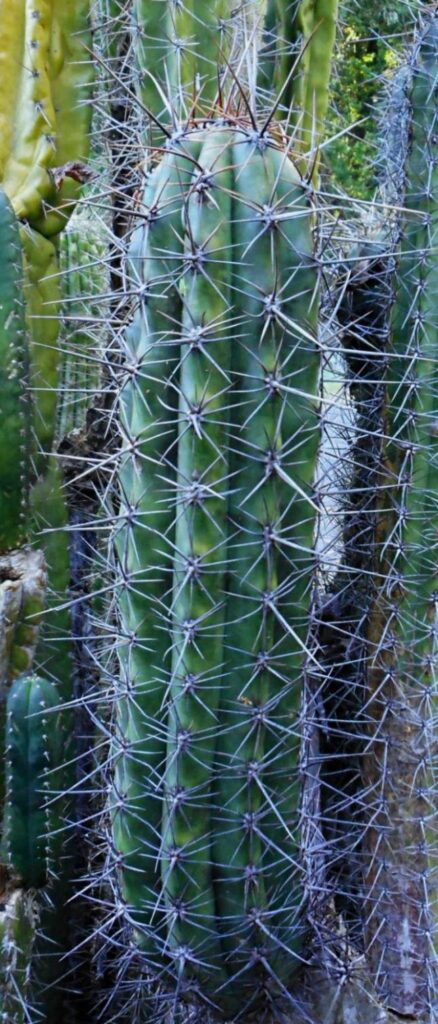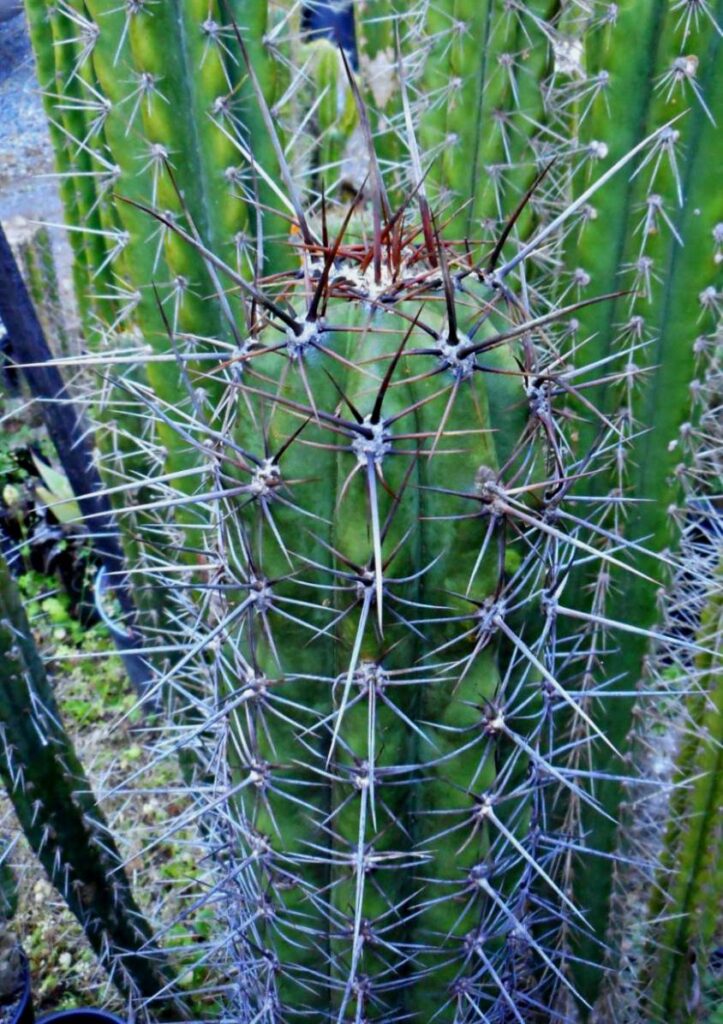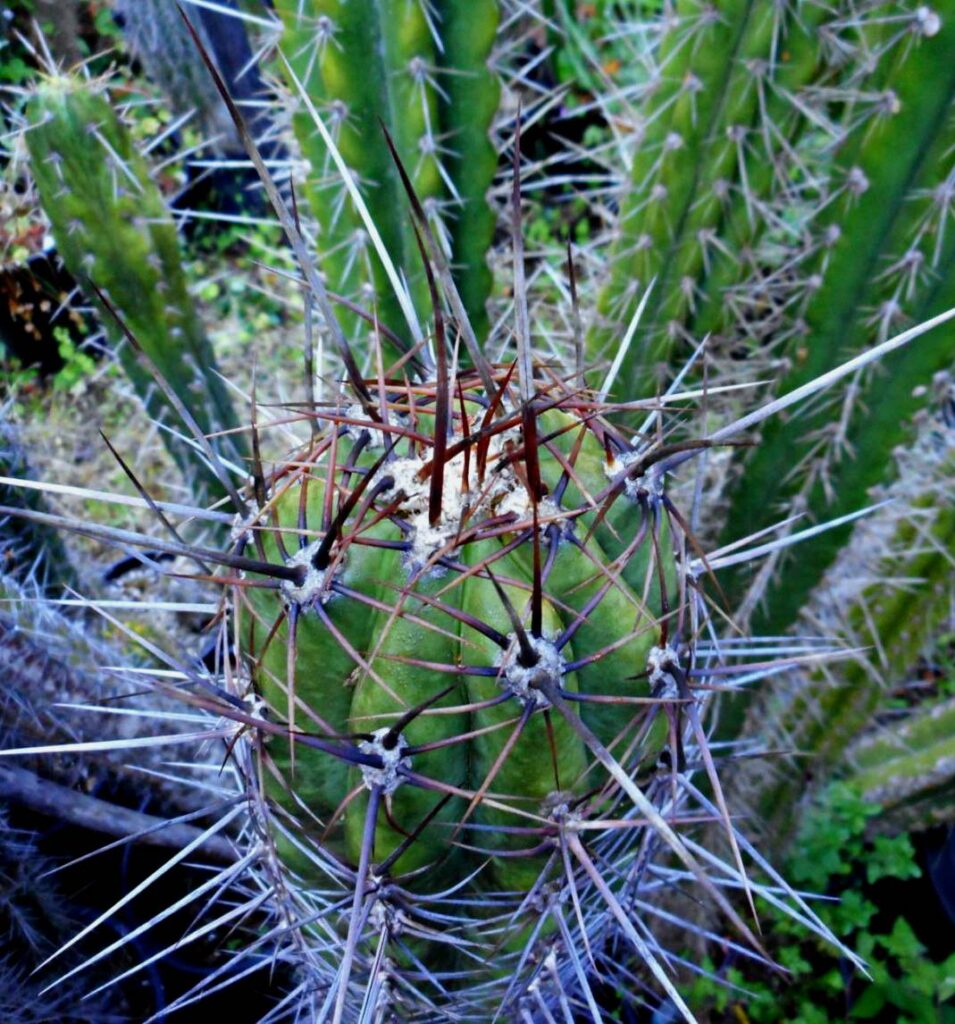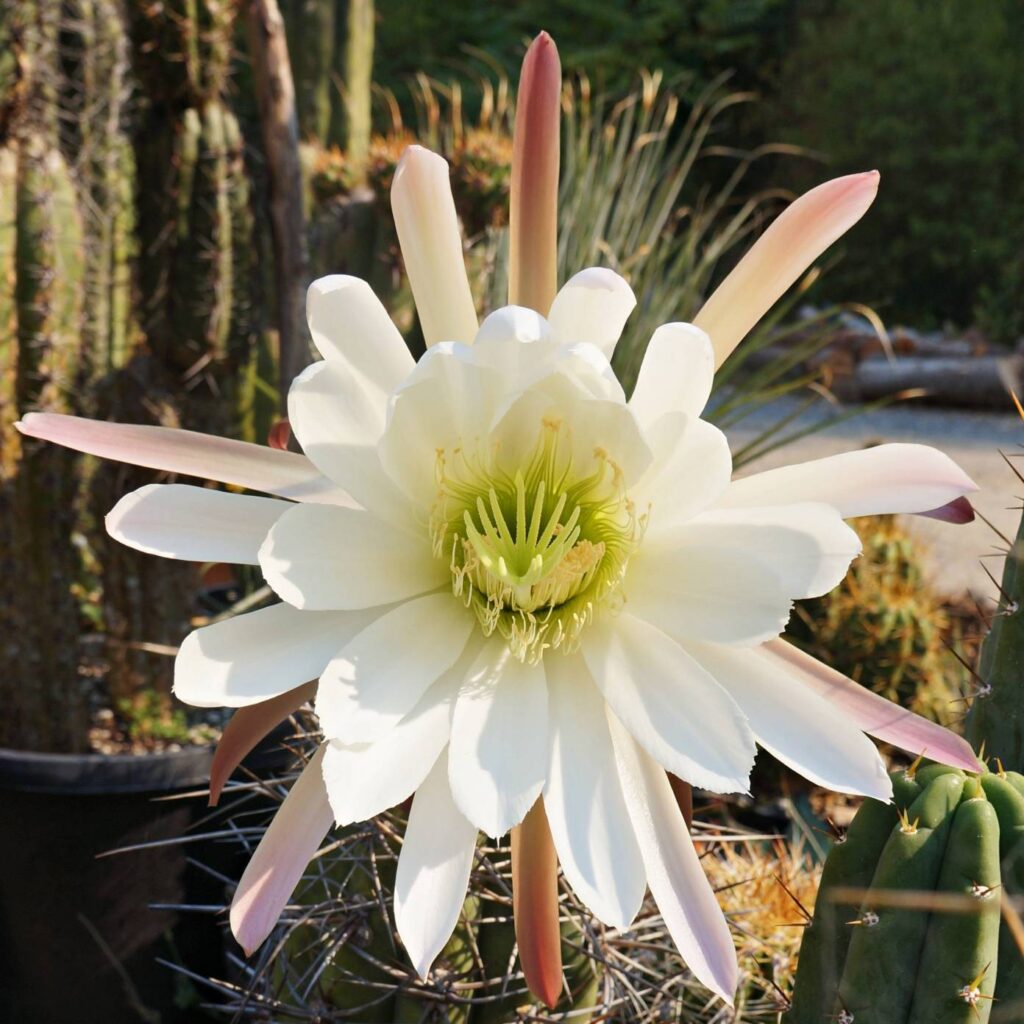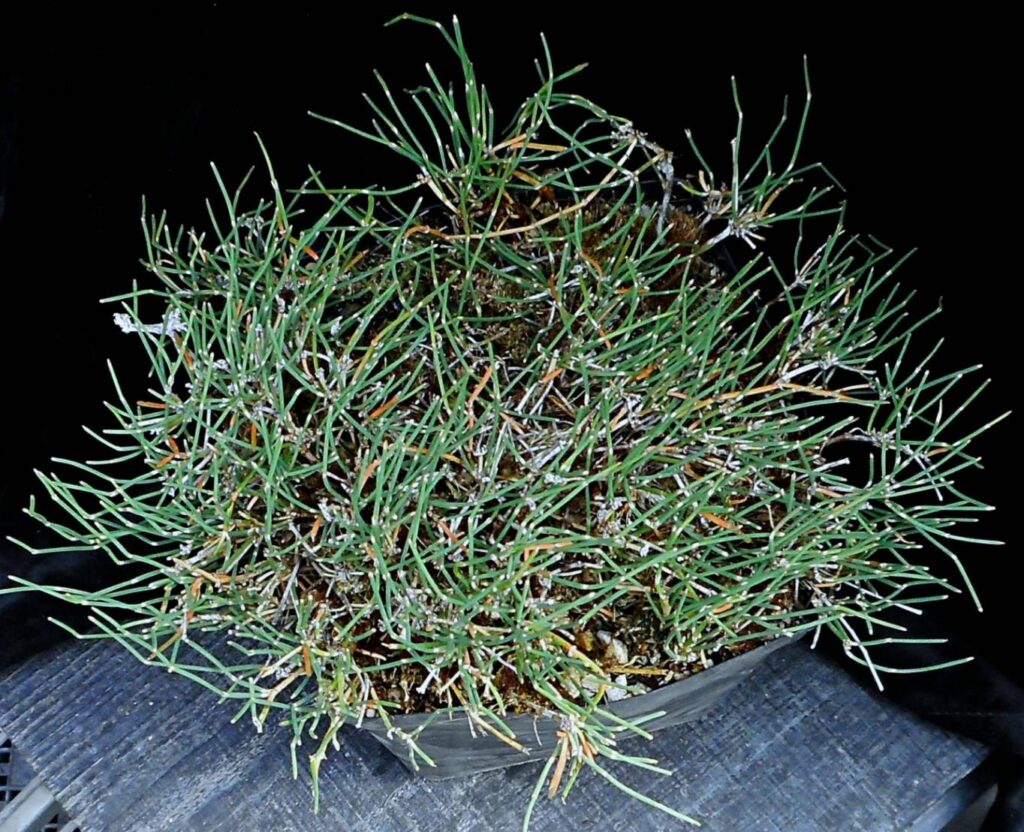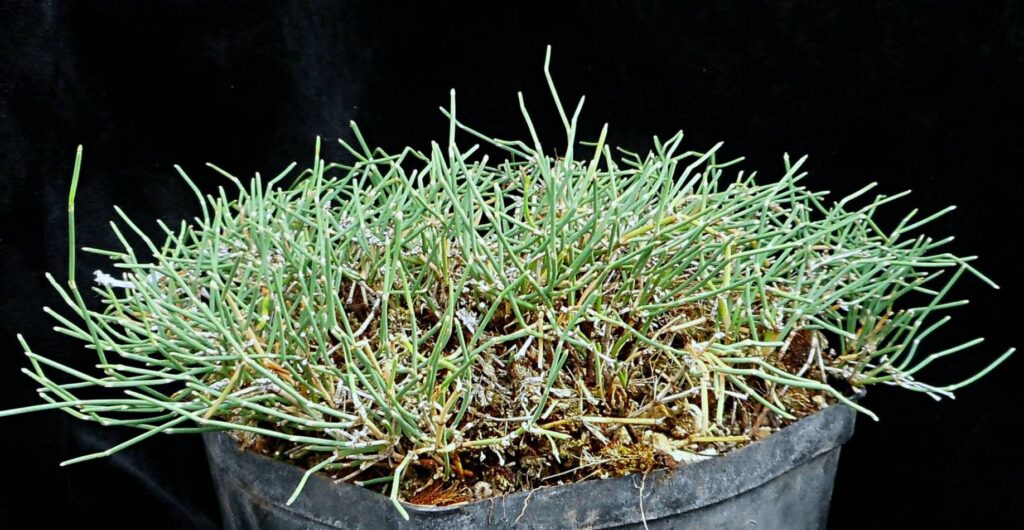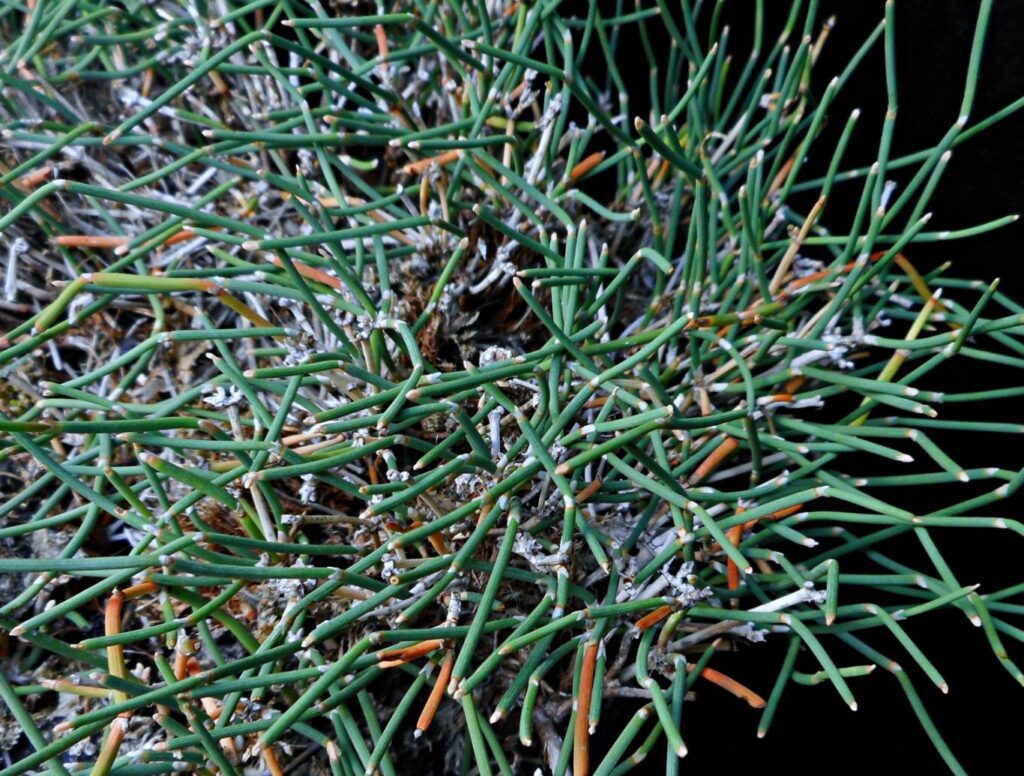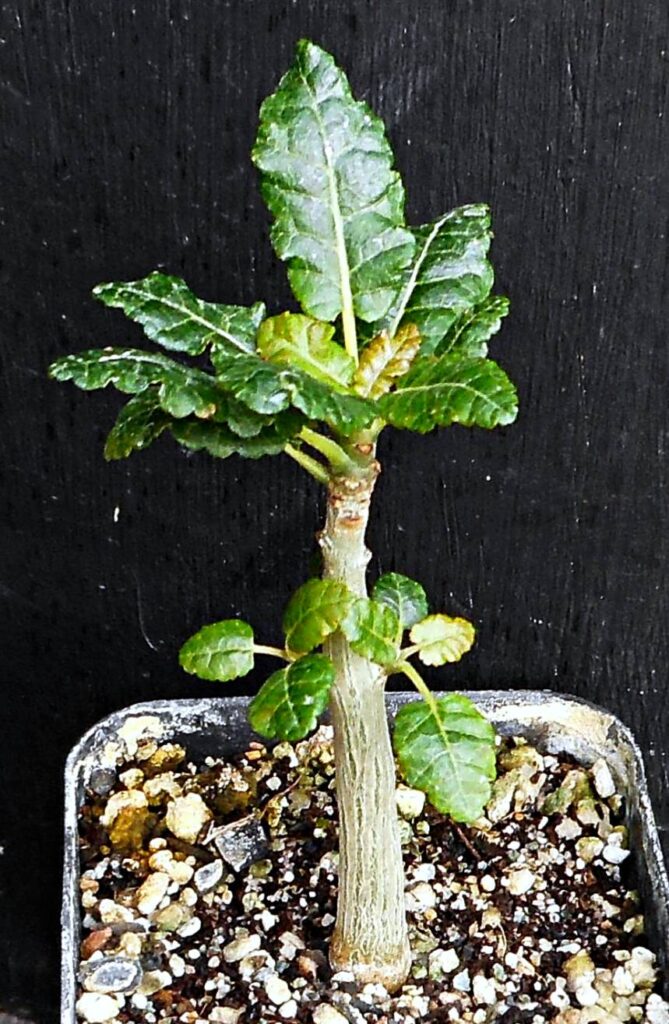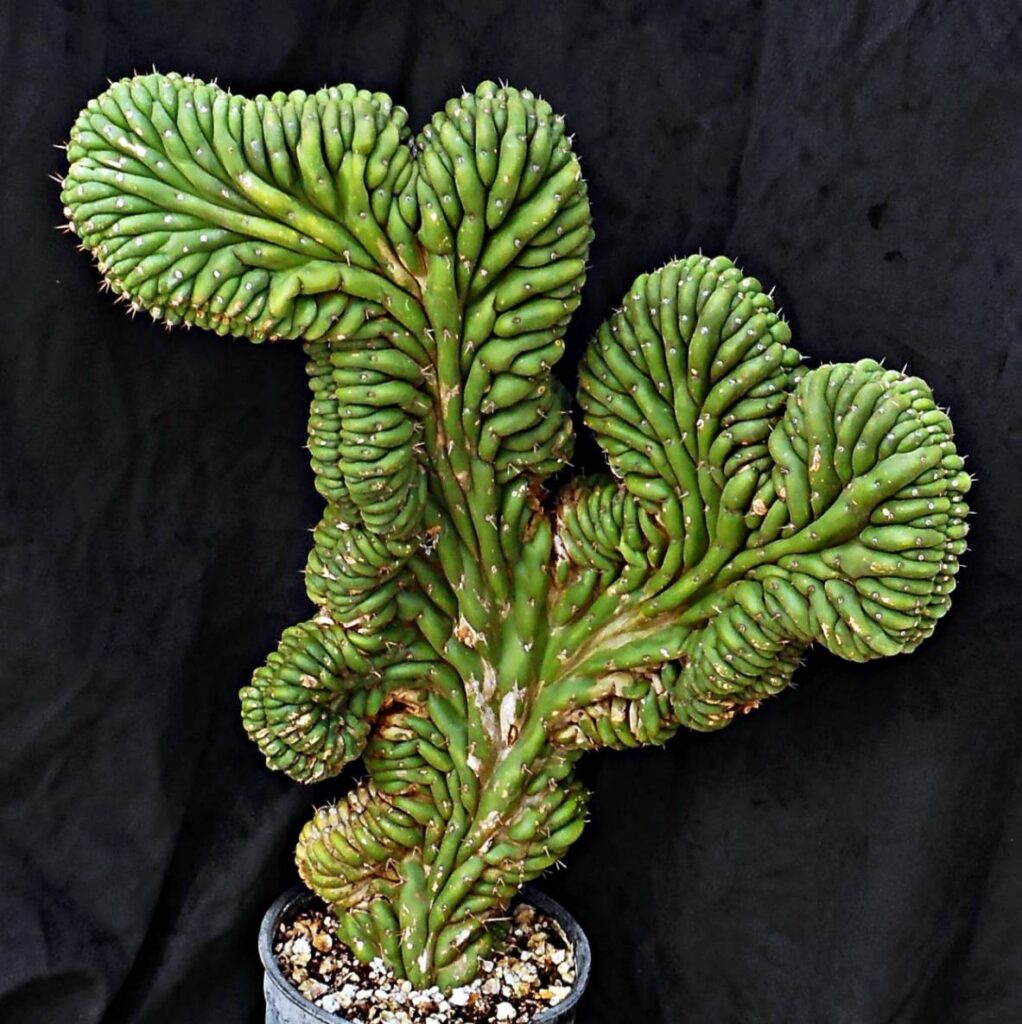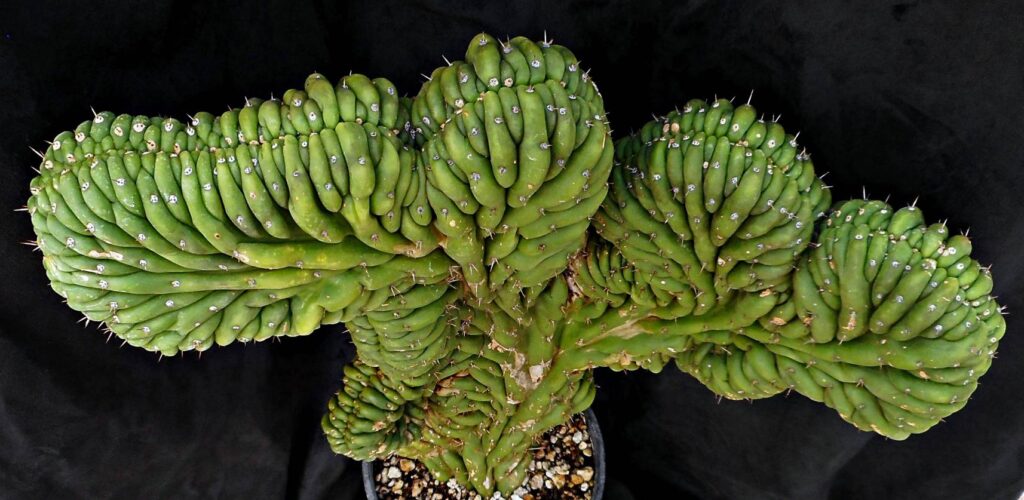To receive our periodic (usually every 4-8 weeks) emails listing new plants, sales & auction fundraisers, news from our gardens, greenhouses & travels, sign up at –
http://lists.sonic.net/mailman/listinfo/sacredsucculents
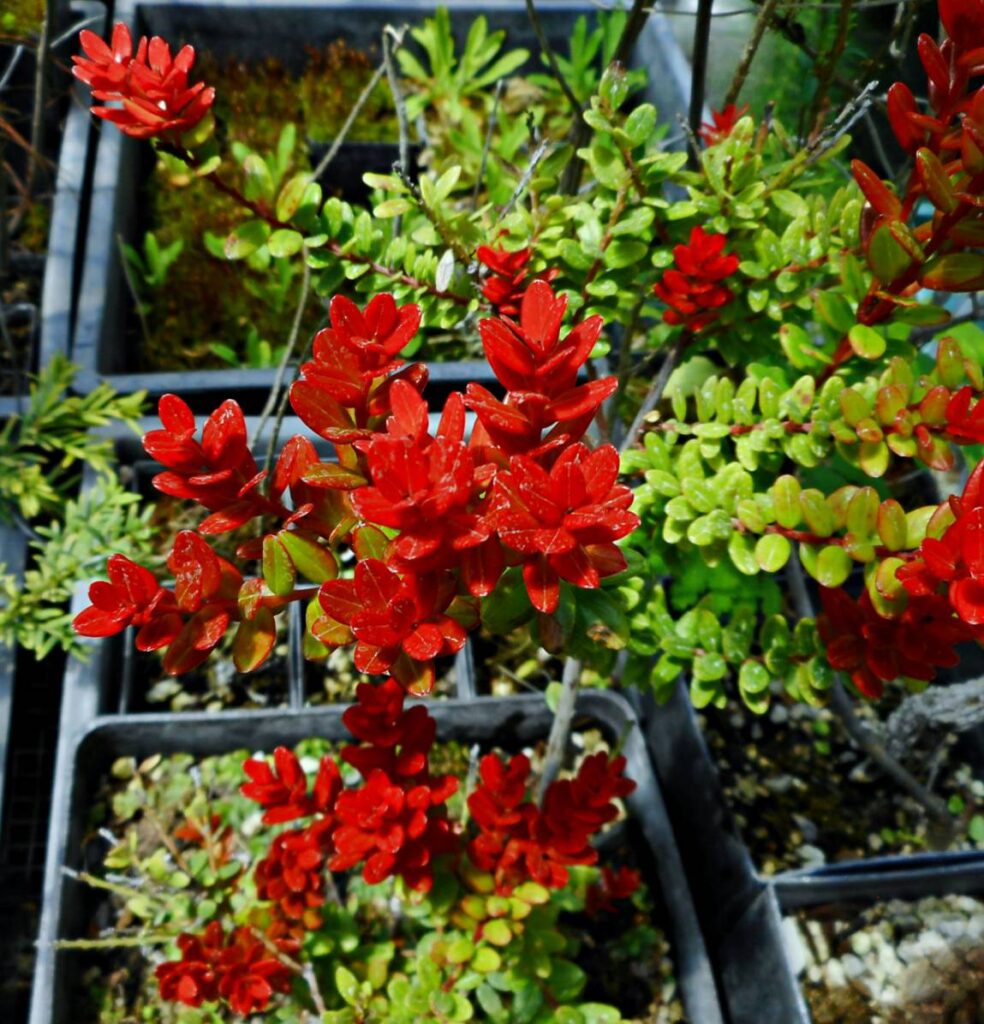 ↑ Vaccinium stapfianum v. minus with vibrant new growth ↑
↑ Vaccinium stapfianum v. minus with vibrant new growth ↑
♥
Auction-Fundraiser
___
~ The first Auction-Fundraiser of 2025 is now closed! ~
___
The auction closed at 6:00 pm PST, Monday, May 26, 2025
◊
The winning bids are now posted. Gratitude for your support!
__
Auction updated 7:00 pm 5/26/25
__
About the last day and auction close:
We honor the email bids as first come first serve, so if we don’t respond right away—
do not worry, we will honor your bid in the order/time it was received.
Note: the last hour of the auction can get hectic and we may not be able to notify you in a timely manner if you’ve been outbid—
therefore, we recommend checking the website periodically during this final phase to see the current high bids and respond accordingly.
__
A “soft close” to this auction:
This allows for participants to make a final bid offer on a popular item even after the “close”.
How it works:
For any plant bid on in the final minutes of the auction, we will email the bidders shortly after the 6pm close and give them the opportunity to make 1 final bid on the plant within a given amount of time—the highest bid wins the plant!
For plants only bid on earlier in the auction, there is no “soft close” and the win goes to the person with the highest bid at the 6pm close.
__
After the auction ends, you will be contacted by email later in the evening or the following morning for the auction plants you have won.
__
◊
About the Auction-Fundraiser:
(We can only ship Plants to US addresses, Seed & Books can ship internationally)
___
This is an exclusive opportunity to obtain completely new introductions, magnificent one-of-a-kind specimens, and awesome rarities that are not available anywhere else — including species & clones we haven’t offered in many years, and likely won’t offer again for many more.
In fact, this is your single chance to obtain many of these plants – they will not be available again!
For other unique offerings see our SPECIMEN PLANT LIST
___
Know that auction purchases will directly fund much needed nursery repairs to damage from the last several winters’ storms and increasing heat spikes throughout the year, essential renovations to our aging infrastructure, ongoing irrigation installation [after 20 years of hand-watering, we can no longer keep up and continue to lose plants due to a climatic shift towards hotter & drier], etc. Purchases also support our research and writing projects, as well as our continual conservation work—which includes propagating an untold number of rare and endangered plants that we’ve had waiting here for years, but have not had the time to multiply and distribute…
___
The bidding process is the same as last auction.
With this auction what you bid is exactly what you will pay if you have the winning high bid when the auction ends. [This differs from our early auctions where the high bid was hidden and determined to be just $1 over the previous bidders high bid.]
An example for the current auction: If the current bid on a plant is $35, and you bid $50, the high bid price is then moved to $50 (NOT $36 like our earliest auctions) and the next bidder has to bid over that ($51 or more) — if you have the highest bid when the auction closes, then you win that plant and your high bid is exactly what you pay (plus shipping).
__
Our auctions now have a “soft close”:
To make the process more fair, we have implemented a “soft close” at the end of our auctions. This allows a chance for participants to make a final bid offer on a popular plant even after the “close”.
How it works: For any plant bid on in the final minutes of the auction, we will email the bidders shortly after the 6pm close and give them the opportunity to make 1 final bid on the plant within a given amount of time [5–15 minutes, depending on the circumstance]—the highest bid wins the plant!
For plants only bid on earlier in the auction, there is no “soft close” and the win goes to the person with the highest bid at the 6pm close.
♠
To place a bid- ( please read fully before bidding! )
Email us ( benkamm@monitor.net ) with “SS auction” in the subject header.
In the body of the email list –
1) The name of each plant you are bidding on with the amount you are bidding next to the name (must be equal to or greater than the “minimum starting bid” or current “high bid”).
2) Your full name and complete shipping address.
♥
Placing a bid is binding, so please do not bid unless you are committed to buying!
Again please do not bid if you are not 100% committed and do not bid beyond your means.
♥
We honor the email bids as first come first serve, so if we don’t respond right away—do not worry, we will honor your bid in the order/time it was received!
The auction will be updated at least twice a day by 11 am and 6 pm, much more often the final day.
Towards the end of the auction can get hectic and we may not be able to notify you in a timely manner if you’ve been outbid during this last phase – we recommend checking the website periodically to see the updated current high bids and respond accordingly.
The auction closes at 6:00 pm PST, Monday, May 26, 2025 The winning bids should all be posted on the website that night, no later than 7:30 pm PST. You will be contacted by email that evening or the following morning for the auction plants you have won. Our regular shipping costs apply (see after auction listings for current rates). Placing a bid is binding, so please do not bid unless you are committed to buying! We request payment (cash, check, or money order) be mailed promptly on Tuesday, May 27 (for international seed & book wins only, online payment can be arranged). Your plants will be shipped after payment is received.
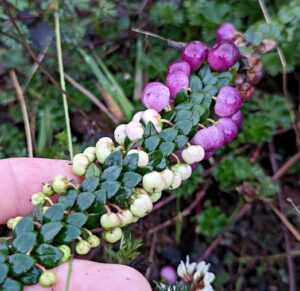 ↑ Pernettya sp. TB17P.4 in fruit, Papallacta, Ecuador ↑
↑ Pernettya sp. TB17P.4 in fruit, Papallacta, Ecuador ↑
___
♣
___
May 2025 Auction-Fundraiser Offerings:
~ The first Auction-Fundraiser of 2025 is now closed! ~
___
The auction ended at 6:00 pm PST, Monday, May 26, 2025
The winning bids are now posted. Gratitude for your support!
♣
Auction Seed
[The seed part of the auction is open to both US and international bidders!]
__
Sorry, no seeds this fundraiser!
___
♣
Auction Plants
[We only ship plants to US addresses!]
___
Cactaceae
Trichocereus bridgesii SS02 (= Trichocereus sp. SS02) “Achuma”
A favorite for over 20 years! Dense candelabra stands to 16′ tall. Blue-gray/green frosted stems up to 5″ in diameter with 5–7 ribs. Each areole bears 2–4 central spines up to 1.5″ long. The new growth on old stems is often spineless for short sections. White flowers, fat edible fruit. A distinct form of the species, similar to plants seen around the La Paz basin of Bolivia. We’re offering a robust cutting, a little weathered from years of growing outside in full exposure to the elements, but extra hardy. Two consecutive years of winter damage to our mother plants, coupled with the very large number of orders for this coveted clone, means that our retail stock is currently very limited until at least next year—this will likely be the only larger cutting we offer for some time. Z9a
30″ long, 3″ diameter cutting – 5 bids – winning bid $175** – Listing closed

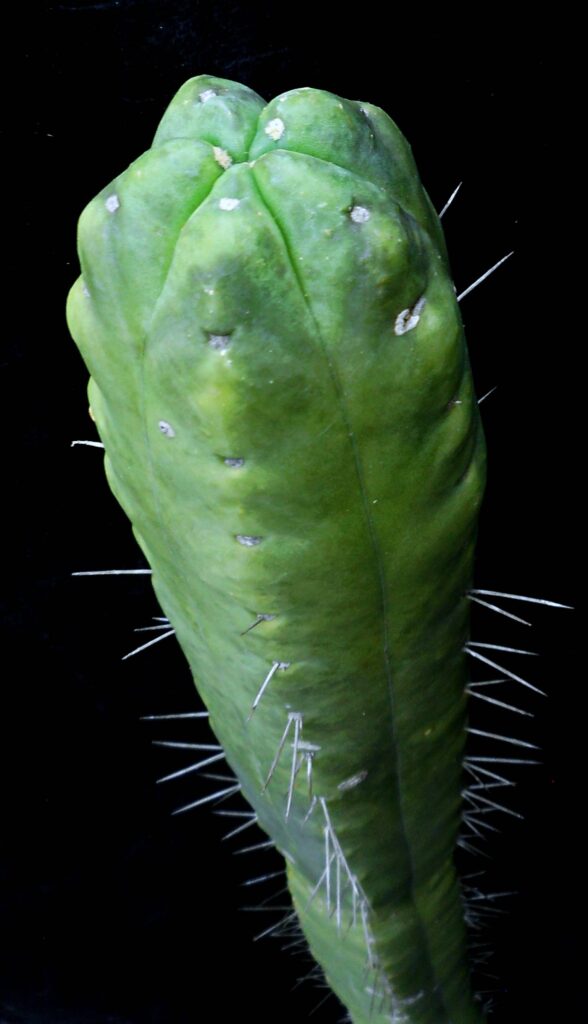 ↑ Auction specimen ↑
↑ Auction specimen ↑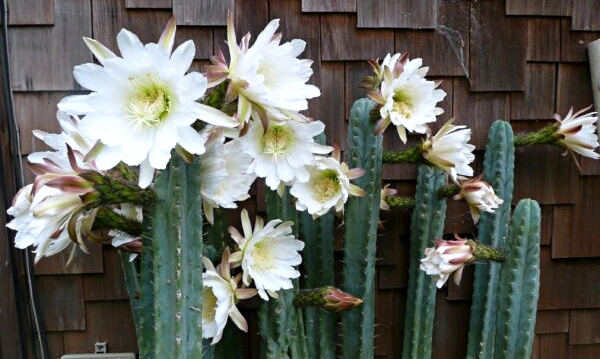 ↑ Trichocereus bridgesii SS02 in full flower ↑
↑ Trichocereus bridgesii SS02 in full flower ↑
___
Trichocereus sp. ‘Juul’s Giant’ X Echinopsis eyreisii
First offering of this intergeneric hybrid. An upright chunky stem bearing 8 thick ribs with glossy skin, closely spaced, fuzzy areoles with 5–7 short spines 1/4–1/3″ long. The mother, ‘Juul’s Giant’, is a much desired, obese, blue stemmed pachanoid with large white blossoms; the Echinopsis eyreisii father is a globular, clustering species with short, stout spines and slender tubed flowers with white petals that blush mauve. We expect this superb hybrid to mature into a singular beauty. This specimen is a little weathered and hardy after surviving a full season outside. Z9a
11″+ plant 4–5 years old – 6 bids- winning bid $85* – Listing closed
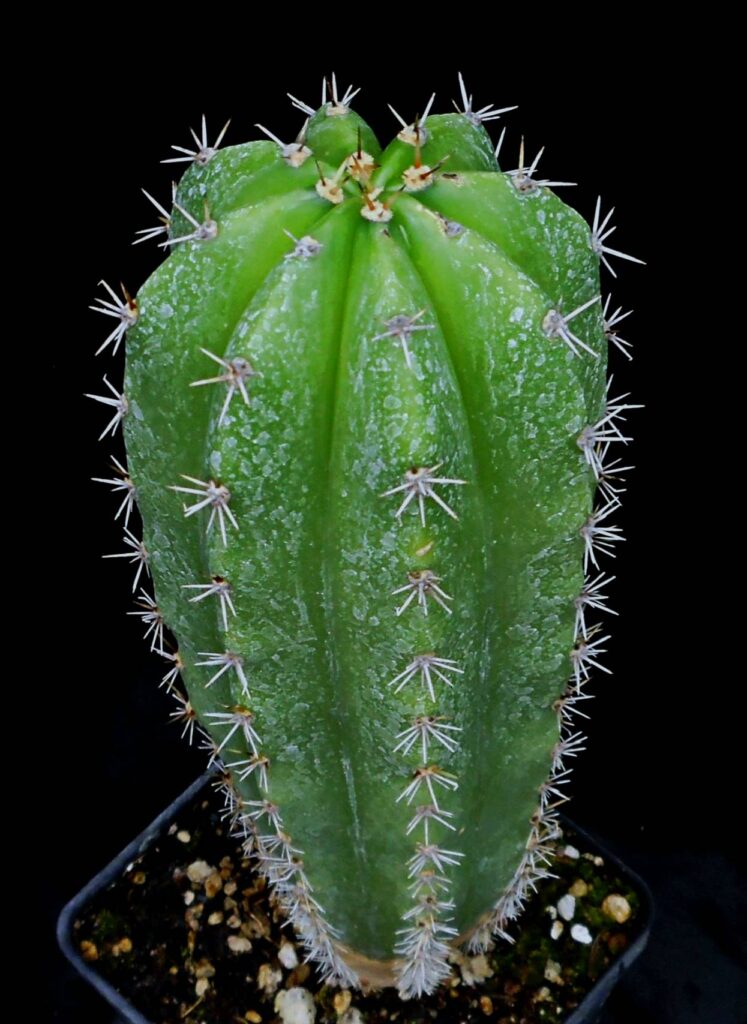
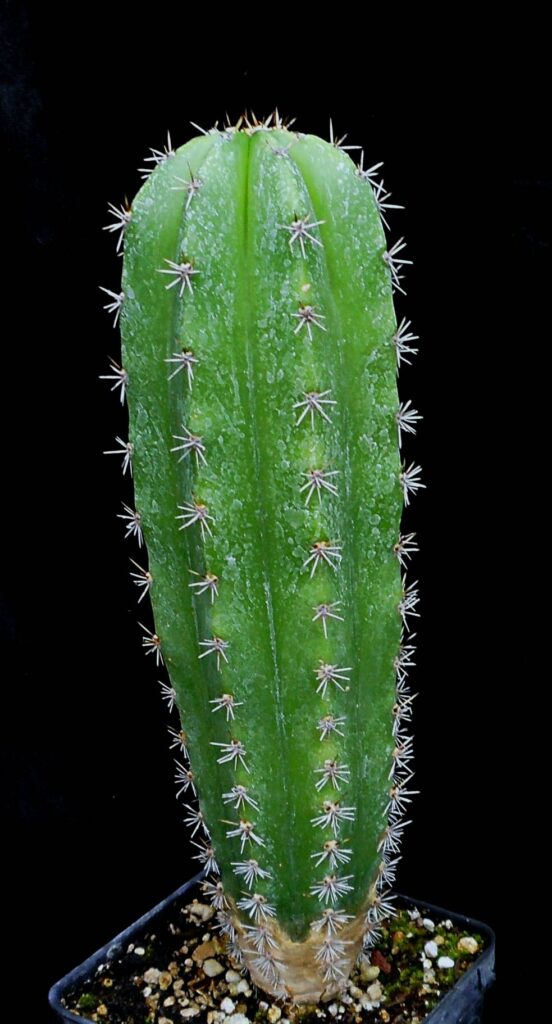
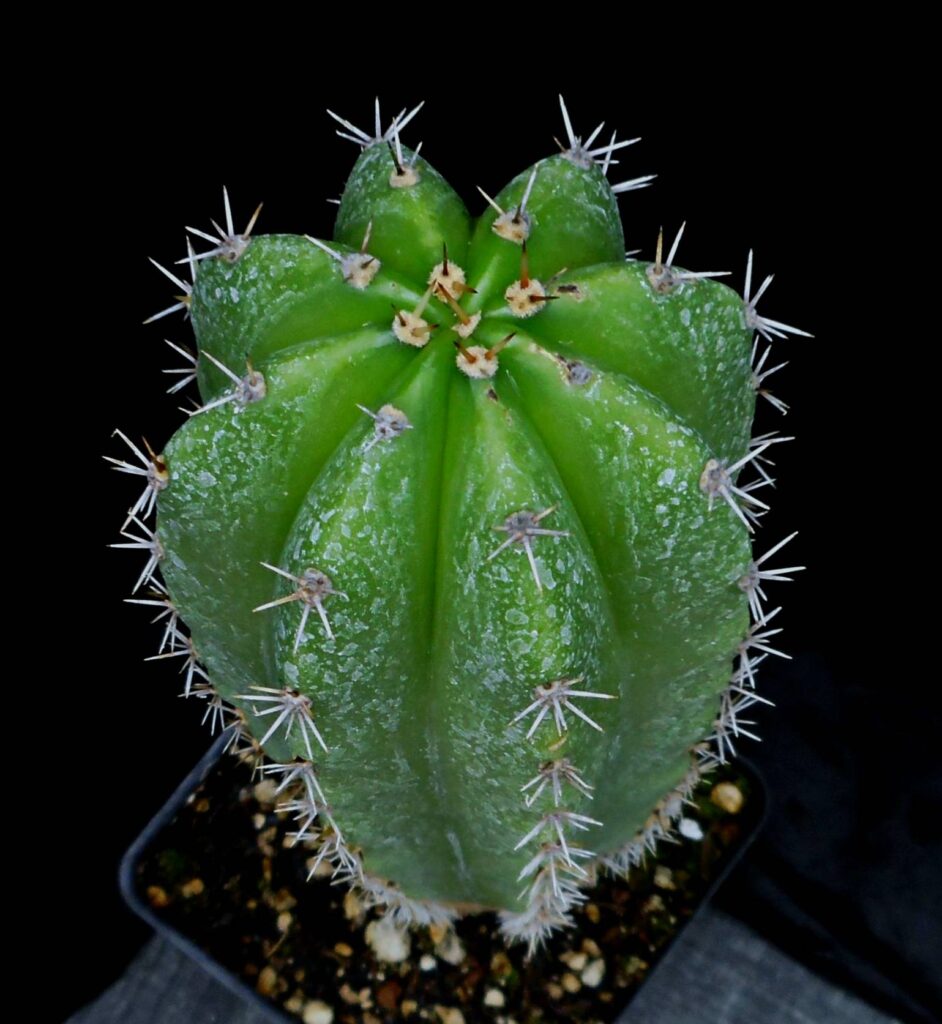 ↑ Auction specimen ↑
↑ Auction specimen ↑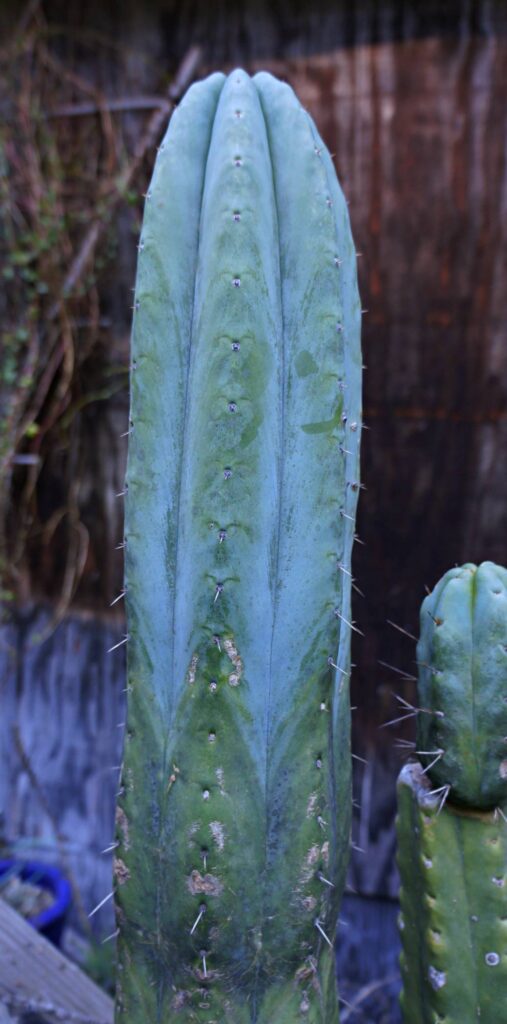 ↑ Juul’s Giant mother ↑
↑ Juul’s Giant mother ↑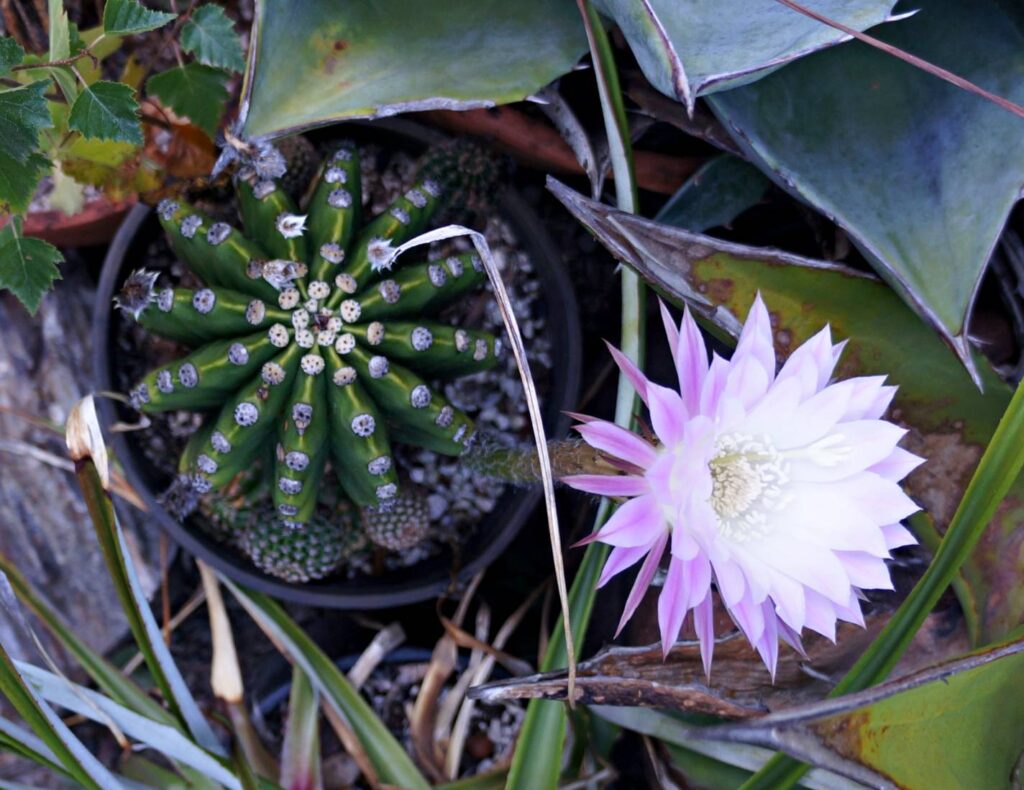 ↑ Echinopsis eyreisii father ↑
↑ Echinopsis eyreisii father ↑
___
Trichocereus pachanoi TB17A “San Pedro” “Huachuma”
A newer “wild” Sand Pedro clone. Upright, green to glaucus columns—smooth, handsome stems with distinct notches above the areoles. Spines to 1/4″, amber fading to white-gray. Large white flowers followed by edible fruit. Collected by master plantsman Tom Baldwin at Miralindo, Quito, Ecuador. We introduced this clone to cultivation a couple years ago and it has only been offered a few times. This is your only chance this year to obtain a cutting of this unique and desirable San Pedro. Z9a
7.5″ cutting – 5 bids – winning bid $175 – Listing closed
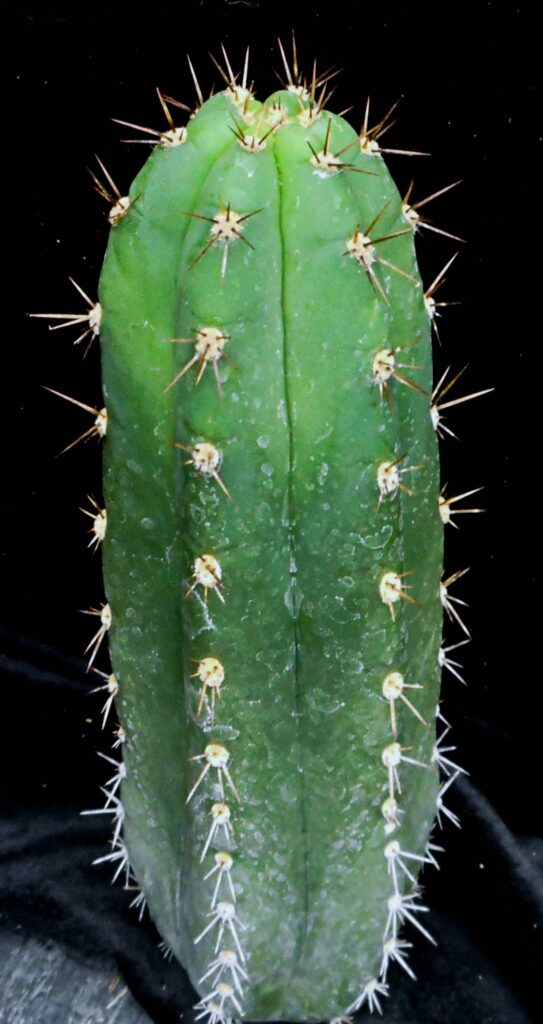
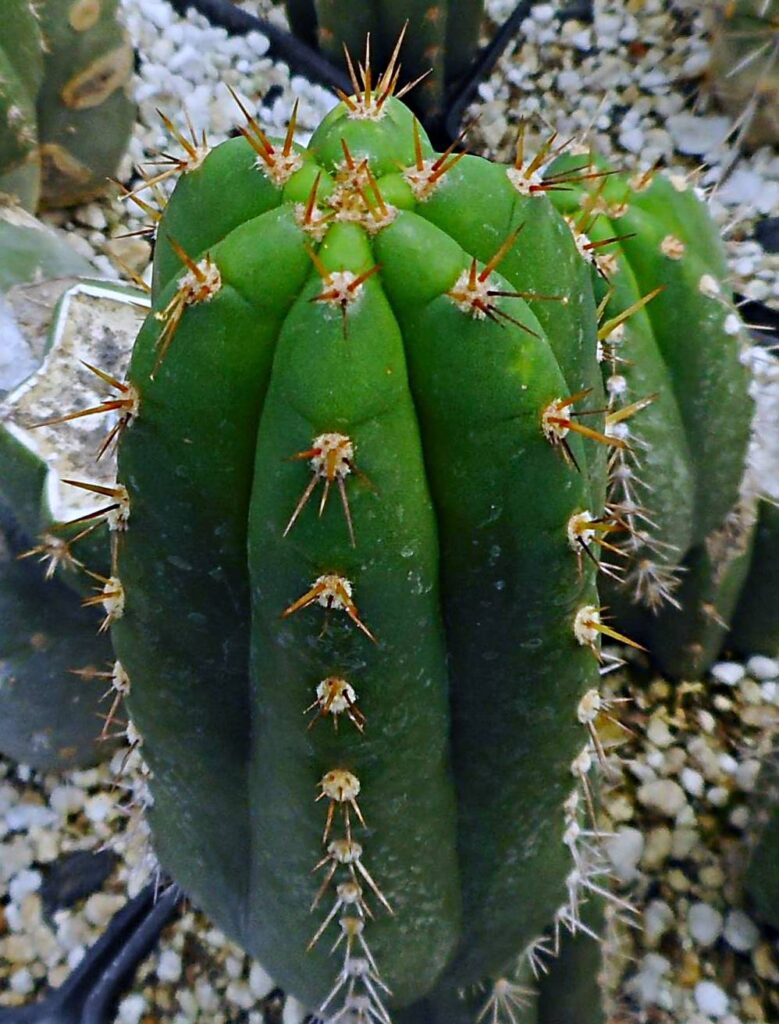 ↑ Auction specimen ↑
↑ Auction specimen ↑
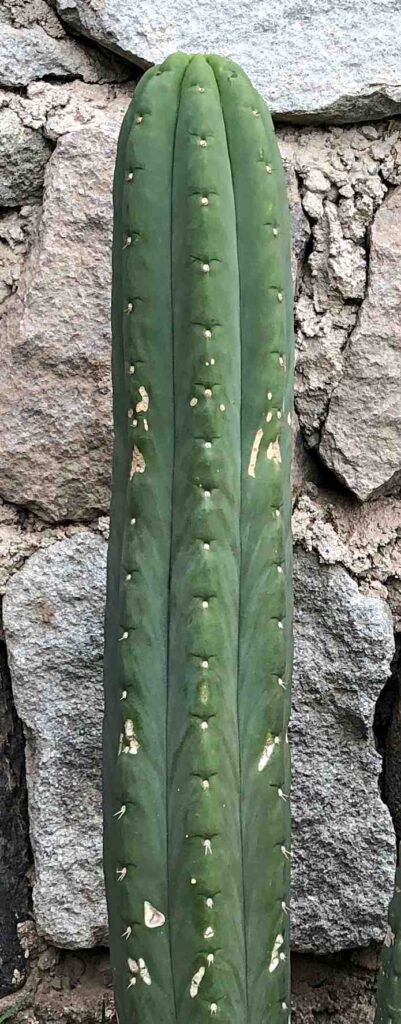 ↑ Mother plant showing off the distinct, handsome form; Miralindo, Quito, Ecuador ↑
↑ Mother plant showing off the distinct, handsome form; Miralindo, Quito, Ecuador ↑
___
Trichocereus pachanoi f. cristata/monstrosus cl. B “Mutant San Pedro” “Huachuma”
A marvelous mutant clone of the beloved San Pedro cactus. Forms clumps of coral or brain-like cristate growth, often offsets monstrose branches that mutate in a variety of interesting ways. Occasionally reverts to normal growth. Each specimen is a living sculpture. Our stock was damaged a few years back and we’ve barely offered this superb mutant since then. This unique, small specimen may be one of the only offerings of clone B available in 2025. Rooted cutting. Z9a
5″ tall by 4.5″ wide plant – 6 bids – winning bid $230 – Listing closed
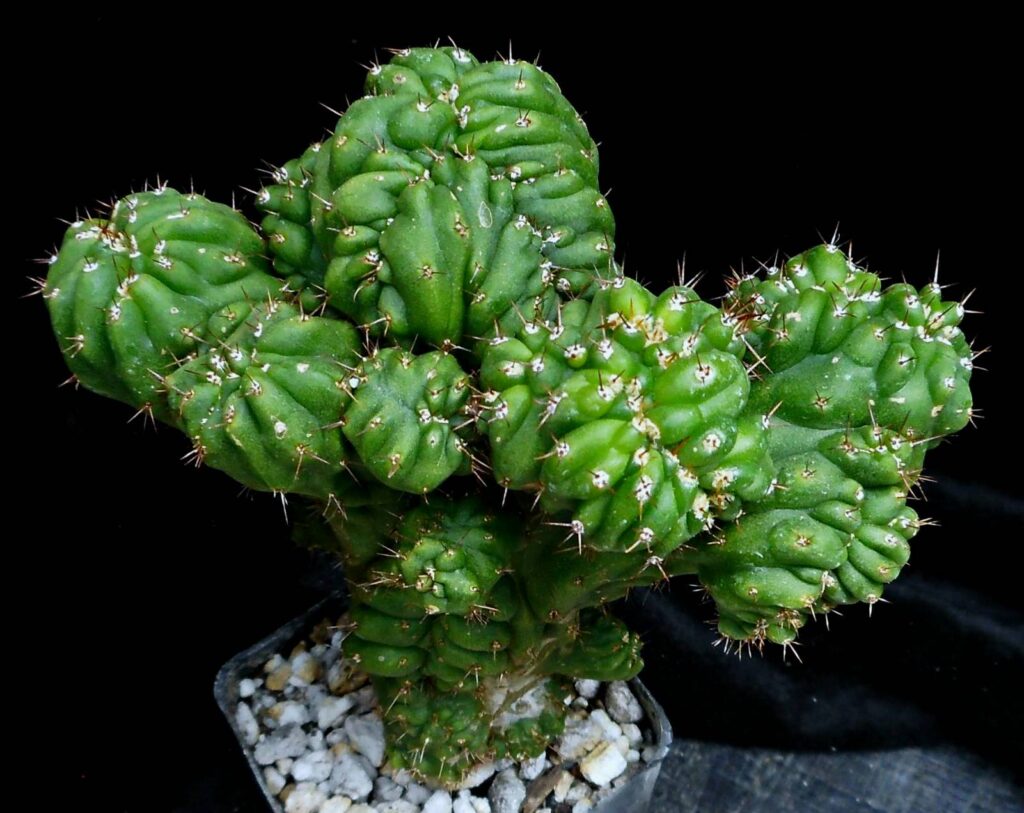
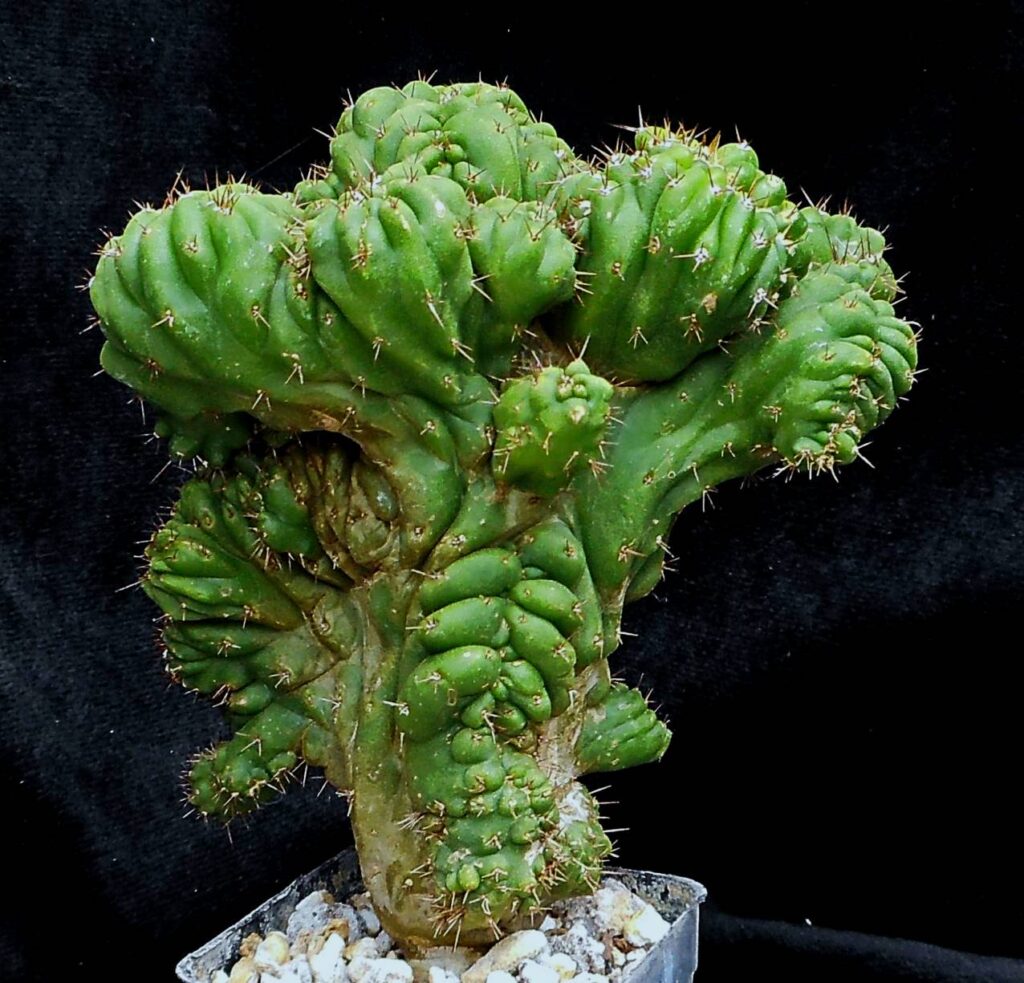
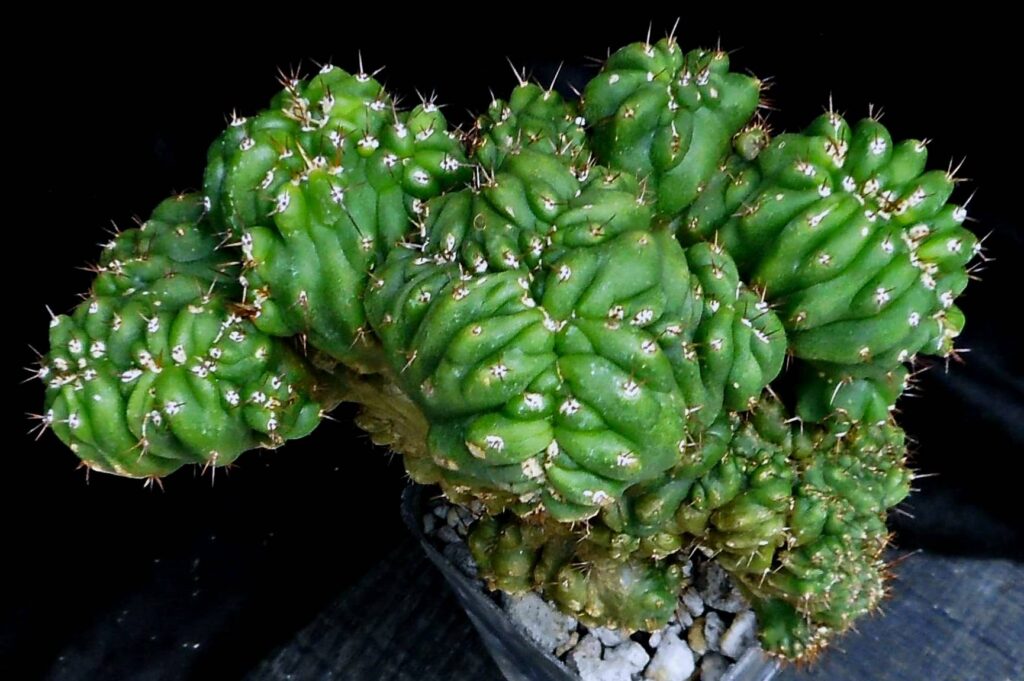

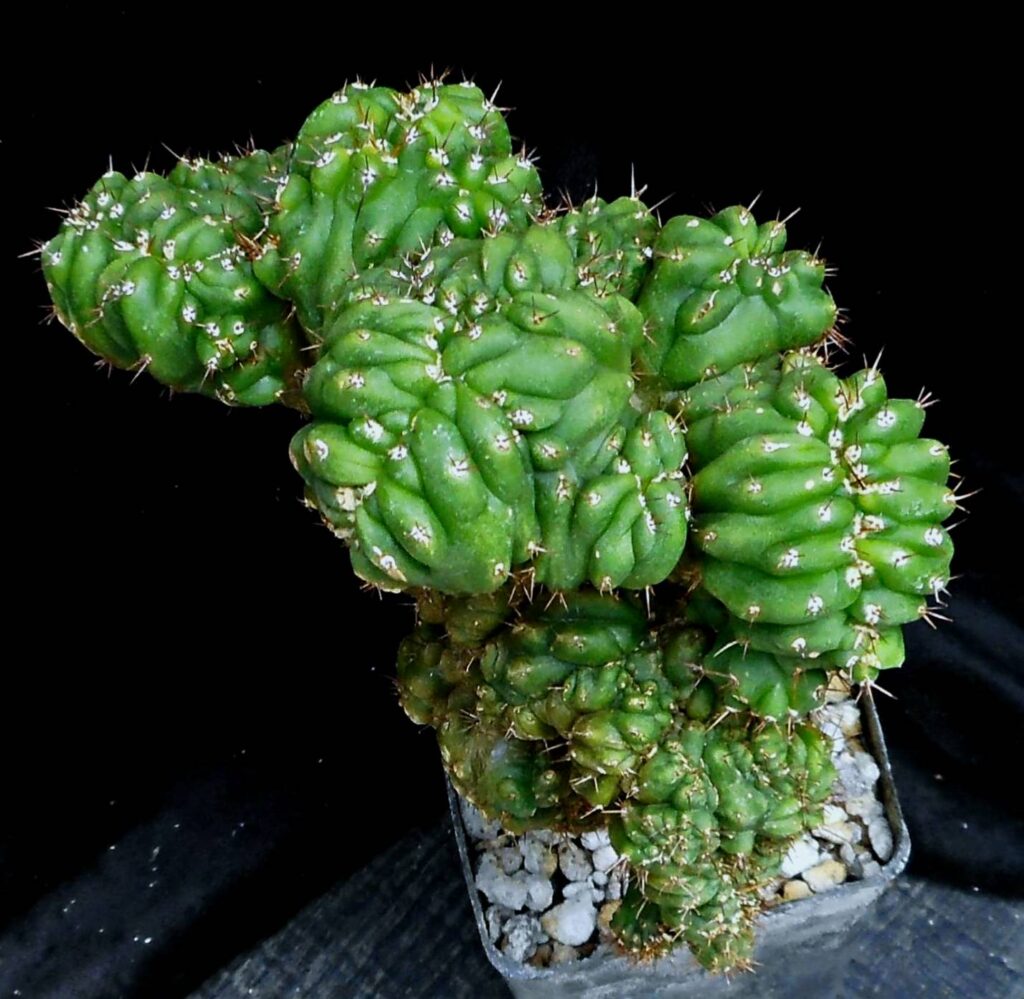 ↑ Auction specimen from multiple views ↑
↑ Auction specimen from multiple views ↑
___
Trichocereus santaensis BK09509.9 cl. W “Huachuma” “San Pedro”
A rare cut from our highly valued seed accession progeny. The original mother plants were large arborescent stands to over 15′ tall with stems 3.5–4″+ diameter, the main woody trunk to over 6″ diameter; blue-green epidermis, up to 5 small spines, 1/8–1/4″ long. Lower stems covered in Tillandsia. Growing with Bacharis latifolia, Ephedra americana, Cyclanthera sp., Tagetes sp., Agave cordillerensis, Bidens sp., Borzicactus fieldianus, Cylindropuntia sp., etc. Occurring on the west side of the Santa River, near Olleros and the ancient road that connects the southern end Callejon de Huaylas with Chavín de Huántar, Ancash Dept., Peru, 11,000′. These populations are upper elevation of the riverside T. santaensis. This is a poorly understood species that looks to be very similar to the typical “wild” T. pachanoi that occurs in northern Peru and Ecuador. It is possible that T. santaensis should be considered the southernmost range of T. pachanoi. This specific clone, W, was selected from our the seedlings grown from this locale and has only been offered once before, it is an oddity in that stems often produces wavier ribs than any of its kin. Z9a [For additional info and photos, see our list of BK Trichocereus accessions]
6.5″ cutting – 6 bids – winning bid $80 – Listing closed
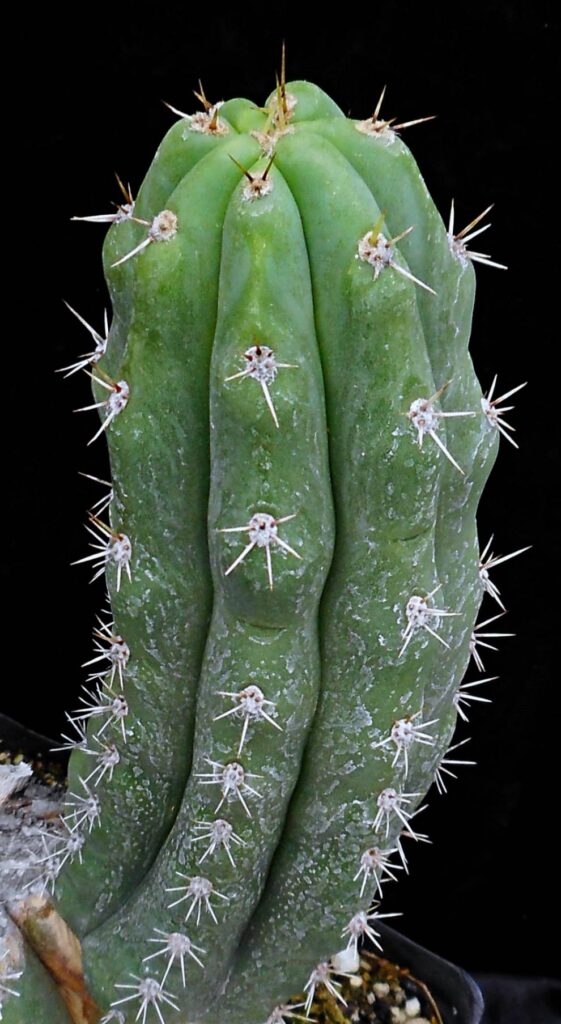
 ↑ Auction specimen ↑
↑ Auction specimen ↑

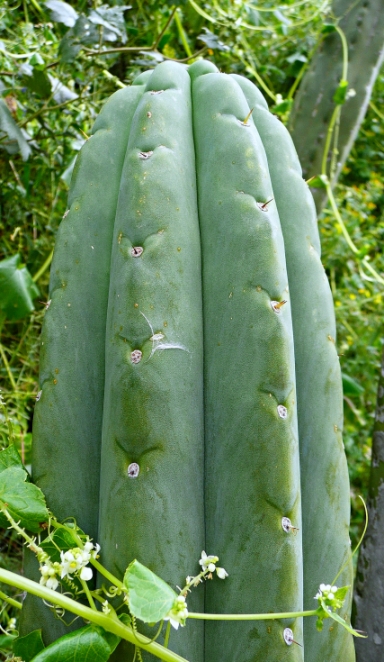
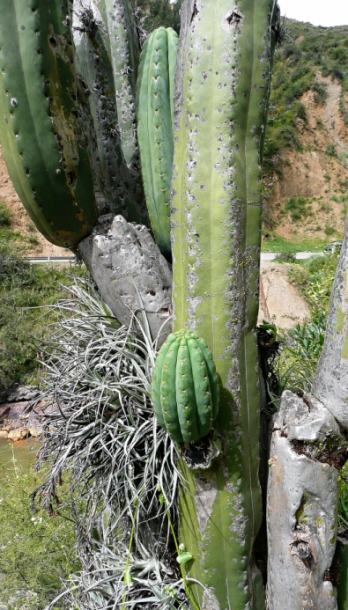
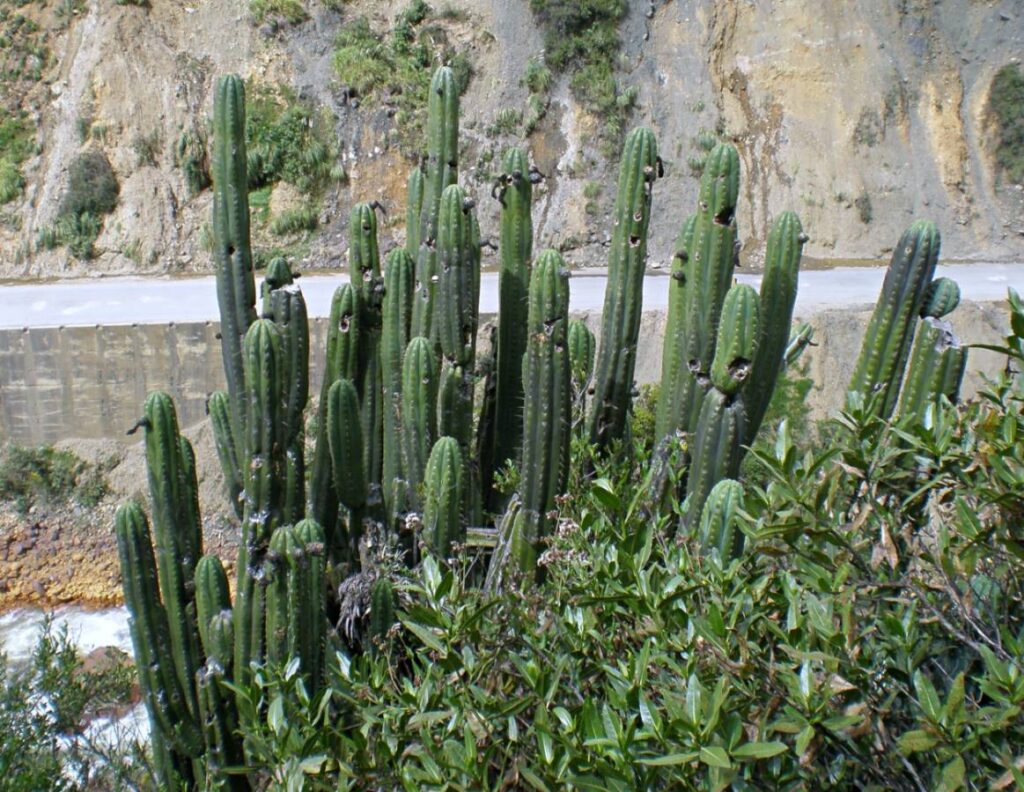 ↑ Trichocereus santaensis BK09509.9 mother plants in habitat, Ancash Dept., Peru ↑
↑ Trichocereus santaensis BK09509.9 mother plants in habitat, Ancash Dept., Peru ↑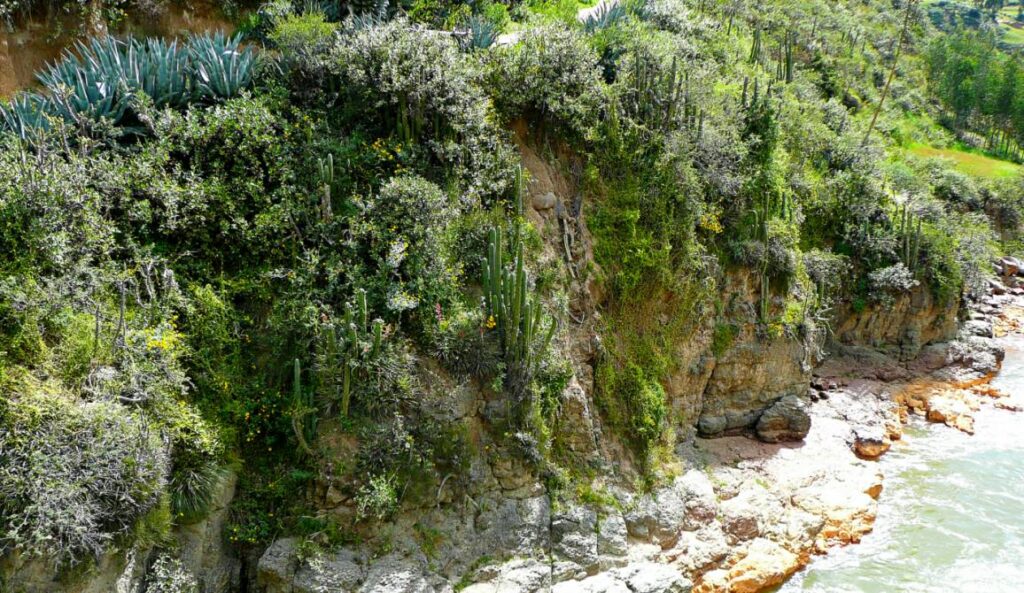 ↑ Trichocereus santaensis BK09509.9 in habitat along the Rio Santa, Callejon de Huaylas, Ancash Dept., Peru ↑
↑ Trichocereus santaensis BK09509.9 in habitat along the Rio Santa, Callejon de Huaylas, Ancash Dept., Peru ↑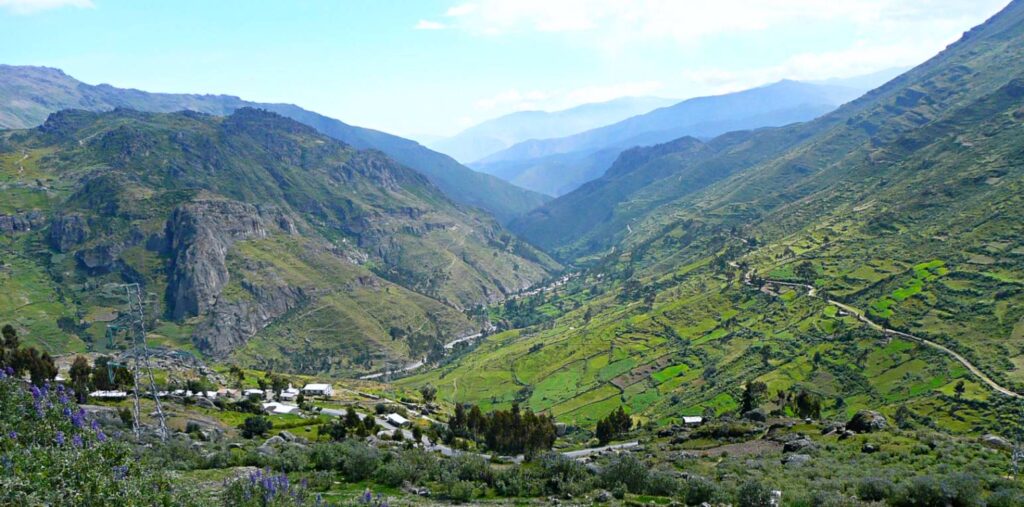 ↑ Looking down at the south end of the Callejon de Huaylas and the locale of T. santaensis BK09509.9, Ancash Dept., Peru ↑
↑ Looking down at the south end of the Callejon de Huaylas and the locale of T. santaensis BK09509.9, Ancash Dept., Peru ↑
___
Trichocereus scopulicola X Trichocereus bridgesii SS02 “Bolivian San Pedro Hybrid”
A superb hybrid we made many years ago of these two coveted Bolivian species and have never officially offered. The tiny spined, chunky stemmed T. scopulicola pollinated by the beloved, blue skinned, spiny to spineless SS02. Overall, this hybrid favors the morphology of the T. scopulicola mother, it has a thick, dark green to blue-blushed stem, smallish spines to 1/4″+, and large, white flowers. When the plant was young it showed signs of monstrose growth, but has so far reverted to a normal column. On offer here is an extra hardy and robust, seed grown plant, a little weathered and a tad underfed from living in the same 5 gallon pot for over a decade and growing outside in full exposure to the cold, wet winters and hot summers year after year. Will quickly green up with fresh soil or a little fertilizer. Just beginning to develop flower buds for this year. Z9a
Note: this specimen is too large to ship as is, we can cut it into 2 or more sections for shipping, or, for those within driving distance, we can arrange for the whole plant to be picked up from us in Occidental, CA.
60″+ tall, 3.5–4.5″ diameter plant 18 years old – 8 bids – winning bid $565*** – Listing closed
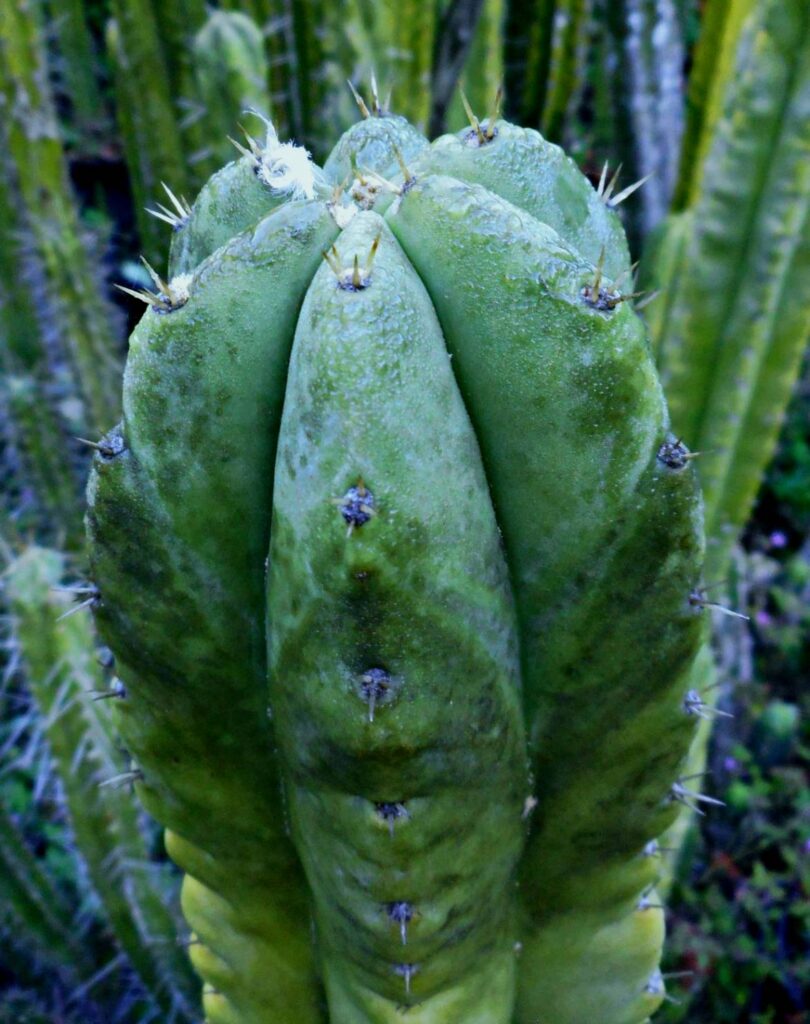

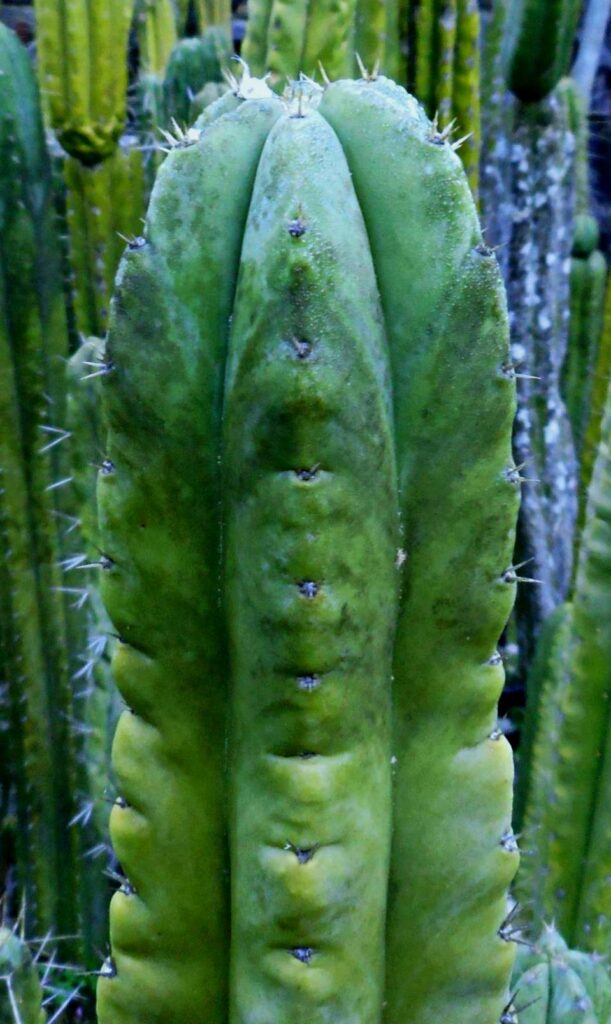
 ↑ Auction specimen in the morning dew (note: the fuzz near the tip is the start of flower buds) ↑
↑ Auction specimen in the morning dew (note: the fuzz near the tip is the start of flower buds) ↑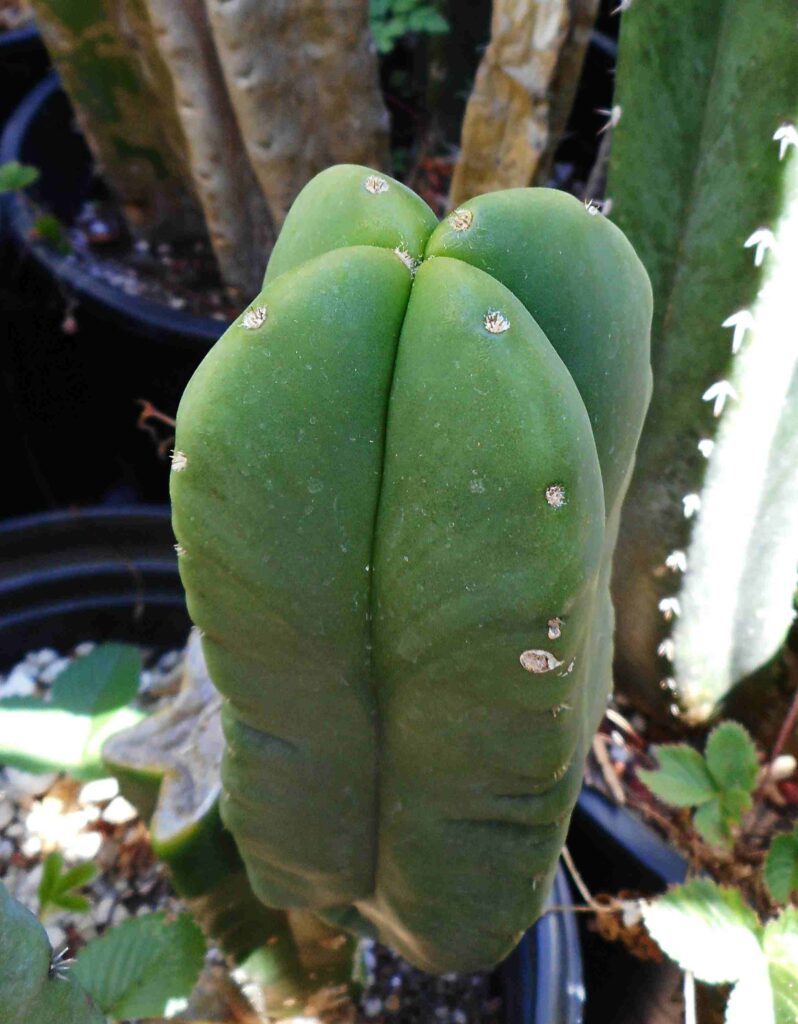 ↑ T. scopulicola mother ↑
↑ T. scopulicola mother ↑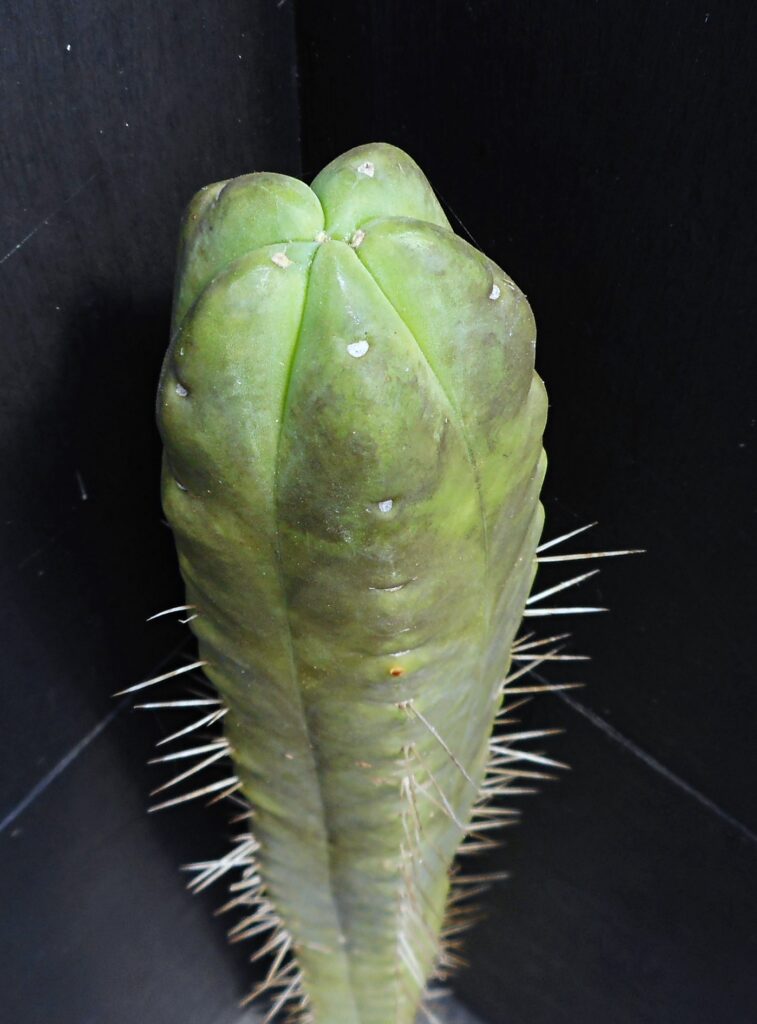
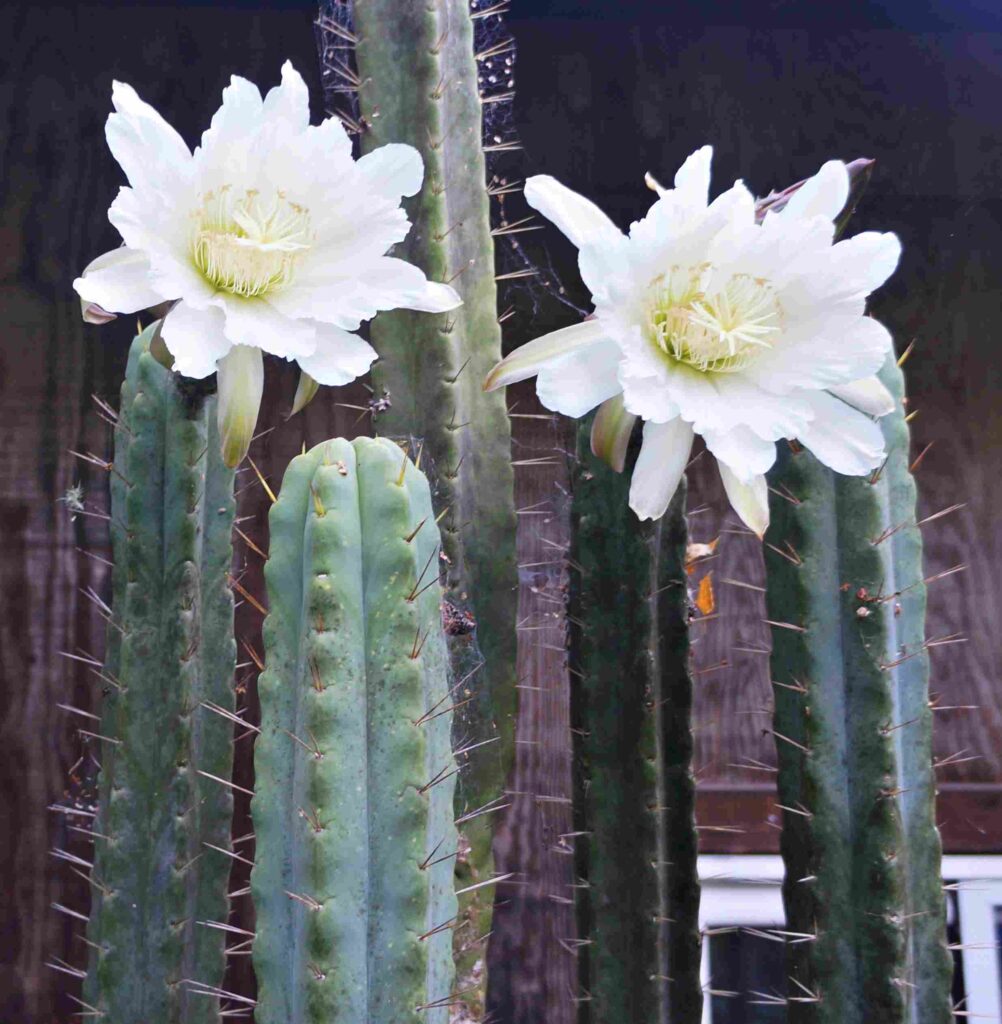 ↑ T. bridgesii SS02 father ↑
↑ T. bridgesii SS02 father ↑
___
Trichocereus taquimbalensis HBG68146
Impressive, upright columns to 10’+ tall; dark green to bluish stems to over 6″ in diameter with 8–9 ribs, heavily armored with extremely stout and attractive spines from 1″ up to 3″+ long, deep red to copper colored when young, aging dark brown-black, then grayish. White nocturnal flowers with copper and pink sepals; large edible fruit. Seed collected by R. Kiesling in southern Bolivia. Very rare in cultivation, slow growing and desirable. The taxonomical distinctions between this species and T. tacaquirensis, validus and even werdermannianus are not clear and further study is needed. An extra hardy cutting grown outside in full exposure, we’ve only offered this robust clone once or twice before in the 25+ years that we’ve grown it. Z9a
20″ long by 4.5″+ diameter cutting – 5 bids – winning bid $115** – Listing closed
___
Trichocereus terscheckii “Cardon Grande” “Cardon Santos” “Huachuma Gigante”
Known to some as the “Giant San Pedro”! Gigantic tree like cactus with candelabra stems 15–40′ tall and up to 2′ in diameter; 8–14 ribs with widely spaced areoles bearing 8–15 yellow spines as long as 2–4″; the upper stems of large, older plants are often completely spineless. Funnelform, white flowers, juicy sweet fruit. Found throughout the hot dry-forests of the mid-elevation deserts of northern Argentina, usually growing in association with xerophytic trees and shrubs that act as nurse plants for the young cacti—Geoffroa decorticans, Zizyphus mistol, Prosopis sp., Aspidosperma quebracho-blanco, Acacia gilliesii, Cnicothamnus lorentzii, Lycium tenuispinosum, Puya sp., etc. Very closely related to T. pasacana; from our travels T. terscheckii appears to be the lower elevation form of one contiguous species, the higher up in elevation you go, the spinier the plants become—between about 4000–6000′ you have T. terscheckii, then around 6000′ the populations become more heavily armed and begin looking intermediate to pasacana; 7000′ and above the plants are densely spined and distinctly T. pasacana. There are reports that T. terscheckii has medicinal properties like other Trichocereus, the flesh is used for wound healing and the woody core for construction. Like T. pasacana, ashes of the flowers and fruits are made into “llipta” mixtures that are chewed with coca leaf. This impressive cactus is favored by some as a landscape plant in the U.S. because it resembles the Saguaro (Carnegeia gigantea) but can be successfully grown in areas of higher rainfall and much colder temperature. This species is relatively slow growing and can be “bonsaid” by keeping them pot bound; in fact, the plant we have on offer here was left to languish in small pot for over a dozen years, it was transplanted last year and has resumed its growth. The first we’ve offered this awe-inspiring species in some time. Z8a–b [For additional habitat photos for the species, see our list of BK Trichocereus accessions]
11″ tall, 5″+ diameter plant 16+ years old – 2 bids – winning bid $100** – Listing closed
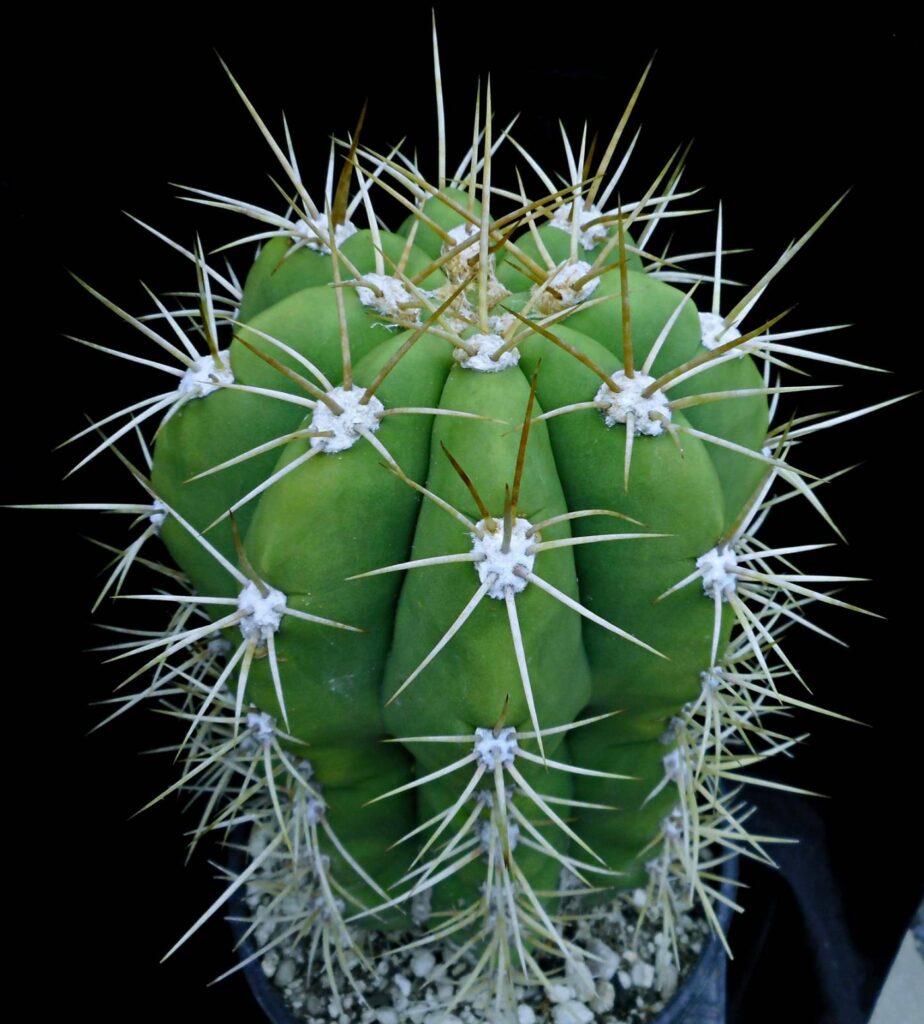

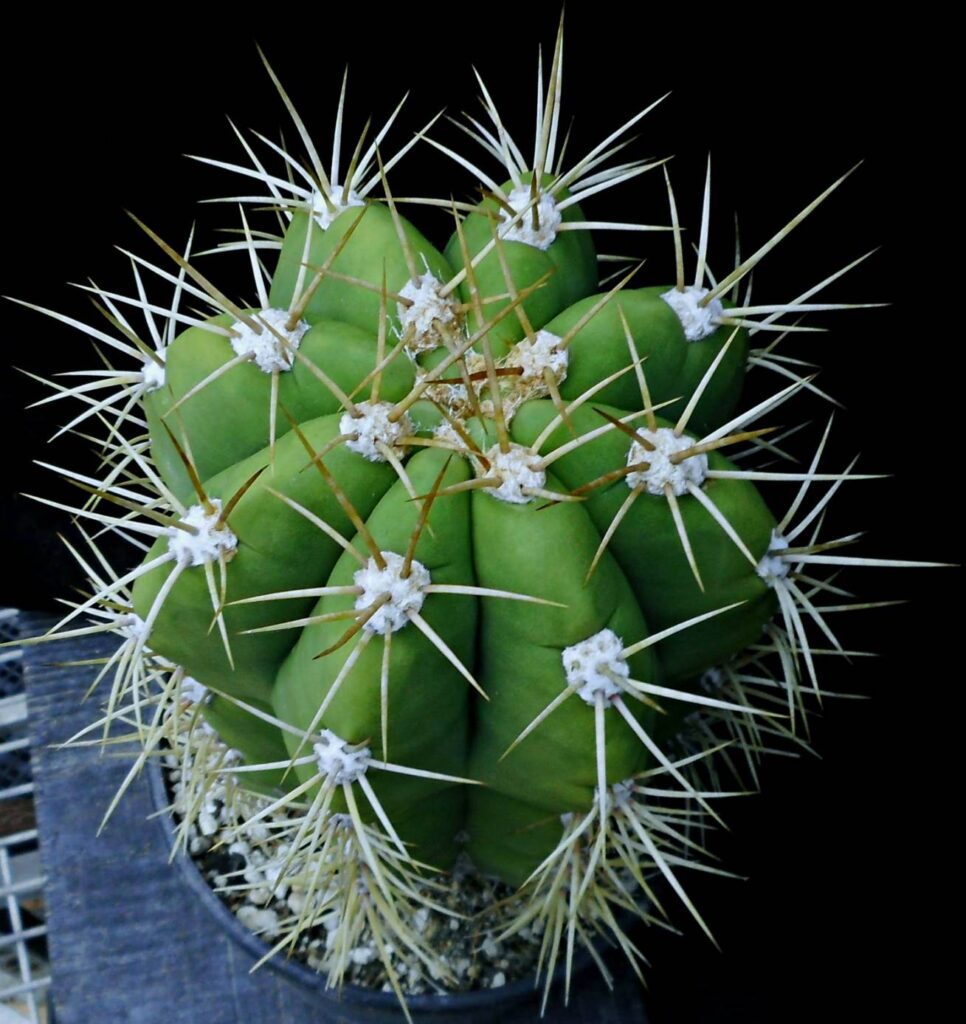 ↑ Auction specimen ↑
↑ Auction specimen ↑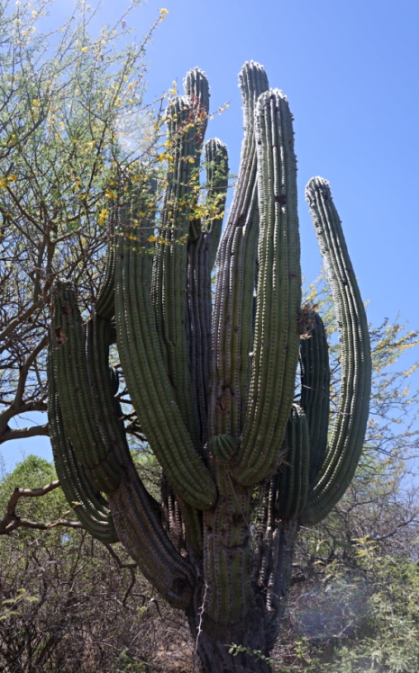
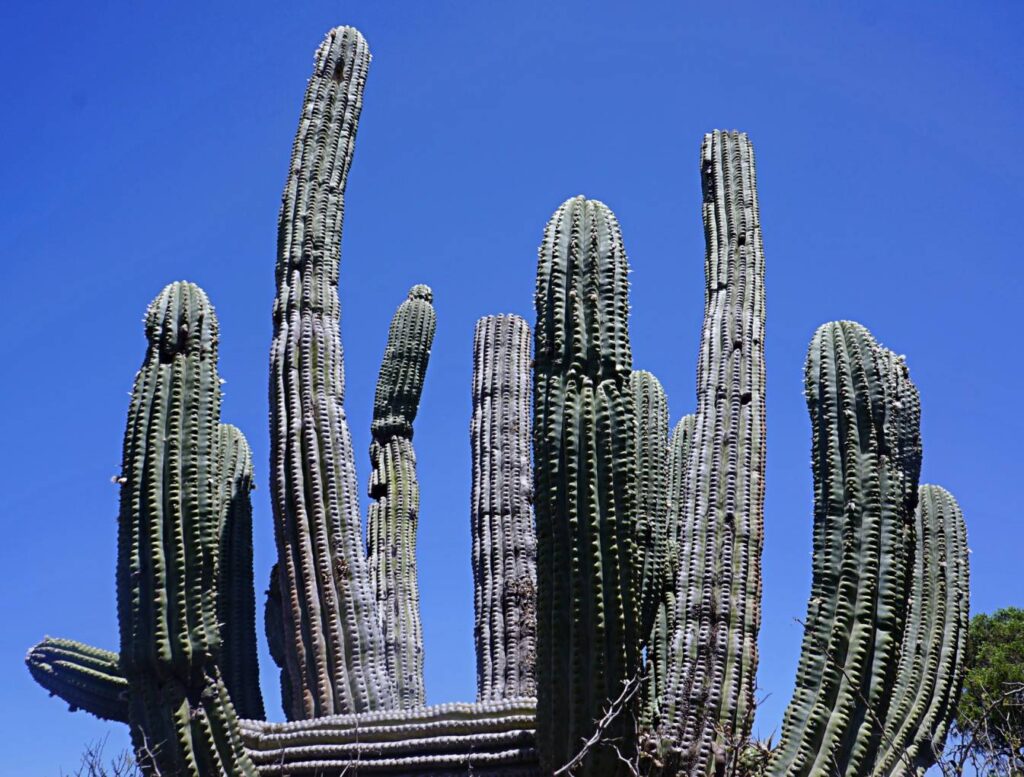
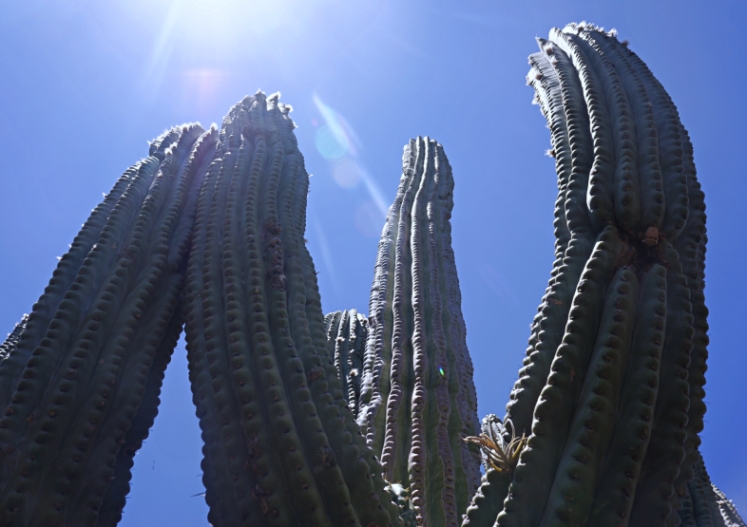
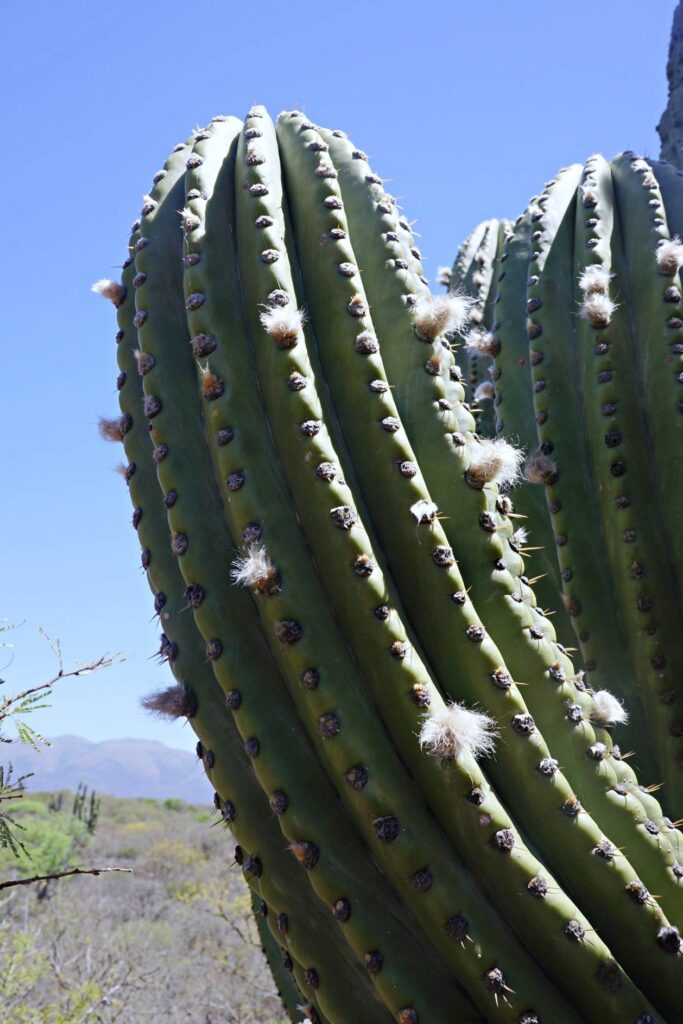 ↑ Trichocereus terscheckii in habitat, south Salta, Argentina ↑
↑ Trichocereus terscheckii in habitat, south Salta, Argentina ↑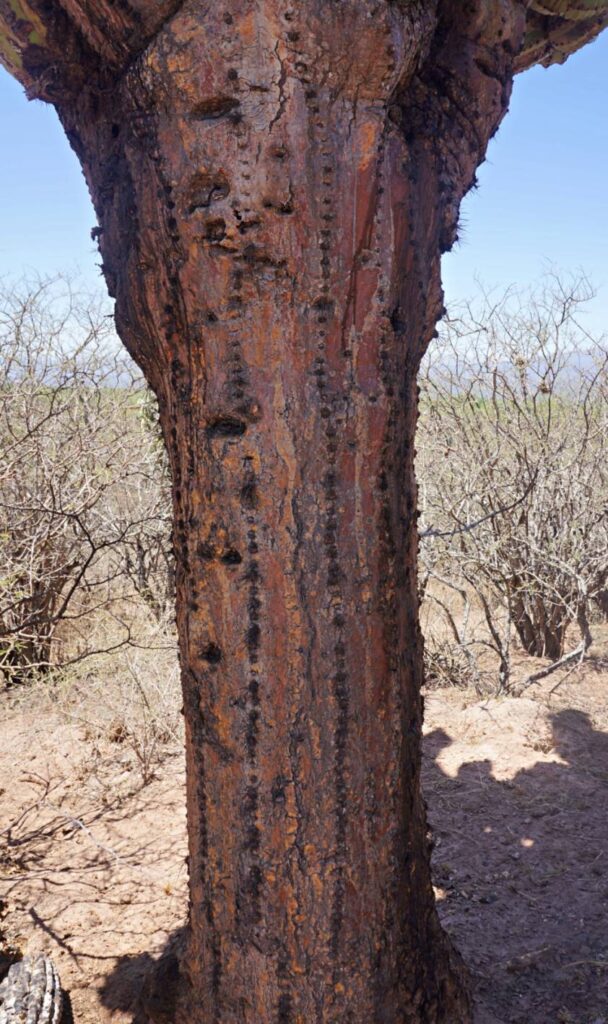 ↑ The massive trunk of a Trichocereus terscheckii ↑
↑ The massive trunk of a Trichocereus terscheckii ↑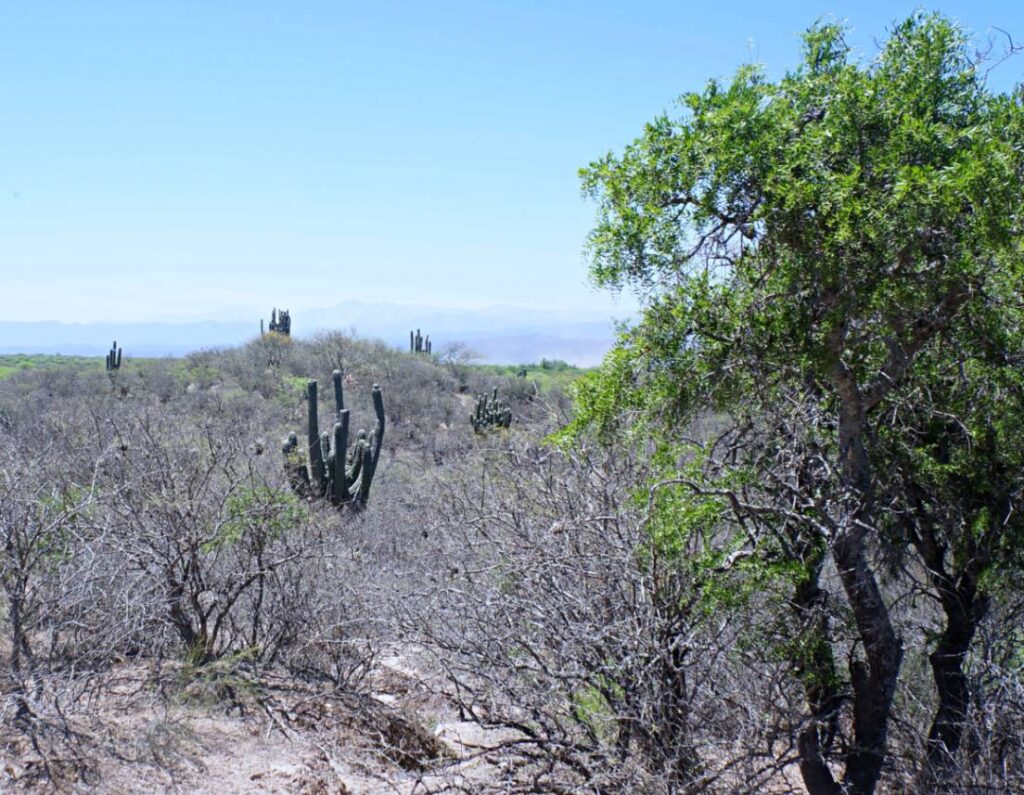 ↑ T. terscheckii and Aspidosperma/Acacia/Geoffroa dry forest, south Salta, Argentina ↑
↑ T. terscheckii and Aspidosperma/Acacia/Geoffroa dry forest, south Salta, Argentina ↑
___
Trichocereus sp. BK09508.2 “San Pedro de Chavín”
One of our legendary Chavín accessions! The mother was a large stand to over 12′ tall, individual stems to 3.5–4″ diameter with dark green epidermis. 5–7+ radial spines 0.5–1″ long, the downward facing ones up to 1.5″; one central spine 1.5–2.5″+ long. New spines yellow to red-brown in color. The Trichocereus in this region show a lot of morphological diversity; overall they appear intermediate to T. pachanoi/santaensis and cuzcoensis. Many of the stems of this impressive stand were covered in a couple different Tillandsia species, the larger of which were a striking burgundy color, and a small, epiphytic orchid. Growing with a diversity of companion plants, including Dodonaea viscosa, Kageneckia lanceolata, Satureja elliptica, Alonsoa sp., Berberis sp., Valeriana sp., Browellia multiflora, Tagetes sp., Bomarea rosea, Puya sp., Peperomia galioides, Anredera sp., and nearby—Borzicactus fieldianus, Peperomia aff. naviculaefolia, Sedum aff. reniforme, and Matucana sp. Occuring at 11,050′, at the edge of what looks like ruins or perhaps an old chacra wall; above Tres Cruces, on the western mountain just above the ancient ruins of Chavín, to the north side of the Wachesca River; eastern slopes of the Cordillera Blanca, Ancash Dept., central Peru. The 3000 year old temple complex of Chavín de Huántar is where the oldest depiction of a succulent plant (and possibly of its propagation) occurs—an anthropomorphic being carrying what is thought to be a rooted Trichocereus cutting. Interestingly, in cultivating this clone in northern California, the spines have remained shorter, often no more than 0.75–1.25″. We first released this clone into cultivation in 2016 and have only distributed around a dozen cuttings since then. The cut on offer is from plants grown outside, fully exposed to the elements and is therefore extra hardy, if a little weathered. A rare chance to obtain this beauty! Z9a [For additional info and photos, see our list of BK Trichocereus accessions]
9″+ long, 3.5″diameter cutting – 4 bids – winning bid $123* – Listing closed
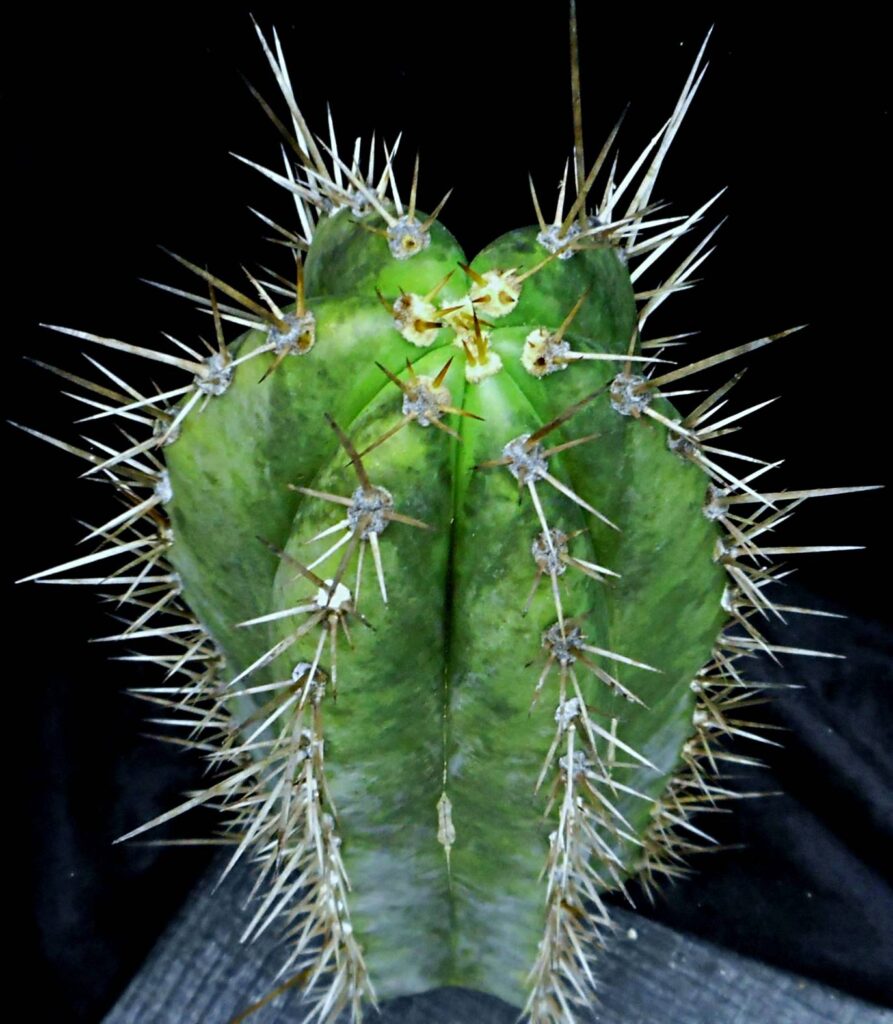
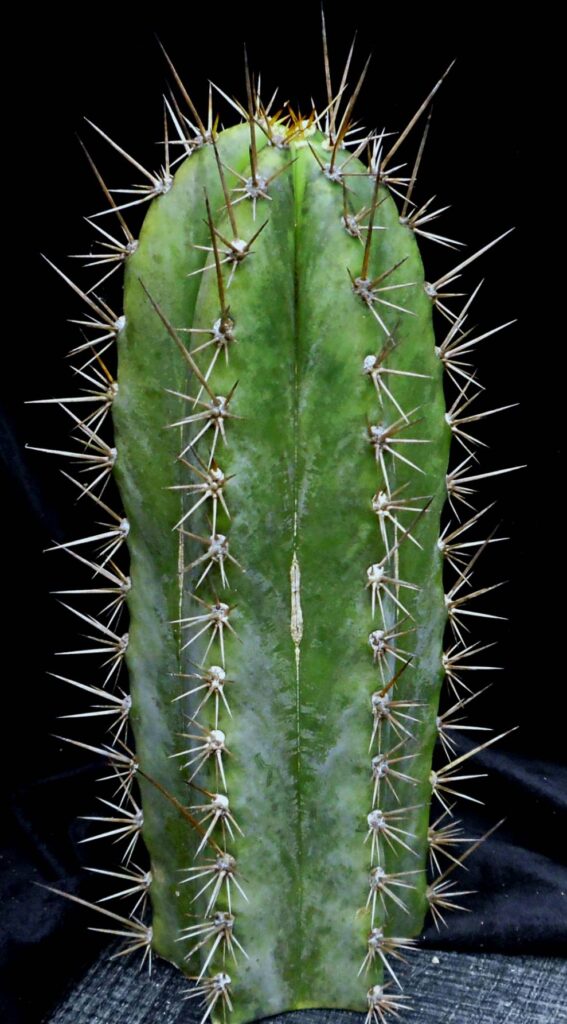 ↑ Auction specimen ↑
↑ Auction specimen ↑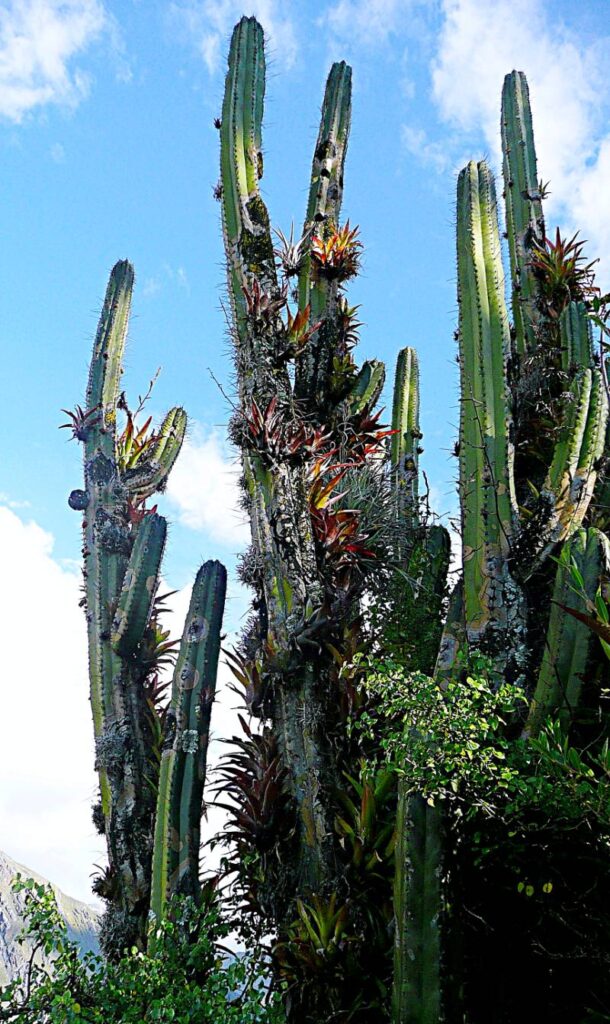
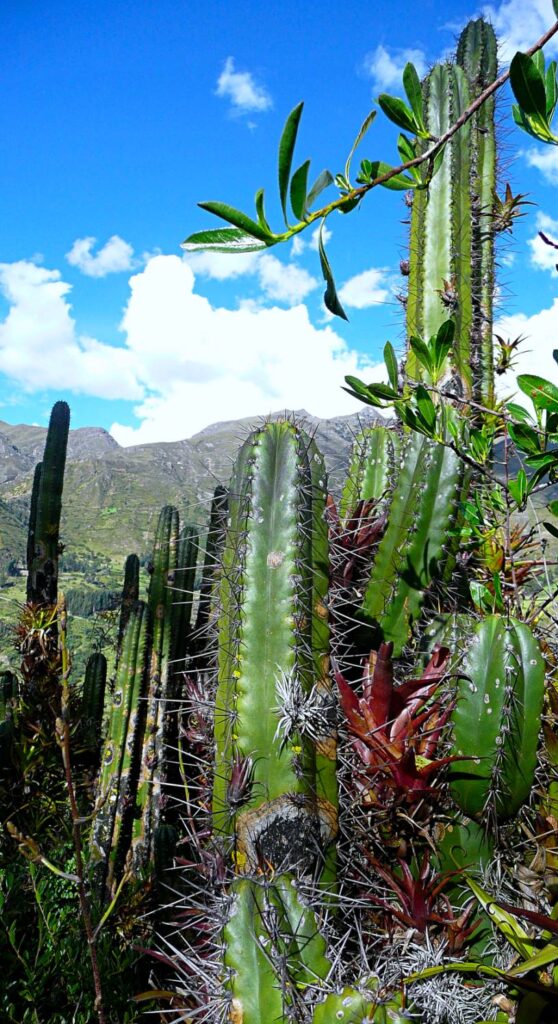


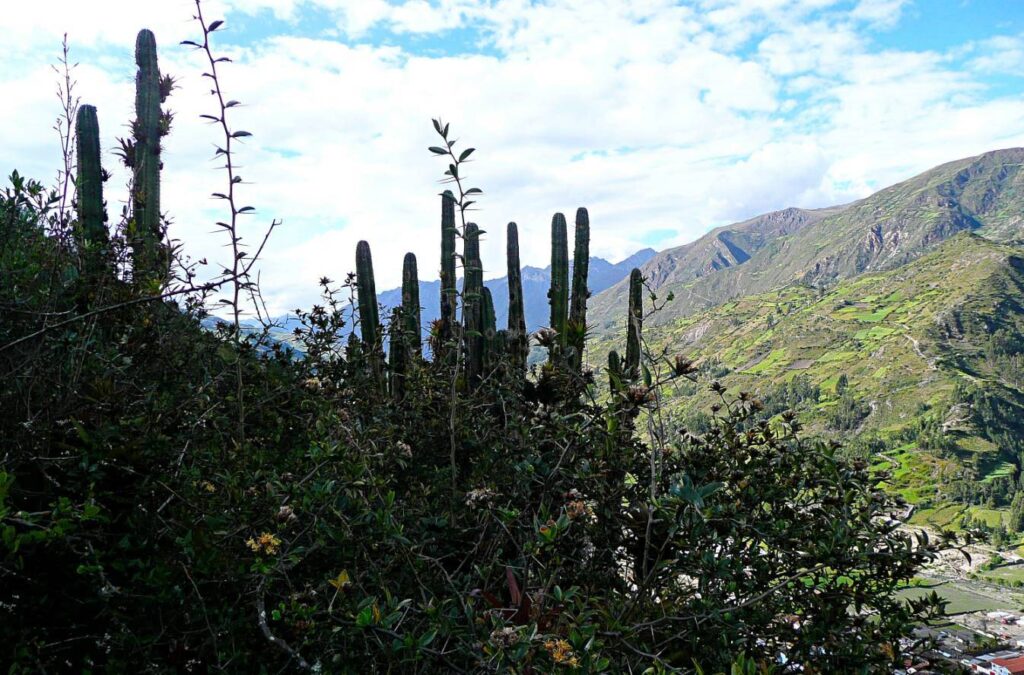 ↑ Mother plant in habitat above Chavín, Ancash Dept., Peru ↑
↑ Mother plant in habitat above Chavín, Ancash Dept., Peru ↑
___
♣
Other Succulents & Xerophytes
__
Ephedra fedtschenkoae ‘Ladakh’
Ephedraceae. An delightful miniature rhizomatic plant that forms tufts of blue-green stems 2–4″ high, eventually producing mats or small cushions. Shiny, reddish fruit. Among the tiniest Ephedra species. The plant takes on lovely orange and purplish hues during weather extremes. Seed collected by Pavelka from plants occuring in the dry stony slopes of the Ladakh Range, India, near 11,500′. One of the poorly understood and ephedrine-rich Asian alpine species. Readily adaptable to low elevations, if slow growing. Best cultivated in a gritty, mineral soil in a pot, trough or rock garden border. This superb dwarf plant could make a good groundcover companion to cacti. On offer is an old specimen bursting its pot with dozens of tufts. Z5?
3″ high, 6″+ diameter plant 18+ years old – 11 bids – winning bid $325* – Listing closed
___
Ochagavia elegans “Ajo Dulcie”
Bromeliaceae. Handsome rosettes of green to silvery pointed leaves to about 12″ long. Compact clusters of dark pink flowers in the center of the rosette followed by sweet edible fruit that looks like a garlic bulb, hence the local name “ajo dulcie”. This endangered pineapple relative is endemic solely to Robinson Crusoe Island, Chile, where it forms large, dense colonies on rocks and sheer cliff faces. An awesome rarity that will make a unique edible ornamental for the adventurous grower. Simple to grow, regular succulent care; drought and sun tolerant, does well in warm and/or cool conditions, large plants handle mild frost. We sold out of this desiderated beauty several years ago, this is your chance at a large rooted cutting. Z9b/10a
14″+ plant with 12″+ diameter rosette – 8 bids – winning bid $106* – Listing closed
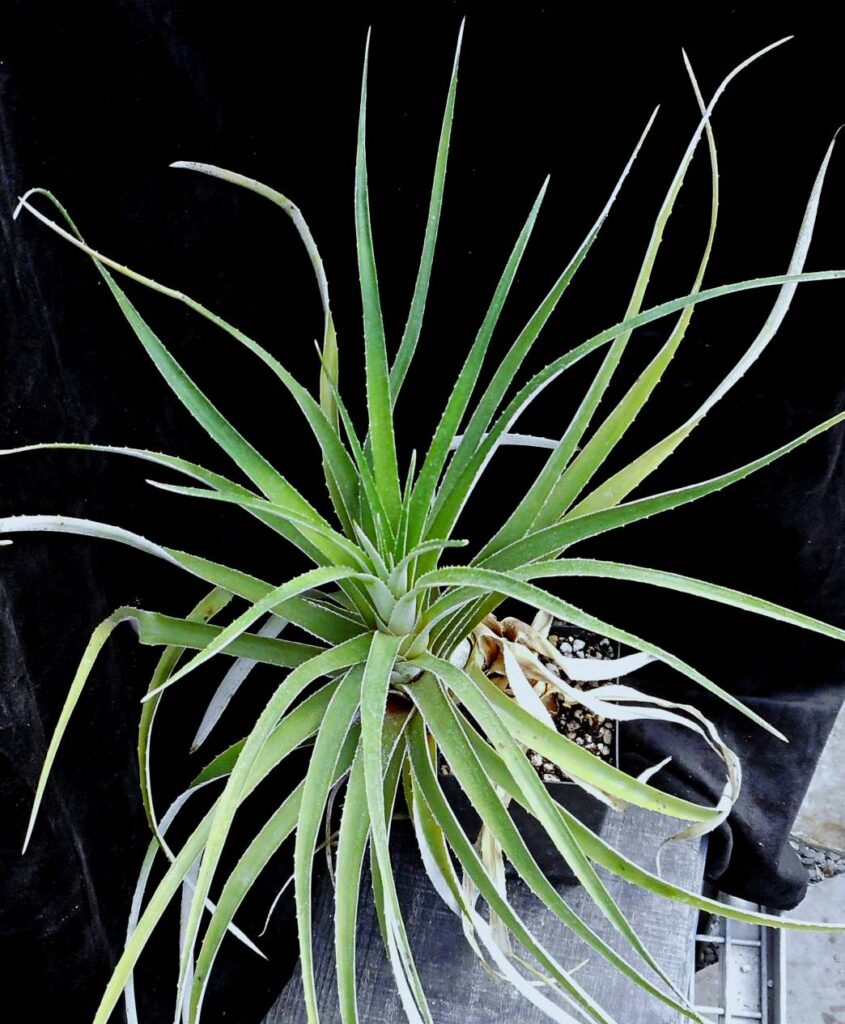 ↑ Auction specimen ↑
↑ Auction specimen ↑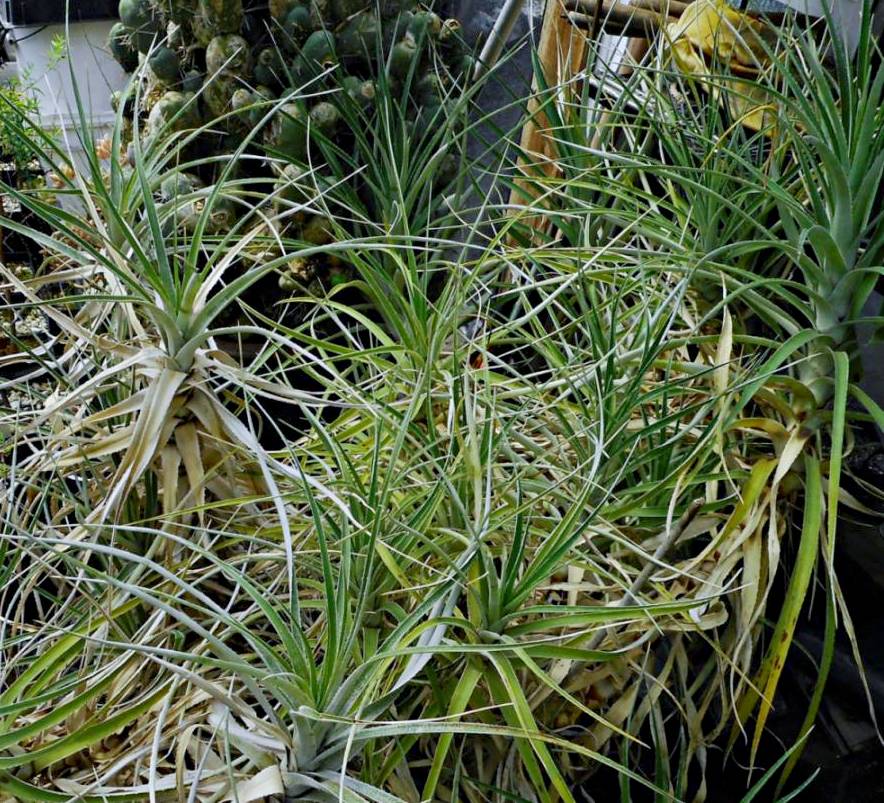 ↑ Mother plants ↑
↑ Mother plants ↑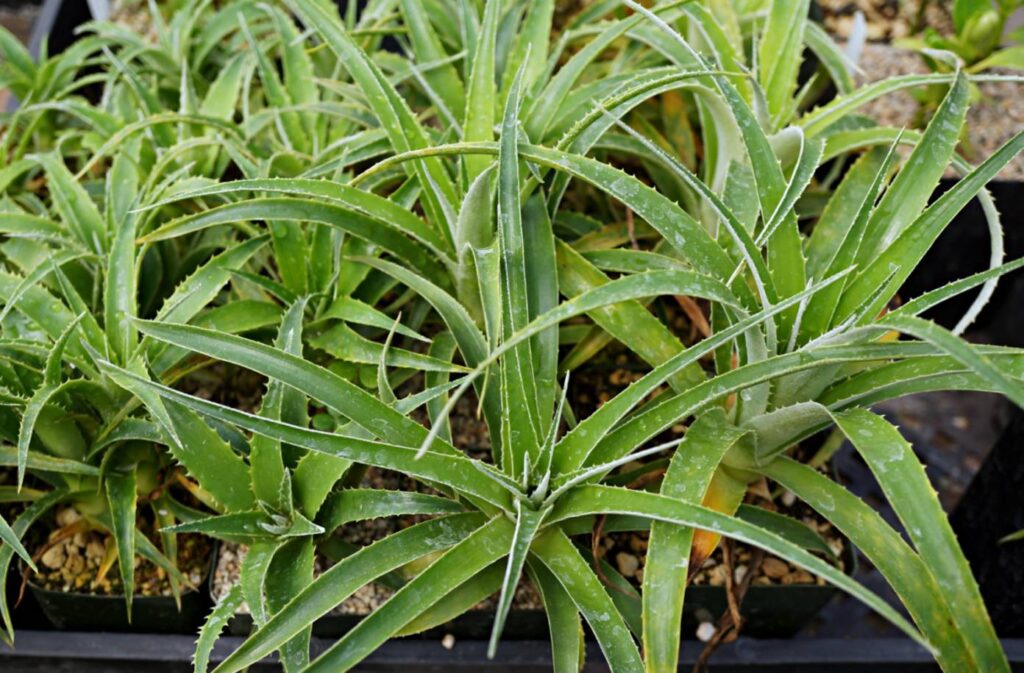 ↑ Seedlings back in 2014 ↑
↑ Seedlings back in 2014 ↑
___
Sceletium rigidum “Kougoed” “Kanna”
Aizoaceae. A small upright growing shrub to 14″+ that develops a candelabra of silver-gray stems tipped with numerous rosettes of attractive, lime-green, pointed leaves that turn purplish in full sun. The large water cells on the surface of the succulent leaves gives them a sparkling, gem-like appearance. Iridescent, pure white flowers. The old leaves dry and skeletonize, clothing the lower stems with their ghostly appearance. A distinct “Kanna” species from the arid Swartberg bioregion of South Africa. Reportedly medicinal/psychoactive like other Sceletium—which have a long history of traditional use as hypnotic-stimulants and more recently have proven themselves as a safe and effective herbal SSRI to elevate and regulate mood. Regular succulent culture, does best for us in a lean, sandy soil; sun and drought hardy. This larger growing species is probably our favorite of the genus, very seldom seen outside of habitat. A large, multibranched specimen with dozens of “heads”, represents about 5 years of growth from a cutting (clone B). Should be hardy to Z9a if kept dry.
12″+ tall by 8″ wide plant – 9 bids – winning bid $106* – Listing closed
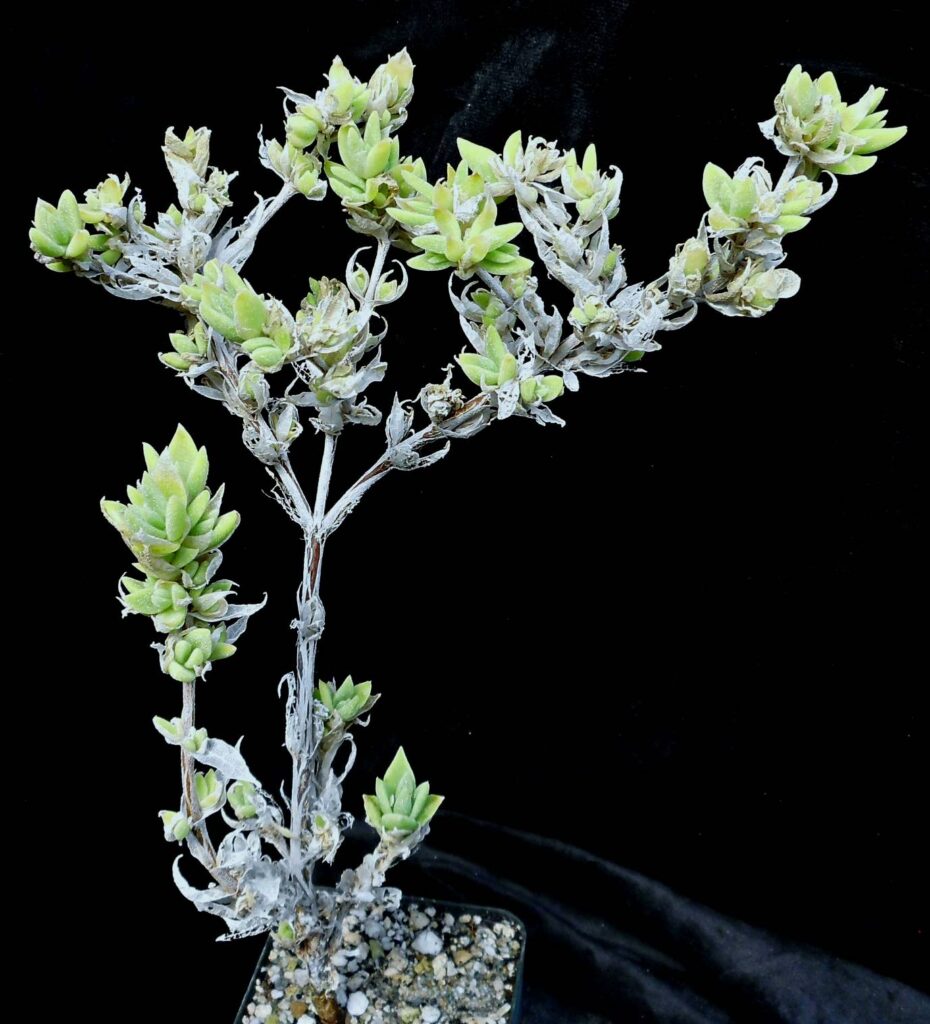

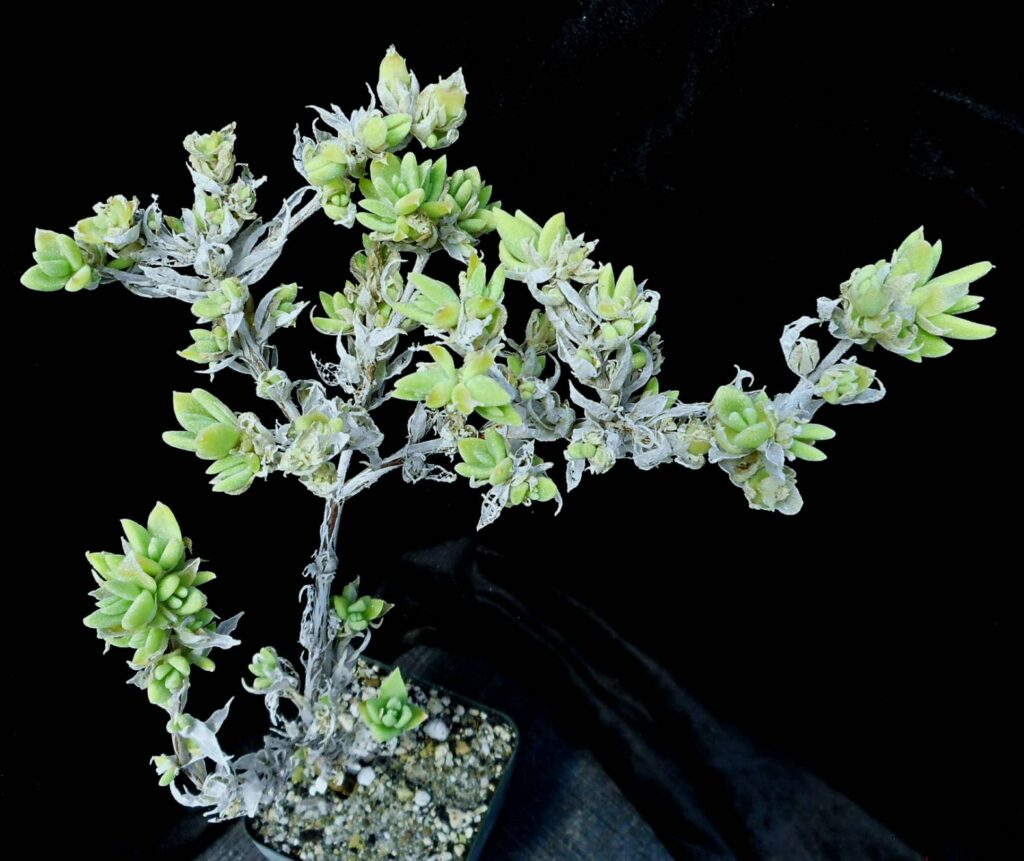 ↑ Auction specimen ↑
↑ Auction specimen ↑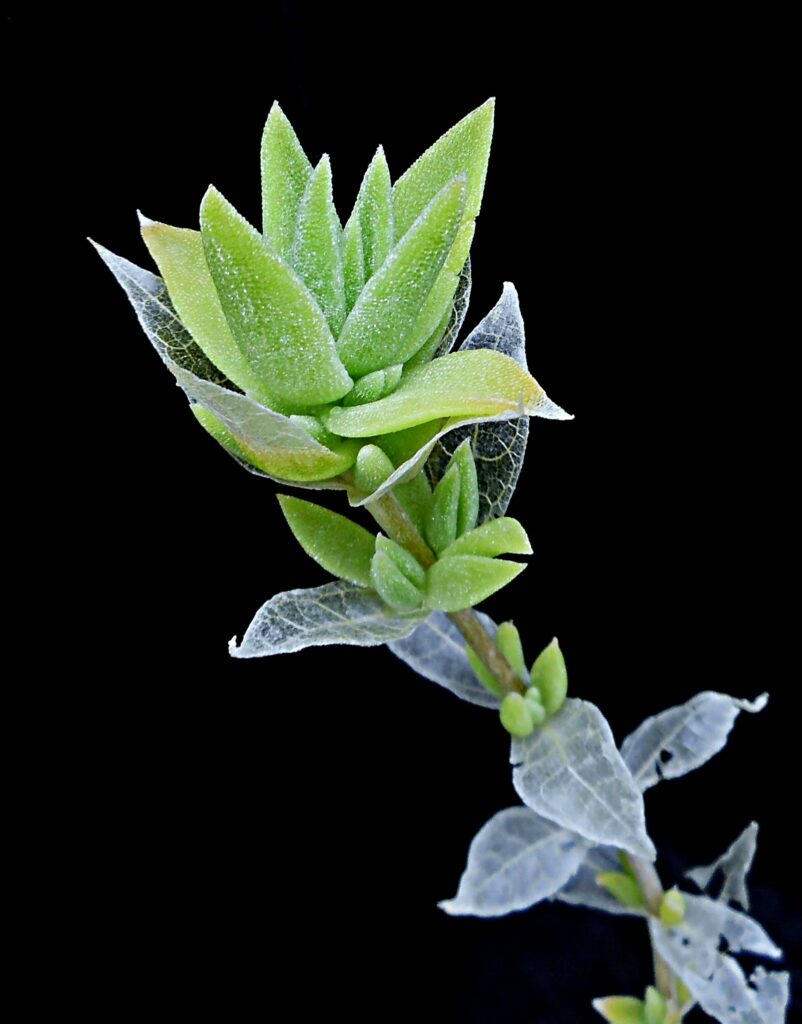 ↑ Detail of sparkly new leaves and skeletal old ones ↑
↑ Detail of sparkly new leaves and skeletal old ones ↑ ↑ Flowers ↑
↑ Flowers ↑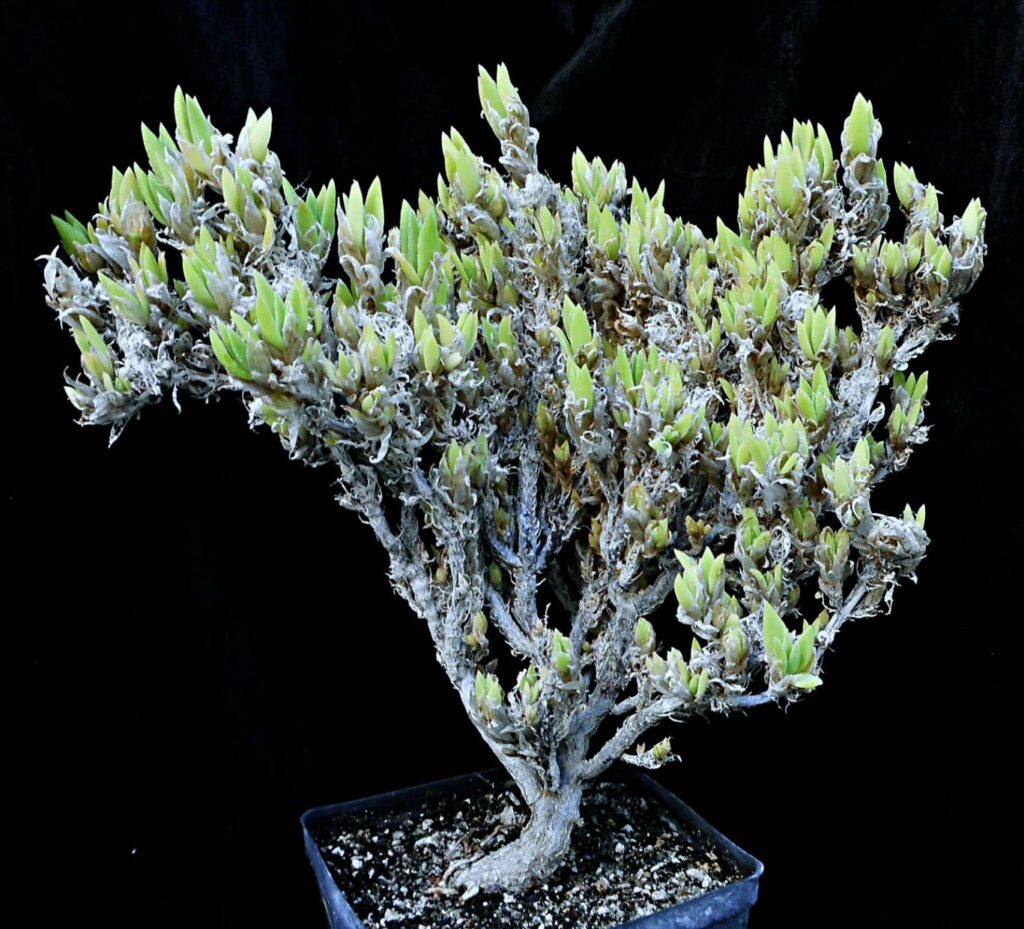
 ↑ Mother plant ↑
↑ Mother plant ↑
___
♣
Andean Ethnobotanicals
__
Pernettya sp. TB17P.4 “Macha-macha”
Ericaceae. An exceptional low growing shrub to 12″+ high and sprawling to to 24″+. Small glossy leaves densely arranged on the stems in a spiral formation, giving the branches an unusual cylindrical look a bit reminiscent of Peperomia cereoides; copper to reddish new growth. Tiny, white bell flowers spiral out from under the leaves; relatively large berries clothe the upper stem sections, starting white then ripening to pink, rose and lavender-purple. Probably part of the Pernettya prostrata complex, certainly one of the more distinct plants in this understudied genus. Tom Baldwin seed collection from the edge of Polylepis reticulata forest, highlands of Papallacta, Napo Province, Ecuador, near 10,800′. This Gaultheria and Vaccinium kin has sweet edible berries that should be eaten in moderation since some Andean Pernettya are known to have bizarre effects on memory and perception if consumed in quantity. Easily cared for, cultivate like a blueberry—acidic soil, sun to part shade; depending on the growing conditions the plants will be more shrubby and upright or sprawling, with the leaves in a looser formation or the dense, cylindrical form. Here’s your chance to obtain this wondrous and cold hardy neotropical blueberry! Z8a?
7″ plant 4+ years old – 6 bids – winning bid $81 – Listing closed
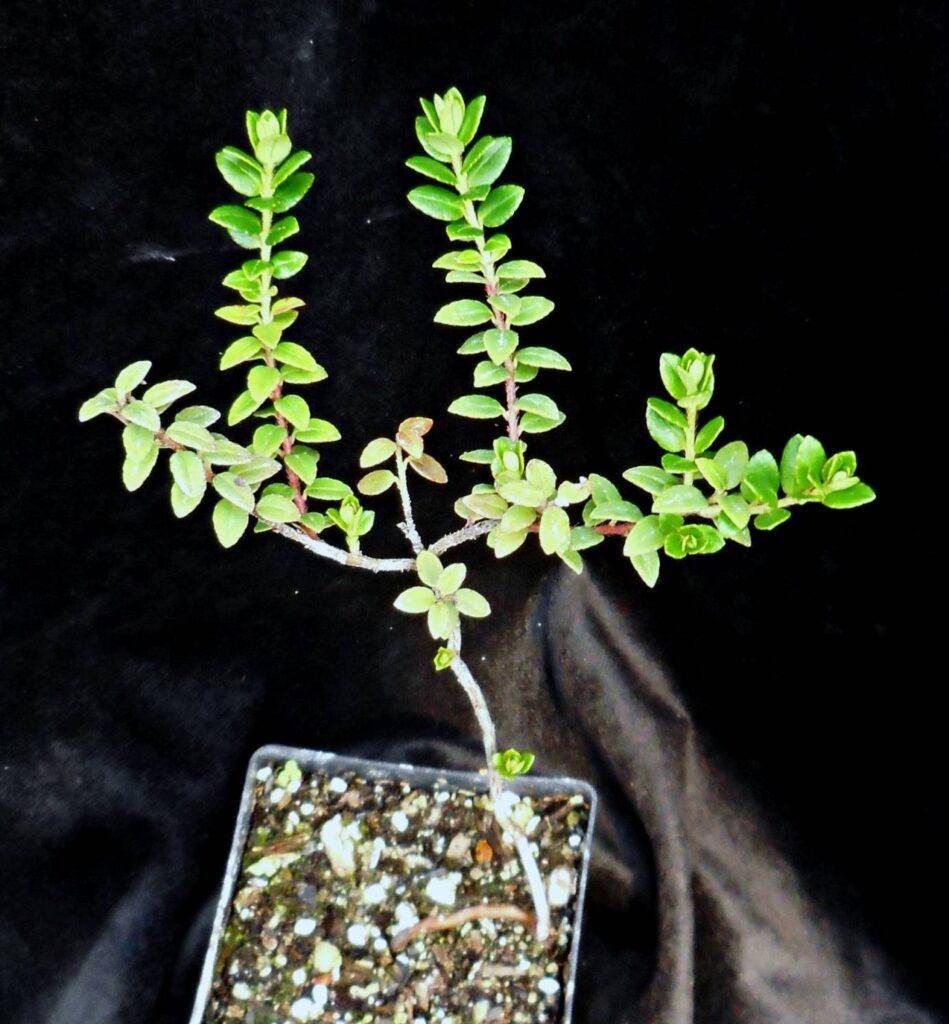
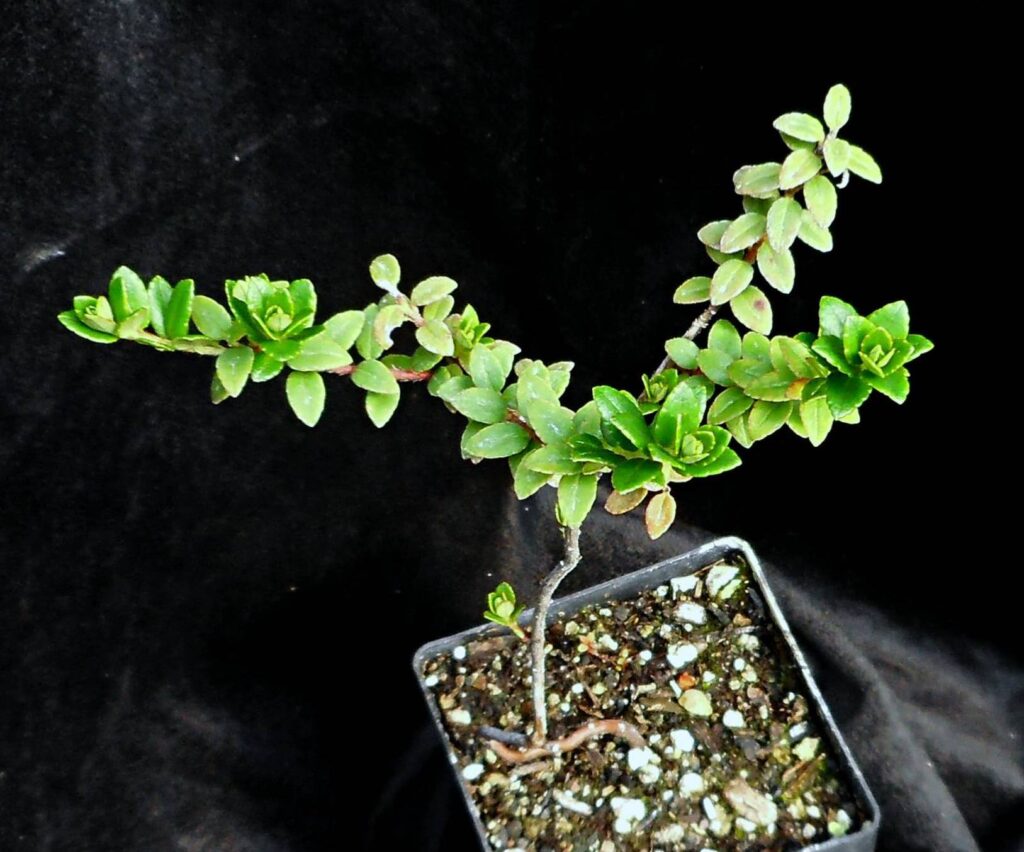 ↑ Auction specimen ↑
↑ Auction specimen ↑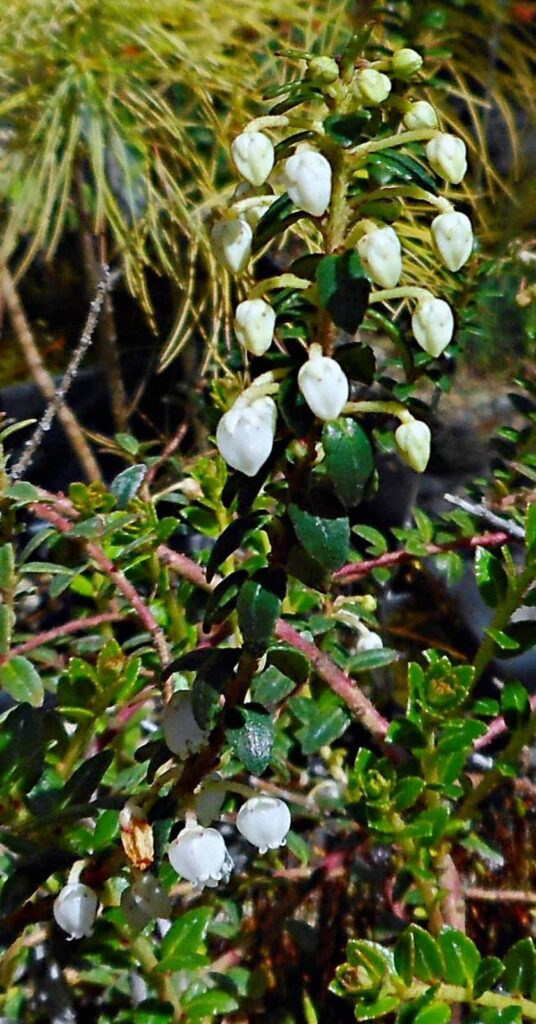 ↑ Flowers—young blossoms at top, mature ones at bottom ↑
↑ Flowers—young blossoms at top, mature ones at bottom ↑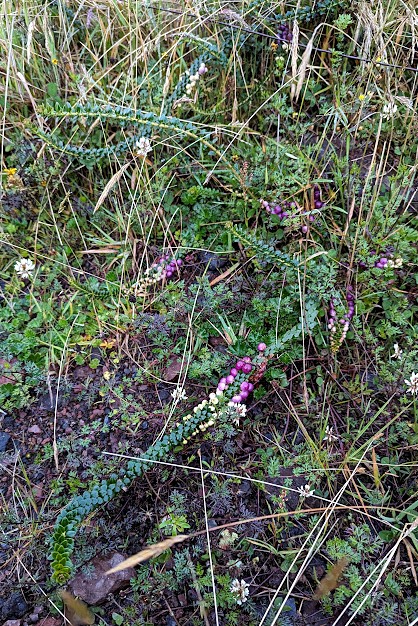
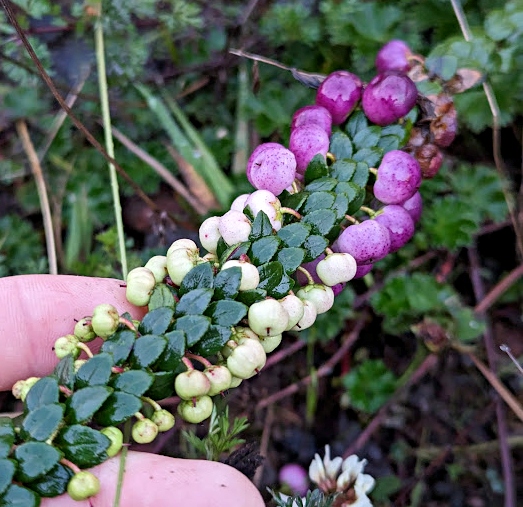
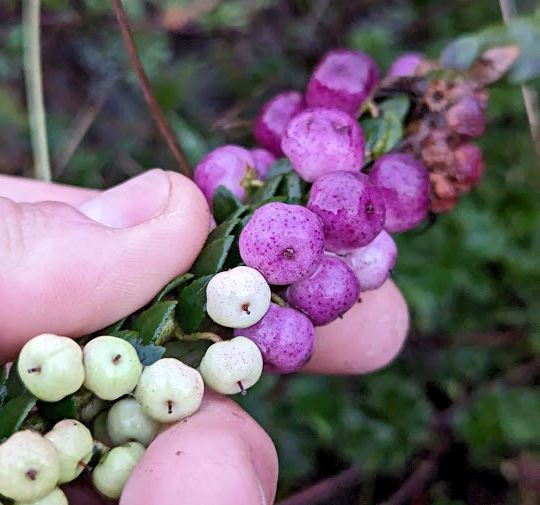 ↑ Pernettya fruiting with sprawling, cylindrical growth, Papallacta, Napo Province, Ecuador ↑
↑ Pernettya fruiting with sprawling, cylindrical growth, Papallacta, Napo Province, Ecuador ↑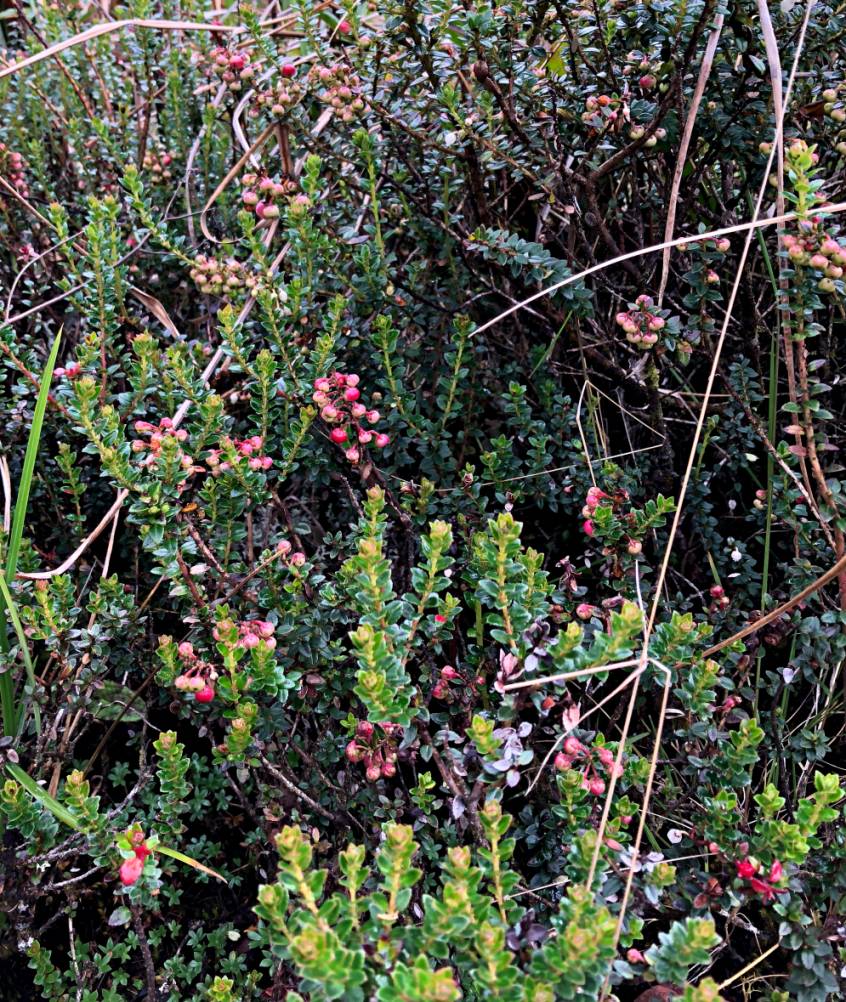
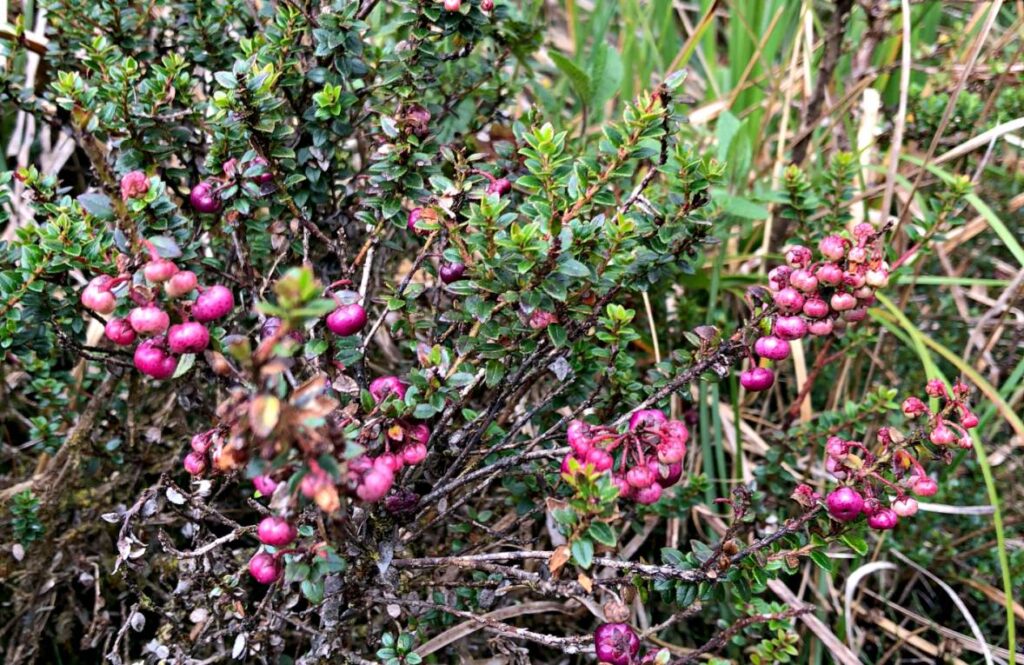 ↑ Pernettya fruiting with upright, shrubby growth, Papallacta, Napo Province, Ecuador ↑
↑ Pernettya fruiting with upright, shrubby growth, Papallacta, Napo Province, Ecuador ↑ ↑ Pernettya habitat—Polylepis reticulata forest, Papallacta, Napo Province, Ecuador ↑
↑ Pernettya habitat—Polylepis reticulata forest, Papallacta, Napo Province, Ecuador ↑
___
♣
Other Beneficial Plants
__
Salvia divinorum ‘Wasson & Hofmann’ “Pipiltzintzintli” “Ska Pastora”
Labiatae. Sprawling, leafy shrub 2–6′ tall. Thick, square stems that develop unusual wavy margins. Large and lovely, deep green simple leaves with lime green to electric-white veination. Under the right conditions the leaves develop a satiny bluish luster. Occasionally produces spires of white flowers with violet calyces. Riparian plant of Sierra Mazateca cloud-forests of Oaxaca, Mexico. Primarily known as cultivar as it has long been utilized as an entheogenic medicinal plant by the Mazatec; contains novel terpenoids. We first obtained this plant from the legendary mail order nursery …of the jungle in 1993 when we were 18 and first became fascinated with plants. We lost our original specimen some years ago and got a replacement from friends who’ve grown it since the 1970s—they believe it is the original clone collected by Gordon Wasson and Albert Hofmann (who postulated the plant was the mythological Pipiltzintzintli of Aztec codices), the same we had from …otj, but were not 100% sure, so the clonal I.D. is tentative. Though we kept a plant in our bathroom for decades (it loves filtered light and humidity), we’ve never listed it before… we rooted some cuttings last year and one has grown into too nice a specimen not to offer up to a new home! Prefers rich, moist soil; adaptable yet prefers cooler temperatures, frost tender but will regrow from the stems and roots. Well worth growing for the breathtaking ornamental foliage! Unfortunately, Western “civilized” cultures’ exploitative relations with plants and psychoactives led to the unscrupulous proliferation of high-potency extracts and subsequently the plant itself is now banned in many US states. Therefore, we can only accept bids from adults in the following states—AK, AZ, CA, ID, MA, MD, ME, MT, NH, NV, NJ, NM, NY, OR, SC, UT, WA, WV—and we offer this specimen exclusively as an ornamental for “aesthetic, landscaping, or decorative purposes”. Z9b/10a.
14″+ tall by 12″ wide plant with multiple stems – 8 bids – winning bid $250* – Listing closed

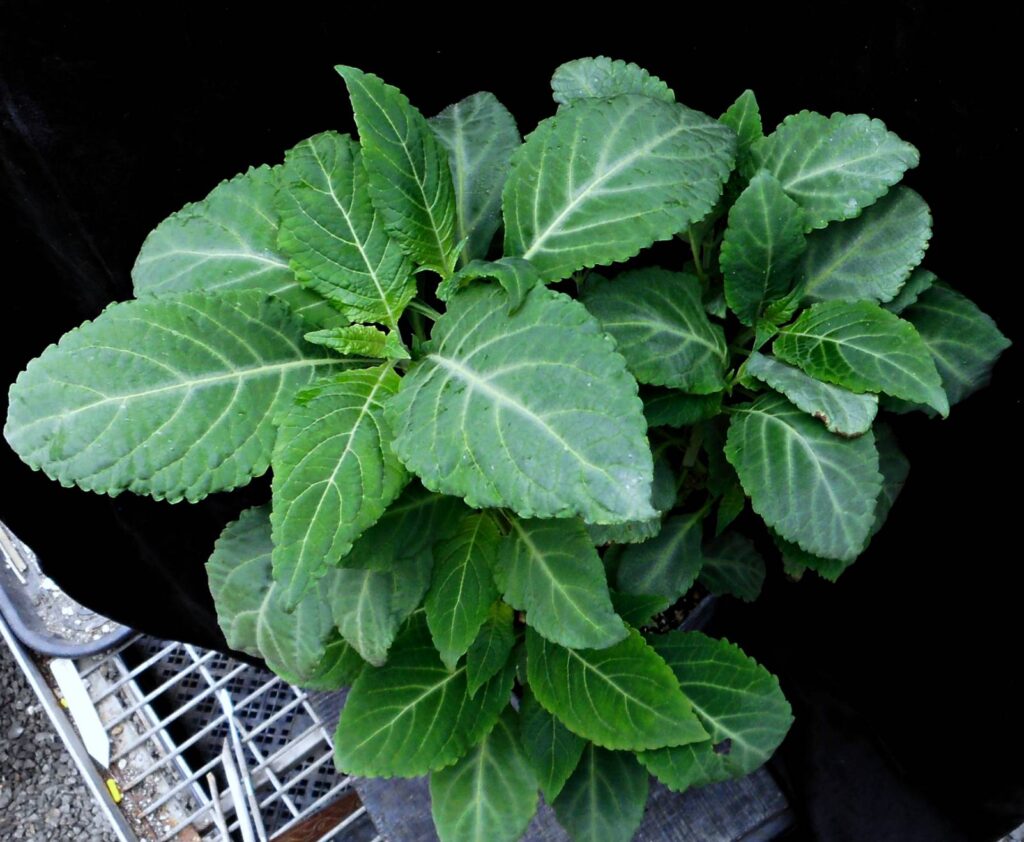
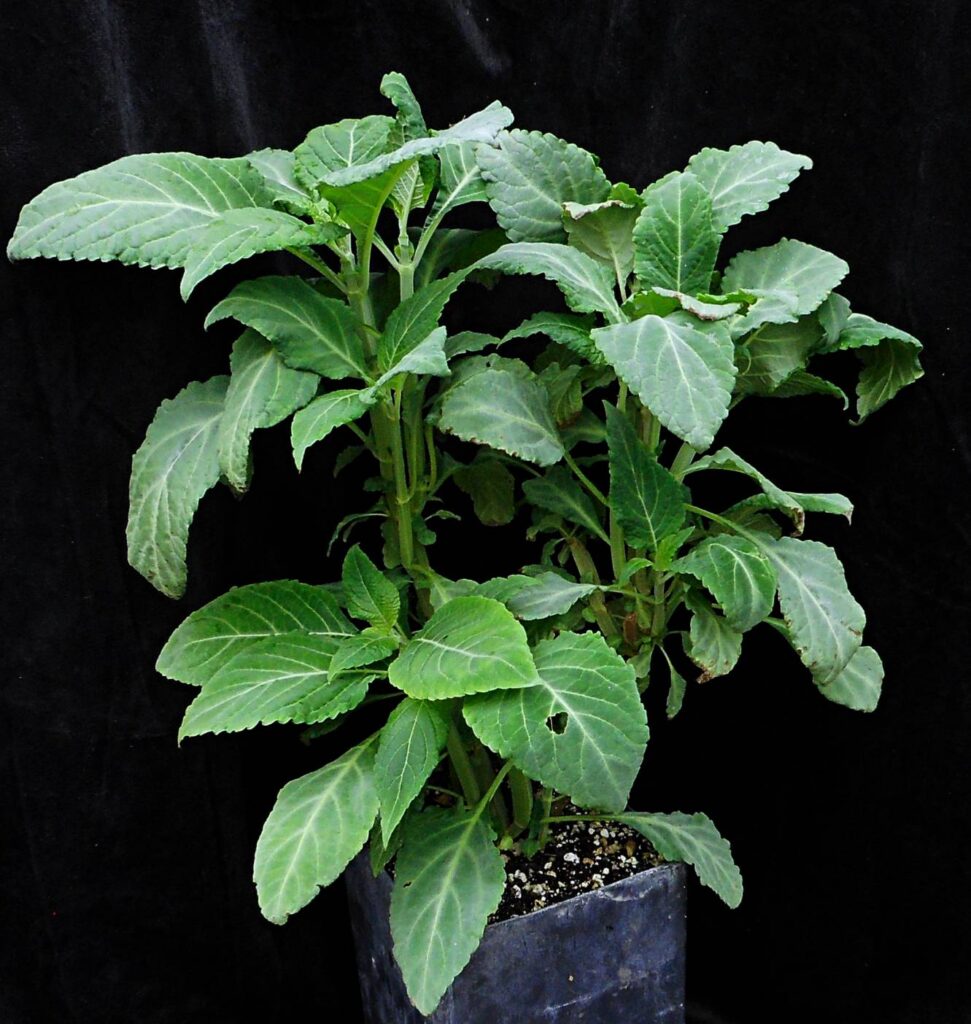
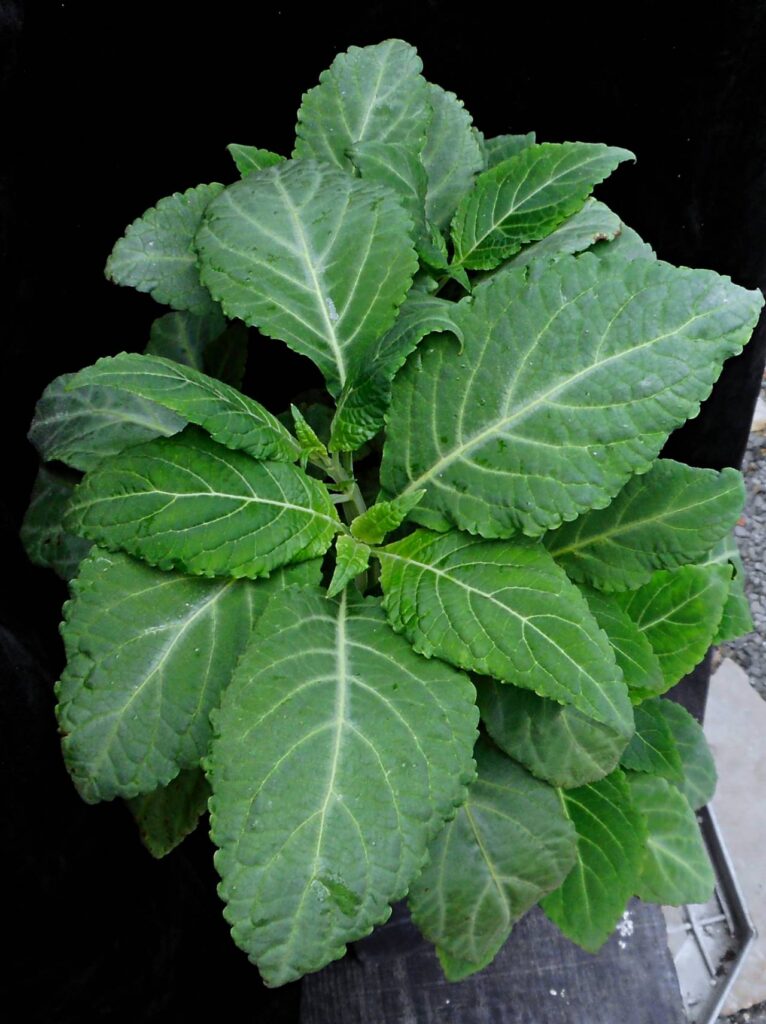 ↑ Auction specimen from multiple views ↑
↑ Auction specimen from multiple views ↑
___
Vaccinium stapfianum v. minus “Borneo Dwarf Huckleberry”
Ericaceae. A creeping evergreen species to just 5–10″ high. Tiny, glossy leaves, densely arranged on the stems, new growth is an incredibly showy—vibrant scarlet to deep crimson in color. Small, white-pink bell flowers and black fruit with a delicious sweet-tart flavor. A truly gorgeous, rare alpine blueberry from Mt. Kinabalu, Panar Laban, north Borneo near 11,000′. Slow growing yet easily grown in well draining, moist acidic soil—cultivating in strong light produces smaller, more compact plants, while partial shade produces taller plants; avoid baking summer sun. It’s been about a decade since we last offered this charming dwarf huckleberry whose fresh growth is more eye catching than many flowers! Well rooted cutting from our mother plant. Z8b/9a?
6″ tall by 6″ wide plant – 5 bids – winning bid $65 – Listing closed
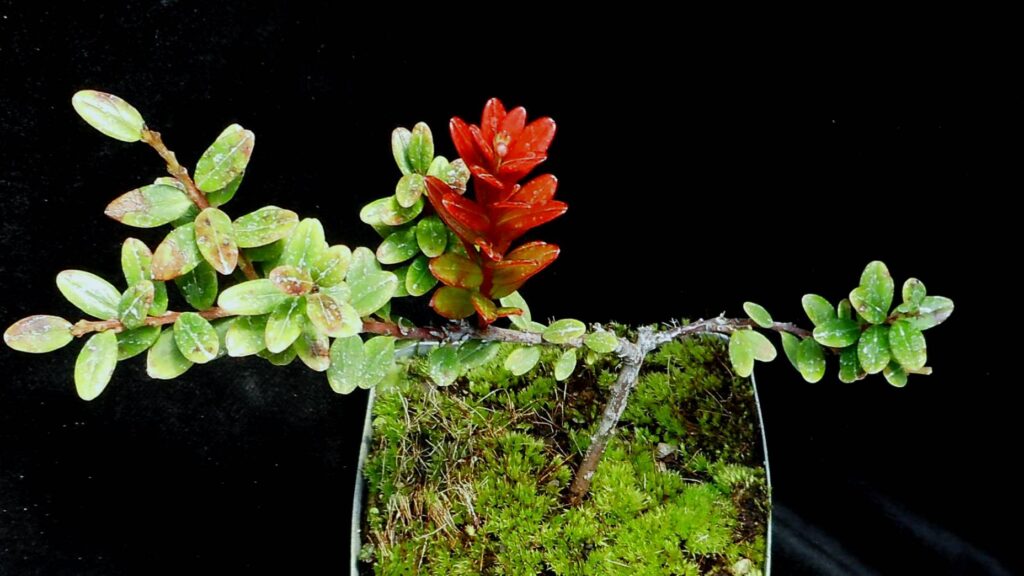 ↑ Auction specimen ↑
↑ Auction specimen ↑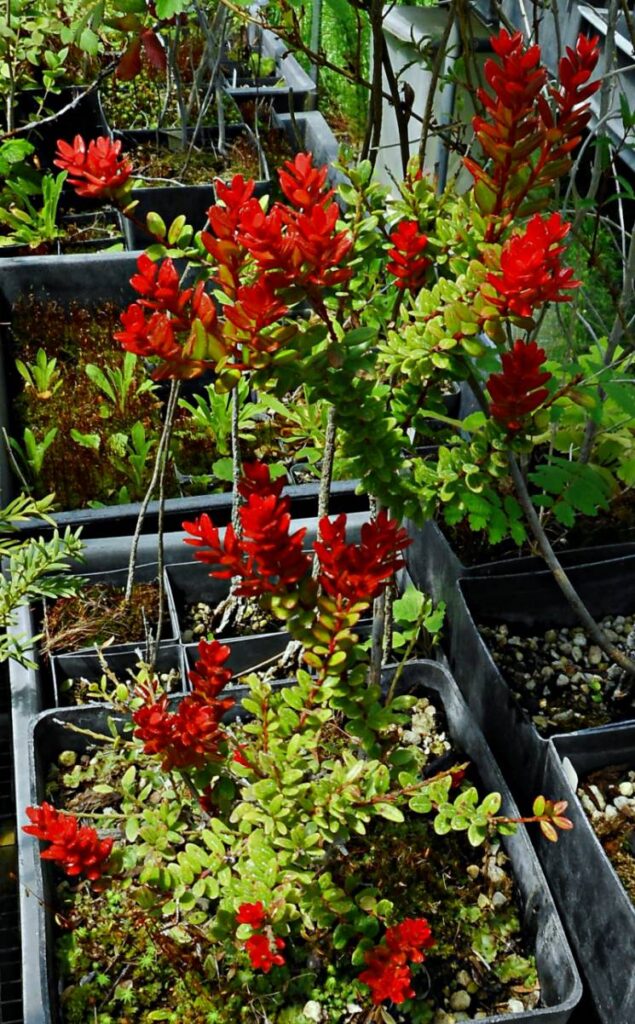
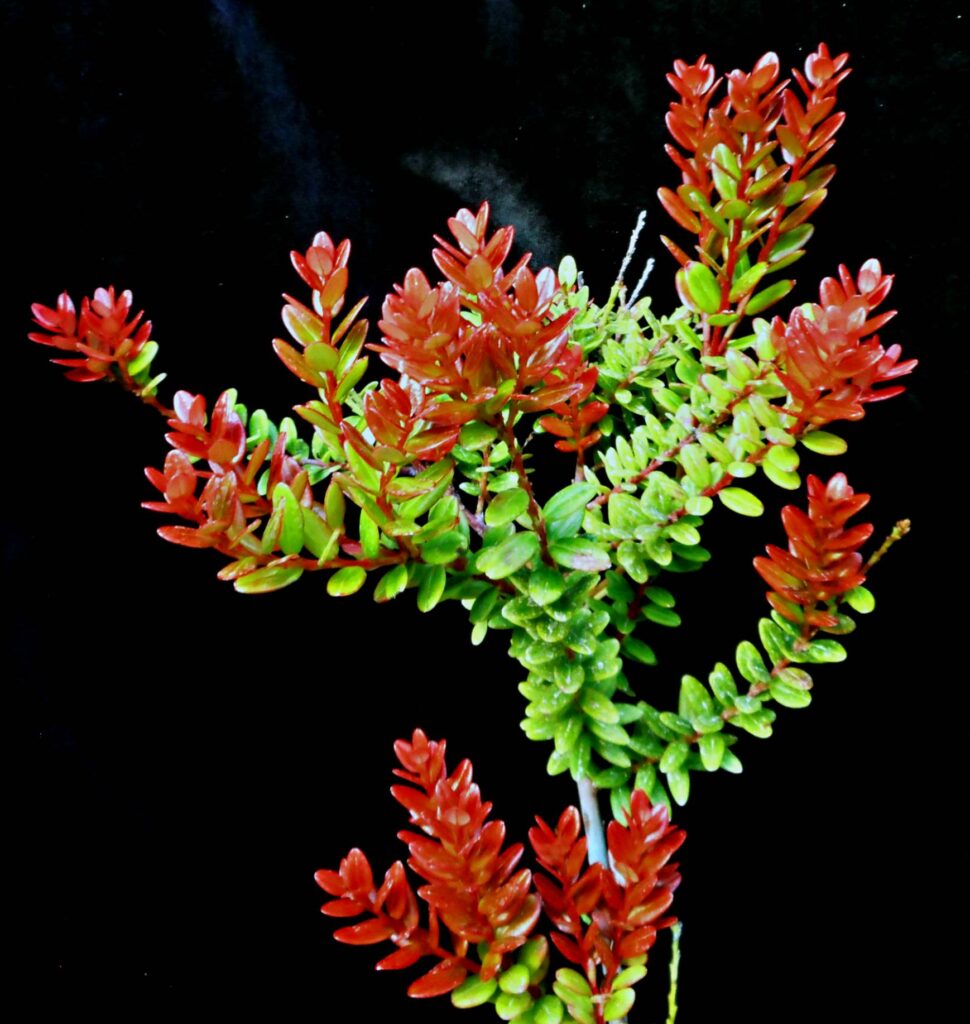
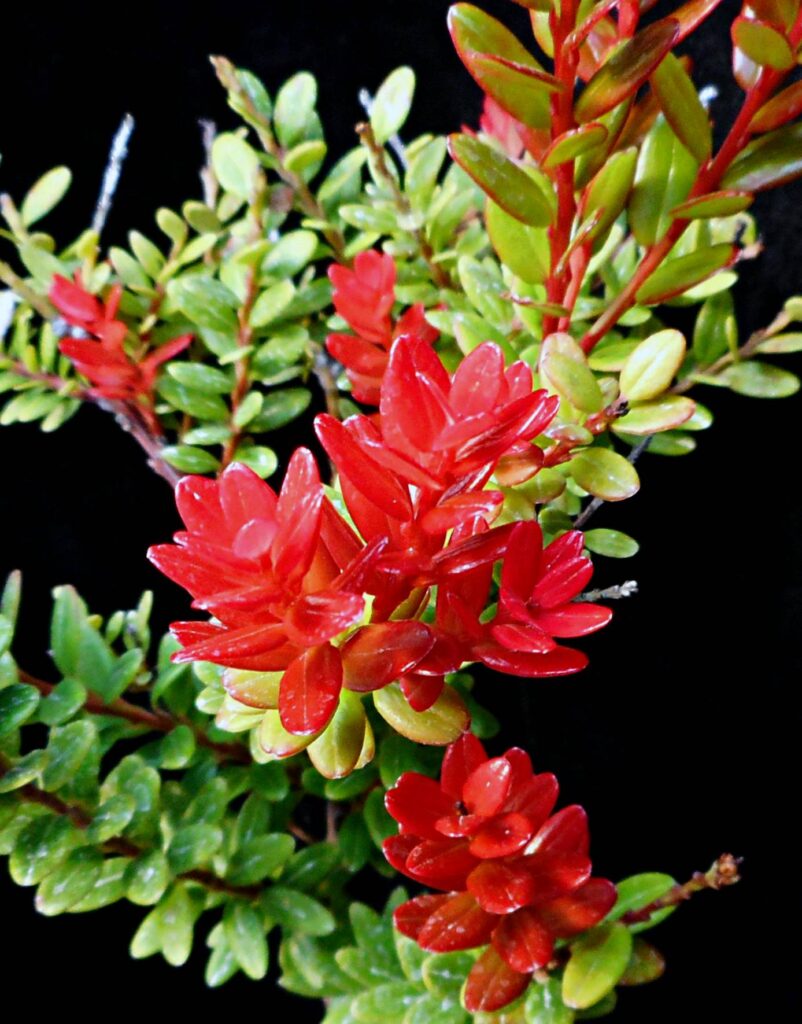
 ↑ Mother plant with vibrant new growth ↑
↑ Mother plant with vibrant new growth ↑
___
♣
BOOKS
[The book part of the auction is open to both US and international bidders!]
__
Sorry, no books this fundraiser!
__
For additional books, see our Rare & Used Editions and New Books
__
♥
~ end of auction list ~
♥
Auction closed at 6:00pm PST, Monday, May 26
__
Our abiding gratitude for your support!
◊
Shipping and Handling for Auction Plants
First Class Priority Mail = $10.00 for the first plant $2 each additional plant.
Express mail = Inquire for current costs
*Plants marked with a single asterisk* are large, heavy & have special shipping charges =
$18.00 for the first plant, $2 each additional plant.
**Plants marked with double asterisk** are extra large and/or heavy. We charge you the USPS postage cost plus a $6 handling fee on the total order. Please note: Shipping costs for these will be significant for folks in eastern states (for example a 36″ Trichocereus sent to the East Coast would be around $45-70+ shipping but less than half that for the West Coast). You may inquire the approximate shipping cost by emailing us your zipcode.
***Plants marked with triple asterisk*** are too large to ship – available for pick up, by appointment, at our home in Occidental.
Email to reserve plants and arrange pick up. For those further away, we will consider shipping, but the plants will need to be cut into smaller sizes – email for shipping quotes.
__
Shipping and Handling for Auction Seed
First Class Mail USA: $5.00 (seeds ride free when ordered with plants)
International: First class $20, or Priority Mail $45 (quickest, most secure, recommended!)
__
Shipping and Handling for Auction Books
To determine shipping costs, add up the number of lbs in parentheses ( ) that is listed after the price.
Priority Mail– add $10 for up to the first lb, $2 for each additional lb.
When shipped together with plants – just add $2 for each lb
Books only sent Media Mail – add $5 for up to the first lb, $1 for each additional lb
Please email us for international book shipping costs benkamm@monitor.net
__
California residents add 7.25% sales tax. Sonoma county residents 9%.
Order Form
Sacred Succulents, P.O. Box 781, Sebastopol, CA 95473 USA
♥
___
Previous Auction-Fundraisers:
_ ___________________________________________________ _
December 2024 Auction-Fundraiser Offerings:
♣
~ The final Auction-Fundraiser of 2024 closed at 6pm PST 12/18/24 ~
The winning bids are all posted. Thank you for your support!
Auction Seed
[The seed part of the auction is open to both US and international bidders!]
Trichocereus bridgesii SS02 X Trichocereus bridgesii f. monstrosus cl. C
A totally new introduction! The long popular and robust bridgesii SS02 clone crossed with the unique T.b.m. clone C [slender, melted-wax to semi-normal stems—often 4 ribbed]. We are hopeful unique new mutant bridgesii will arise from this cross. Be the first to find out! Z9a
Packet of 15 seed — 6 bids – winning bid $45 Listing closed!
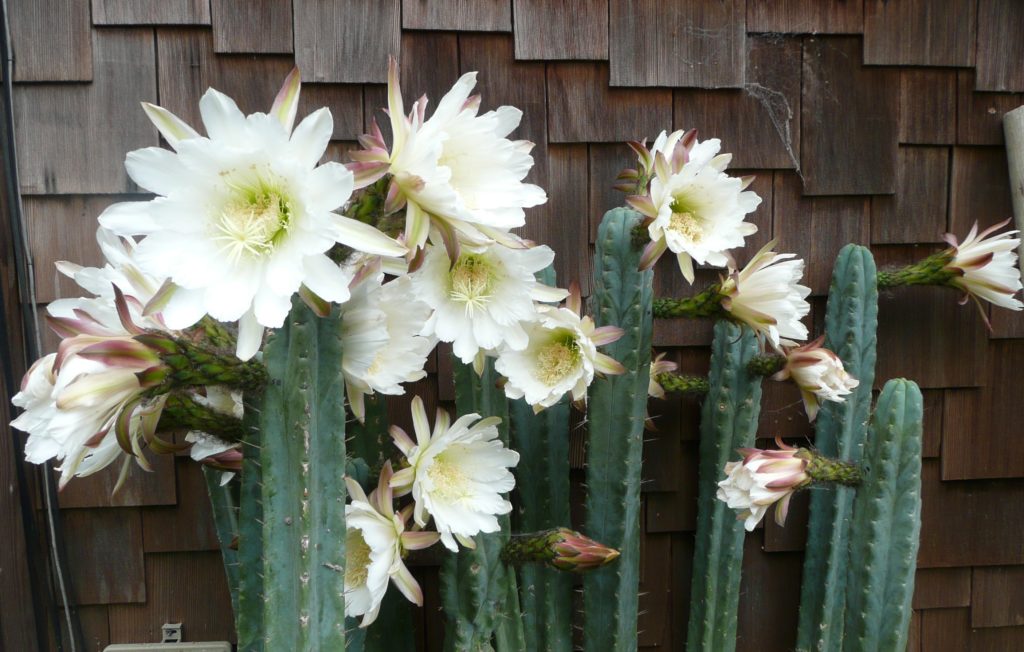
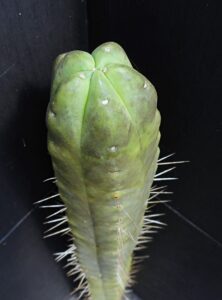 ↑ Mother plant ↑
↑ Mother plant ↑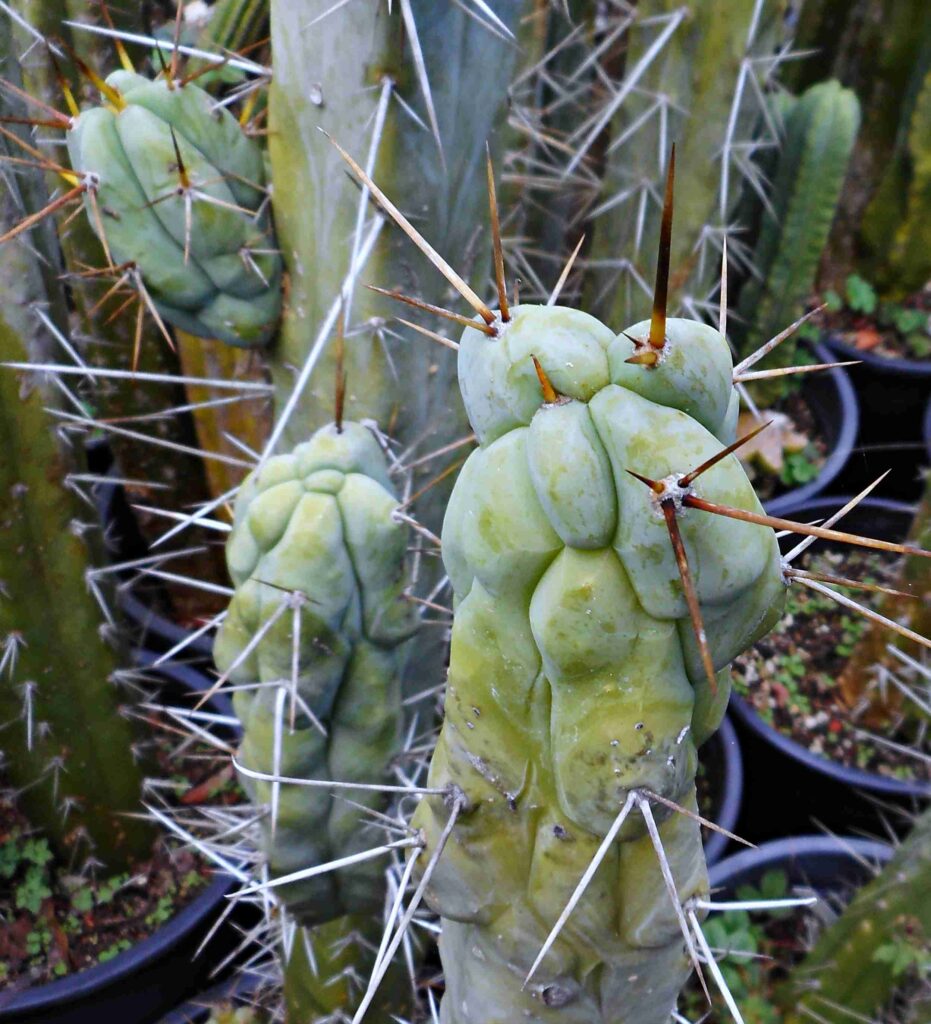
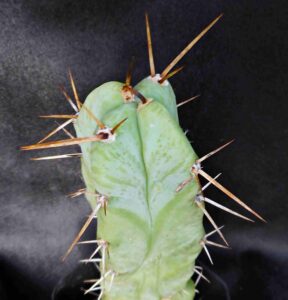
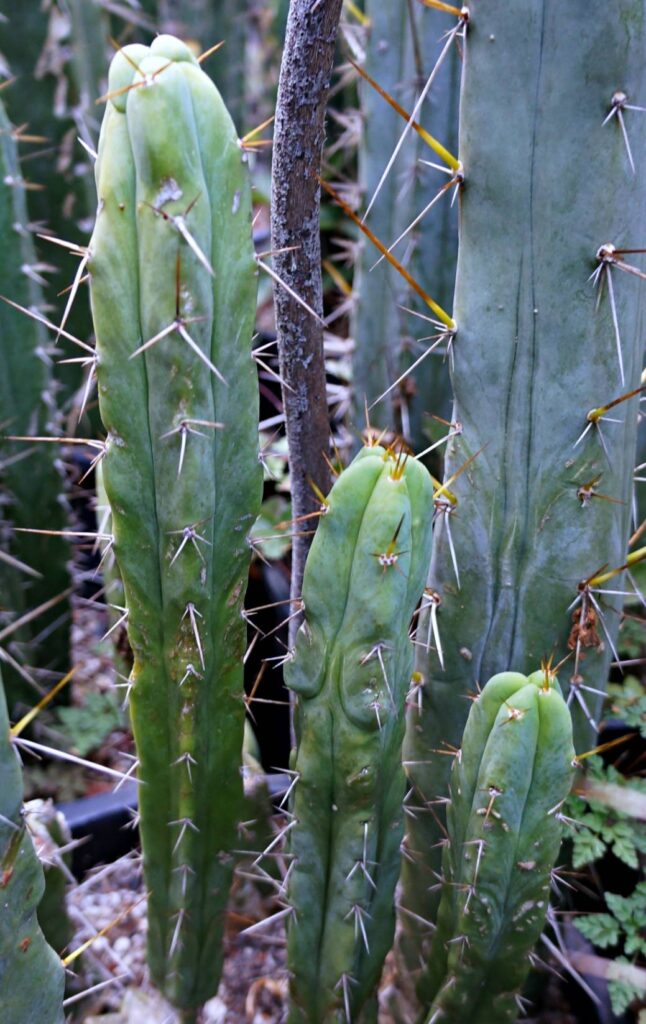 ↑ Father plant ↑
↑ Father plant ↑
___
♣
Auction Plants
[We only ship plants to US addresses!]
Cactaceae
↔
Echinopsis subdenudata ‘Fuzzy Navel’ X Trichocereus peruvianus/ ‘Juul’s Giant’ hybrid f. monstrosus
Since first releasing this fun furry hybrid via auction last year, we’ve gotten repeated requests for plants—we are pleased to have another hale and happy seedling up to an offerable size. The young progeny of this novel pairing already have thick areoles with abundant fleece—we eagerly anticipate the maturation of this sure-to-be unparalleled pilose beauty! The mother, Echinopsis subdenudata ‘Fuzzy Navel’, is a tiny spined, clustering plant with small globular stems to 4″+ bearing fluffy tufts of velvet-soft, white fur at each ‘polka-dot’ areole; sweetly scented white blossoms with long, slender floral tubes; impregnated by our robust T. peruvianus/’Juul’s Giant’ aberration, beloved for its fat bluish stems, highly diverse monstrose to cristate growth, and large mutant blossoms. 3rd ever offering of this remarkable wooly hybrid. We’ve already observed some mutations, including crests, among the scant seedlings and there is a distinct possibility of monstrose growth developing as this plant matures. Z9a?
1.75″+ plant 3 years old – 3 bids – winning bid $100 Listing closed!
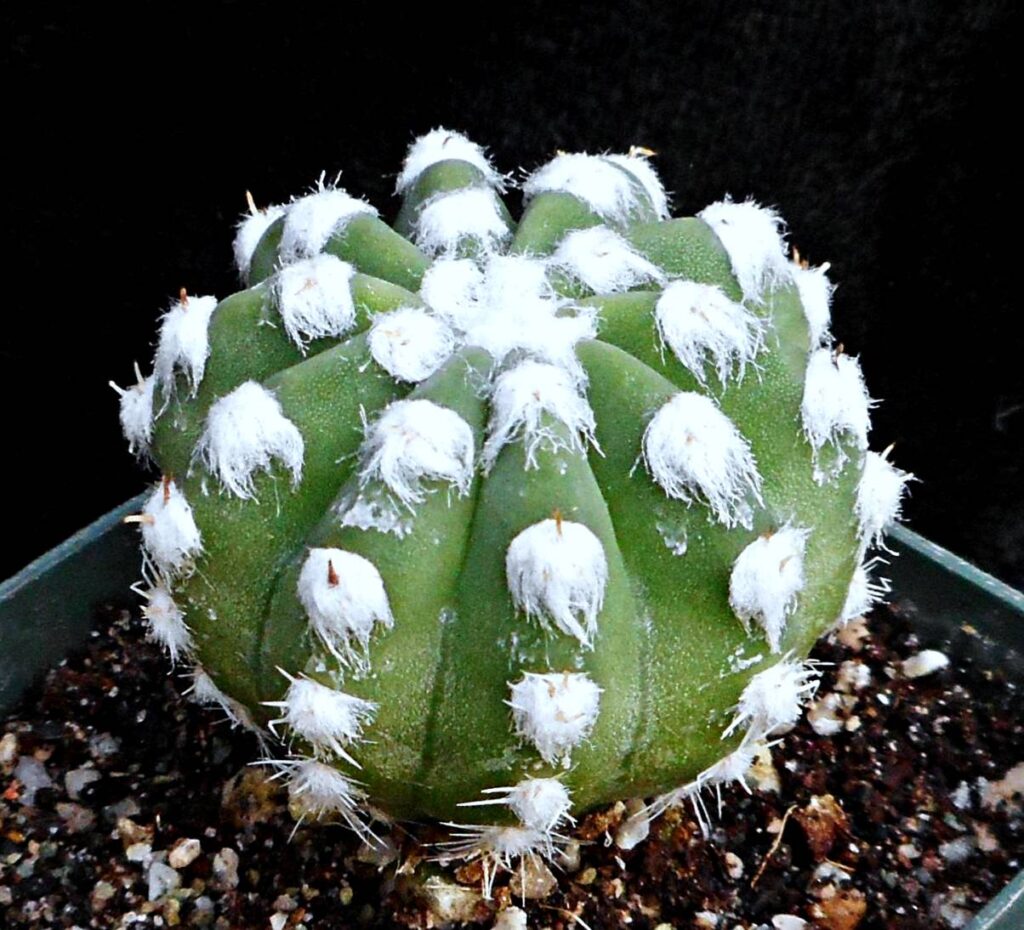 ↑ Auction specimen ↑
↑ Auction specimen ↑
___
Trichocereus bridgesii f. monstrosus cl. A ‘Normal’ “Achuma” “Bolivian San Pedro”
We have grown the classic, nearly spineless, ‘penis cactus’ for nearly 3 decades. Every once in a while it will produce a stem that is a revert to ‘normal’ bridgesii form—distinct glaucus blue stems and very long yellowish spines. The few times this clone has bloomed for us over the years, it was from such a stem. It is very rare for us to offer a ‘normal’ stem such as this. A robust and well armored cutting. Z9a
35″+ cutting – 6 bids – winning bid $175** Listing closed!

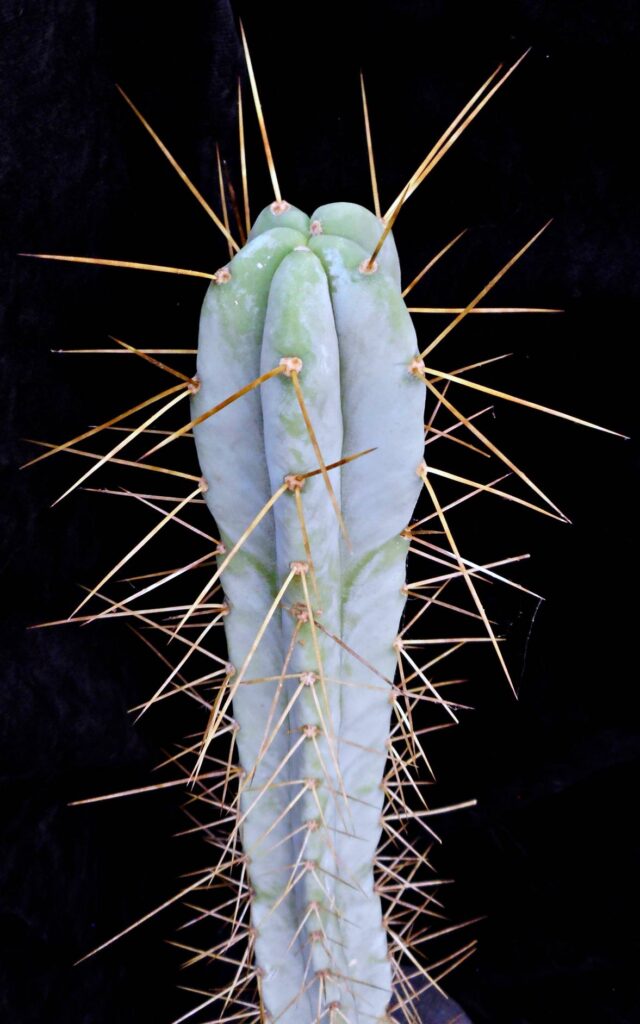 ↑ Auction specimen ↑
↑ Auction specimen ↑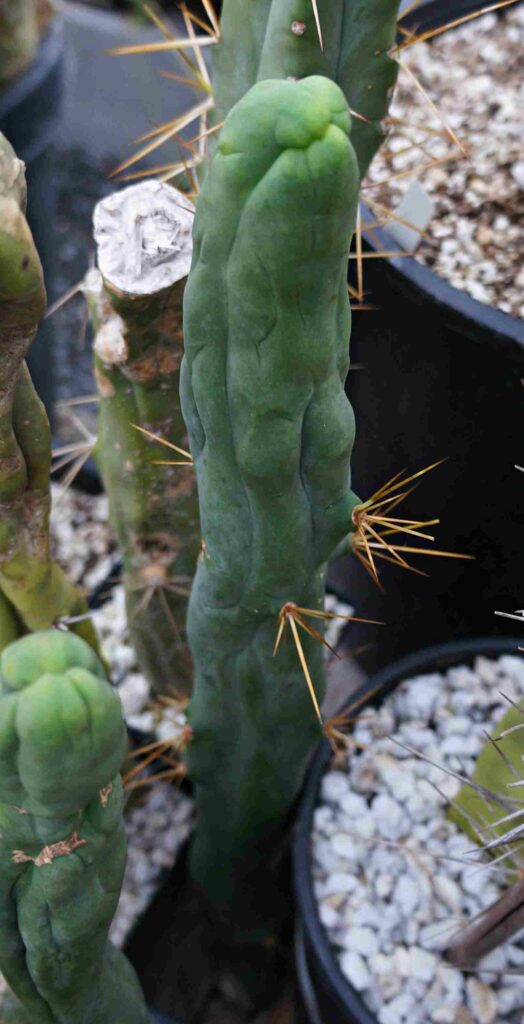 ↑ Mutant form of a ‘typical’ T. bridgesii f. monstrosus cl. A ↑
↑ Mutant form of a ‘typical’ T. bridgesii f. monstrosus cl. A ↑
___
Trichocereus chiloensis X Trichocereus sp. ‘Kimura’s Giant’ – f. variegata
A variegated form of a great hybrid we made some years back of these two robust plants. Fat stems, green to blue/gray-green skin with consistent streaks and marbling of yellow to lime-green variegation. Very attractive spination—white areoles with stout spines 1/4–1″ long. This is only the third time we’ve ever offered a cutting of this singular clone! Z9a
6″ cutting – 14 bids – winning bid $276 Listing closed!
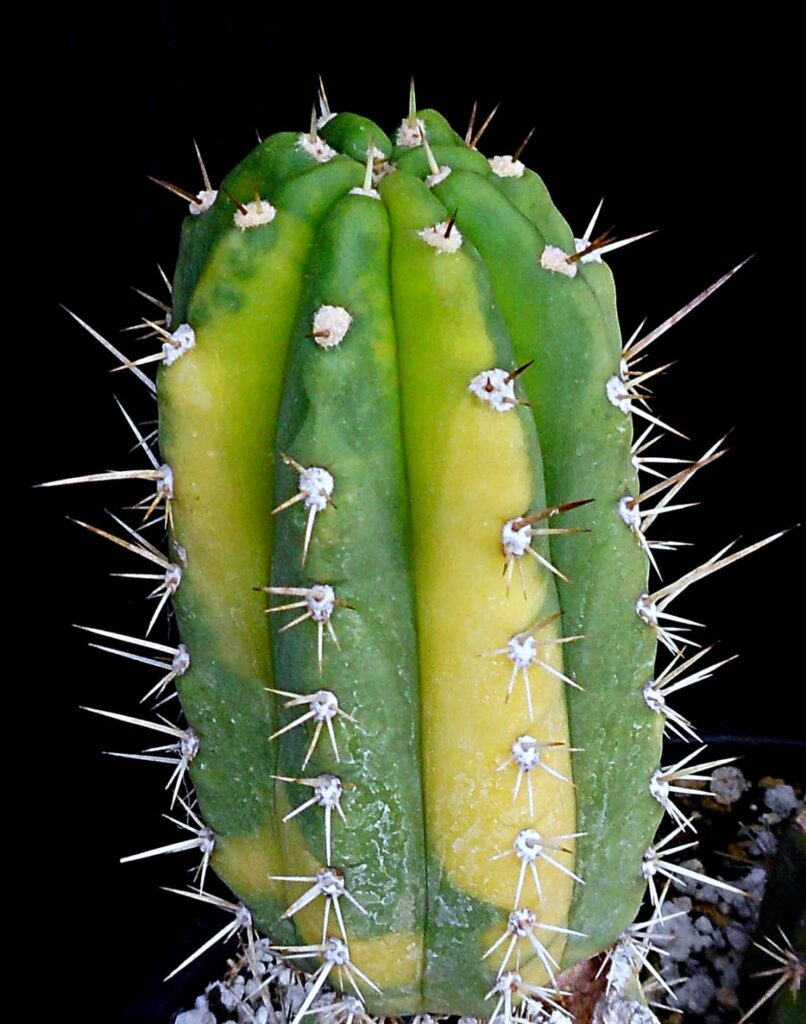
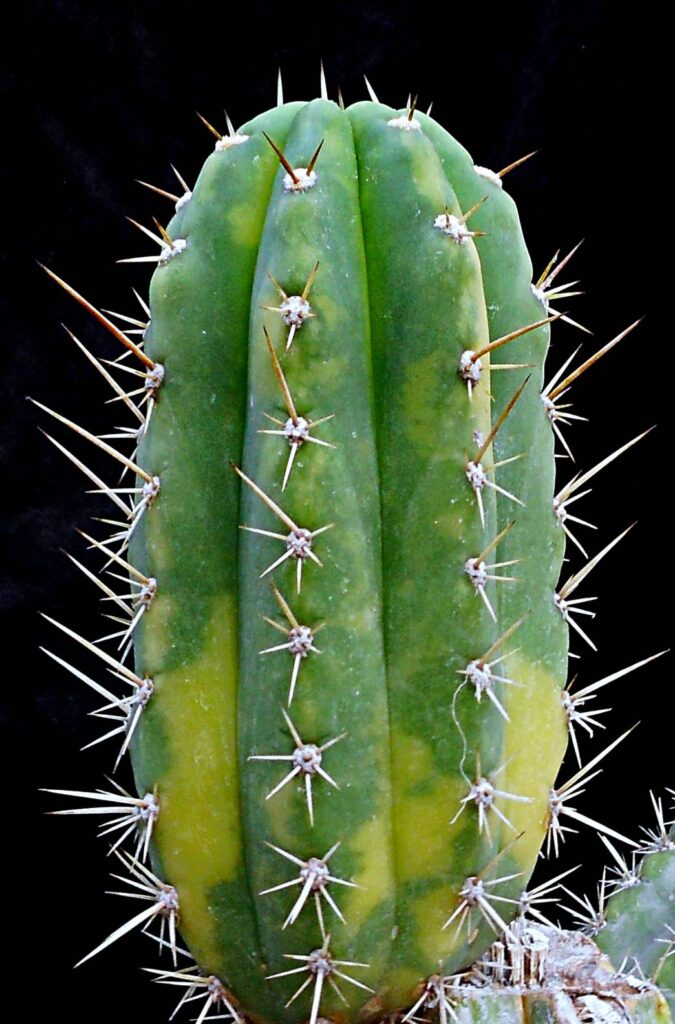
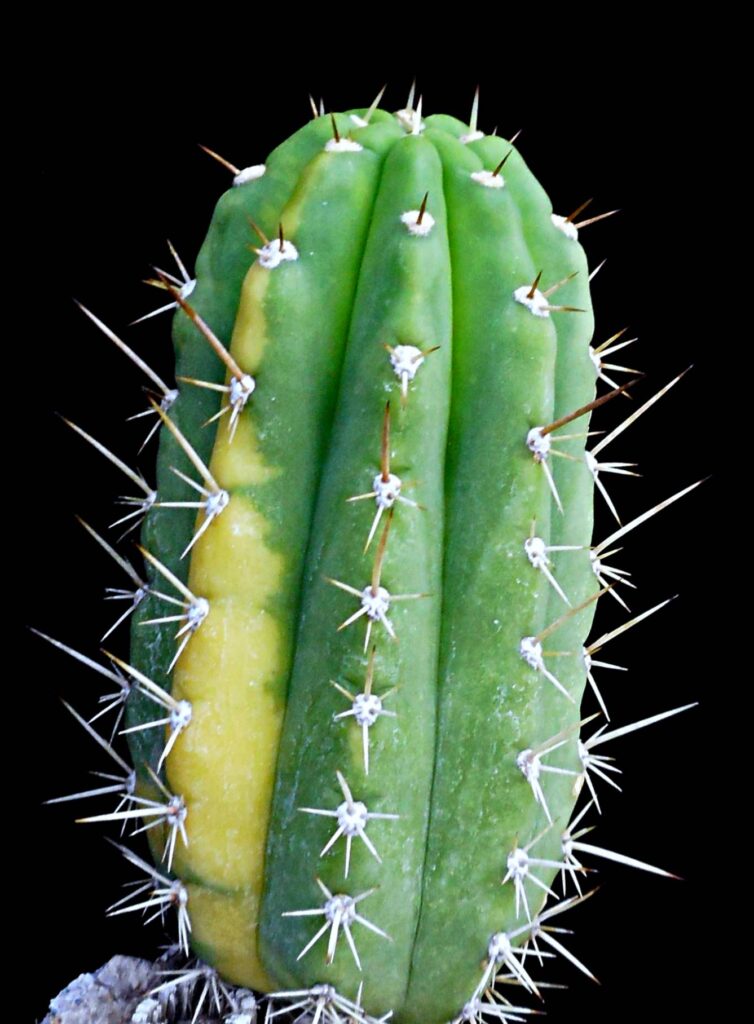
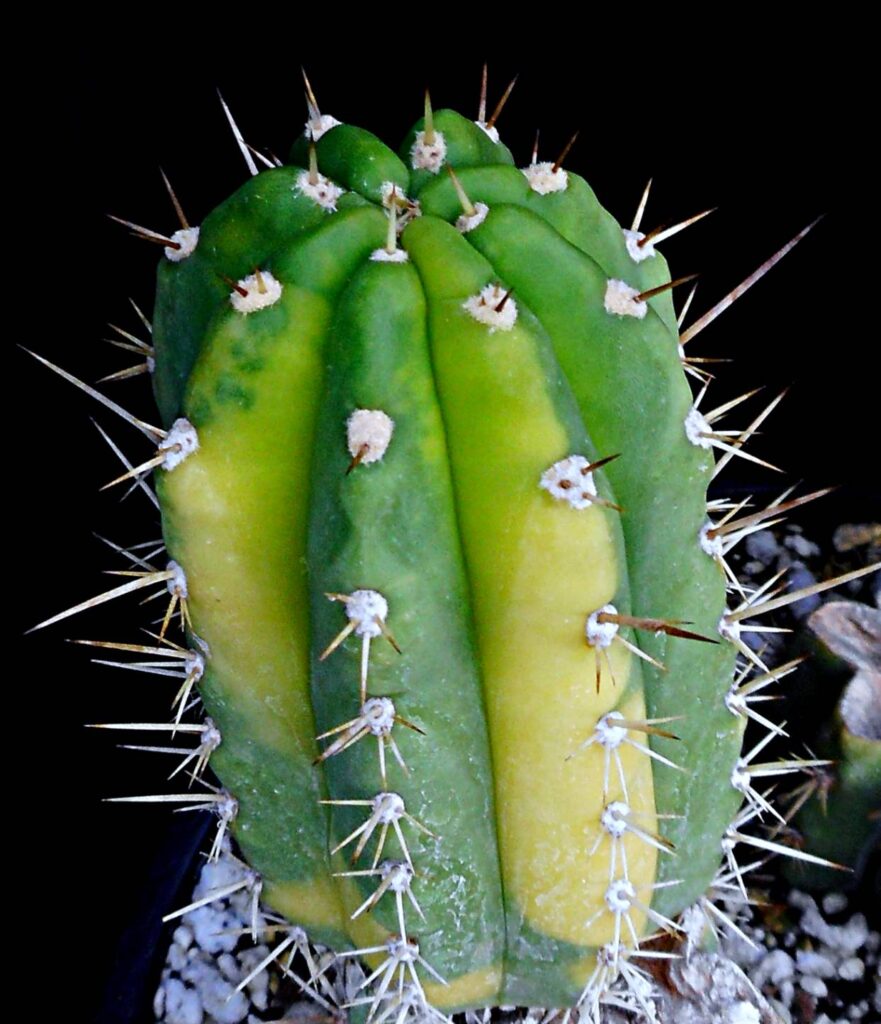 ↑ Auction specimen ↑
↑ Auction specimen ↑ ↑ Our mature plant showing diverse variegation ↑
↑ Our mature plant showing diverse variegation ↑
___
Trichocereus huanucoensis X Trichocereus sp. ‘Juul’s Giant’– f. monstrosus
Our second ever offering of this magnificent and marvelous new mutant! We had long dreamed of hybridizing these 2 rotund ribbed, robust Trichocereus but never anticipated such a delightful mutation to arise from the pairing. The year after we’d first sprouted this promising cross in 2016, we lost nearly 90% of the seedlings to a voracious vole. Among the scant survivors, we noticed that one plant remained rounder and stockier than its brethren. When the stem continued to balloon, rather than grow vertically, and then pupped from the tip, we thought the rodent must have damaged the apical meristem…but the new pup continued to balloon and then many months later 2 pups emerged from its top…and so it has slowly continued ever since! 4–6 rounded, chunky ribs, dark green to bluish-green, with 1/8–1/3″+ spines. Amazingly, the young new stems often resemble Lophophora! The spherical to disc-globoid stems grow for about 0.5–2.5″+, then new stems emerge from the tips and the old stem joints slowly swell, eventually ballooning to 3″+ diameter. Somewhat reminiscent of the stacked ‘egg-like’ growth habit of T. brigesii f. monstrosus clone B or a Tephrocactus ‘soccer-ball stack’. This is a languid and leisurely grower, even with repotting and regular feedings it has only slowly produced no more than a couple new stem joints a year. Can be rooted and grown on its own, or, if impatience is your virtue, grafted to see if the growth rate can be increased. When we first released this wonderful oddity via our auction-fundraiser in December 2023, a 2″ cut went for close to $1000! Z9a
4″ tall by 2.75″ diameter cutting – 15 bids – winning bid $350 Listing closed!
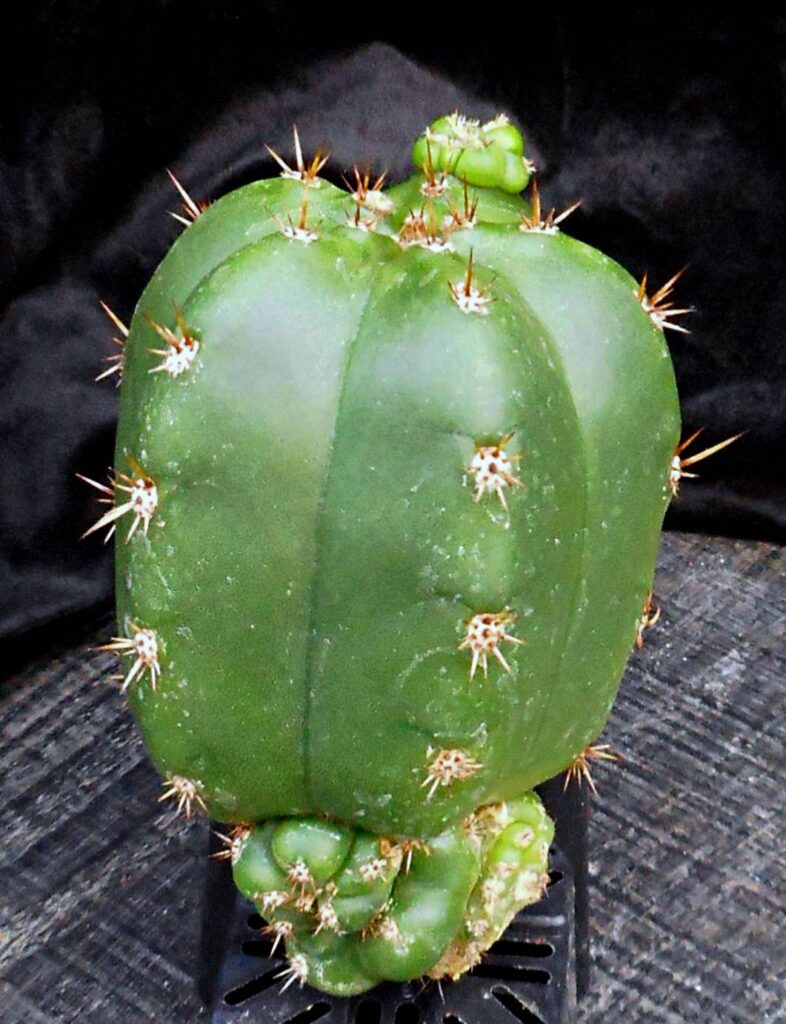
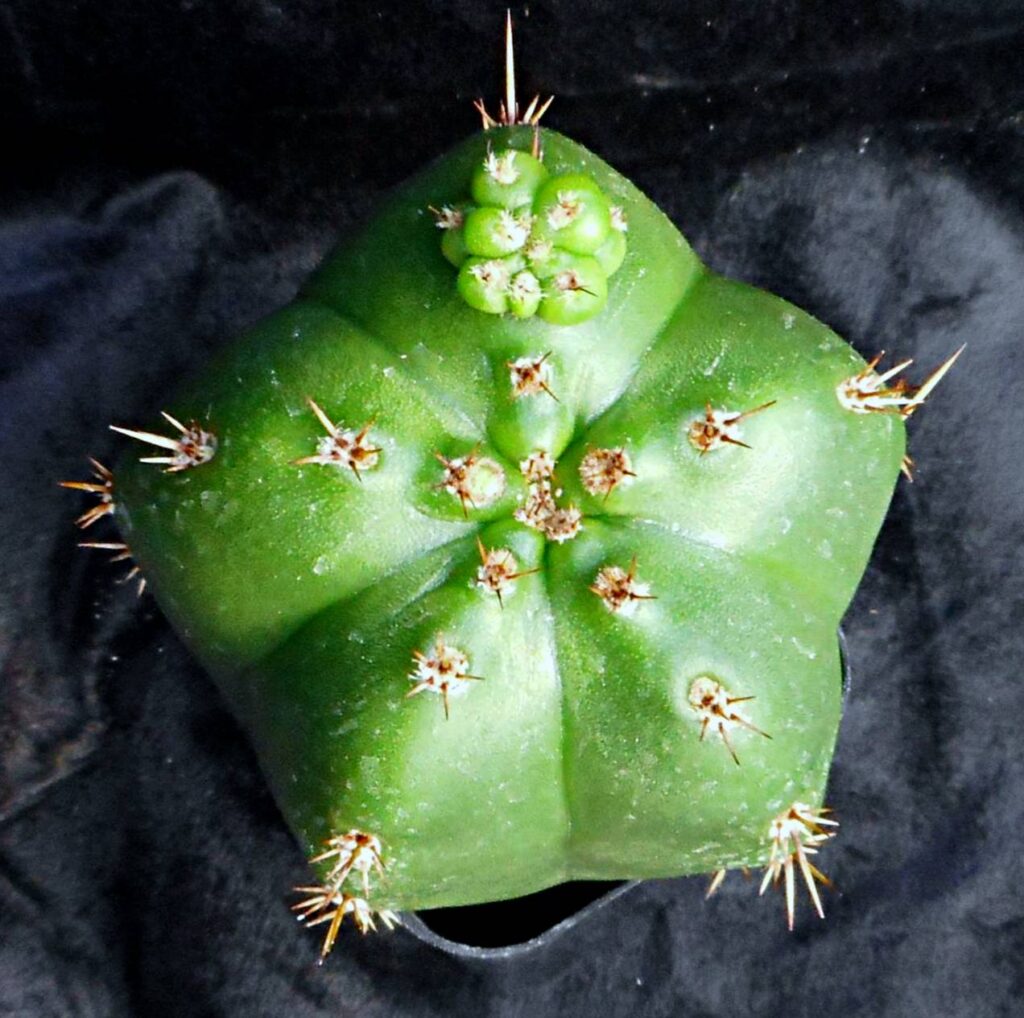
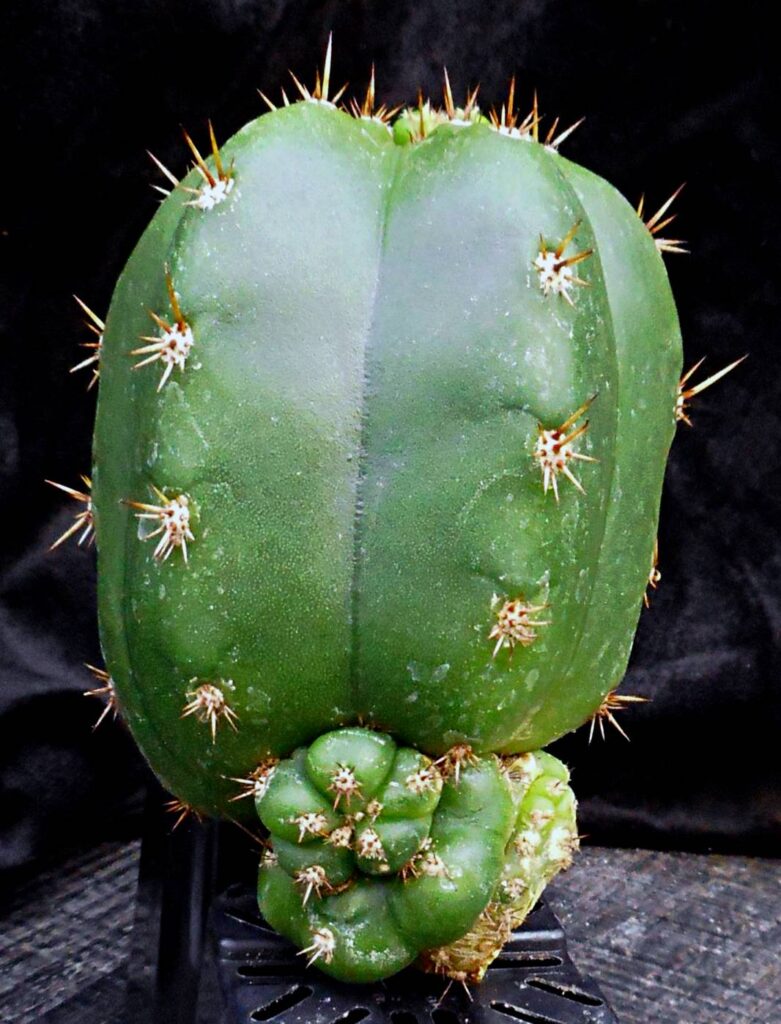 ↑ Auction specimen ↑
↑ Auction specimen ↑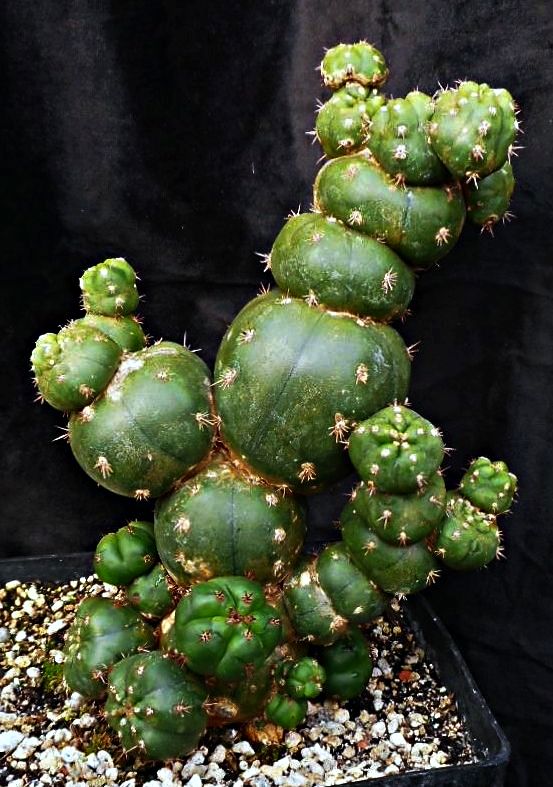
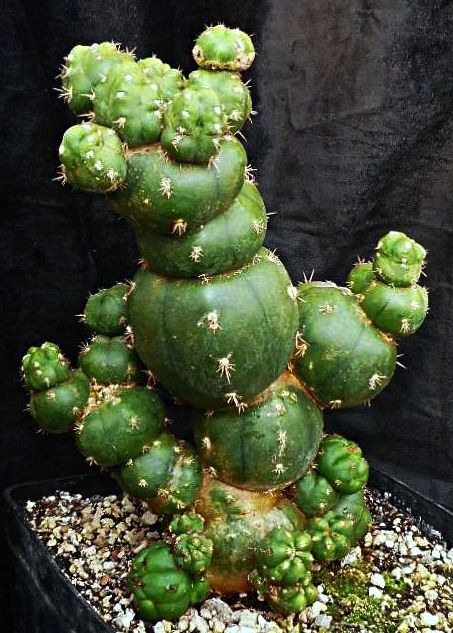
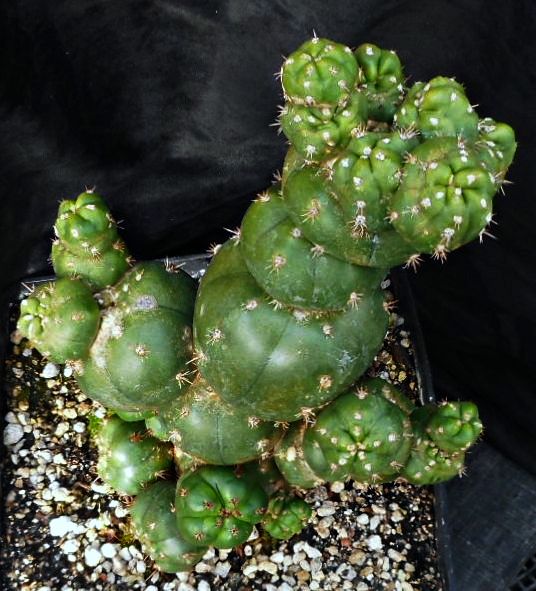
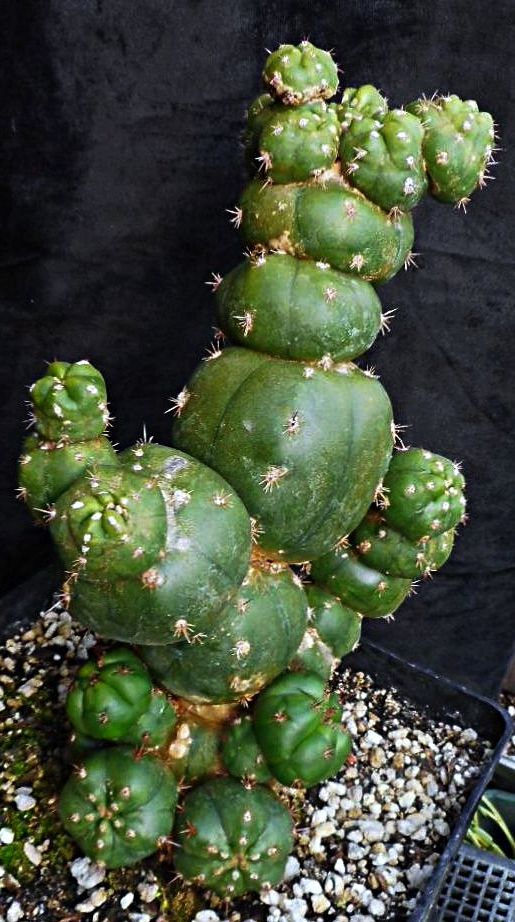 ↑ Mother plant ↑
↑ Mother plant ↑
___
Trichocereus pachanoi Hutchison 6604 “San Pedro” “Huachuma”
An old Paul Hutchison accession from Ecuador that has never been distributed beyond botanical gardens. Upright stems with rounded ribs, green to glaucus-blue skin and short spines. Large white flowers, edible fruit. We only recently began offering (via auction) this very attractive and desirable clone. Z9a
8″ cutting – 12 bids – winning bid $250 Listing closed!
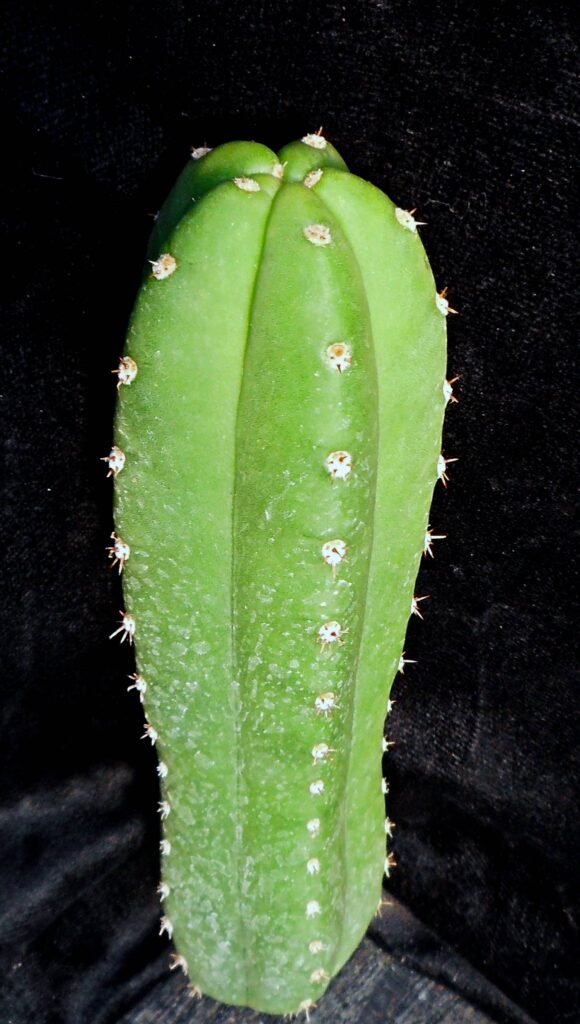 ↑ Auction specimen ↑
↑ Auction specimen ↑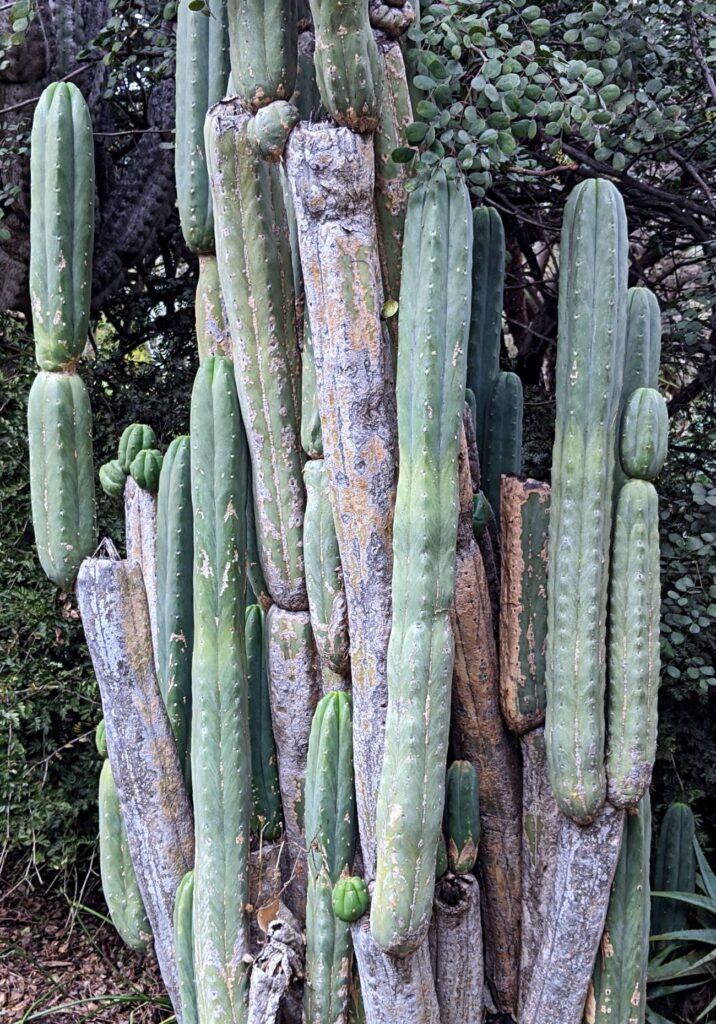

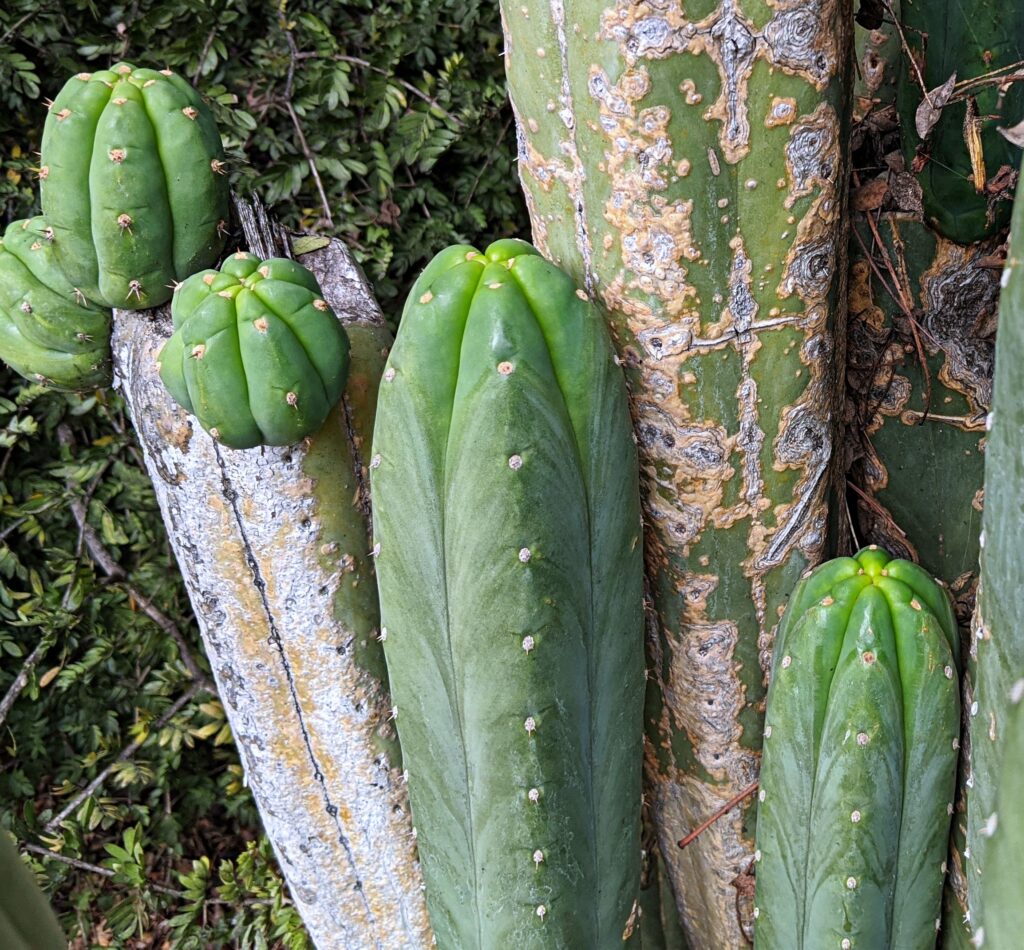 ↑ Mother plant ↑
↑ Mother plant ↑
___
♣
Other Succulents & Xerophytes
__
Boswellia elongata “Frankincense”
Burseraceae. Deciduous pachycaul tree with thick swollen branches and peeling golden bark. 8–14″ long slender leaves, simple when young turning pinnate with age, dark green to purple-gray with pale undersides. New growth on mature plants has an intricate lacy texture like a spiderweb. White flowers. An endangered endemic of the arid northern Socotra forests. Aromatic sap often forms beads along the trunk making for easy harvest. This gorgeous species is a favorite of the rare Frankincense. Grow like other Boswellia—soil with 50–75% pumice/perlite, bright light, heat and a winter rest are needed to keep this plant thriving. Great for bonsai. Seldom available and highly valued, this is our only offering of this awesome tree for some time. Z10b
22″ treelet with 3/4″+ thick trunk – 5 bids – winning bid $161** Listing closed!
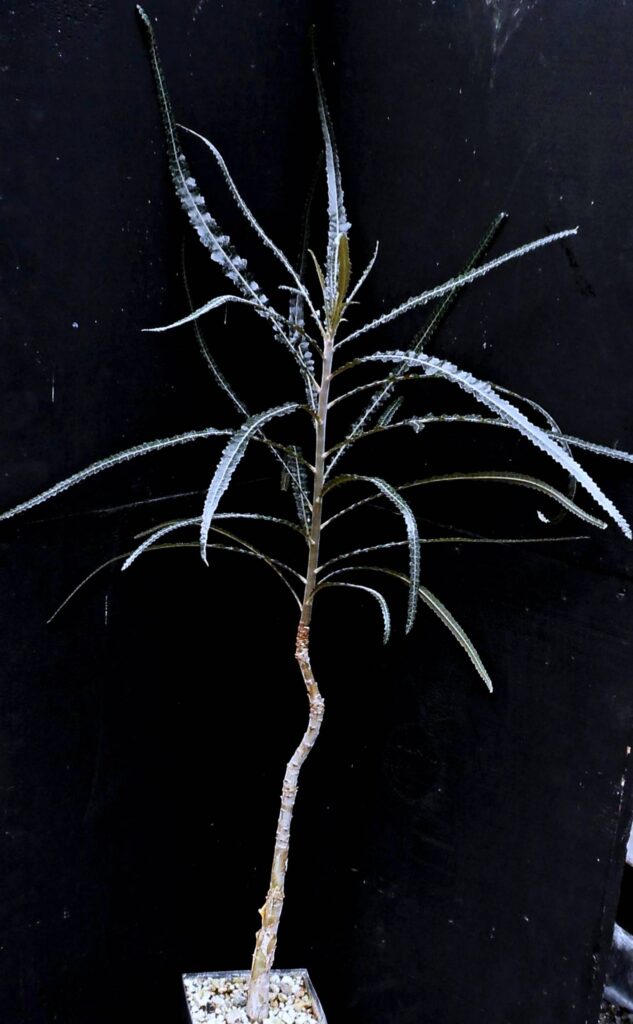
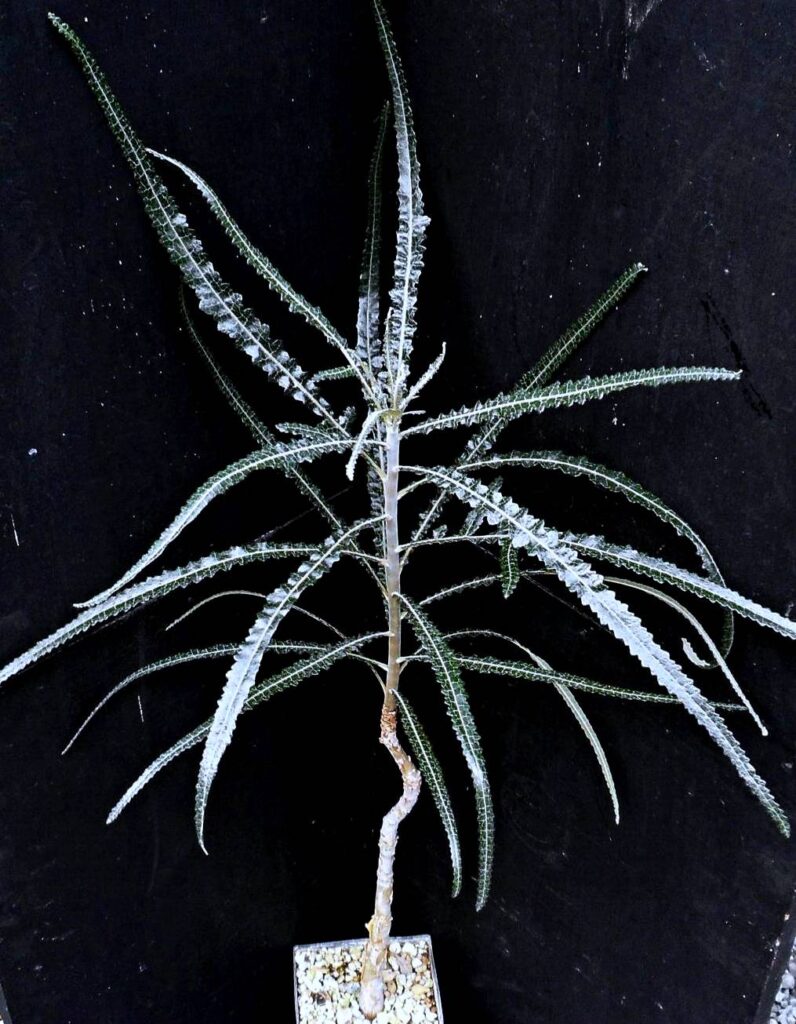 ↑ Auction specimen ↑
↑ Auction specimen ↑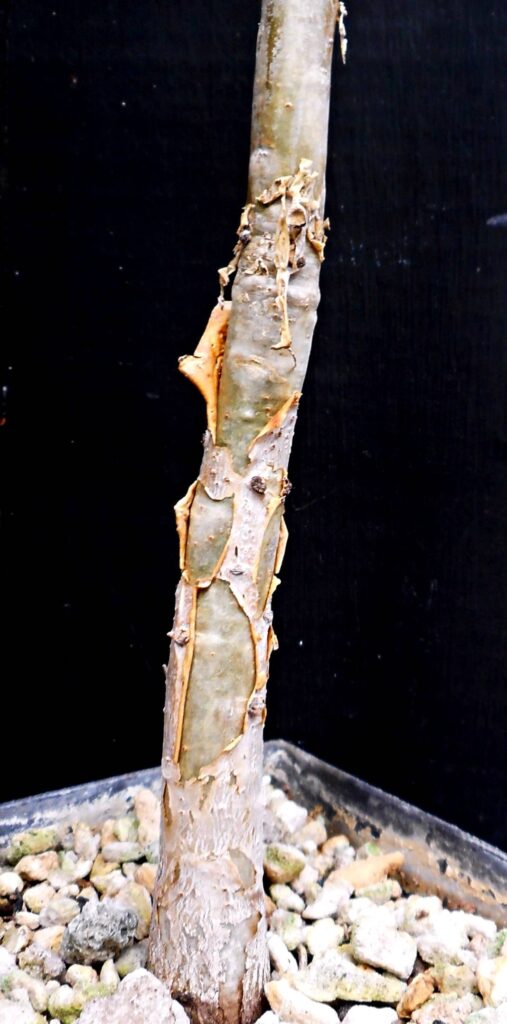 ↑ Trunk of auction specimen ↑
↑ Trunk of auction specimen ↑
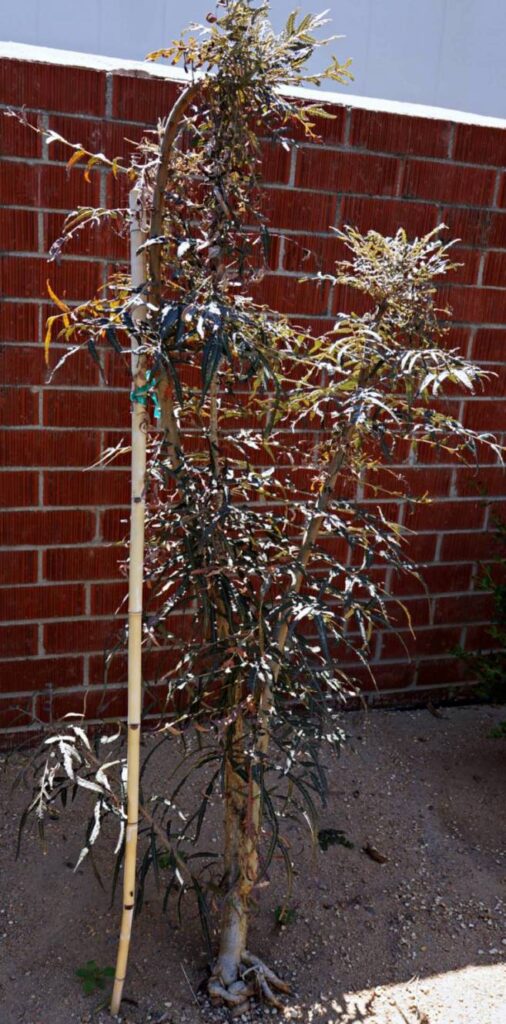 ↑ Mature plants, southern CA ↑
↑ Mature plants, southern CA ↑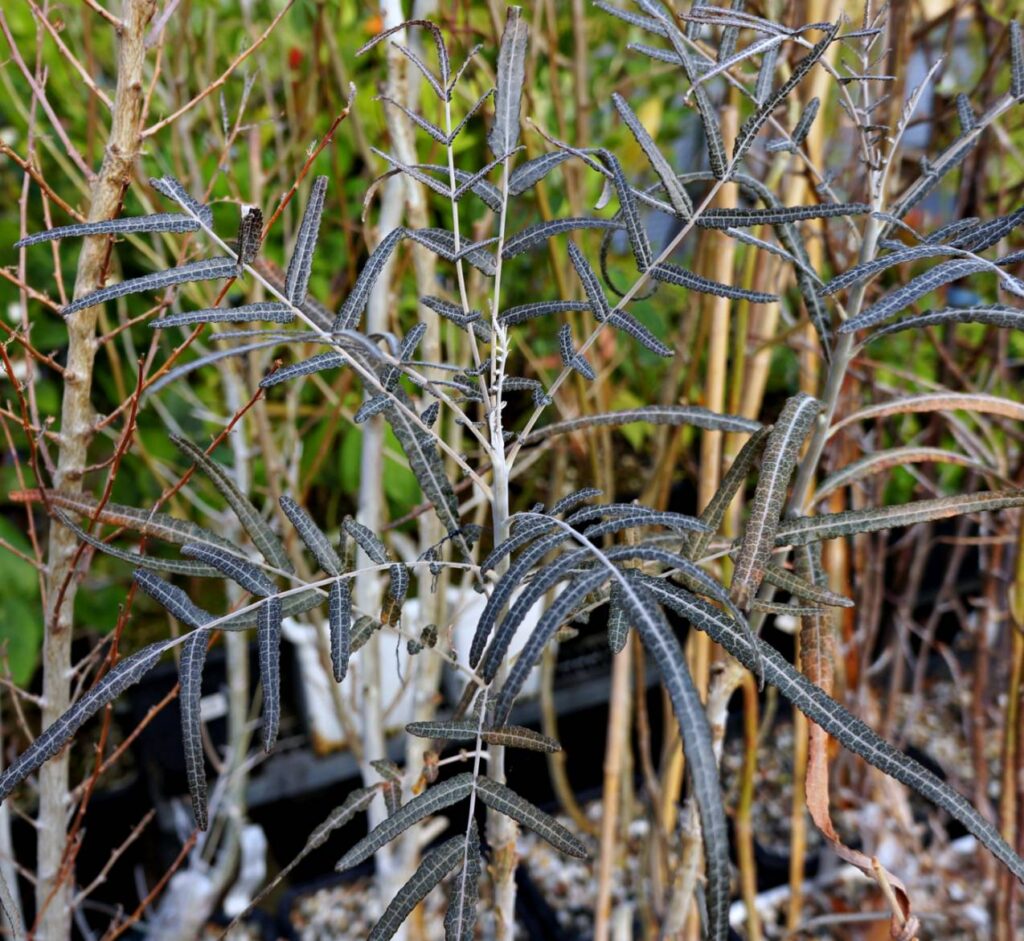 ↑ New foliage of mature plant ↑
↑ New foliage of mature plant ↑
___
Ephedra sinica “Ma Huang” “Zhegergen”
Ephedraceae. Small, leafless shrub to 18″ tall. Red fleshy edible fruit. This primitive gymnosperm is native to dry, rocky mountain slopes of China and Mongolia, up to 5,000′. The fruits are an important food in Mongolia, being super rich in protein, fatty acids, vitamins and minerals. Also known as “Cao Ma Huang”, the herb has been widely used in Chinese medicine for 5,000 years to treat fever, nasal congestion, and asthma. Contains significant amounts of ephedrine alkaloids, powerful antihistamines and psychoactive CNS stimulants.. Because of misuse of purified ephedrine in diet and stimulant/aphrodisiac products, the FDA has severely restricted products containing ephedrine. This has unfortunately lead to scarcity of the whole herb, which, unlike using isolated ephedrine, rarely gives rise to side-effects. Fortunately it is still acceptable to grow the plant and benefit from its medicinal properties from the safety of your garden. A rare offering of a larger, mature plant; long underpotted and ready for a 5–10 gallon pot or to go in the ground. Easy to grow, sun, cold, and drought tolerant. Z5b
20″+ diameter by 14″+ tall plant 7+ years old – 13 bids – winning bid $142* Listing closed!
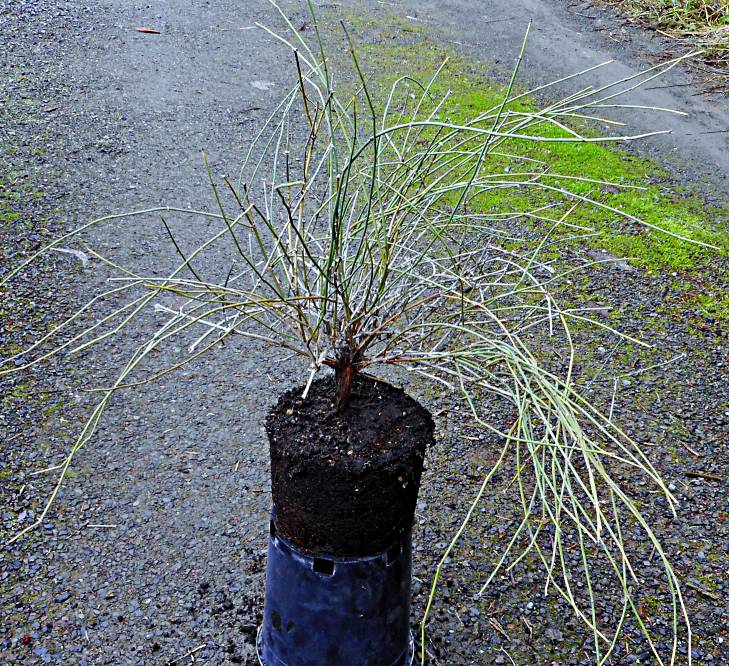 ↑ Auction specimen ↑
↑ Auction specimen ↑
___
♣
Andean Ethnobotanicals
__
Saracha aff. punctata BK08524.5
Solanaceae. A staggeringly gorgeous plant and one of our most appealing seed accessions from our 2008 Andean expedition. Shrub to tree 10–40’+ tall. Oval leaves and festooned in hundreds of 1″ bell flowers, pale lavender to dark purple with cream colored veination. 1/2″ round black fruit. Looks strangely like an arborescent belladonna! Planted at rural homesteads in the village of Huacahuasi, 12,500′, Cusco Dept., Peru, where it is grown as an ornamental. Since our initial collection we have also seen it planted above 13,000′ at Patacancha village and observed a few wild specimens growing in remnant cloud forest along the Rio Trapiche above Lares. We are delighted to have introduced this plant into US cultivation so it could take a place in the garden next to its other exotic arborescent solanaceous kin such as Brugmansia, Iochroma, Cestrum, etc. While our mother plants in the ground seem unfazed, the climate extremes of recent years damaged our nursery stock and it’s been awhile now since we last offered this beauty. The specimen on offer was much taller, but flash heat burned the top off this summer; it is now regrowing with numerous bushy shoots. Quite easy to grow, though slow for us, after 14 years in the ground our tallest plant is just about 9′. Young plants only tolerate mild frost, regrowing from the base, larger specimens are hardy below Z8b.
16”+ multi-stemmed plant — 3 bids – winning bid $90* Listing closed!
 ↑ Auction specimen ↑
↑ Auction specimen ↑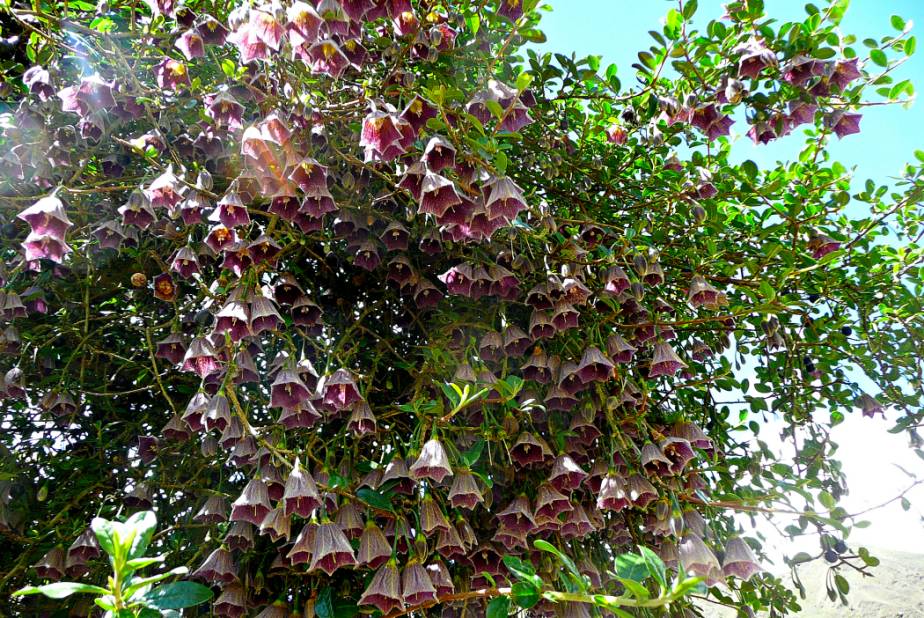
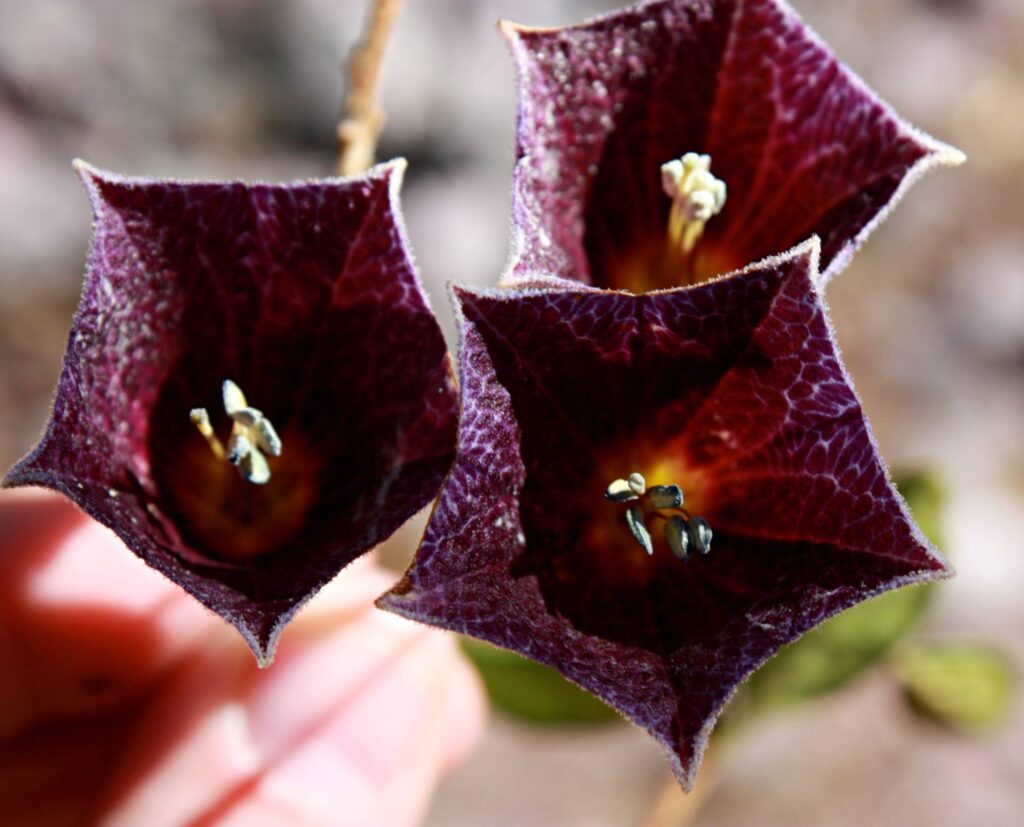
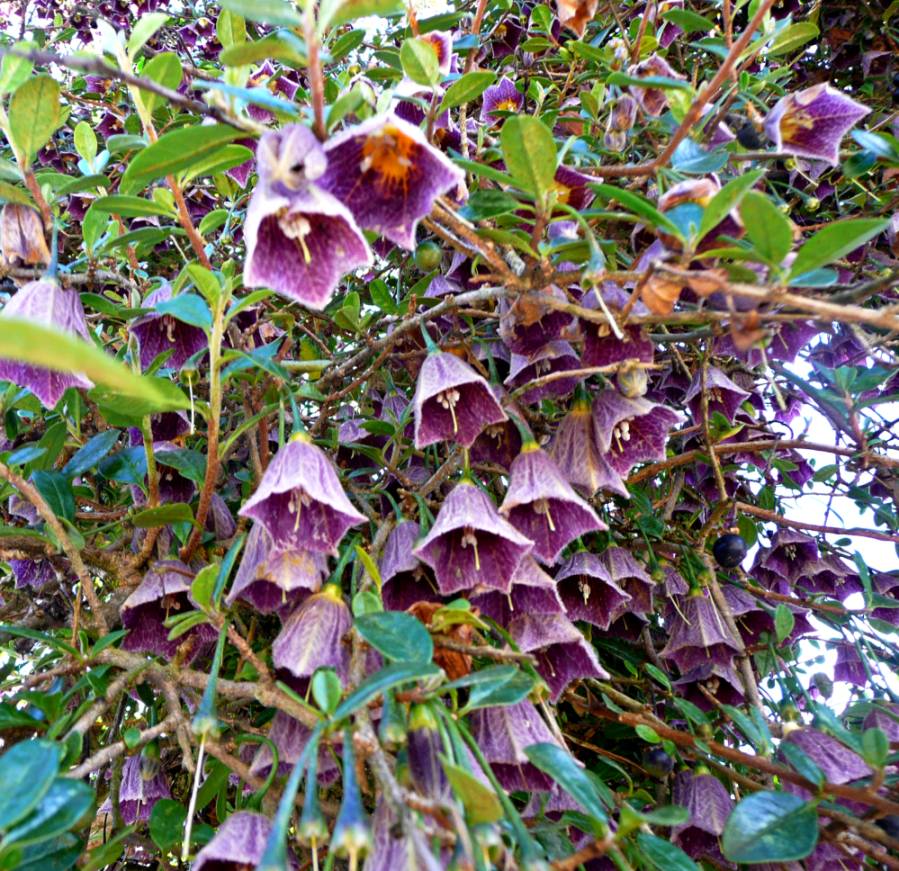
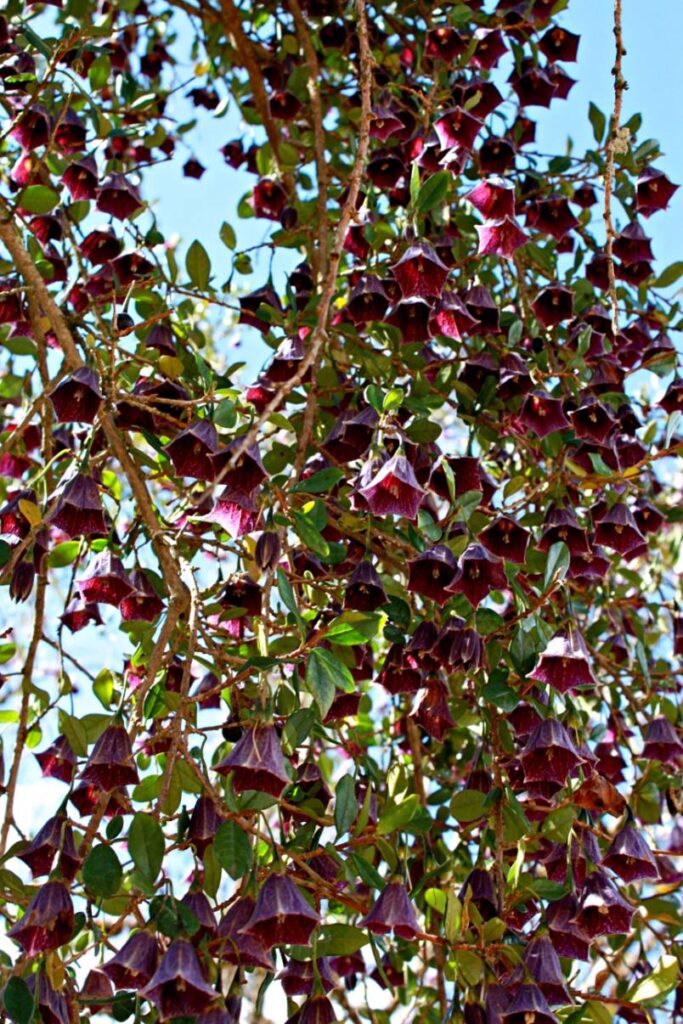
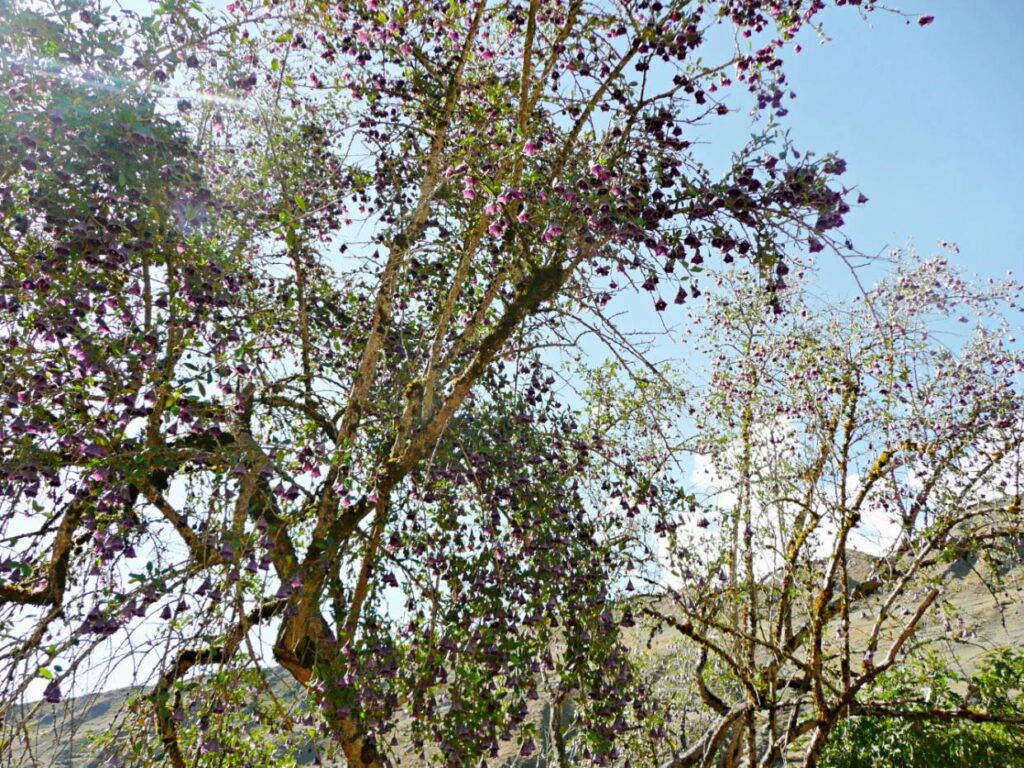
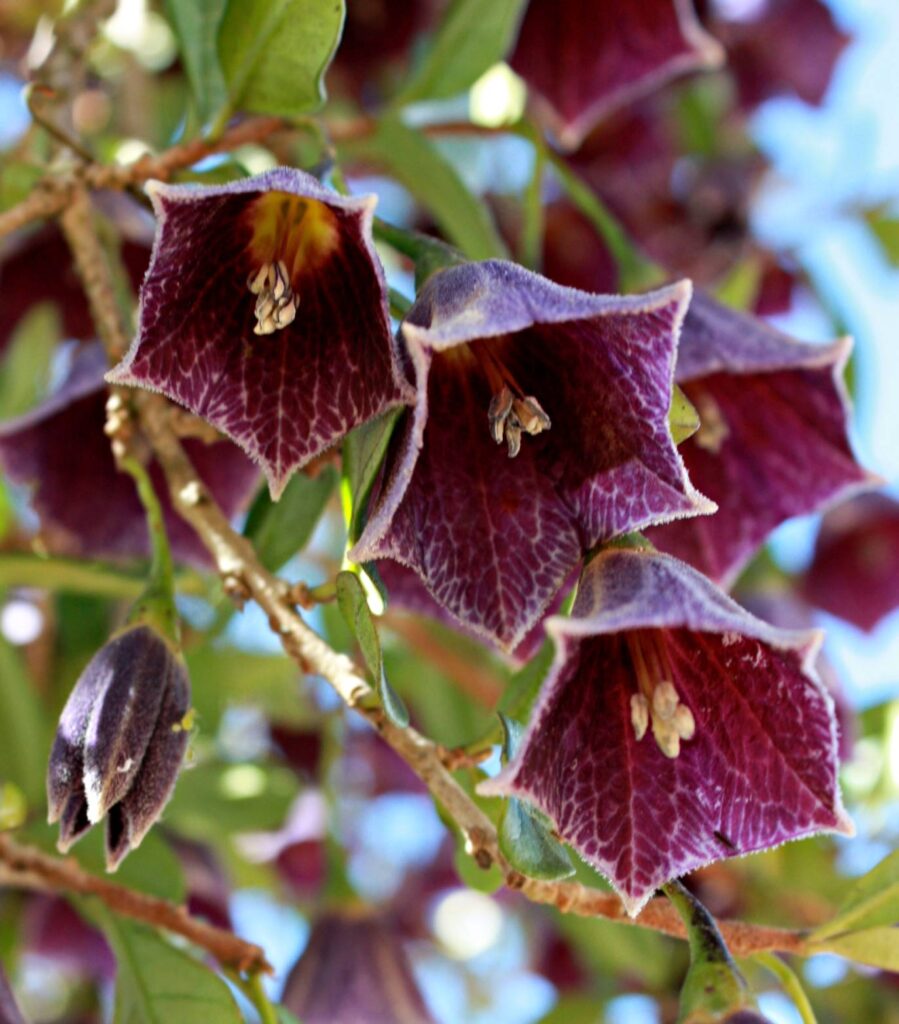 ↑ Saracha in full, glorious bloom, Huacahuasi, Cusco Dept., Peru ↑
↑ Saracha in full, glorious bloom, Huacahuasi, Cusco Dept., Peru ↑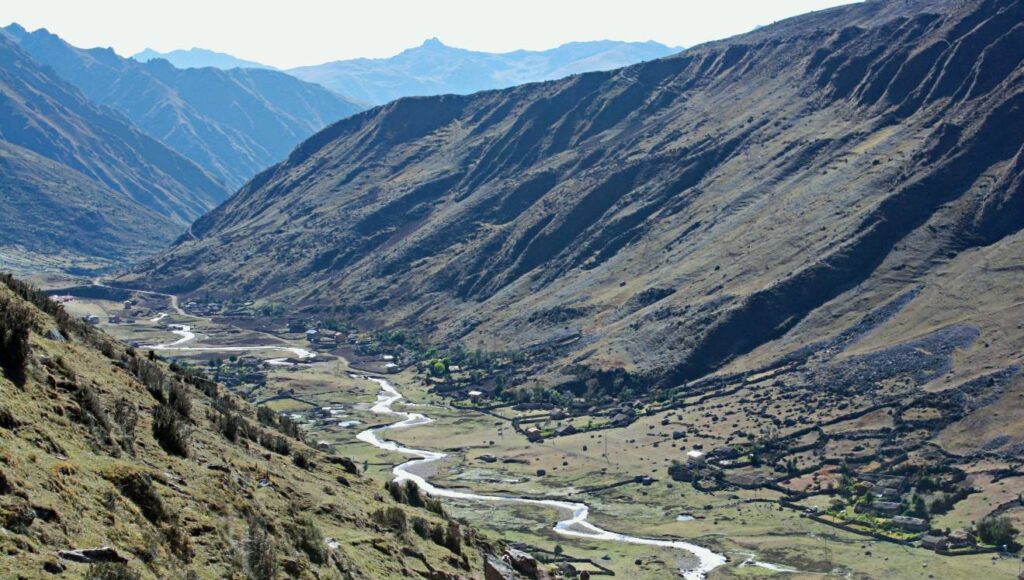 ↑ Huacahuasi Valley, Cusco Dept., Peru ↑
↑ Huacahuasi Valley, Cusco Dept., Peru ↑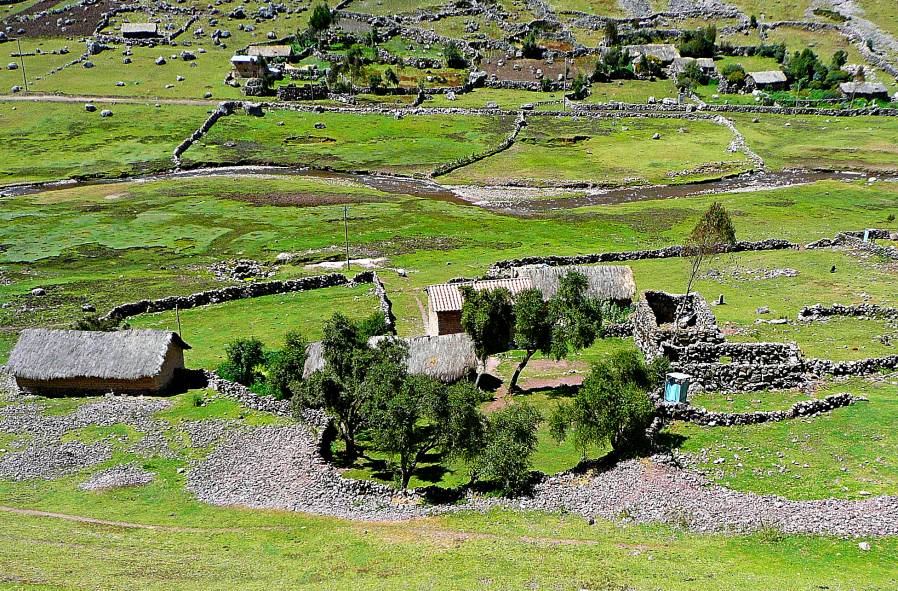 ↑ Saracha trees planted around homes, Huacahuasi, Cusco Dept., Peru, 12,500′ ↑
↑ Saracha trees planted around homes, Huacahuasi, Cusco Dept., Peru, 12,500′ ↑
___
♣
Other Beneficial Plants
__
Agapetes sp. SEH 25095 “Himalayan Huckleberry”
Ericaceae. Highly showy caudiciform blueberry relative with a a lobed, swollen lignotuber/caudex to 18″+ and arching branches to 2–4’+. Small, ovate leaves with pointed tips, densely arranged on the stems; new growth is an enticing red to rose-purple. Rather flamboyant, pendent clusters of 4–12+ tubular flowers, light to dark pink with rose to red banding and tips of yellow and green. We’ve yet to observe the berries, though they should be juicy sweet as other Himalayan huckleberries, yet with the benefit of being borne in clusters. A recent introduction from the Eastern Himalayan temperate rainforests. Easy to grow, well draining acidic soil, part sun to shade. Perfect for a hanging basket. Our first offering of this splendiferous huckleberry. This is one of our favorite’s in this wonderful, diverse genus! See the Edible, Medicinals, etc. section towards the end of our Specimen Plant List for other Agapetes species. Z8b?
15″ plant – 5 bids – winning bid $65* Listing closed!
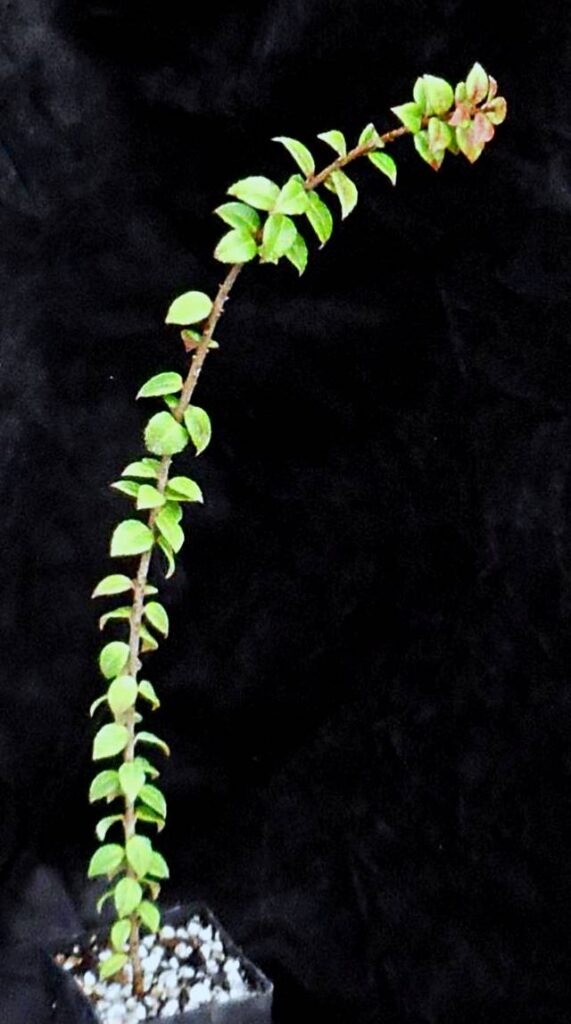 ↑ Auction specimen ↑
↑ Auction specimen ↑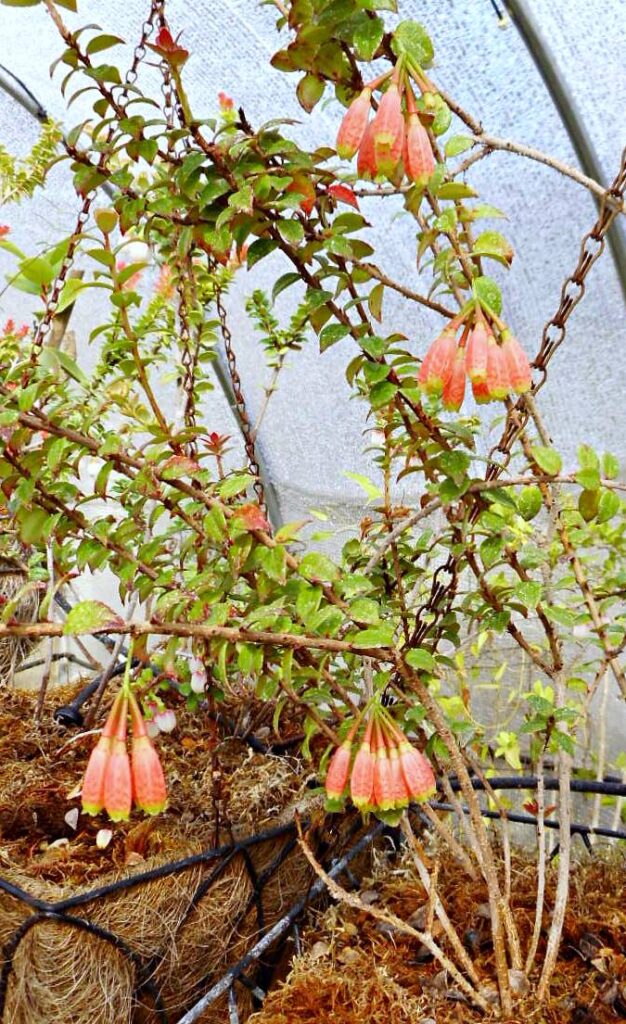
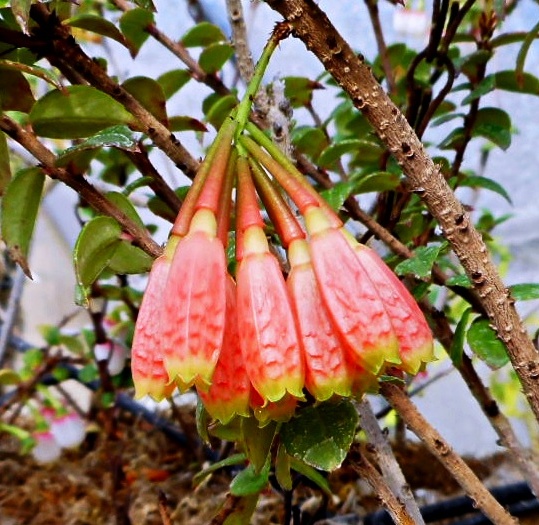
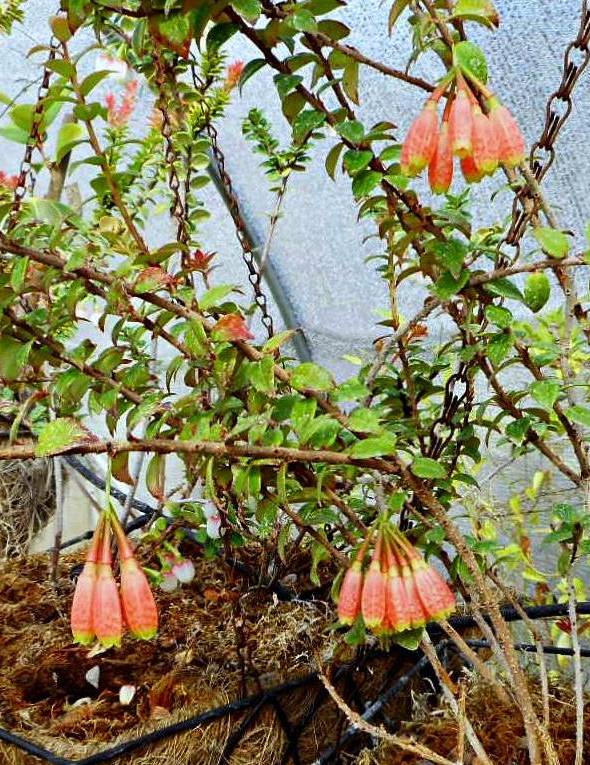
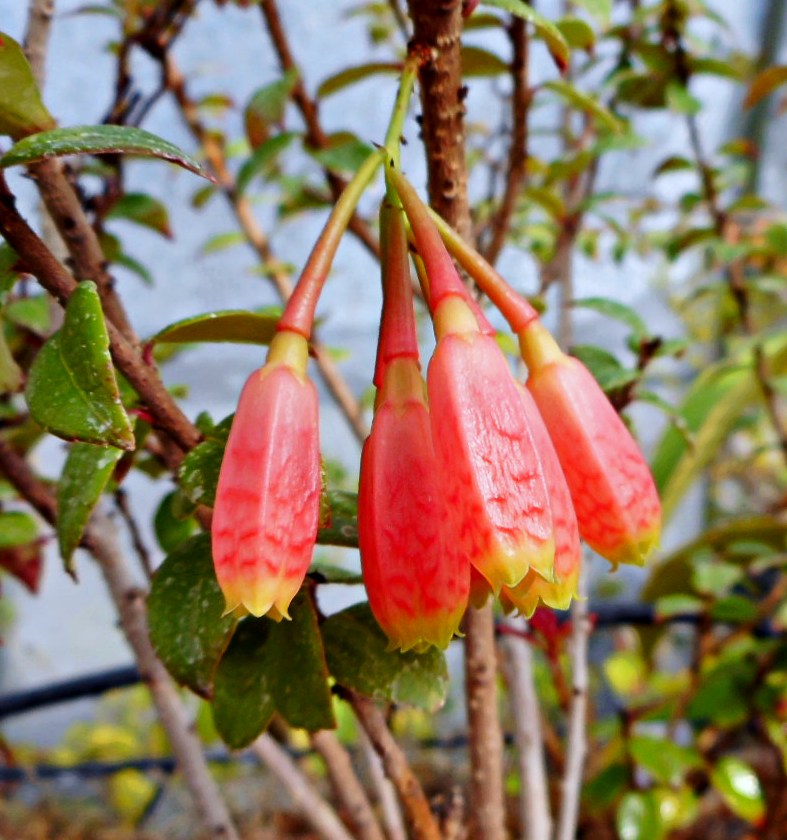 ↑ Mother plant in bloom ↑
↑ Mother plant in bloom ↑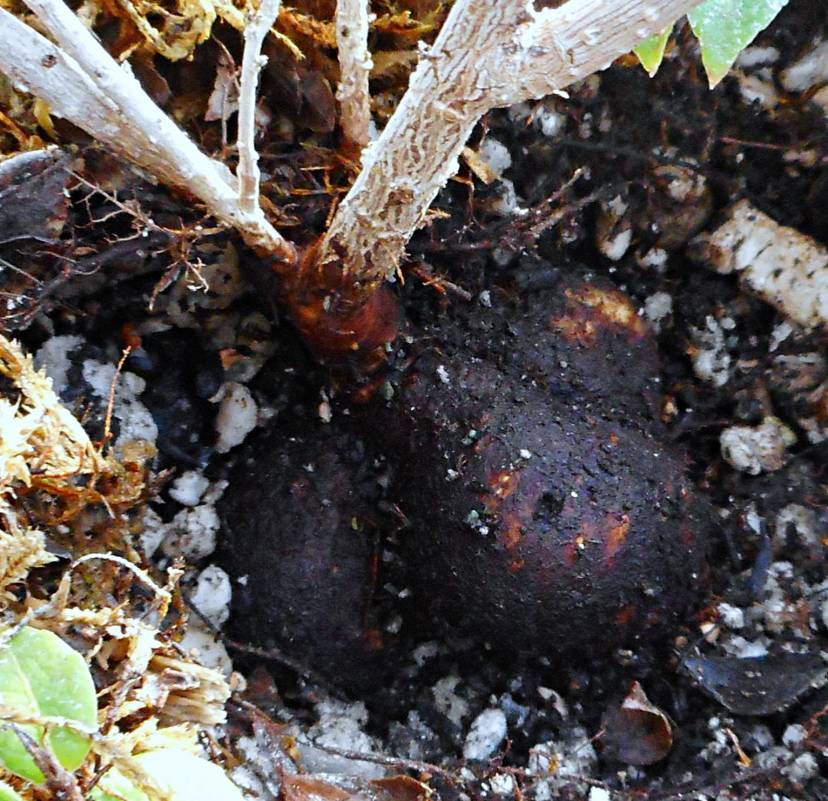 ↑ Young caudex of Agapetes sp. SEH25095 ↑
↑ Young caudex of Agapetes sp. SEH25095 ↑
___
♣
BOOKS
[The book part of the auction is open to both US and international bidders!]
__
__
For additional books, see our Rare & Used Editions and New Books
__
♥
~ end of auction list ~
♥
This auction CLOSED at 6:00pm PST, Wednesday, December 18
◊
Order Form
Sacred Succulents, P.O. Box 781, Sebastopol, CA 95473 USA
♥
_____
 ↑ Trichocereus terscheckii in south Salta, Argentina ↑
↑ Trichocereus terscheckii in south Salta, Argentina ↑
______________
Second Chance:
Make up Autumnal Plant Auction-Fundraiser
– Is now Closed! –
__
The make up auction closed at 6:00pm PST, October 30
Winning bids are posted
♣
Auction last updated at 6:15 pm 10/30/24
◊
After it ended on 10/20, we heard from a number of long term supporters that they never received the emails announcing the start & close of the Autumn fundraiser. We are still looking into why and a remedy. We had 1/8th the usual participants, the lowest number ever — many plants were bid on by only 2 people back & forth. Some of these individuals generously suggested a second fundraiser round on these plants — a make up auction for those who missed out. We have decided to give this a go and list the relevant plants below, each starting with the final high bid of the prior auction. We’ve also posted a few alternate plants similar to those that went in the initial round.
While we don’t know if we’ll have our email list fixed by the close of this 2nd chance fundraiser,
we hope this gives time for word to reach those who missed out — so tell your friends.
Everyone is welcome to take part in the make up auction!
◊
After the damage we’ve sustained the last 2 winters, and extreme heat spikes in summer taking a toll, these auctions are a big help in raising the support the nursery so vitally needs to continue — know that your auction purchases directly fund these much needed nursery repairs, essential renovations, ongoing irrigation installation [after 20 years of hand-watering, we can no longer keep up — we’ve lost over 25% of our rare & endangered plant collection in the last 5 years due to the climatic shift towards hotter & drier], equipment repair & replacement [for instance, the refrigerator we use exclusively for our seed bank died during the worst summer heat], as well as our continual research & conservation work.
We are deeply grateful for your love of plants and support of our work!
___
♣
Make Up Auction Plants
The make up auction closed at 6:00pm PST, October 30
Winning bids are posted
Cactaceae
↔
Echinopsis eyreisii X Trichocereus terscheckii
This awe-inspiring hybrid has been one of the most asked after plants in our collection for years. A matching of opposites—the dwarf, clumping Echinopsis eyreisii fertilized by the gargantuan Trichocereus terscheckii. The progeny look like a robust T. terscheckii with a few extra ribs on massively thick stems to 12″+, closely spaced, large furry areoles, short, stout spines, and white/pink funnel flowers with very furry tubes. In fact, the plant looks similar to the the nearly spineless new growth we’ve seen on large T. terscheckii in habitat once they grow beyond the reach of possible herbivores. One of our early hybrids, germinated back in 1998. Only 3 seedlings of this cross survived (and 2 of the opposite). The plants have been very slow growing for us, after 26 years they are only 4′ tall. We had expected this hybrid to pup readily like its mother, but after 2 decades we became impatient and cut the top from one [clone A]. This has forced pupping and we offer a fat cutting here for only the fourth time ever. Become one of the lucky few to grow this awesome botanical wonder; impress your friends & neighbors… make covetous collectors drool! Z8a/b
6″+ tall, 6.5″+ diameter cutting – 5 bids – auction closed – winning bid $240* Listing closed!
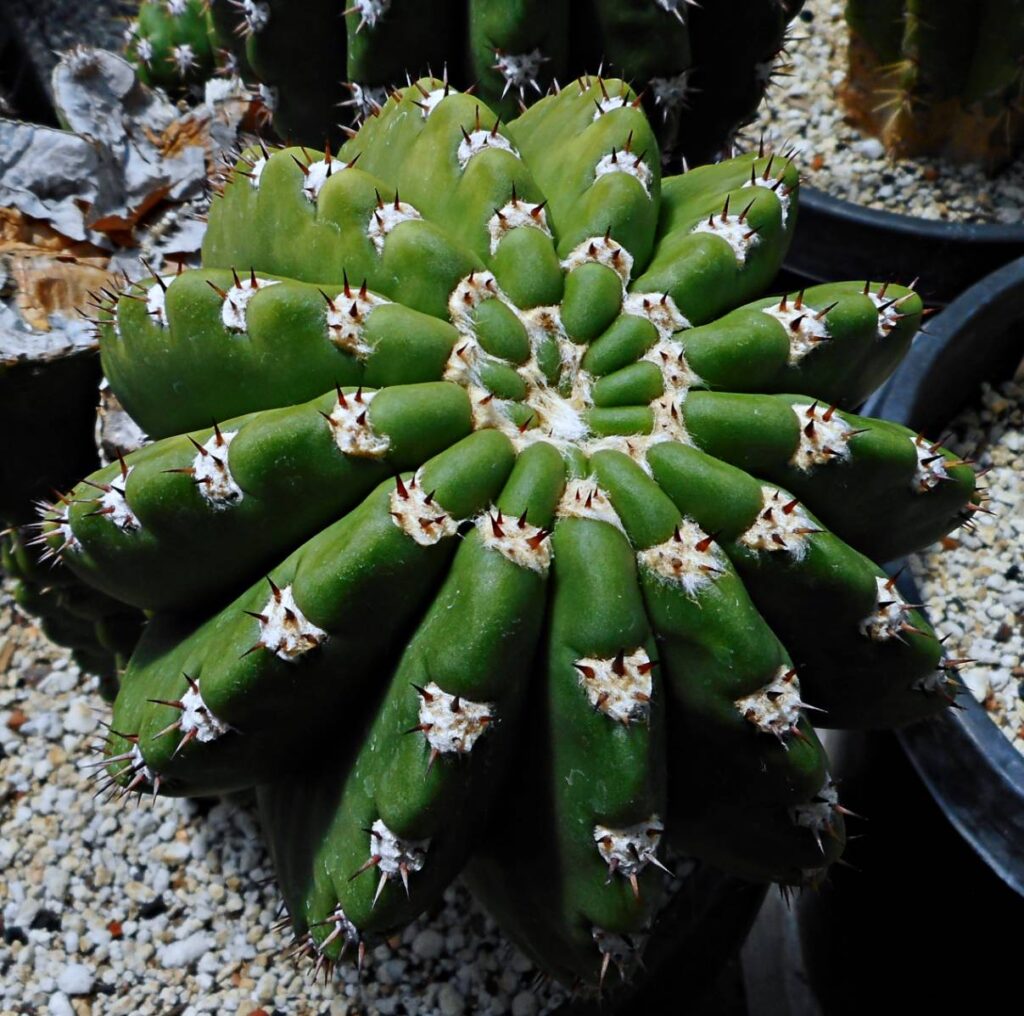 ↑ Auction plant ↑
↑ Auction plant ↑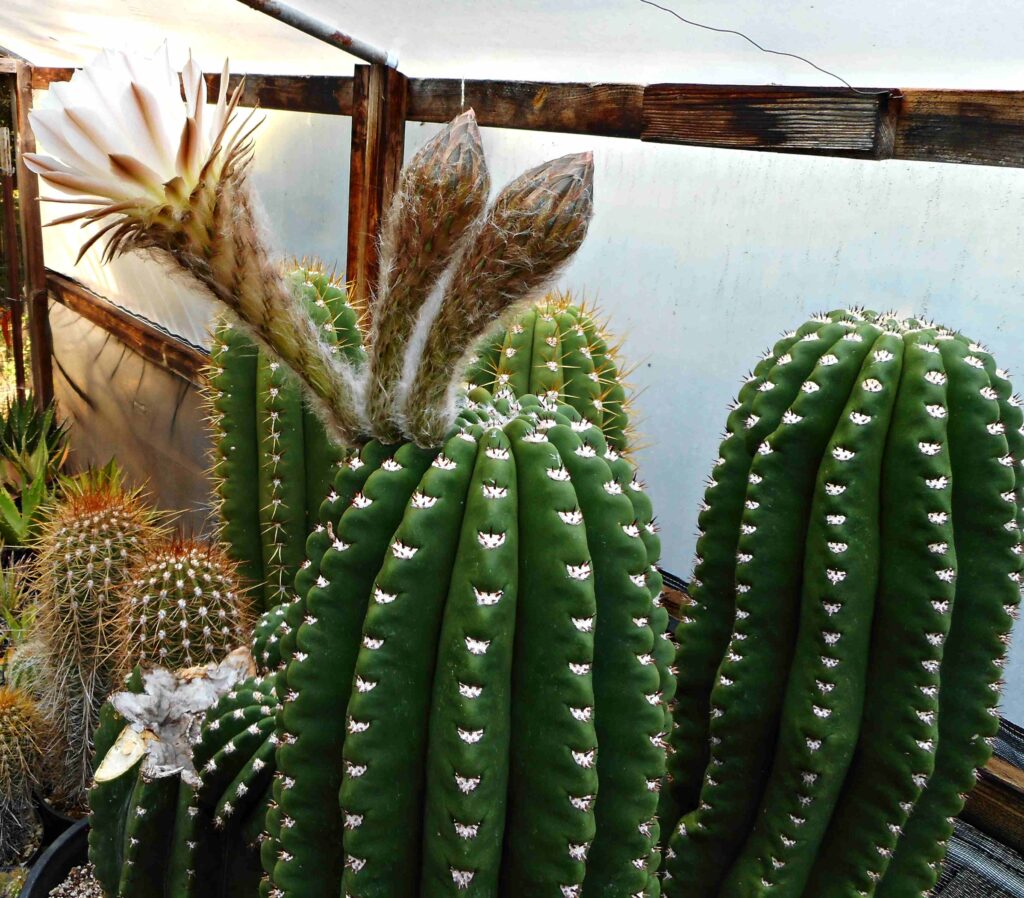 ↑ Echinopsis eyreisii X Trichocereus terscheckii in bloom ↑
↑ Echinopsis eyreisii X Trichocereus terscheckii in bloom ↑
__
Trichocereus tulhuayacensis KK337 X T. peruvianus/‘Juul’s Giant’ hybrid f. monstrosus
Here’s a chance at a choice and singular monstrose seedling of this exciting new hybrid. The spiny magenta flowered tulhuayacensis impregnated by our large blue-green peruvianus/Juul’s mutant that produces huge white flowers with extra petals. The monstrose/cristate genes, colored & mutant flowers, and exceptional spines will combine in unexpected and novel ways—some of the progeny, such as this many ribbed selection, are already showing very unique mutant traits and we can’t wait to see how magnificently they mature! We’re envisioning thick brain-coral growth with stout, red to black spines and unfurling fans of huge purplish blossoms! Whatever maturation brings, this is certain to become a one-of-a-kind living sculpture. A make up auction alternate plant. This seedling stands out from its kin in having the longest spines of any of the mutants so far. Z8b/9a
3″+ tall, 2″+ diameter plant, 3+ years old – 4 bids – auction closed – winning bid $60 Listing closed!
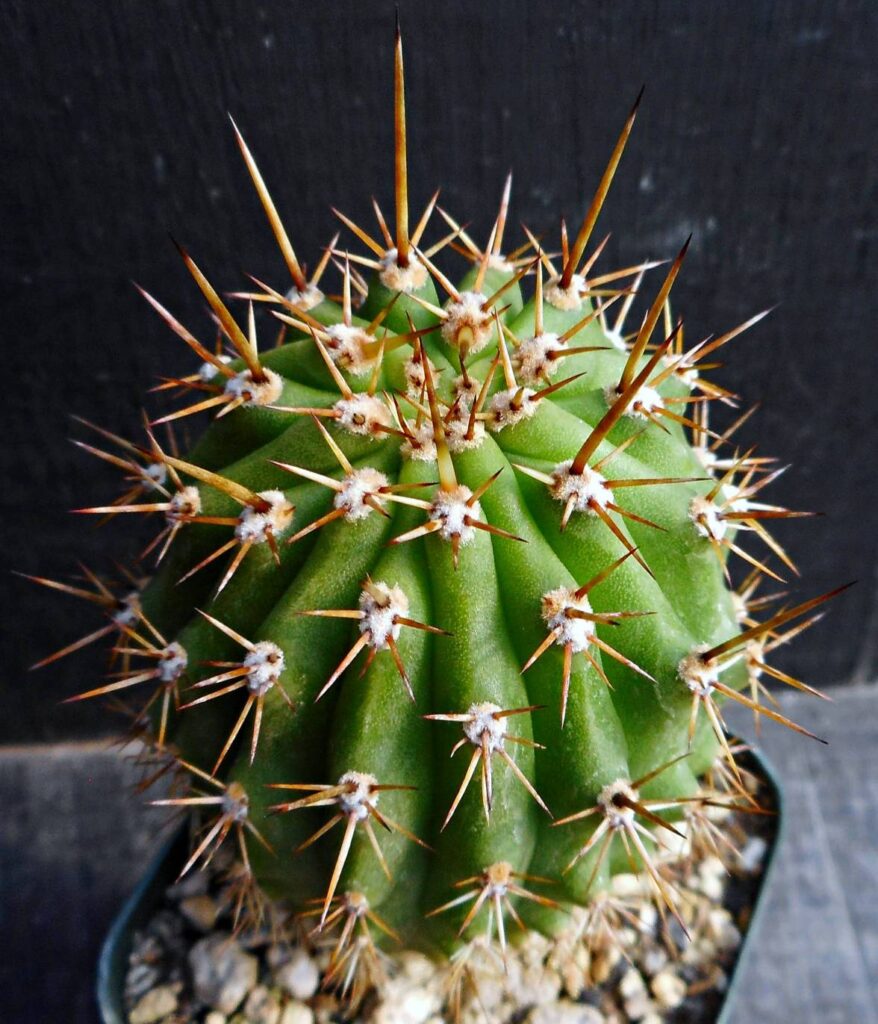 ↑ Auction plant ↑
↑ Auction plant ↑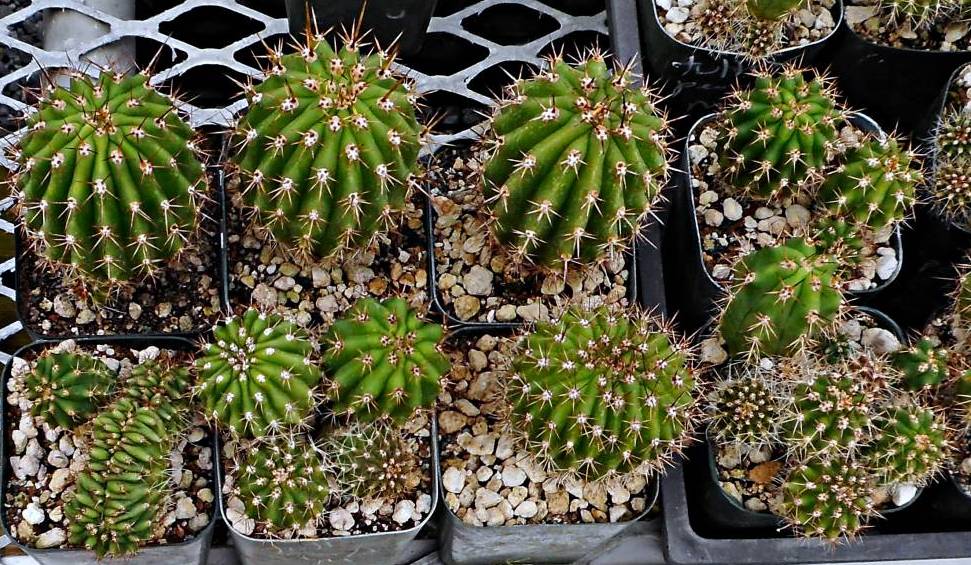 ↑ Mutant seedlings of this super hybrid ↑
↑ Mutant seedlings of this super hybrid ↑
↑ Auction plant rear—second from left [the rest sold or not for sale] ↑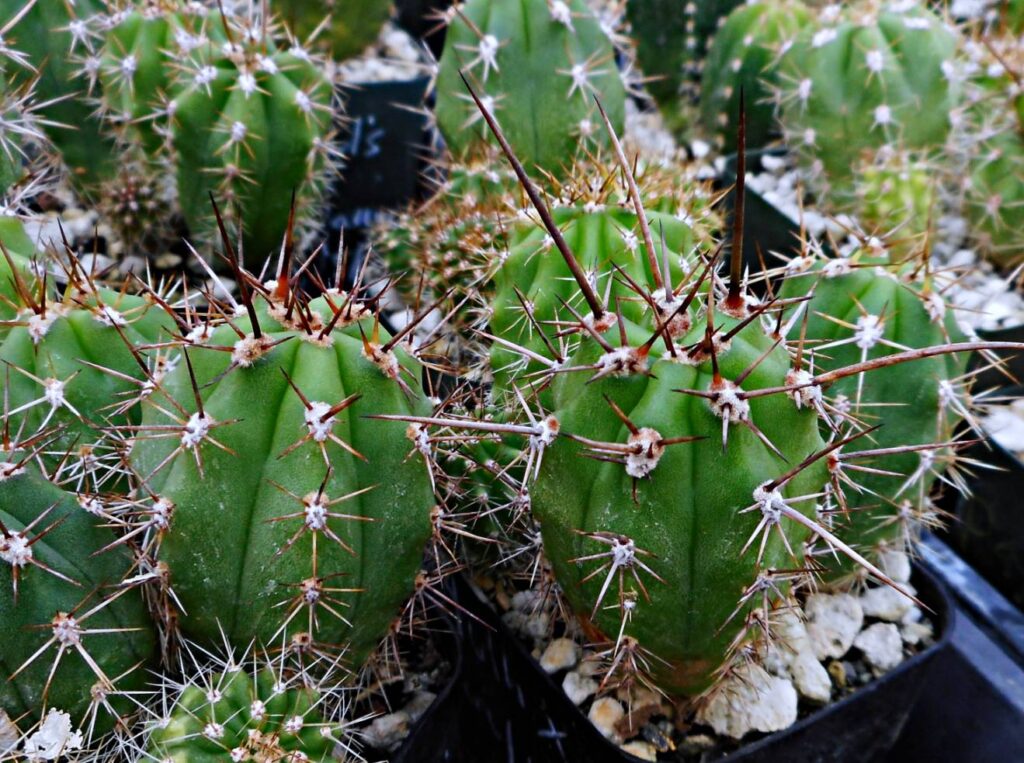 ↑ Kin of the auction plant, mostly non-mutant seedlings of this super hybrid ↑
↑ Kin of the auction plant, mostly non-mutant seedlings of this super hybrid ↑
↑ See the Specimen List ↑
__
♣
Other Succulents & Xerophytes
__
Boswellia nana “Dwarf Frankincense”
Burseraceae. Prostrate caudiciform subshrub to only 1–2′ tall. Simple dark green leaves with wavy margins, densely arranged along the stems and drought deciduous. New growth is red to bronze. Small pink flowers. Endemic to limestone cliffs, Socotra. Rich in aromatic balsamy oils. This amazing little species is the ultimate xerophytic bonsai and a real joy to behold. Needs bright light, well draining soil, heat and some humidity to thrive, along with a dry winter rest. Does fine in a sunny window with just a little extra care. We offer here a charming seedling first beginning to branch. Just starting to shed leaves for winter dormancy; shipped potted. Every succulent collection should include this regal dwarf frankincense! A make up auction alternate plant. Z10a/b
3″+ plant 2 years old – 3 bids – auction closed – winning bid $78 Listing closed!
__
Bursera fagaroides “Copal”
Burseraceae. A gorgeous bonsai specimen of this wonderful xerophytic Copal tree. Thick swollen trunks and limbs with smooth golden to silvery bark that exfoliates in thin papery sheets. Deciduous pinnate leaves, tiny flowers followed by purple green berries. Occurs throughout the Sonoran and Chihuahuan deserts of Mexico. The sap is the most common source of Copal, burned as an incense and “food for the gods”, highly aromatic with a sweet citrus-balsam scent. The trees are dormant the cooler months of the year, leafing out only with the onset of hot weather. Defoliates in autumn with an attractive display as the leaves change to yellow, orange and red. This bonsai has a sublimely bulbous caudiciform trunk that is 3″+ tall and 2″ diameter; the tree itself has been trained to reach no more than about 12″ tall with a 48″ canopy spread that could be tidied up a bit depending on your esthetic sense. A one of a kind specimen! Beginning to defoliate for winter. Really, this beauty is the perfect low-maintenance bonsai, easily grown, extremely tolerant of drying out (we only water it half the year) and general neglect. With a little select pruning and time this is sure to become the centerpiece of any collection. Z10a
12″ tall, 48″ wide, bonsai specimen, 12+ years old – 2 bids – auction closed – winning bid $127**Listing closed!

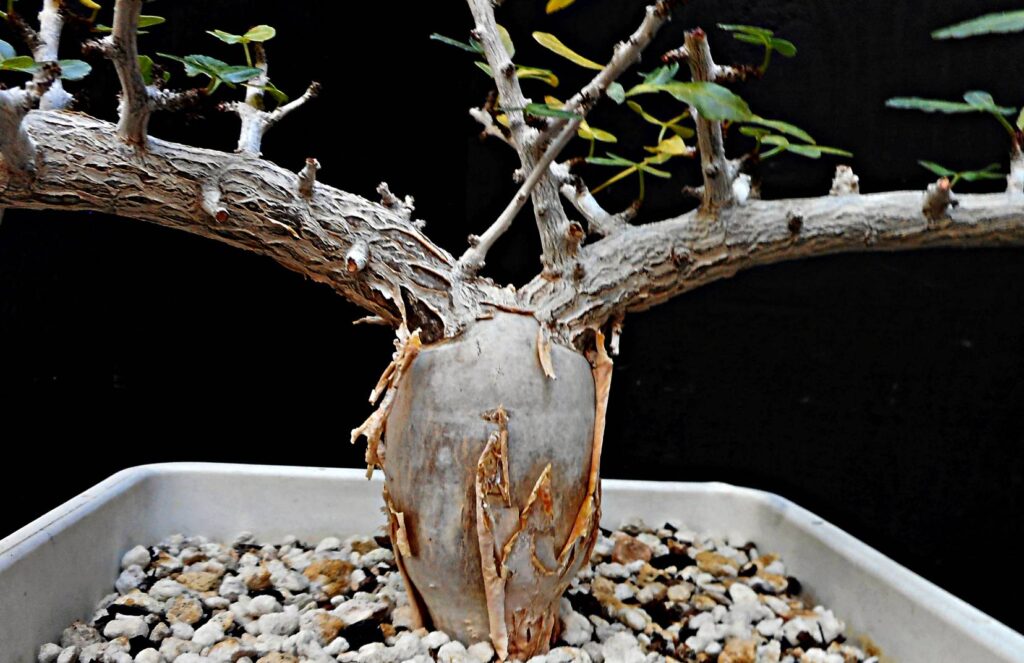 ↑ Bursera fagaroides bonsai auction plant, branch spread and caudex ↑
↑ Bursera fagaroides bonsai auction plant, branch spread and caudex ↑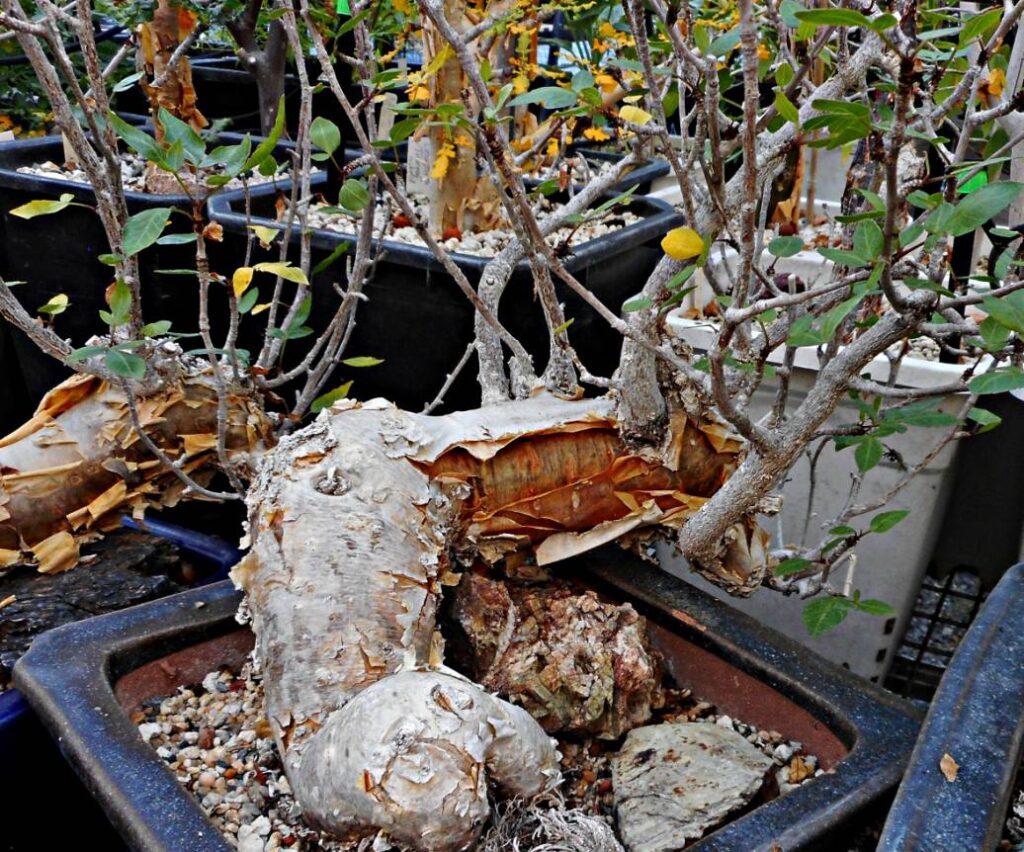 ↑ Example of 40+ year old Bursera fagaroides bonsai ↑
↑ Example of 40+ year old Bursera fagaroides bonsai ↑
__
♣
Andean Ethnobotanicals
__
Fern BK14510.3
A highly endearing, small, clumping to slowly creeping fern with erect, slender linear leaves 4–6″+ high, occasionally branching at the ends with an antler-like look. The leaves are dark green with a lime green central furrow and white speckles, the back sides covered in rust-orange sporangia. Growing with Berberis sp. and Gentianella rima, Eucalyptus understory, on the trail to the remnant Polylepis groves of Chakan, above Cusco City, Peru, about 12,000′. Identification eludes us, possibly a Microgramma species… Over the last 6 years we’ve only released a handful of this irrefutably delightful plant. It has proven quite hardy and easy to grow, tolerating shade and sun, cold and heat, and even some drying out. A favorite of all who’ve been lucky enough to grow it! Z8?
6″ plant 8+ years old – 3 bids – auction closed – winning bid $50 Listing closed!
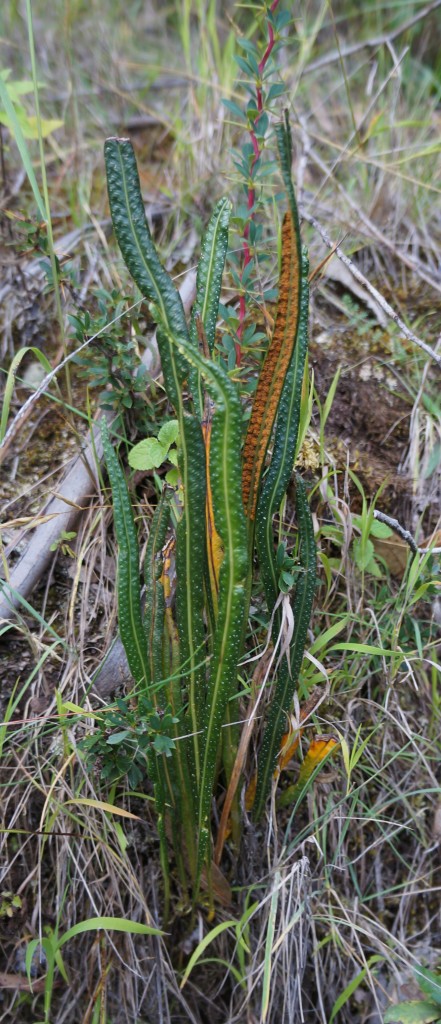 ↑ Fern BK14510.3 in habitat, Cusco, Peru ↑
↑ Fern BK14510.3 in habitat, Cusco, Peru ↑
__
Macleania glabra X Macleania? “Neotropical Huckleberry Hybrid”
Ericaceae. A magnificent caudiciform specimen of this hybrid neotropical blueberry, seed grown from open pollinated fruit thanks to our native hummingbirds. The father was one of our Andean or Central American species; the mother, M. glabra, is a rare semi-epiphyte from the cloudforests of Costa Rica with bloated lignotubers to 3′ across, arching stems with green to bluish leaves, clusters of pale rose to magenta flowers, and edible purple-black berries. This one-of-a-kind specimen has a shapely swollen caudex, arching branches and foliage similar to mom with pinkish to gold-green new growth. The flowers are a rose color, but with slightly flared pale pink tips and corollas that are a bit longer than any other Macleania we grow! We’ve kept this superb specimen in our personal collection until now, but alas, we can’t hoard all the best plants… so have decided to release this coveted beauty for others to delight in. Grow like other semi-epiphytic blueberries—quite easy with well draining acidic soil and filtered light; would do well in a hanging basket. Several genera of neotropical blueberries are traditionally used in love charms & aphrodisiacs, we can’t help but feel this plant would fit right in with the sensual rondure of the caudex, the graceful arch of the branches, the soft pubescent blush of the new growth, the enticing blossoms that arouse the passion of hummingbirds near and far… Enthralling! Z9b?
26″+ tall, 30″+ wide, multi-stemmed plant with 5″ by 3″+ caudex, 8–9 years old – 2 bids – auction closed – winning bid $148** Listing closed!
 ↑ Auction plant ↑
↑ Auction plant ↑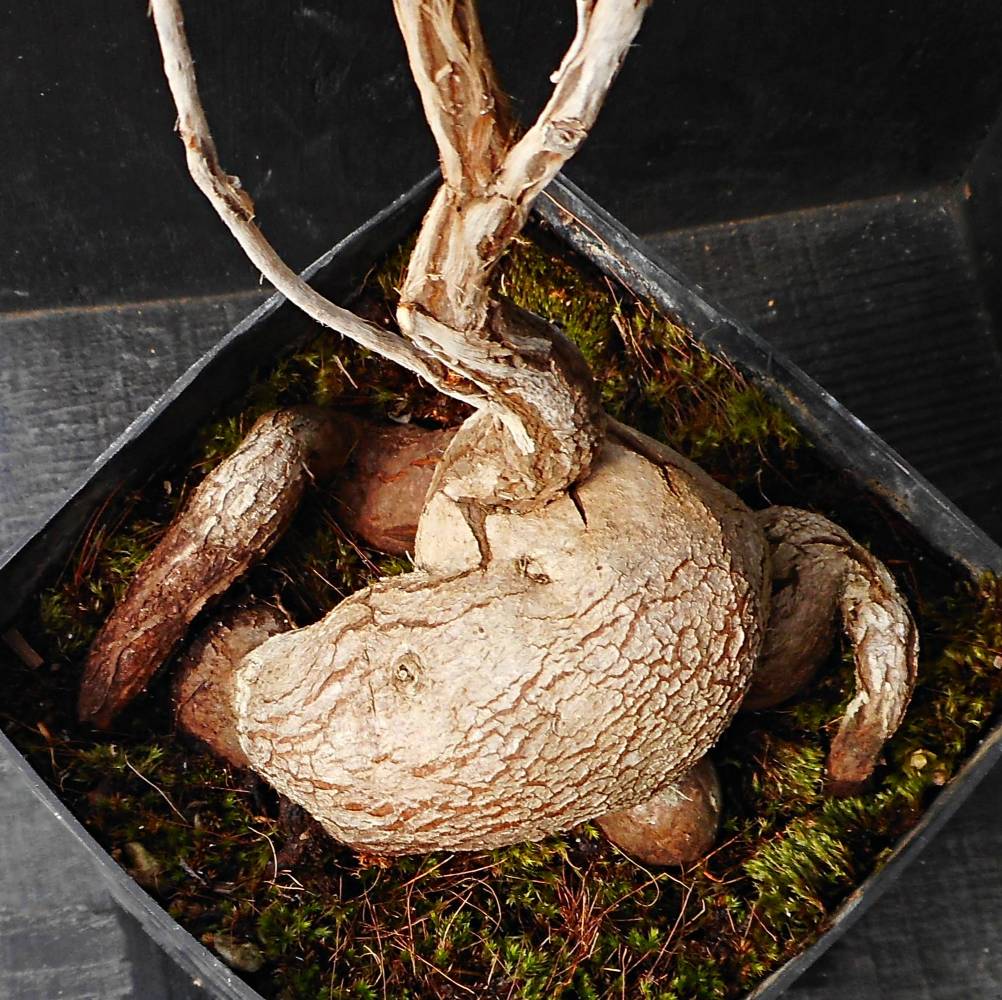
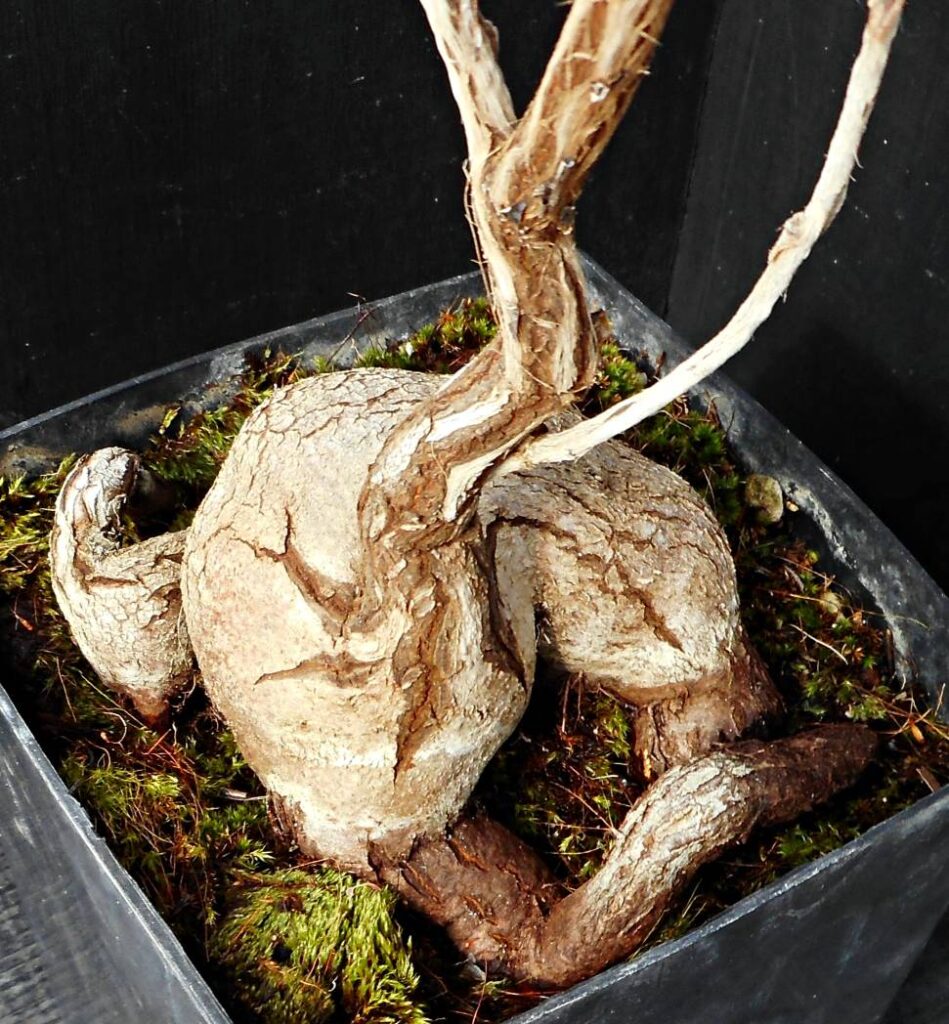 ↑ Auction plant caudex ↑
↑ Auction plant caudex ↑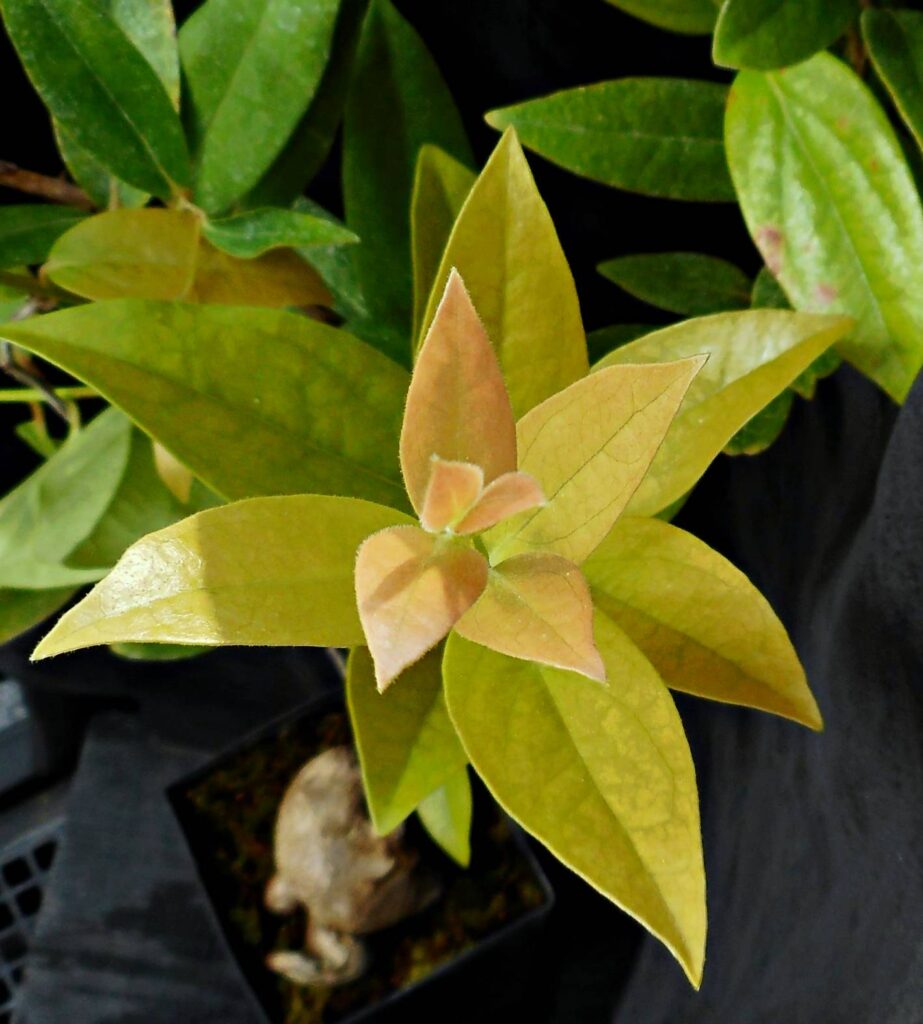 ↑ Auction plant new growth ↑
↑ Auction plant new growth ↑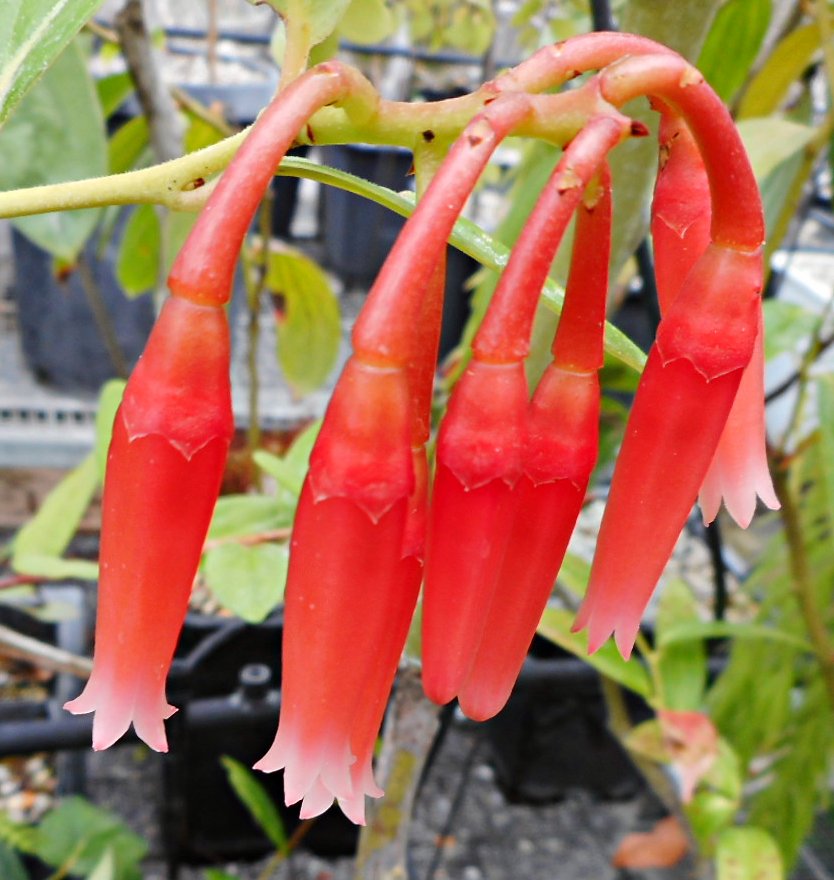 ↑ Blossoms of auction plant, the longest corolla of any Macleania we grow ↑
↑ Blossoms of auction plant, the longest corolla of any Macleania we grow ↑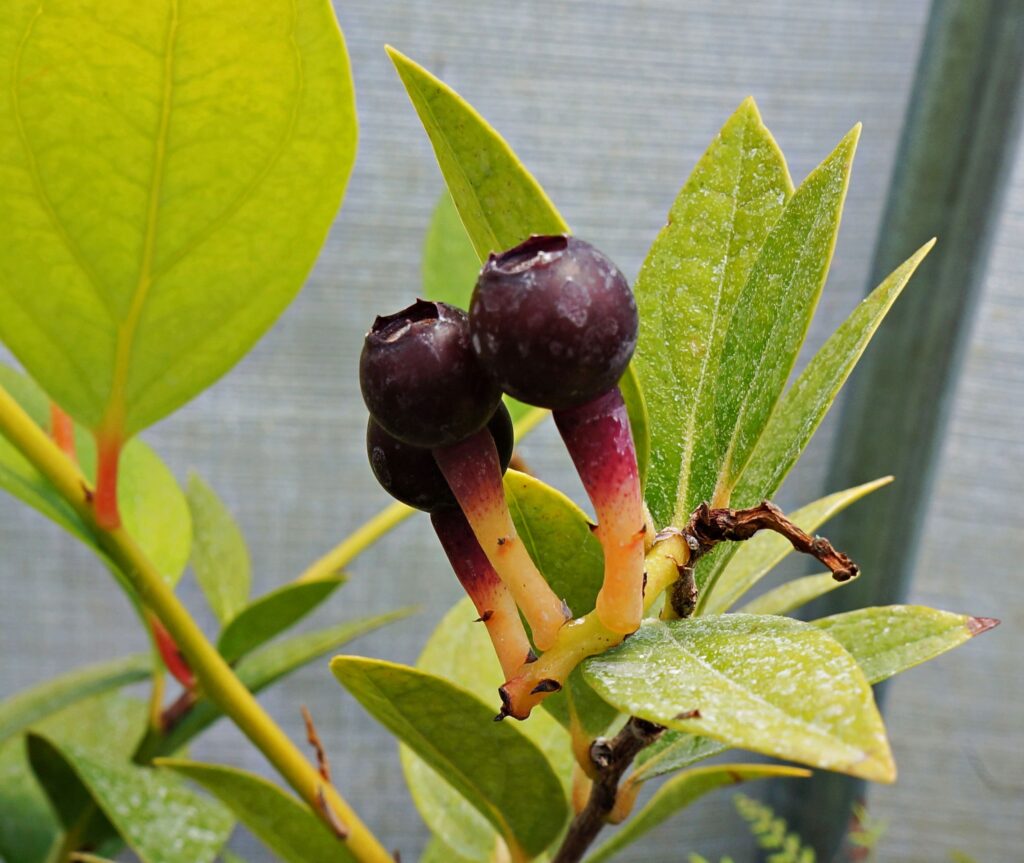 ↑ The large, juicy berries of the Macleania glabra mother plant ↑
↑ The large, juicy berries of the Macleania glabra mother plant ↑
__
♣
Other Beneficial Plants
__
Agapetes serpens ‘Bhutan’ “Himalayan Huckleberry”
Ericaceae. A new, large flowered clone of this amazing caudiciform huckleberry. Semi-epiphytic evergreen shrub to 5’+, highly floriferous—a banquet for hummingbirds. Has long and graceful arching branches arising from a globular woody caudex. Compared to the other A. serpens we grow, the leaves of this clone are a bit more densely arranged on the stem, the flowers a deeper red, notably larger and with pronounced recurved tips. In fact, these unique flowers are the biggest of any A. serpens we’ve seen. Purple edible berries, deliciously juicy and delightfully chewy. Originally grown from seed wildcrafted in the cloudforests of Bhutan. Quite easy to care for, prefers part shade, well draining acid soil and regular moisture, yet is surprisingly tolerant of sun and dry periods once the caudex develops. Fruits best when cross pollinated with a separate clone or species. Rooted cutting already beginning to form a little caudex. First time we’ve offered this sumptuous clone. See towards the end of our Specimen Plant List for other Agapetes species. Z8b?
8″+ branched plant – 3 bids – auction closed – winning bid $55 Listing closed!
↑ Agapetes serpens ‘Bhutan’ auction plant ↑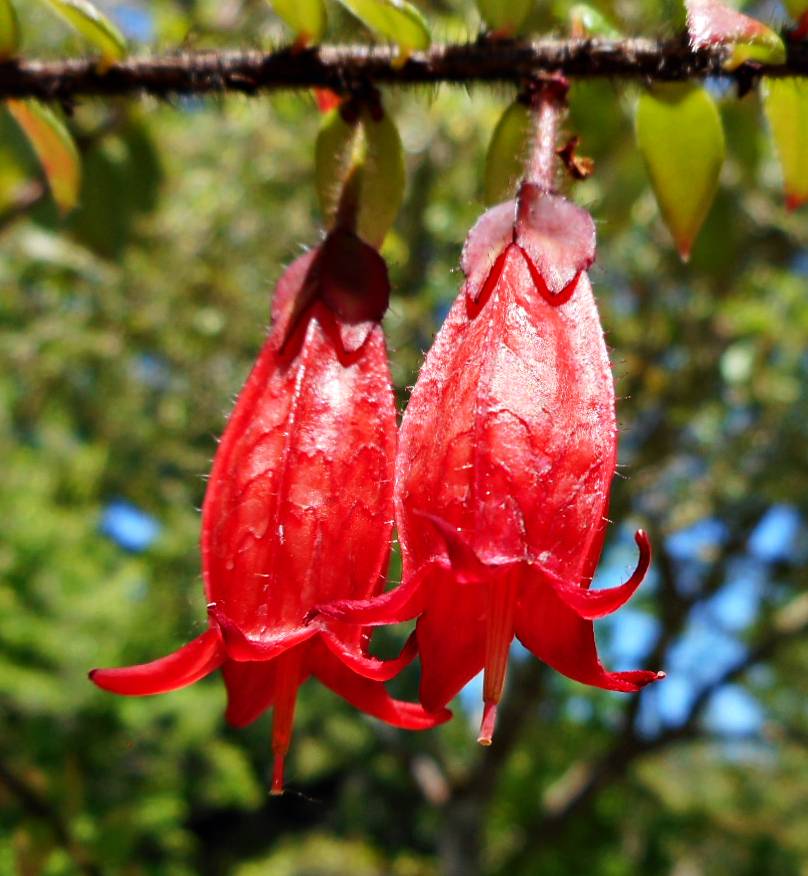
 ↑ Unique flowers of Agapetes serpens ‘Bhutan’ ↑
↑ Unique flowers of Agapetes serpens ‘Bhutan’ ↑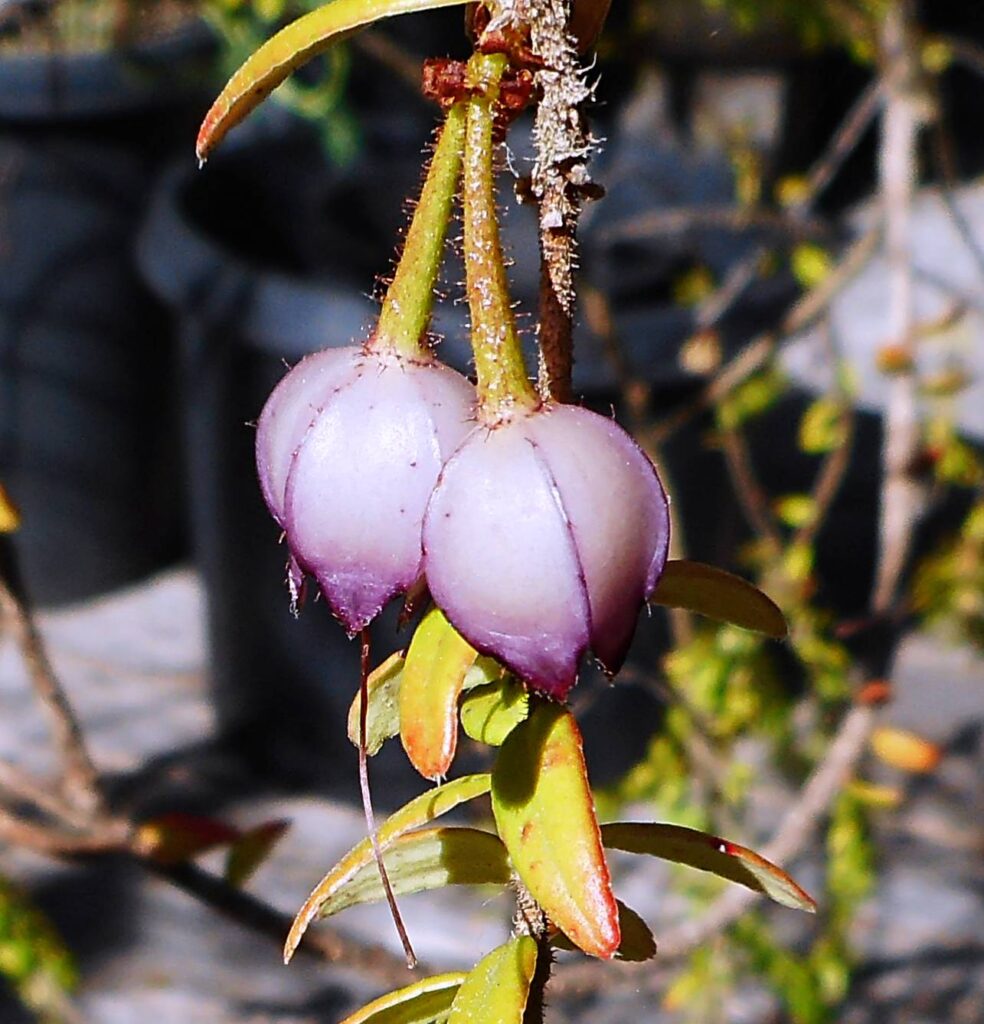 ↑ Agapetes serpens berries ↑
↑ Agapetes serpens berries ↑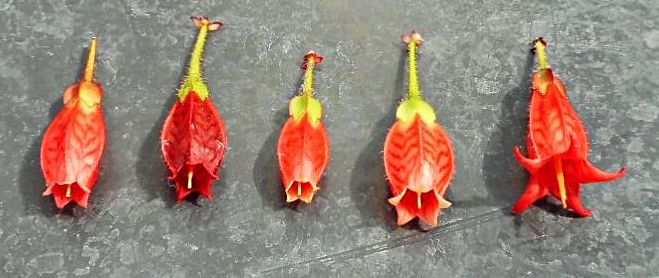 ↑ Diverse flowers of Agapetes serpens clones, L to R: common clone, Ruby, SS16B, SS16A, Bhutan [auction plant] ↑
↑ Diverse flowers of Agapetes serpens clones, L to R: common clone, Ruby, SS16B, SS16A, Bhutan [auction plant] ↑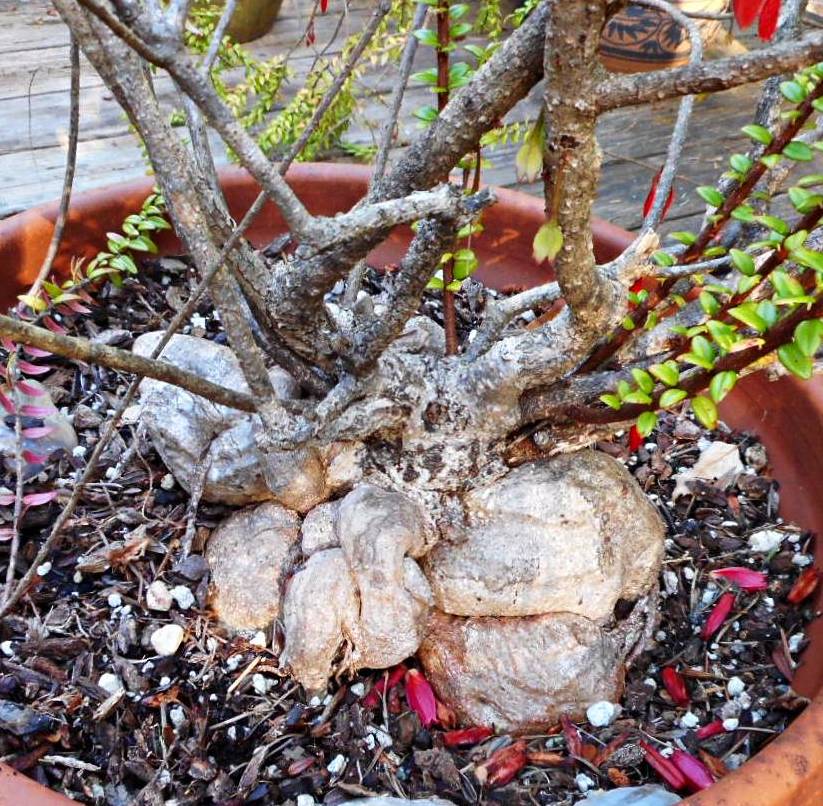 ↑ Example of old Agapetes serpens caudex ↑
↑ Example of old Agapetes serpens caudex ↑
♣
The make up auction closed at 6:00pm PST, Wednesday, October 30
__
~ End of Make Up Auction List ~
◊
Shipping and Handling for Auction Plants
First Class Priority Mail = $10.00 for the first plant $2 each additional plant.
Express mail = Inquire for current costs
*Plants marked with a single asterisk* are large, heavy & have special shipping charges =
$18.00 for the first plant, $2 each additional plant.
**Plants marked with double asterisk** are extra large and/or heavy. We charge you the USPS postage cost plus a $6 handling fee on the total order. Please note: Shipping costs for these will be significant for folks in eastern states (for example a 36″ Trichocereus sent to the East Coast would be around $45-70+ shipping but less than half that for the West Coast). You may inquire the approximate shipping cost by emailing us your zipcode.
California residents add 7.25% sales tax. Sonoma county residents 8%.
Order Form
Sacred Succulents, P.O. Box 781, Sebastopol, CA 95473 USA
♣
↓ The first Autumn Fundraiser that ended 10/20 is listed below ↓
♥
 ↑ View from the Cordillera Negra at 15,000′ — the Rio Santa Valley & Cordillera Blanca, Ancash, Peru ↑
↑ View from the Cordillera Negra at 15,000′ — the Rio Santa Valley & Cordillera Blanca, Ancash, Peru ↑
♣
The 1st Autumn auction-fundraiser is now closed!
This auction ended October 20, at 6pm PST. Winning bids are now posted.
10/21/24 NOTE: We heard from a number of long term customers that they never received the emails announcing the start and the close of the auction this week… We are at a loss as to why not everyone on the list received our posts and are looking into this. We noted that the number of folks taking part in the fundraiser was significantly lower than we’d ever seen, with about half the plants being bid on by only 2 people back & forth. We thought perhaps the timing was off, but it now seems at least partially due to issues with our email list.
To remedy this situation, especially for those who missed out, we may hold a second auction round…
It could be helpful to hear from you if you’re signed up to the SS email list but did not receive an email on 10/15 or 10/20.
benkamm@monitor.net
Gratitude for your support!
♣
Last updated 10/21/24
◊
After the damage we’ve sustained the last 2 winters, and extreme heat spikes in summer taking a toll, these auctions are a big help in raising the support the nursery so vitally needs to continue — know that your auction purchases directly fund these much needed nursery repairs, essential renovations, ongoing irrigation installation [after 20 years of hand-watering, we can no longer keep up — we’ve lost over 25% of our rare & endangered plant collection in the last 5 years due to the climatic shift towards hotter & drier], equipment repair & replacement [for instance, the refrigerator we use exclusively for our seed bank died during the worst summer heat], as well as our continual research & conservation work.
We are deeply grateful for your love of plants and support of our work!
__
About the Auction-Fundraiser:
(We can only ship plants to US addresses, Seed & Books ship internationally)
___
This is an exclusive opportunity to obtain completely new introductions, magnificent one-of-a-kind specimens, and awesome rarities that are not available anywhere else — including species & clones we haven’t offered in many years, and likely won’t offer again for many more.
In fact, this is your single chance to obtain many of these plants – they will not be available again!
For other unique offerings see our SPECIMEN PLANT LIST
___
Know that auction purchases will directly fund much needed nursery repairs to damage from last 2 winters’ storms and summer extremes, essential renovations, ongoing irrigation installation, etc., as well as our continual research and conservation work.
___
We honor the email bids as first come first serve, so if we don’t respond right away—do not worry, we will honor your bid in the order/time it was received!
The auction will be updated at least twice a day by 11 am and 6 pm, much more often the final day.
Towards the end of the auction can get hectic and we may not be able to notify you in a timely manner if you’ve been outbid during this last phase – we recommend checking the website periodically to see the updated current high bids and respond accordingly.
The auction closes at 6:00 pm PST, Sunday, October 20. The winning bids should all be posted on the website that night, no later than 7:30 pm PST. You will be contacted by email that evening or the following morning for the auction plants you have won. Our regular shipping costs apply. Placing a bid is binding, so please do not bid unless you are committed to buying! We request payment (cash, check, or money order) be mailed promptly on Monday, October 21 (for international seed wins only, online payment can be arranged). Your plants will be shipped after payment is received.
♣
∴ This auction closed at 6 pm PST, October 20, winning bids posted. Make up auction is above ↑ ∴
♣
Auction Seed
[The seed part of the auction is open to both US and international bidders!]
Sorry, no seed this auction!
♣
Auction Plants
[We only ship to US addresses!]
Cactaceae
↔
Oroya borchersii BK09511.5 “Andean Golden Barrel”
A cold hardy and dazzlingly radiant golden-barrel type cactus to 12″+ in diameter. 1/2–1″ curved golden spines cover the spherical body of the plant. Luminous yellow flowers. Usually solitary, but sometimes clustering. Endemic to the upper Cordillera Negra of Ancash Dept., central Peru, where it can be found in open puna grasslands, rock outcrops and Puya raimondii habitat, from 12–15,000’+. Our seed accession from 13,200′, where low mounds of Ephedra aff. rupestris BK09511.2 acted as its nurse plant it. Growing with bunch grasses, Senecio spp., a Matucana species, and Austrocylindropuntia floccosa. The whole region is grazed by dairy cattle, while the cows don’t eat the cactus, we saw some sign of damage from their hoofs. We also heard that locals may remove the plants to make grazing easier or out of concern the cows will injure themselves on the spines. Protection through cultivation is encouraged. Easily grown at low altitude, one of the few species that has done well through a decade of our most severe NorCal summer heat and cold, wet winters. We offer you one of the last of our seed grown plants, long underpotted and ready to take off in a new container or rock garden. This brilliant, hardy cactus is practically unknown in captivity and worthy of wide cultivation. Z7/8?
2.5″+ plant 10+ years old – 4 bids – auction closed – winning bid $44 Listing closed!
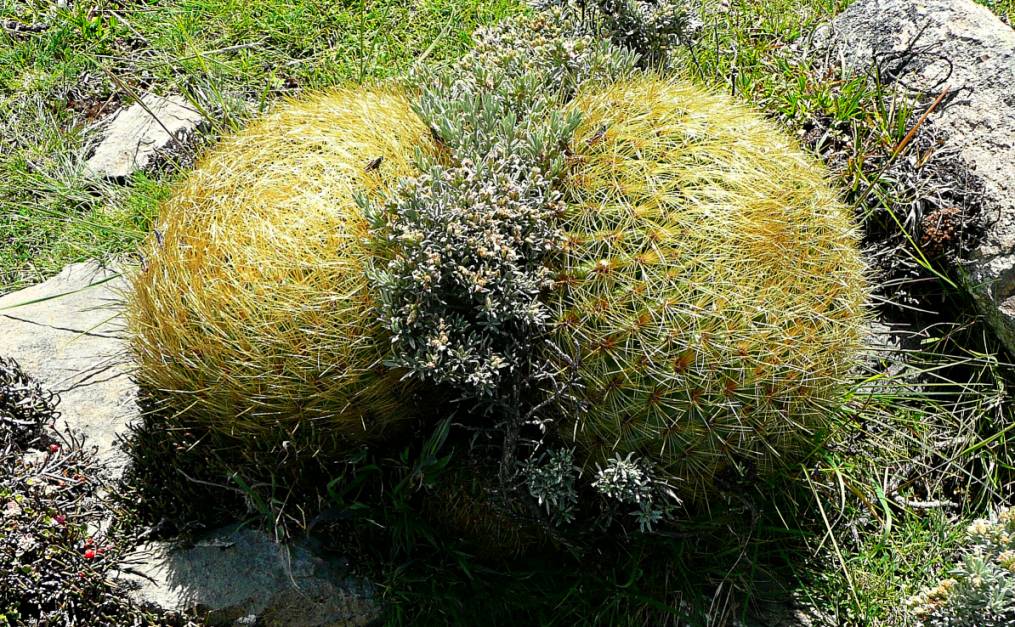

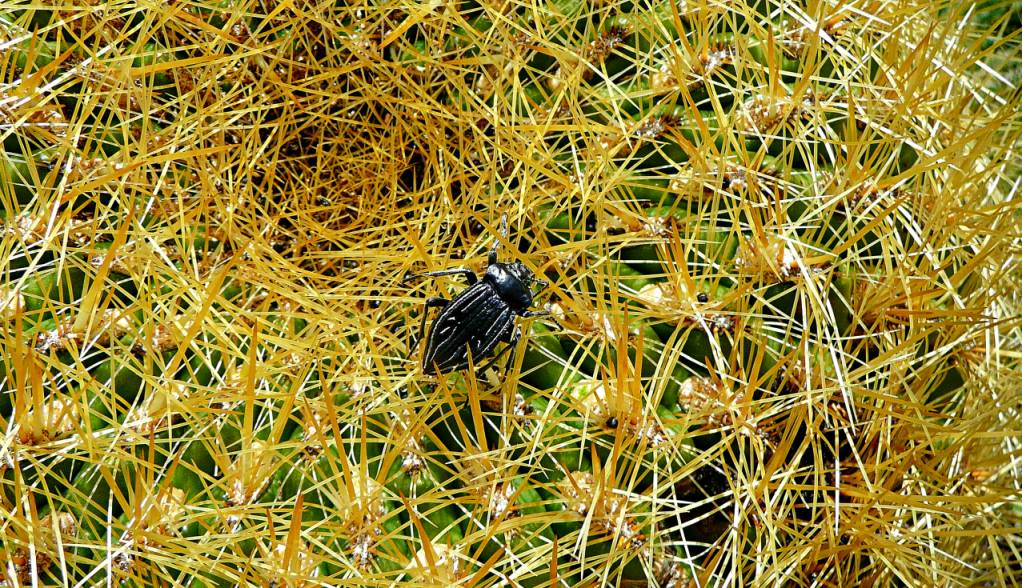 ↑ Oroya borchersii BK09511.5 in habitat, Cordillera Negra, Peru ↑
↑ Oroya borchersii BK09511.5 in habitat, Cordillera Negra, Peru ↑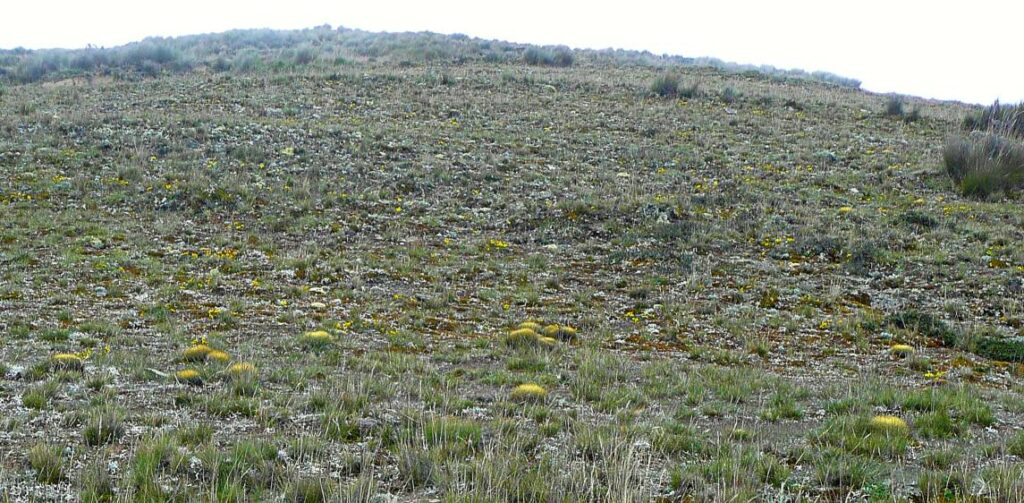 ↑ Oroya borchersii habitat, Cordillera Negra, Peru ↑
↑ Oroya borchersii habitat, Cordillera Negra, Peru ↑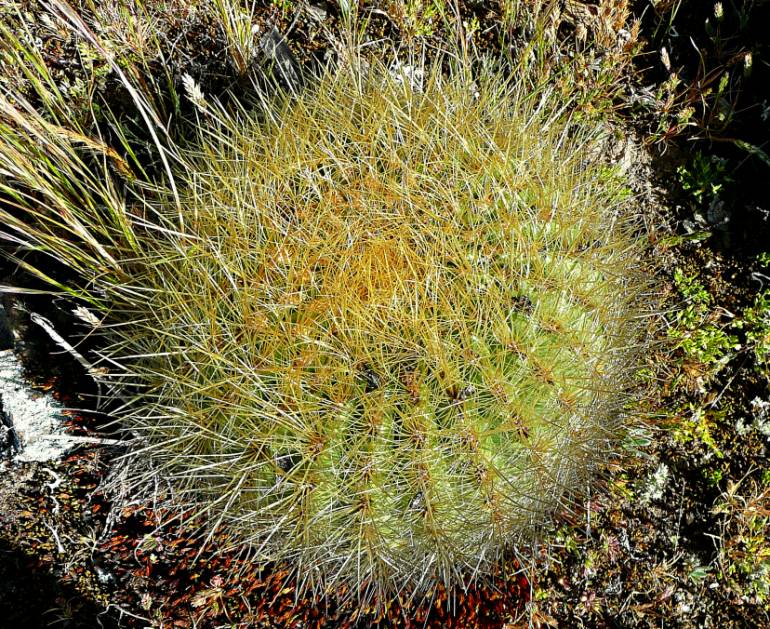 ↑ Oroya borchersii growing at the base of Puya raimondii, over 15,000′ ↑
↑ Oroya borchersii growing at the base of Puya raimondii, over 15,000′ ↑
__
Trichocereus bridgesii BK08608.3 cl. A “Achuma” “Bolivian San Pedro”
One of our rarely offered, but highly valued accessions of the famed Bolivian San Pedro. Seed from broad stands to 12′ + tall, 3.5–4″+ diameter blue-green stems, spined to nearly spineless—very similar to SS02 in appearance. These were a ‘normal’ form growing among bizarre, monstrose plants (BK08608.2) that appeared mutated due to a mealy-bug infestation. These remnant populations were observed in 2008, growing with with Tillandsia, Austrocylindropuntia, Baccharis, and Dunalia species, as well as introduced Cupressus and Sparteum junceum, on the edge of the suburbs, in the mountains north-east of La Paz City, La Paz, Bolivia, at well over 12,000′. May now be lost to development—at the time there were signs people had not only been harvesting the cactus for El Mercado de las Brujas, but had been removing it entirely from the hillsides—there were large heaps where the cactus had been cut and discarded with trash. We were informed by our artist friend, Efrain Ortuno, that this locale had long been known among local Aymara herbalists and it was here that a highly “potent” population of “rose-red flowered Achuma” occurred! None of our plants have bloomed yet, so we can neither dismiss or confirm his assertion; for now, we can only daydream that such a unique trait would show up in our seed grown offspring. So far, the progeny are a bit spinier than the ‘wild’ parents and have not yet expressed any mutations. Cuttings from one of our seed grown plants, selected for its attractive spination and hardiness—the mother has endured full exposure through many harsh seasons unscathed. Our distribution of this clone has been minimal and it’s been some years since we offered this mysterious, endangered accession at all. Little known in cultivation, one of several unique San Pedro we’ve largely kept for our own studies. Certainly a “must have” for the serious collector. Z9a
15″+ cutting – 6 bids – auction closed – winning bid $136* Listing closed!
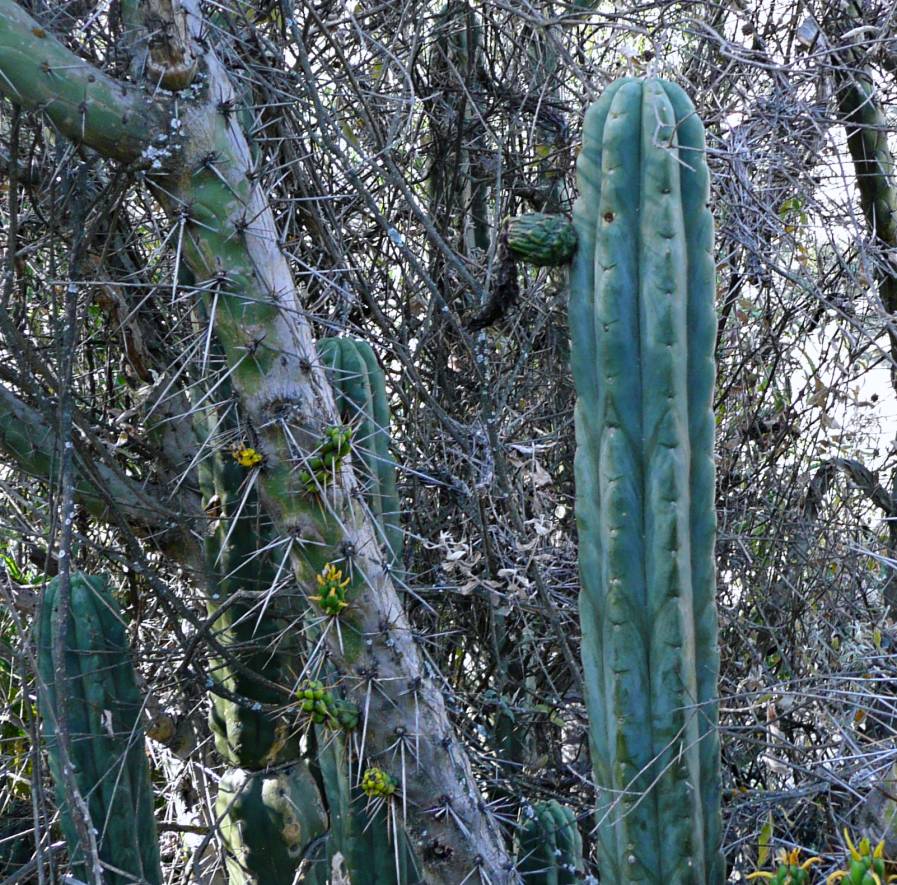
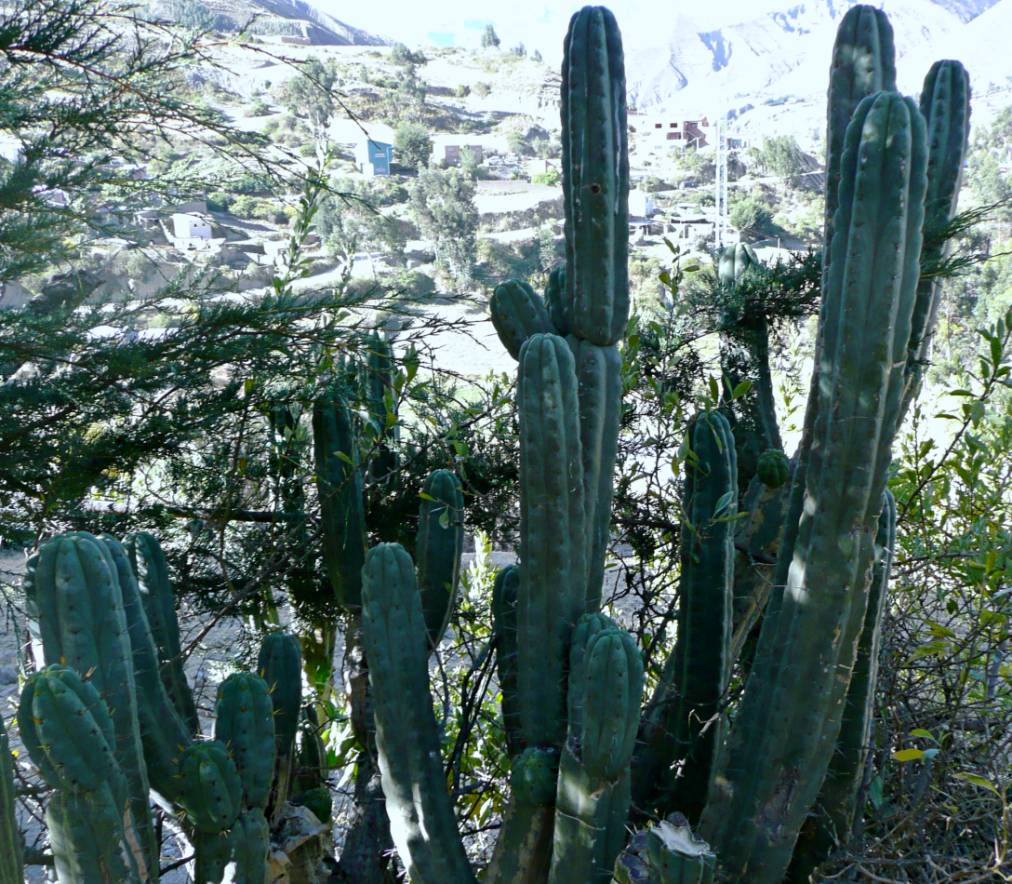
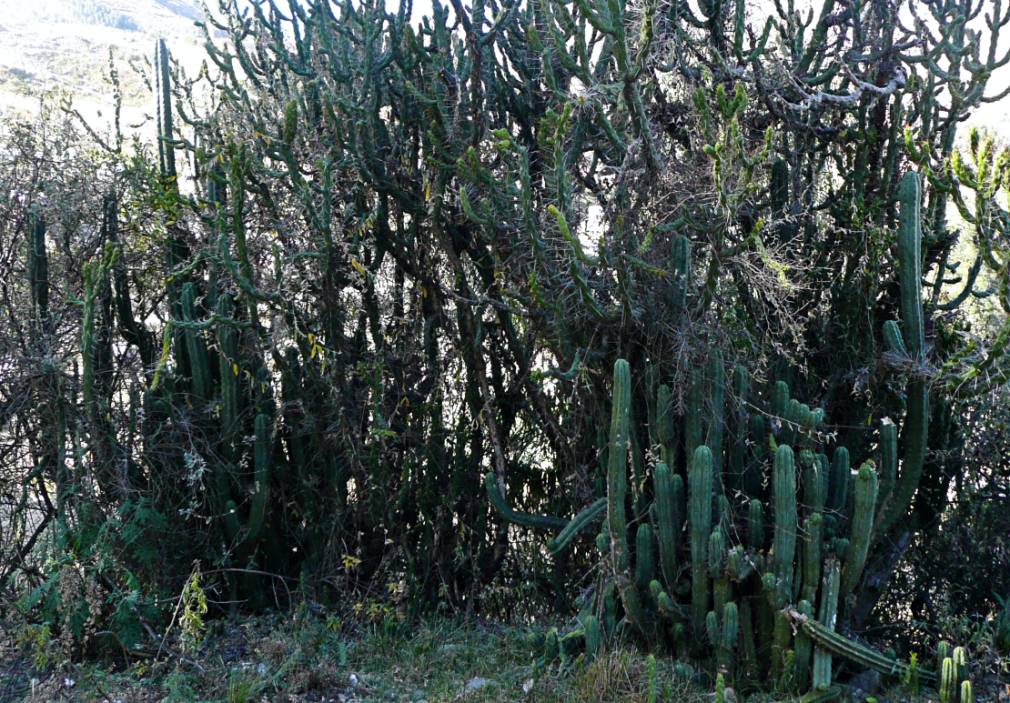 ↑ Mother Trichocereus bridgesii BK08608.3, NE of La Paz City, Bolivia, above 12,000′ ↑
↑ Mother Trichocereus bridgesii BK08608.3, NE of La Paz City, Bolivia, above 12,000′ ↑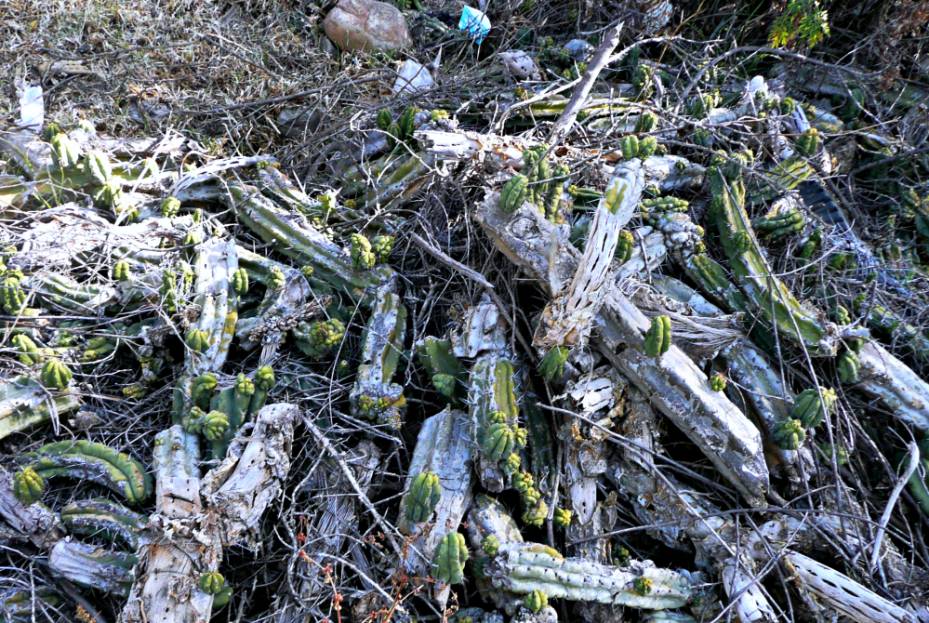 ↑ Evidence of of destruction in 2008 ↑
↑ Evidence of of destruction in 2008 ↑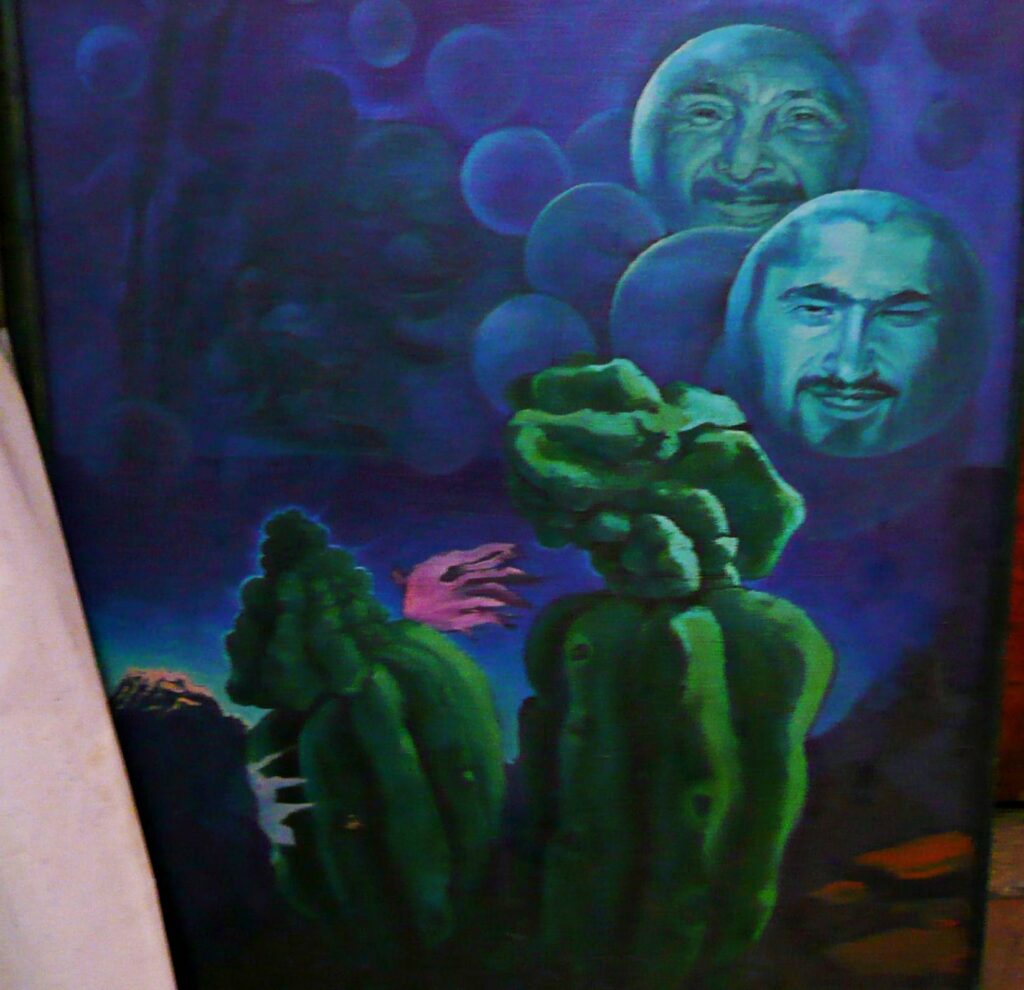 ↑ Efrain Ortuno’s painting of a mutated T. bridgesii with a rose flower from the locale ↑
↑ Efrain Ortuno’s painting of a mutated T. bridgesii with a rose flower from the locale ↑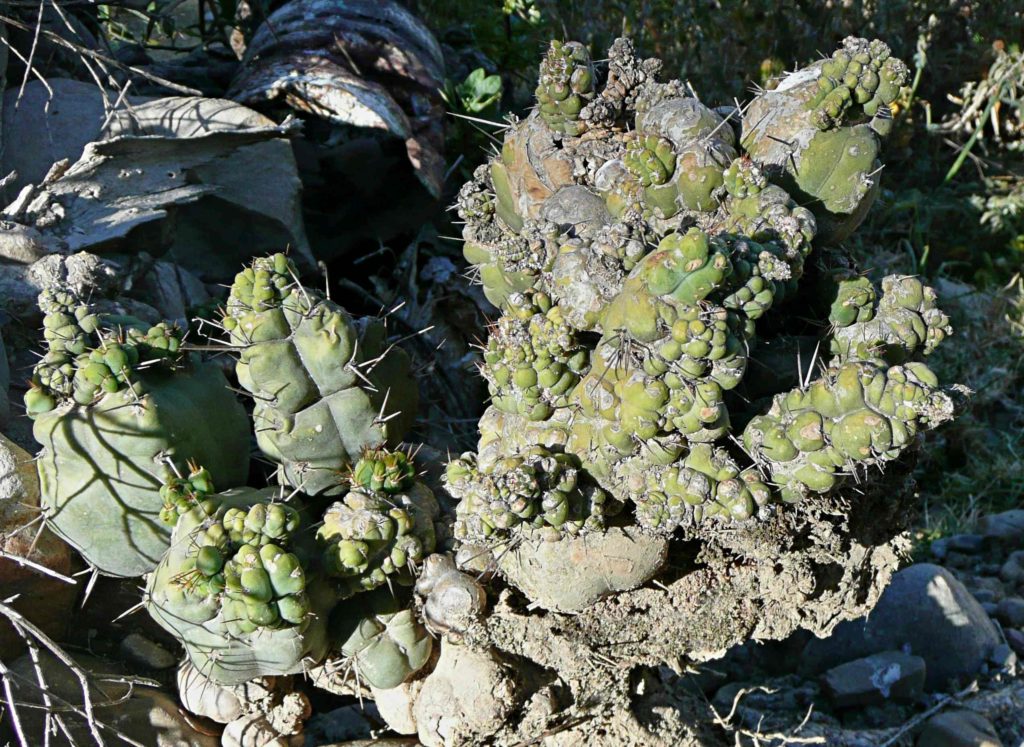 ↑ Mutation caused by mealy bugs?, same locale NE of La Paz City, Bolivia ↑
↑ Mutation caused by mealy bugs?, same locale NE of La Paz City, Bolivia ↑
__
Trichocereus sp. ‘Juul’s Giant’/SS01 X Trichocereus tulhuayacensis KK337
First release of this delightful new hybrid! The mother, Juul’s Giant X SS01, is an upright, round stemmed, short spined hybrid with large white flowers; the father was the incomparable, spiny, magenta flowered tulhuayacensis. So far the progeny favor their mother’s traits with rounded ribs and short spines that have darker hues like their father’s. We anticipate extra hardiness and unique colored flowers once mature. Be the first to grow this beauty! Z8b/9a
3.5″+ seedling 2–3 years old – 5 bids – auction closed – winning bid $56 Listing closed!
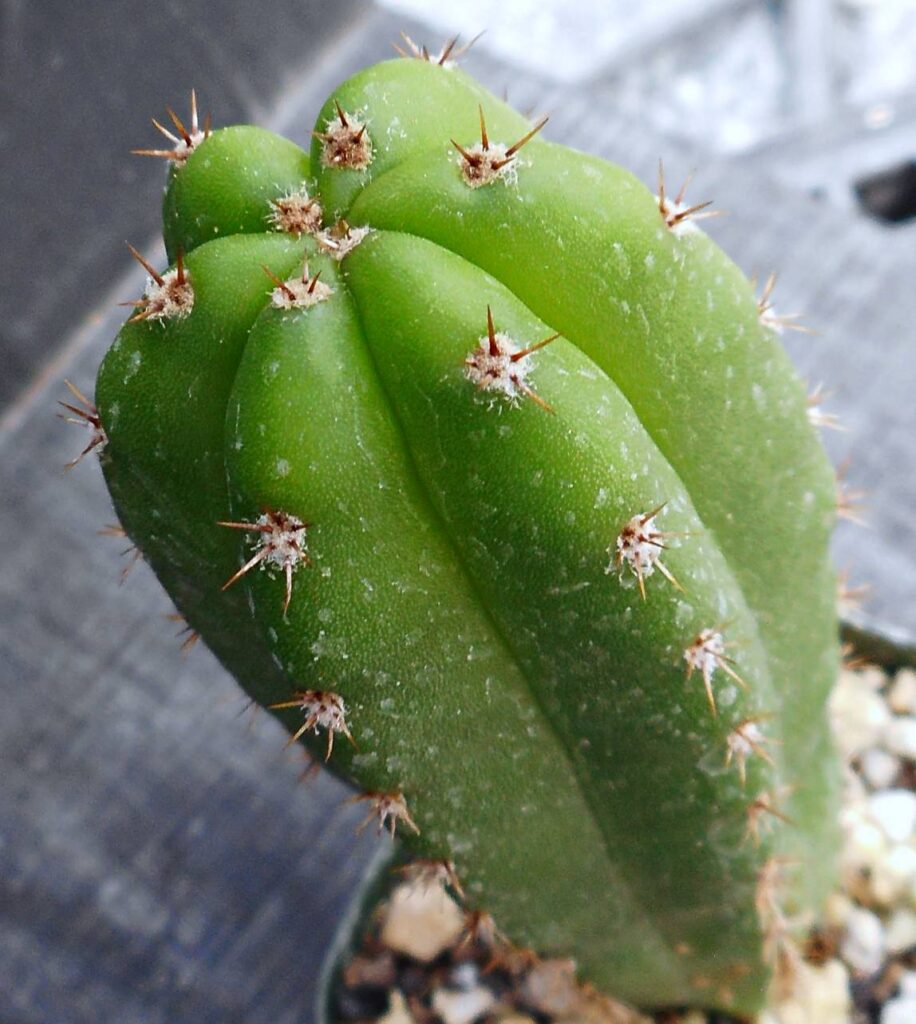
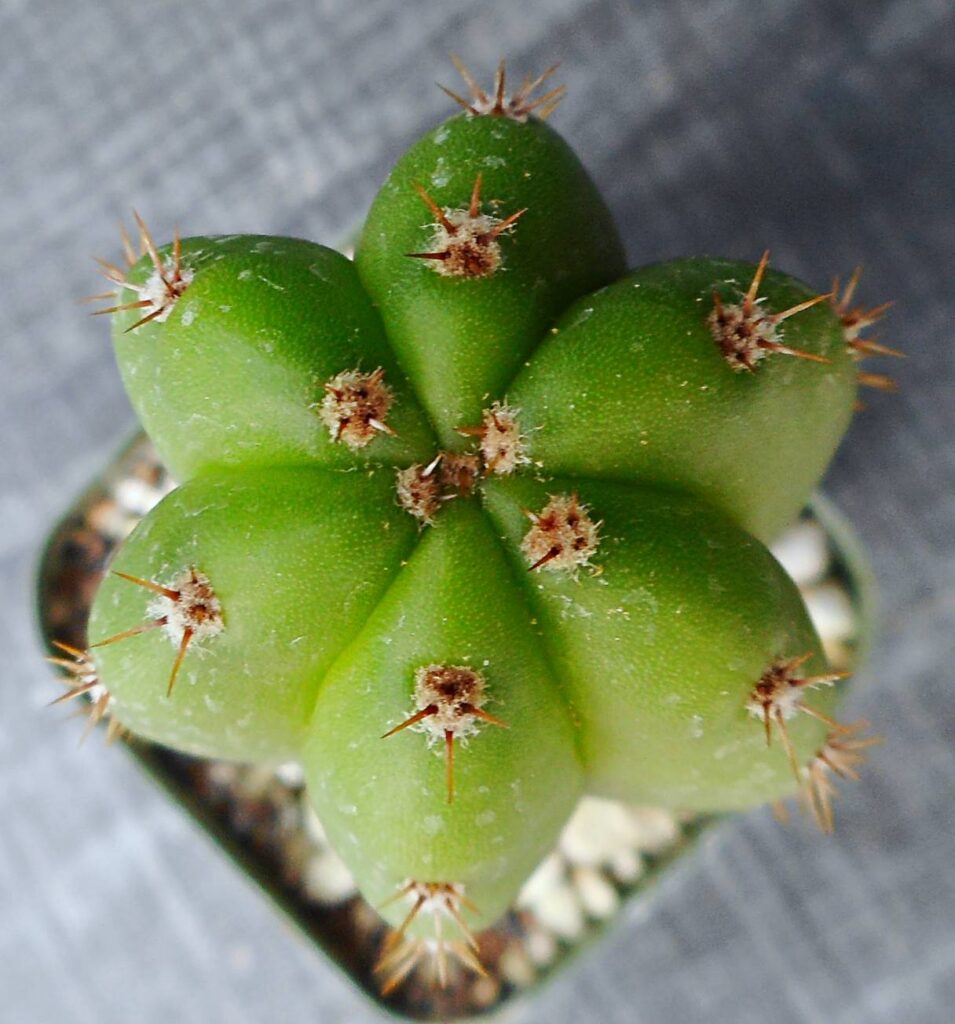 ↑ Trichocereus sp. ‘Juul’s Giant’/SS01 X T. tulhuayacensis KK337 auction plant ↑
↑ Trichocereus sp. ‘Juul’s Giant’/SS01 X T. tulhuayacensis KK337 auction plant ↑ ↑ Mother: Trichocereus sp. ‘Juul’s Giant’/SS01 ↑
↑ Mother: Trichocereus sp. ‘Juul’s Giant’/SS01 ↑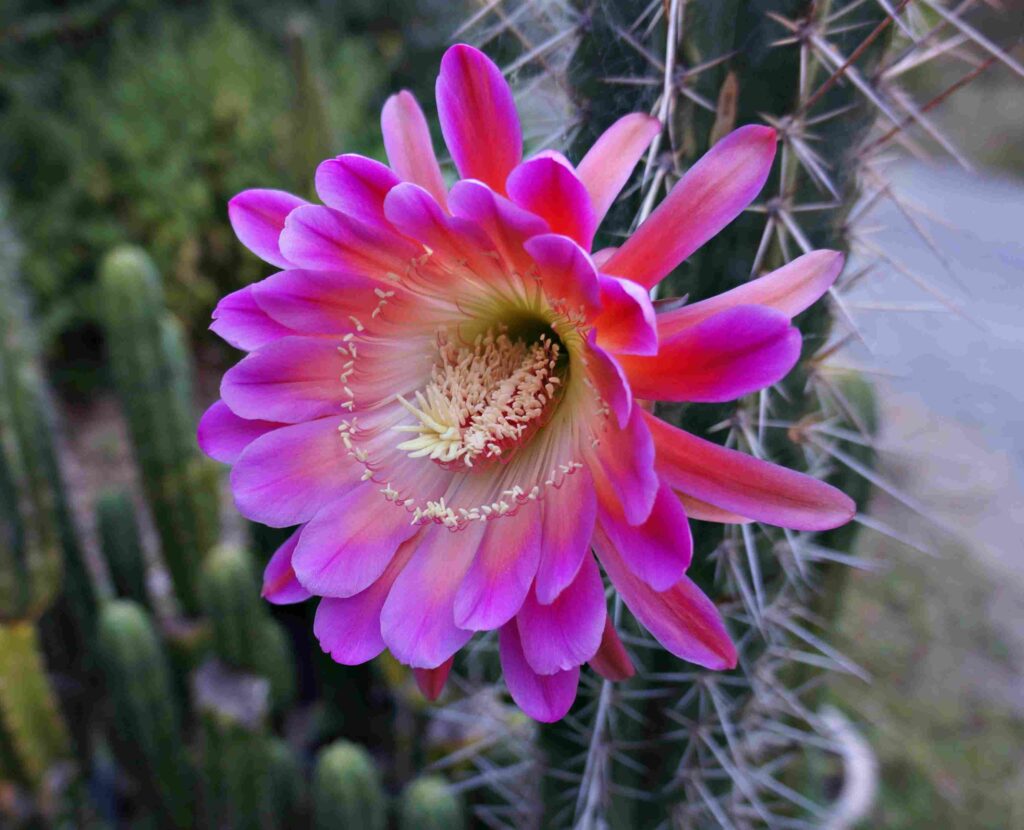 ↑ Father: Trichocereus tulhuayacensis KK337 ↑
↑ Father: Trichocereus tulhuayacensis KK337 ↑
__
Trichocereus pachanoi ‘Ogunbodede’s Matucana’ “San Pedro” “Huachuma”
Upright rounded stems with small spines. Originally imported by K. Trout, reportedly from Matucana, Huarochirí Prov., Lima Dept., Perú, where we have observed T. pachanoi planted around the town. This is the clone that stood out in Ogunbodede’s analytical study. Only available in very limited quantity each year and highly valued by collectors. Our mother plants were hit hard the last couple winters so this is the largest cut we’ll have on offer this year. Z9a
24″ long, 2.5–3″ diameter cutting – 7 bids – auction closed – winning bid $302**
__
Trichocereus pachanoi f. cristata cl. A “Mutant San Pedro” “Huachuma”
A marvelous mutant clone of the beloved San Pedro cactus. Forms thick fans of fabulous cristate growth and eventually large, convoluted mounds that resemble a monstrous brain. Occasionally reverts to normal growth or monstrose columns that have the look of molten wax. Each specimen is a living sculpture. Our stock was damaged a few years back and we’ve barely offered this beautiful mutant since then. A handsome rooted cutting, the only one available in 2024 and the largest specimen we’ll have to offer for at least a couple more years. Z9a
18″+ tall, 16″ wide plant – 5 bids – auction closed – winning bid $162** Listing closed!
Trichocereus pachanoi f. variegata “Variegated San Pedro” “Huachuma”
An extremely rare and lovely variegated cutting of the popular horticultural clone! Decades back, while visiting a now long defunct nursery, we were surprised to see a large stand of San Pedro, clearly the predominant US cultivar, but with more than half of its tall columns bearing striking variegation of yellow and gradations of green. After several years of requesting a cut, we eventually convinced that steward of the plant to part with one. We divided this to propagate and were disappointed when many cuts reverted to solid green. A couple remained variegated for several feet of growth, but these eventually reverted back to mostly green as well. Last season, the first heavily variegated branch we’d seen in many years grew out. We offer this long anticipated and uniquely colorful form here for the very first time! Z9a
11″ cutting – 5 bids – auction closed – winning bid $95* Listing closed!
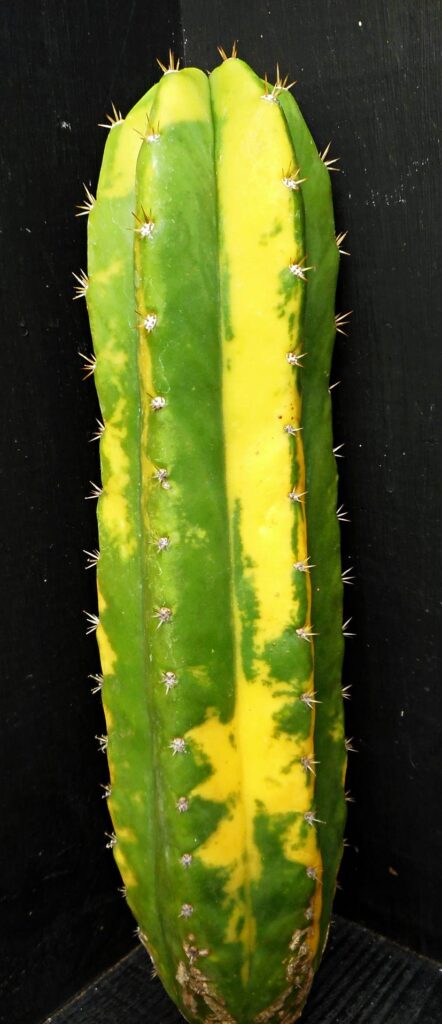
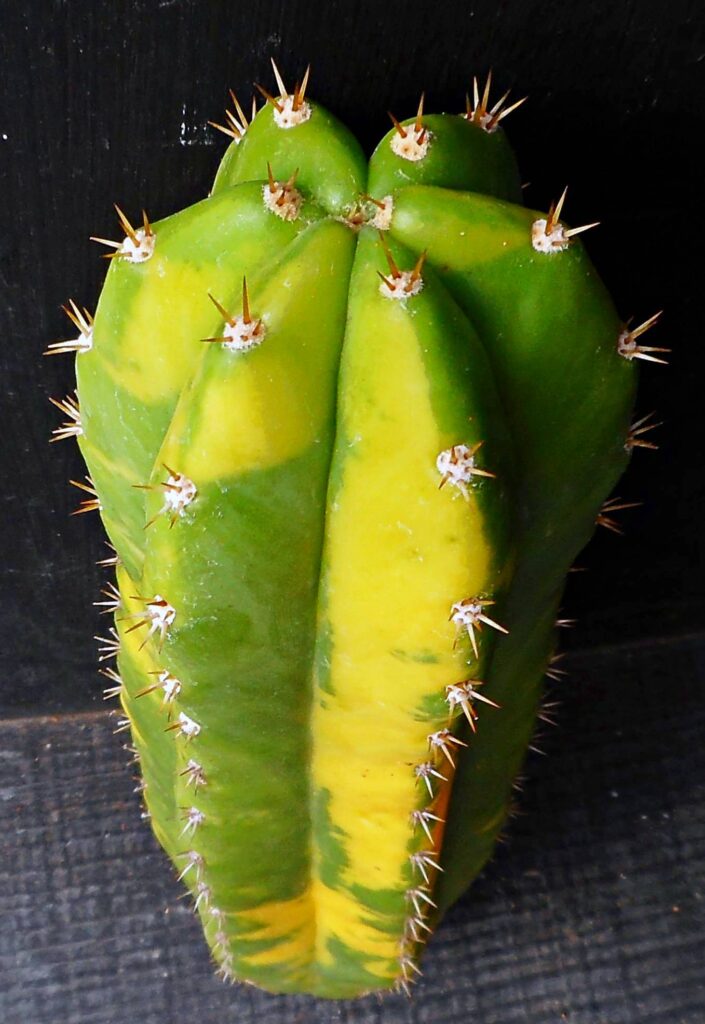 ↑ Trichocereus pachanoi f. variegata auction plant ↑
↑ Trichocereus pachanoi f. variegata auction plant ↑
__
Trichocereus peruvianus ‘Poma Largo’ “San Pedro Macho”
Fat, spiny columns with blue-blushed skin. Large areoles, new spines reddish to black. Funnel shaped white flowers and edible fruit. For those looking for additional genetic diversity, this is grown from wild seed, harvested from the remote Poma Largo populations, a bit south-east of the more well known Matucana T. peruvianus; Huarochiri, Lima Dept., Peru. First ever offering! Z9a
5″+ plant 4 years old – 5 bids – auction closed – winning bid $53 Listing closed!
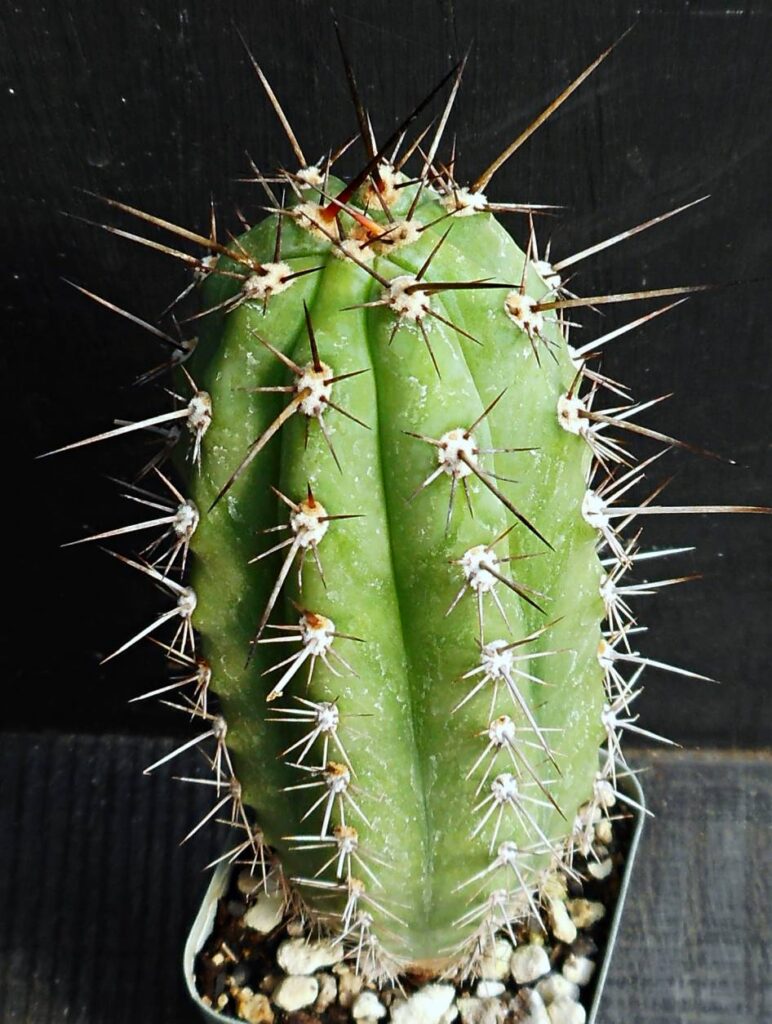
 ↑ Auction plant ↑
↑ Auction plant ↑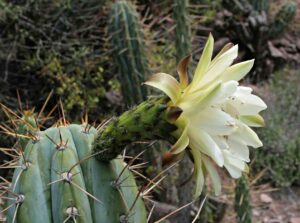 ↑ T. peruvianus blossom ↑
↑ T. peruvianus blossom ↑
__
Trichocereus aff. peruvianus SS01 (=Trichocereus sp. SS01)
Columns to 8’+ tall. Fat blue-green to bright blue stems up to 6″ in diameter; attractive 2″+ spines. White flowers, edible fruit. Can grow very fast; up to several feet a year under the right conditions. Grows prostrate with age. This heirloom clone is the first peruvianoid Sacred Succulents offered back when we began mail order in the late 90s. Our big mother plants and much of our stock were damaged nearly a decade ago and we rarely offer cuttings anymore, in fact—this is the only official offering of this clone in 2024. Z9a
16″ long, 4″ diameter cutting – 8 bids – auction closed – winning bid $120* Listing closed!
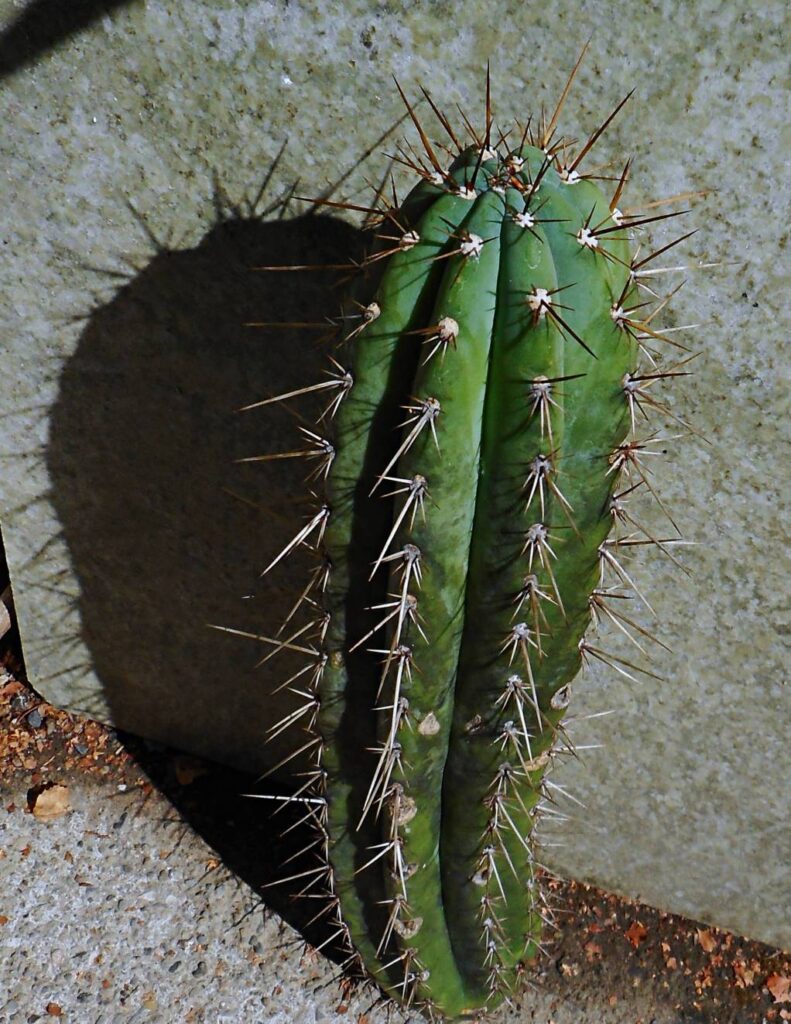 ↑ Trichocereus aff. peruvianus SS01 auction plant ↑
↑ Trichocereus aff. peruvianus SS01 auction plant ↑
__
Trichocereus scopulicola
Much sought after rare pachanoid. Upright stands to 15′ tall. Chunky, dark green stems with 5–8 ribs and tiny spines. White night blooming flowers, edible fruit. A rare species endemic to the rocky dry forests of Tarija, southern Bolivia. One of our favorite Trichocereus. Our stock has taken a real beating a few winters in a row now, so offerings of this exceptional species have been sparse. The only cutting offered this year, a bit slender from growing in the shadow of its mother—one of the nearly spineless clones which has actually weathered the extremes of recent years unharmed. Z9a
11.5″ long, 2–2.5″ diameter cutting – 3 bids – auction closed – winning bid $45* Listing closed!
__
Trichocereus sp. BK09509.1 “San Pedro de Chavín”
One of our legendary Chavín accessions. The mother was a candelabra stand to about 9′ tall, relatively slender, dark green, blue-blushed branches to about 3″ diameter. 5–7 central spines, the downward facing ones up to 1″ long. 1 central spine 1–2″. White trumpet flowers. Looks possibly intermediate to T. pachanoi/santaensis and cuzcoensis. Growing on a collapsed rock wall next to a field of fava beans, near the 3000 year old temple complex of Chavín de Huántar, Ancash, Peru, 10,500′. The ancient temple of Chavín is where the oldest depiction of a succulent plant (and possibly of its propagation) occurs — an anthropomorphic being carrying what is assumed to be a rooted Trichocereus cutting. We only offer cuttings of this awesome clone once a year. Z9a
13″ cutting – 3 bids – auction closed – winning bid $80* Listing closed!
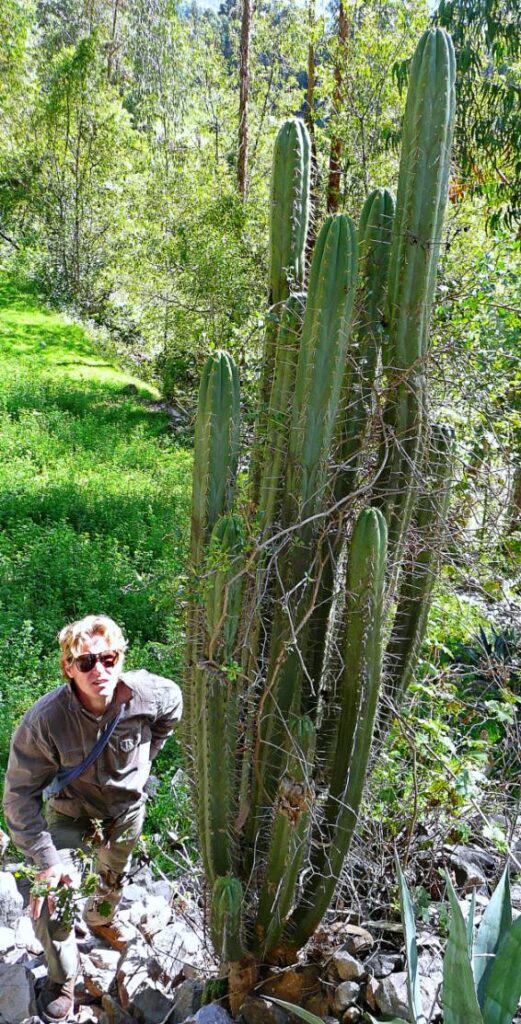 ↑ Neil Logan observing BK09509.1 in habitat, Chavín, Ancash, Peru ↑
↑ Neil Logan observing BK09509.1 in habitat, Chavín, Ancash, Peru ↑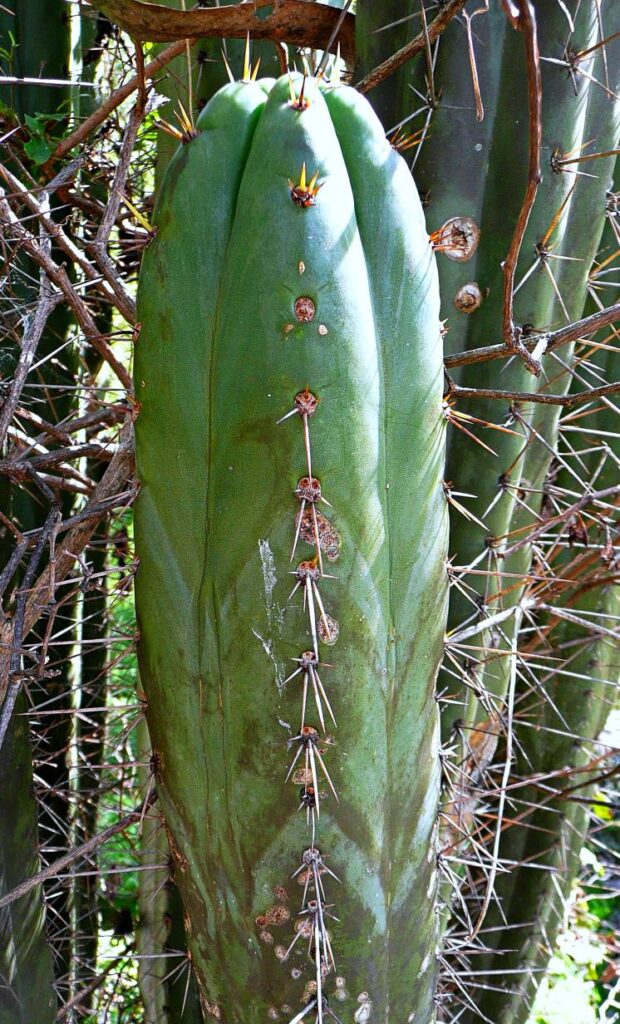 ↑ Trichocereus sp. BK09509.1 in habitat, Chavín, Ancash, Peru ↑
↑ Trichocereus sp. BK09509.1 in habitat, Chavín, Ancash, Peru ↑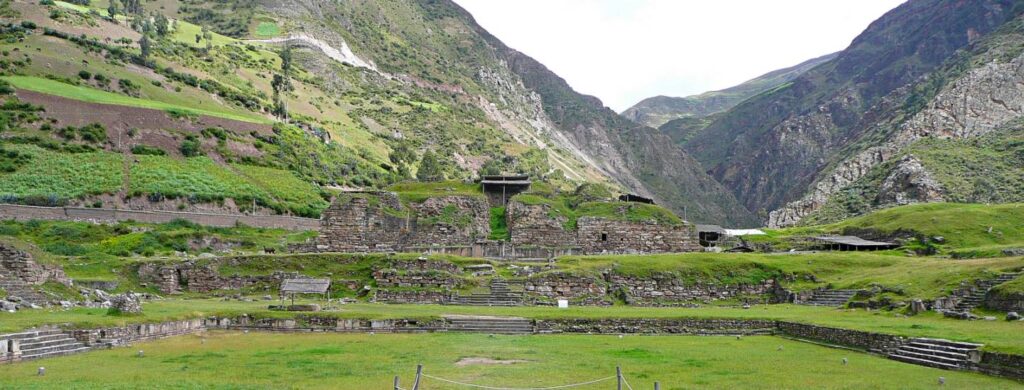 ↑ The 3000 year old temple of Chavín de Huántar ↑
↑ The 3000 year old temple of Chavín de Huántar ↑
__
Trichocereus tulhuayacensis KK337 X T. peruvianus/‘Juul’s Giant’ hybrid f. monstrosus
Here’s a chance at a choice and singular monstrose seedling of this exciting new hybrid. The spiny magenta flowered tulhuayacensis impregnated by our large blue-green peruvianus/Juul’s mutant that produces huge white flowers with extra petals. The monstrose/cristate genes, colored & mutant flowers, and exceptional spines will combine in unexpected and novel ways—some of the progeny, such as this many ribbed selection, are already showing very unique mutant traits and we can’t wait to see how magnificently they mature! We’re envisioning thick brain-coral growth with stout, red to black spines and unfurling fans of huge purplish blossoms! Whatever maturation brings, this is certain to become a one-of-a-kind living sculpture. Z8b/9a
3″+ tall, 2″+ diameter plant with small pup, 3+ years old – 7 bids – auction closed – winning bid $62 Listing closed!
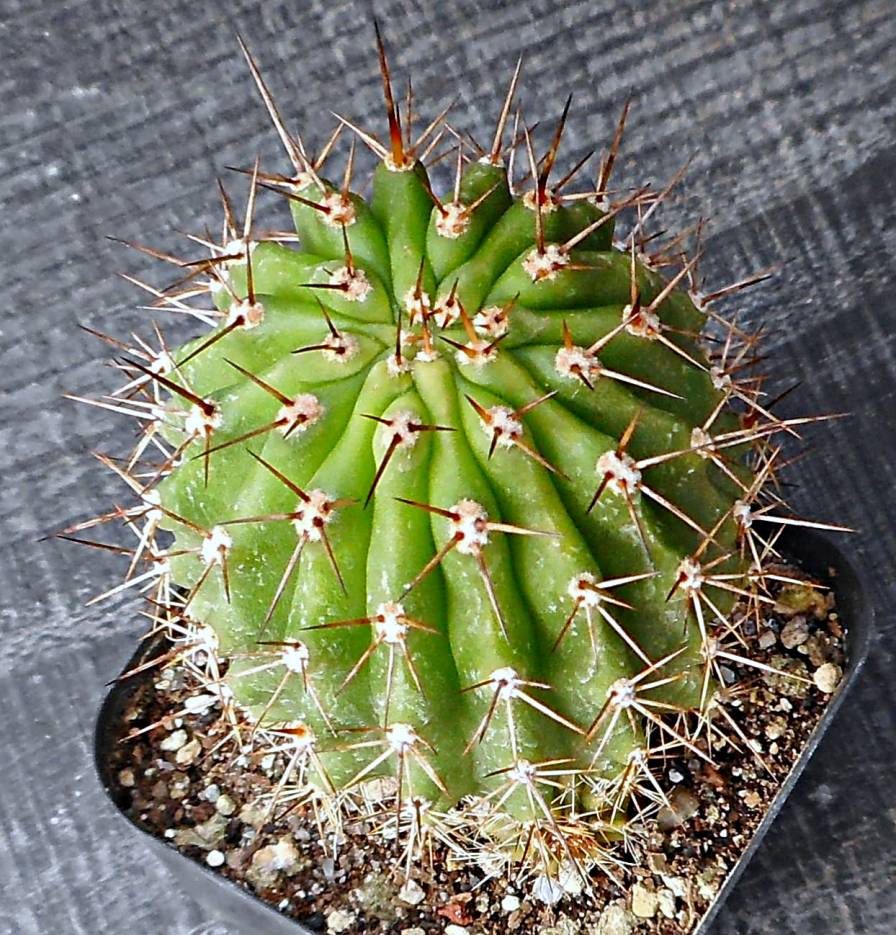
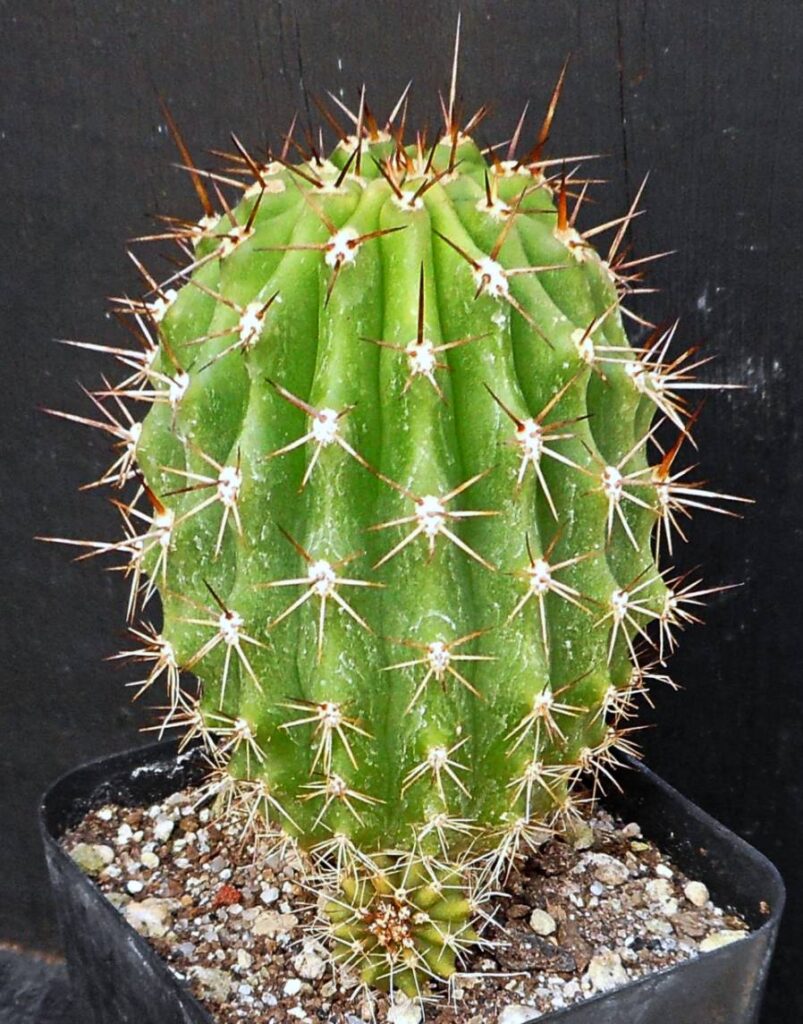 ↑ Auction plant ↑
↑ Auction plant ↑ ↑ Auction plant with darker hues during the height of summer ↑
↑ Auction plant with darker hues during the height of summer ↑
♣
Other Succulents & Xerophytes
__
Boswellia nana “Dwarf Frankincense”
Burseraceae. Prostrate caudiciform subshrub to only 1–2′ tall. Simple dark green leaves with wavy margins, densely arranged along the stems and drought deciduous. New growth is red to bronze. Small pink flowers. Endemic to limestone cliffs, Socotra. Rich in aromatic balsamy oils. This amazing little species is the ultimate xerophytic bonsai and a real joy to behold. Needs bright light, well draining soil, heat and some humidity to thrive, along with a dry winter rest. We offer here a charming seedling already beginning to branch. Just starting to shed leaves for winter dormancy; shipped potted. Every succulent collection should include this regal dwarf frankincense! Z10a/b
3″+ plant 2 years old – 4 bids – auction closed – winning bid $80 Listing closed!
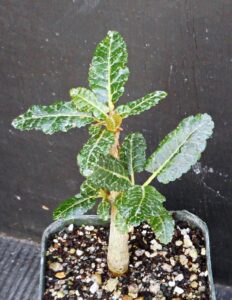
__
Bursera vazquezyanesii BLM1605 “Copal” “Papelillo” “Cuajiote”
Small pachycaul tree to 15’+. Swollen trunks and thick branches with platinum to orange-gold bark that peels in thin sheets to reveal a smooth, greenish under-bark. Elegant imparipinnate leaves, green to blue-green, with slender lanceolate leaflets, reddish petioles and leaf veins; new growth is striking bronze to purple and red color. Small reddish flowers. Aromatic sap, medicinal like other Copal. A very rare species from a restricted dry forest region of southwestern Jalisco, Mexico. Makes for an easy and gorgeous natural bonsai if kept underpotted. We only offer a clone of this stunner once every 5 or 6 years, this is the largest specimen we’ve ever offered. Soon to lose its leaves for winter dormancy. Z10a
22″+ tree with 1/2″ thick trunk – 5 bids – auction closed – winning bid $100* Listing closed!
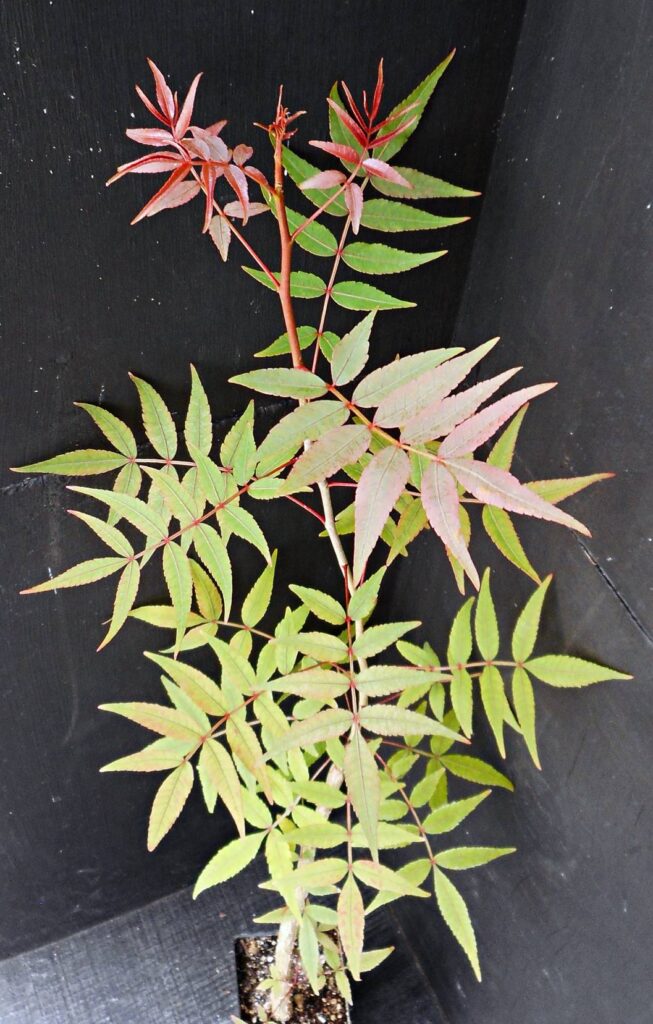 ↑ Bursera vazquezyanesii BLM1605 auction plant ↑
↑ Bursera vazquezyanesii BLM1605 auction plant ↑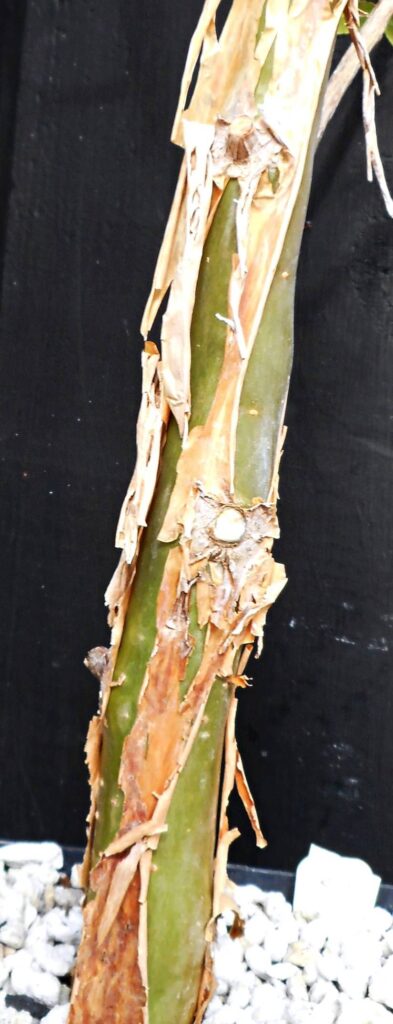 ↑ Bursera vazquezyanesii trunk & bark of mother plant ↑
↑ Bursera vazquezyanesii trunk & bark of mother plant ↑
__
Ephedra aff. rupestris BK09511.2
Ephedraceae. An amazing dwarf species with relatively thick, olive to blue-green, leafless stems 1–6″+ tall; forms impressively dense mounds to 12–24″ in diameter; edible red berries, small yet tasty sweet. The compact mounds are distinctly different than the high altitude creeping miniature E. rupestris we collected in the alpine Cusco region. This may be a new species, Andean Ephedra are poorly studied. Open puna grassland and rock outcrops, Cordillera Negra, Ancash Dept., Peru, 13,200′; occurring with bunch grasses, Senecio spp., and several cacti which it appeared to act as a nurse plant for—Oroya borchersii, Matucana sp., and Austrocylindropuntia floccosa were all observed to be growing directly out of the Ephedra mounds. The region is grazed by dairy cattle, but the Ephedra appear to tolerate grazing. Grows well for us at low elevation; does not stay quite as compact, though still dense, lovely and one of our favorites. Perfect for the rock garden or as a potted specimen. Drought hardy when planted in the ground, has tolerated the summer heat and the wet and cold of winter here just fine. Consider it as a companion for your favorite cacti—an ally for hardy globulars or a groundcover at the base of your Trichocereus. A rare chance at a rooted cutting. Z7/8?
5″ branched plant – 6 bids – auction closed – winning bid $70 Listing closed!
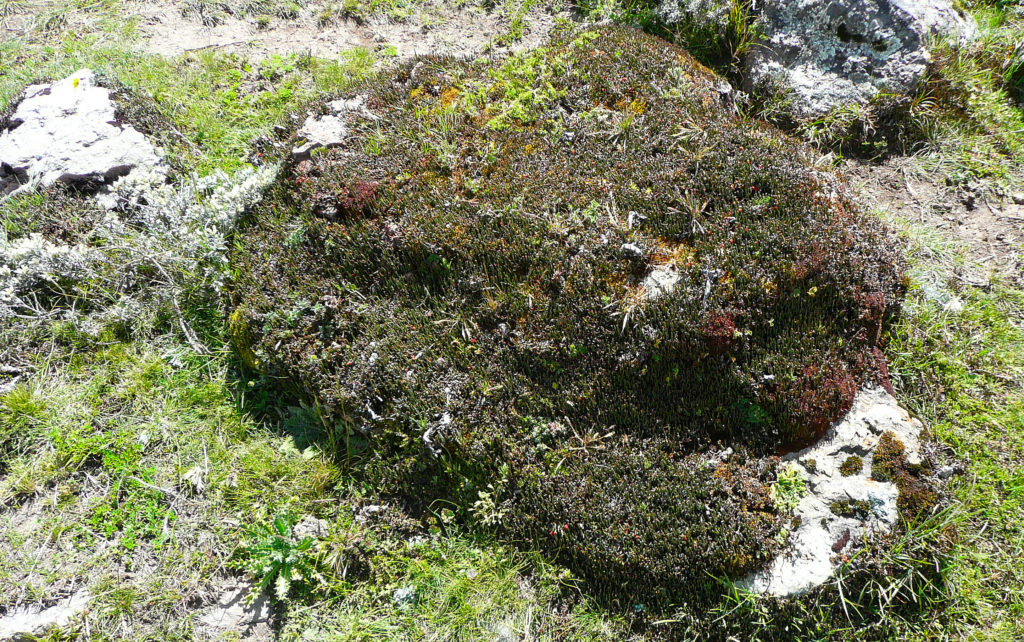
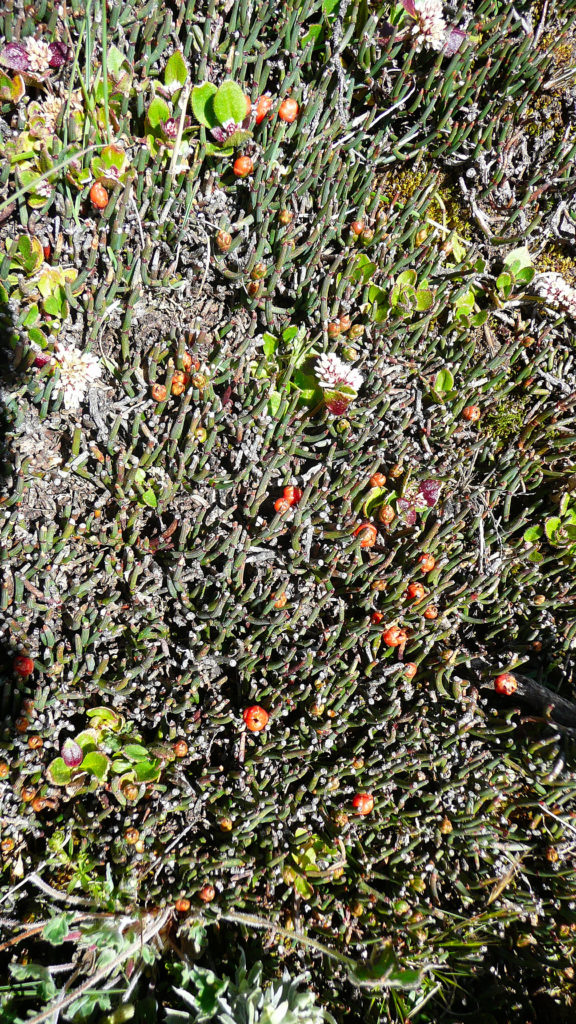 ↑ Ephedra aff. rupestris BK09511.2 in habitat, Cordillera Negra, Ancash Dept., Peru, 13,200′ ↑
↑ Ephedra aff. rupestris BK09511.2 in habitat, Cordillera Negra, Ancash Dept., Peru, 13,200′ ↑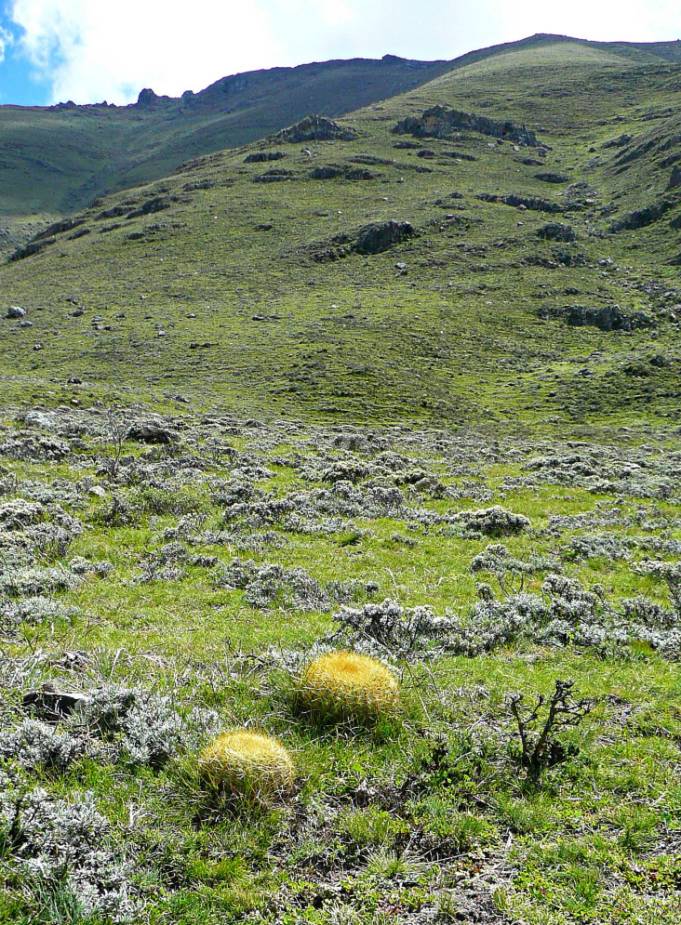 ↑ Ephedra aff. rupestris BK09511.2 habitat, Cordillera Negra, Ancash Dept., Peru, 13,200′ ↑
↑ Ephedra aff. rupestris BK09511.2 habitat, Cordillera Negra, Ancash Dept., Peru, 13,200′ ↑
♣
Andean Ethnobotanicals
__
Cypella herrerae BK10430.1 “Ullucho” “Michi-michi”
Iridaceae. Perennial bulbs with annual grass-like leaves to 18″. Absolutely stunning, large, iridescent blue to purplish flowers with darker purple mottling in the center and fuzzy yellow patches on 3 of the 6 petals—an exquisite jewel of a blossom. The bulbs of many Cypella species are edible and used medicinally for cough and inflammation. Seed collected south of Cusco City, 10,700′, Peru, near the Wari ruins of Pikillacta—believed to have been a vast storehouse of ancestral mummies (in the ancient Andes, those who controlled the dead controlled the living). This seed took over 5 years to sprout! Easy to grow, prefers well draining soil and sun; drought hardy and tolerant of neglect; winter dormant. Does well in the garden or in a pot; makes a good companion for your columnar cacti. This is our first time offering this beauteous accession. Bulb soon to defoliate for winter dormancy. Z8?
Bulb 5+ years old – 3 bids – auction closed – winning bid $50 Listing closed!
 ↑ Cypella herrerae BK10430.1 in bloom in habitat, Peru ↑
↑ Cypella herrerae BK10430.1 in bloom in habitat, Peru ↑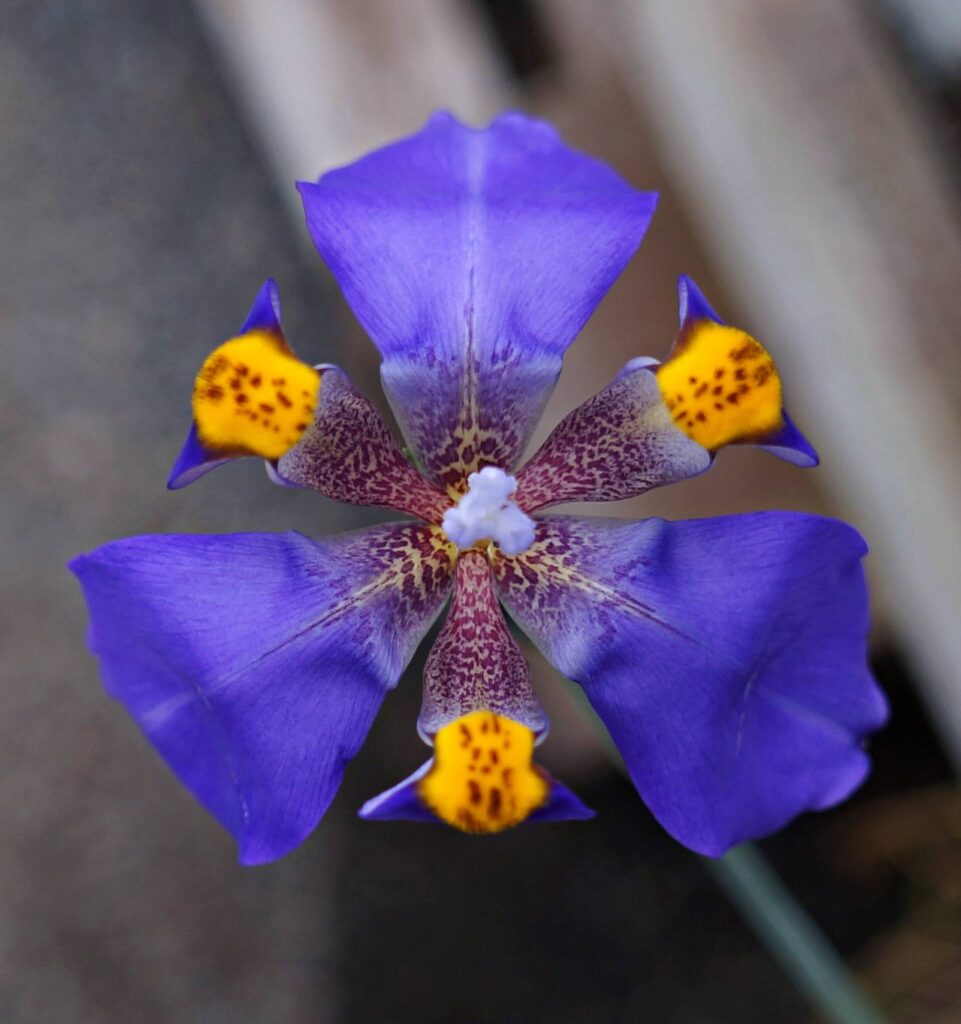 ↑ Cypella herrerae in bloom in California ↑
↑ Cypella herrerae in bloom in California ↑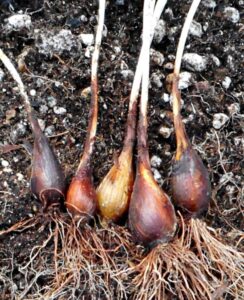 ↑ Cypella herrerae bulbs ↑
↑ Cypella herrerae bulbs ↑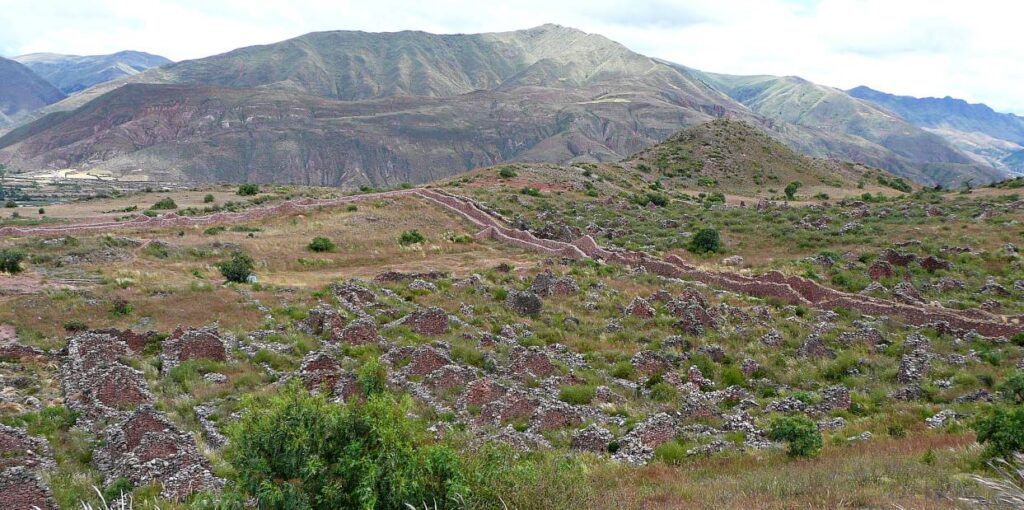 ↑ Cypella herrerae habitat, Pikillacta, Cusco Dept., Peru ↑
↑ Cypella herrerae habitat, Pikillacta, Cusco Dept., Peru ↑
__
Pernettya prostrata ‘minuta’ BK10511.3
Ericaceae. A charming miniature form of this blueberry relative—only 1–2″ tall, creeping to form low mounds to 10–12″+ across. The new growth, stems and tiny leaves take on attractive reddish hues in bright light. White-pink flowers and small black berries, fairly sweet, but should not be eaten in excess. The Quechua recognize that the fruit of other forms of P. prostrata can cause “drunkeness” and delirium if over-eaten. Seed from plants growing near mounds of Mahueniopsis cacti and Stipa bunch-grasses, next to a spring-fed acequia, just below a remnant population of giant Puya raimondii, near Rodeo, Cochabamba Dept., Bolivia, 13,100′. Slow growing, perfect for rock gardens, as an edible ground cover or an adorable companion plant to cold hardy cacti. Z7?
2″ plant – 3 bids – auction closed – winning bid $50 Listing closed!
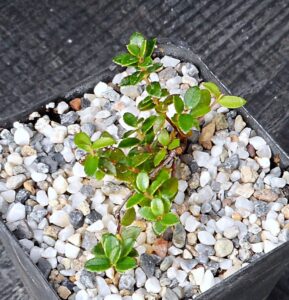 ↑ Auction plant ↑
↑ Auction plant ↑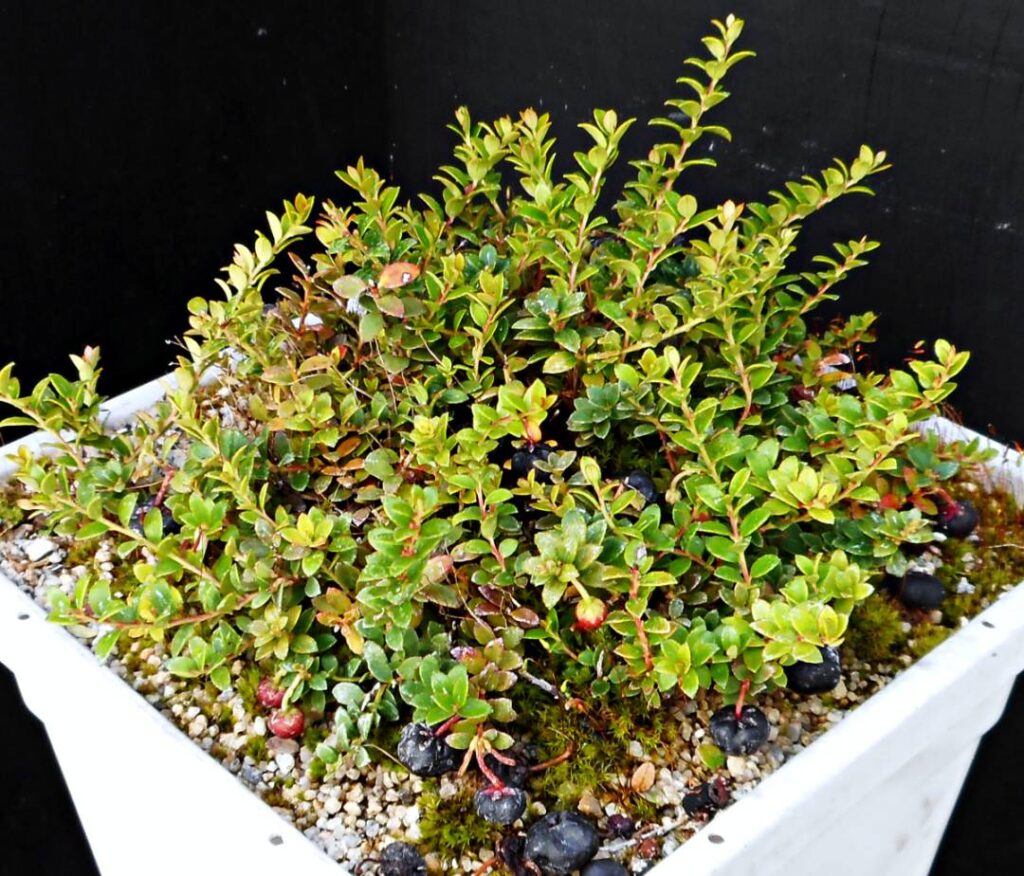 ↑ Mother plant in cultivation ↑
↑ Mother plant in cultivation ↑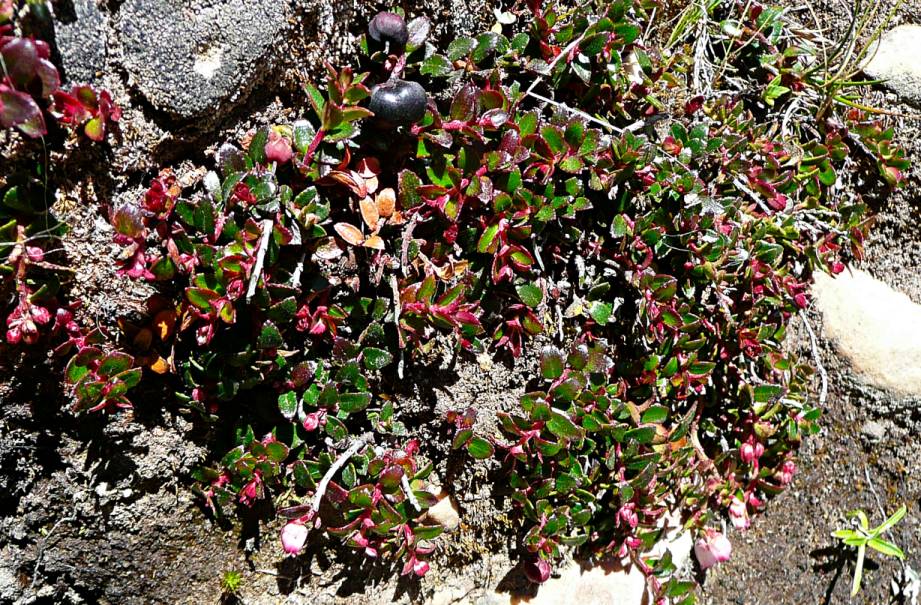 ↑ Pernettya prostrata ‘minuta’ BK10511.3 in habitat ↑
↑ Pernettya prostrata ‘minuta’ BK10511.3 in habitat ↑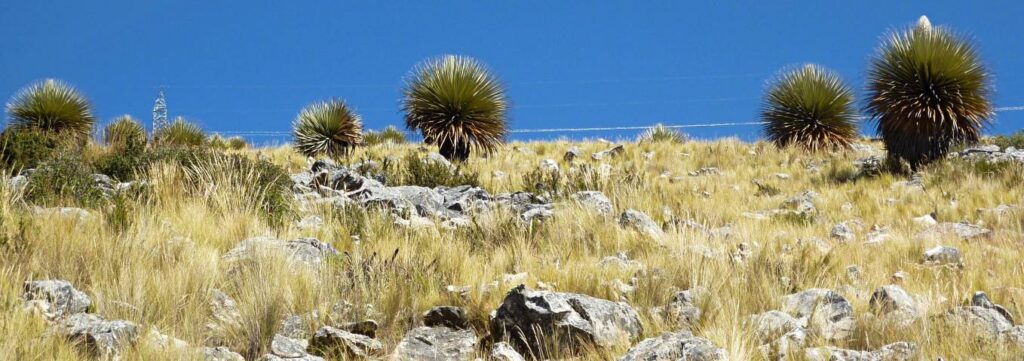 ↑ Habitat of Pernettya prostrata ‘minuta’, Rodeo, Cochabamba Dept., Bolivia ↑
↑ Habitat of Pernettya prostrata ‘minuta’, Rodeo, Cochabamba Dept., Bolivia ↑
__
Sambucus peruviana BK151011.8 cl. A “Sauco” “Guindo” “Andean Elderberry”
Caprifoliaceae. It’s been several years since we’ve offered this outstanding, highly beneficial plant. Fast growing tree to 15–30′ with distinct gnarled trunk and large compound leaves. Self fertile umbels of white flowers. Esteemed for its huge clusters of deep purple-black, antioxidant rich, sweet berries, which are the largest fruit of any elderberry species. Seed from the biggest specimen we’ve ever come across, an awesome 30’+ tree with multiple trunks covered in a shaggy epiphytic fern; cloud forest of Juglans, Alnus, Podocarpus, etc, San Lorenzo, Salta, Argentina, 6000′. Widely planted since pre-Columbian times, thought to be used in Incan agroforestry. The fruit are popular made into marmalade and other sweets throughout the Andes. The leaves are said to repel insects and the light, rot resistant wood is made into tools and flutes. An infusion of the flowers is used to expel phlegm and fever. Dried leaf powder is rubbed into the skin to reduce rheumatic inflammation. This amazingly versatile small tree is a superb addition to any edible/medicinal garden. Tolerant of wet subtropical climates as well as cold. Sun to part shade, prefers some moisture, but tolerant of adverse conditions. During a week long wildfire evacuation in 2019, we lost most of our seedlings (and many other irreplaceable plants), only 3 survived their pots completely drying out and were slow to fully recover until recently. We offer here a rooted cutting of the most vigorous of the survivors, clone A. Z8a
8″ treelet – 9 bids – auction closed – winning bid $111 Listing closed!
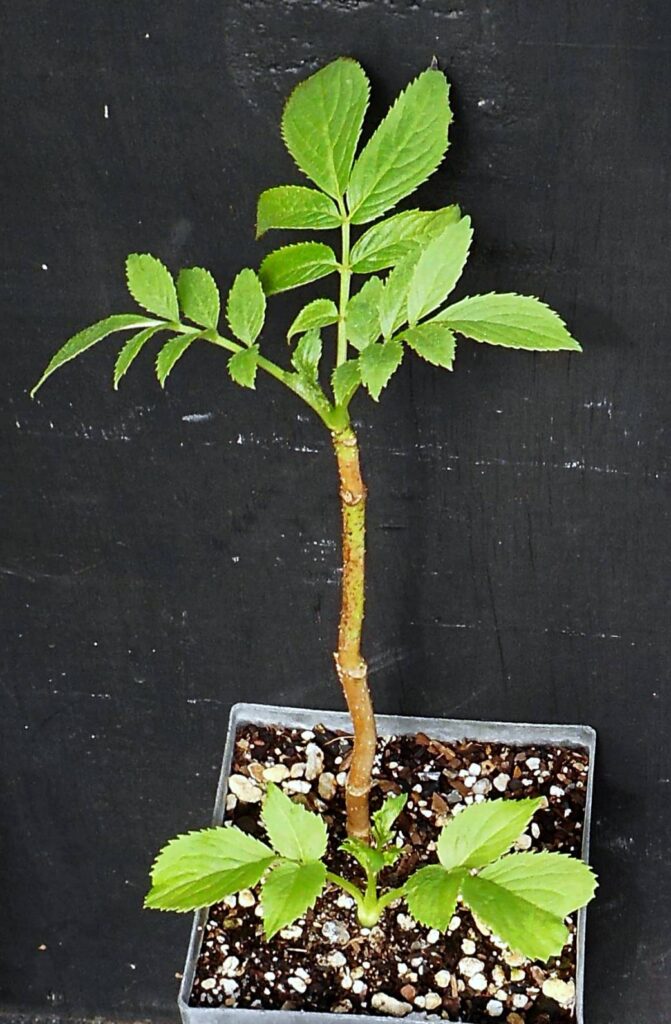 ↑ Auction plant ↑
↑ Auction plant ↑ 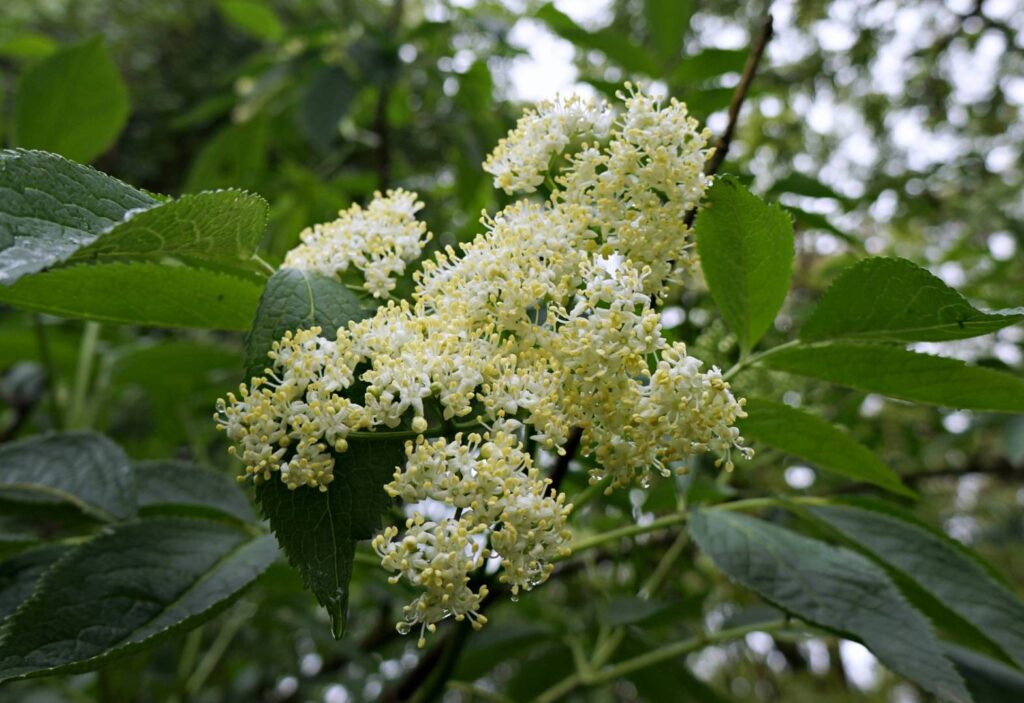
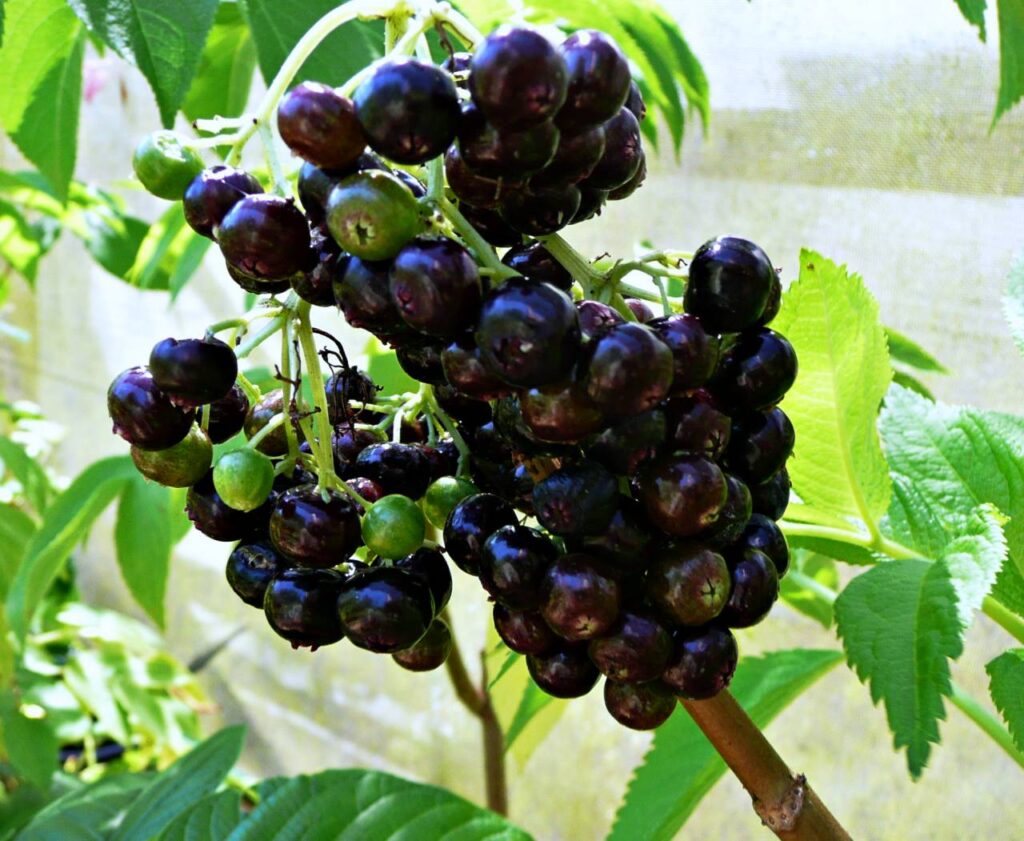 ↑ Sambucus peruviana flowers and fruit ↑
↑ Sambucus peruviana flowers and fruit ↑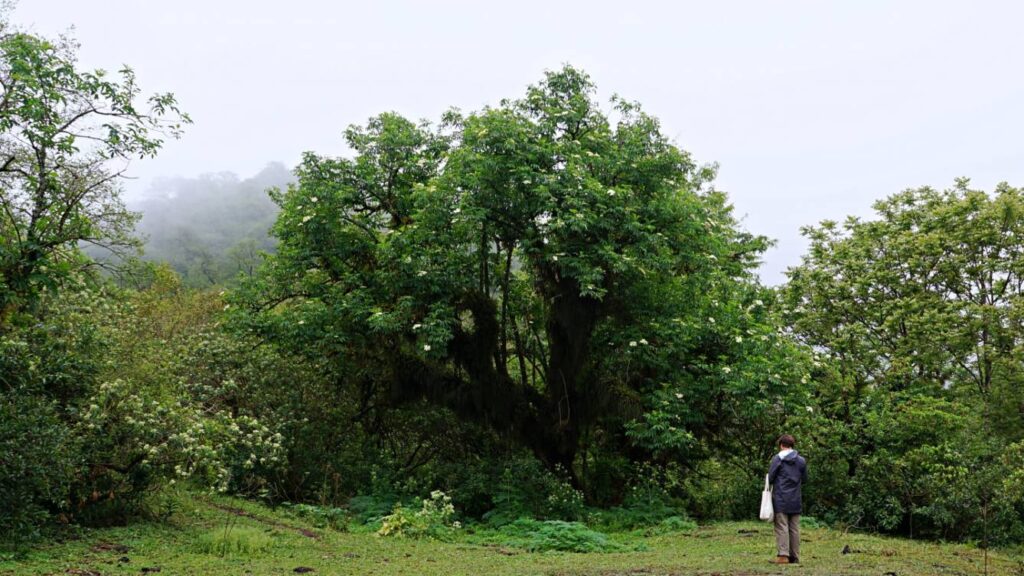
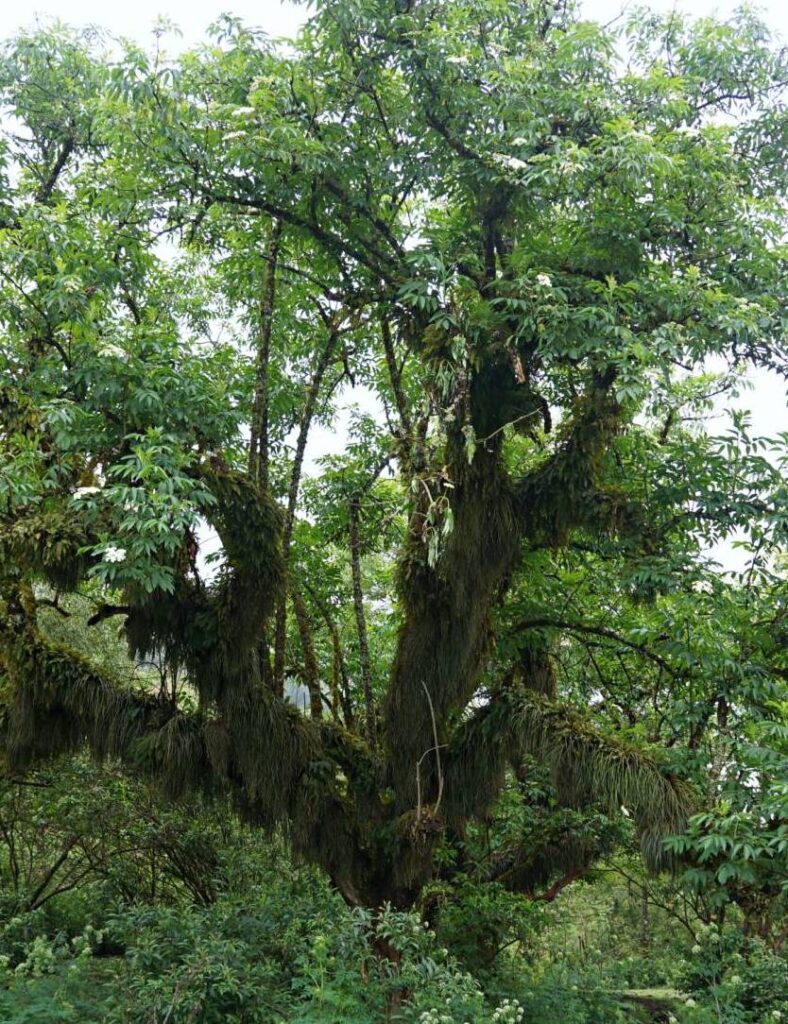
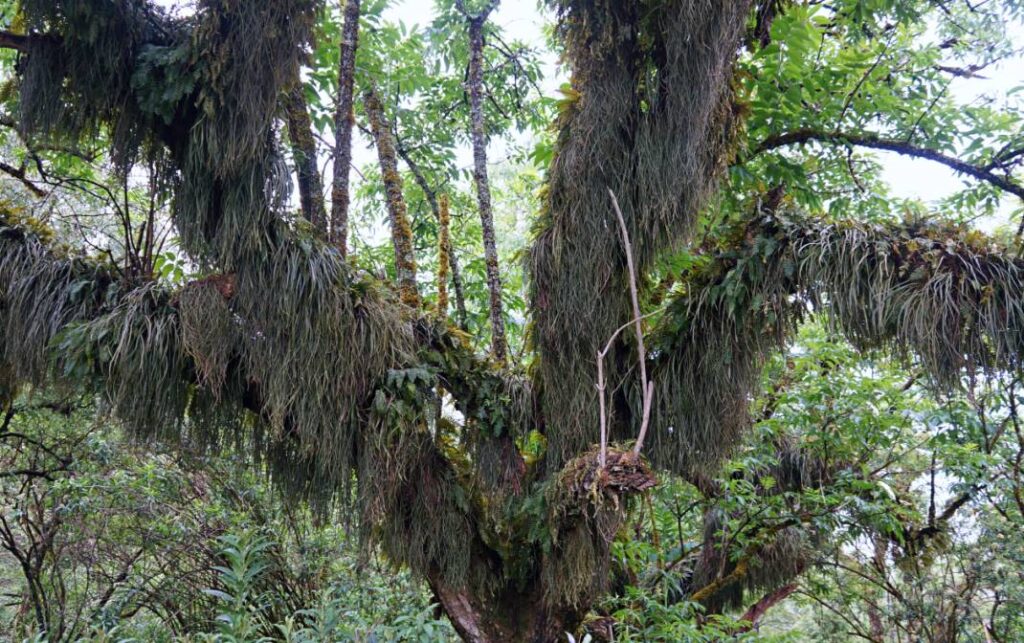 ↑ Ancient, fern covered mother tree of Sambucus peruviana BK151011.8, Salta, Argentina ↑
↑ Ancient, fern covered mother tree of Sambucus peruviana BK151011.8, Salta, Argentina ↑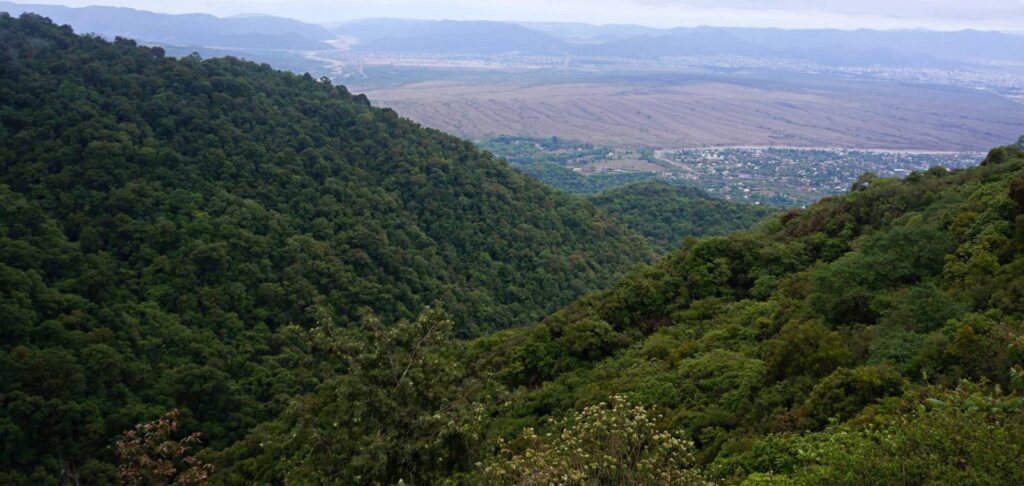 ↑ Sambucus peruviana BK151011.8 cloudforest habitat, San Lorenzo, Salta, Argentina ↑
↑ Sambucus peruviana BK151011.8 cloudforest habitat, San Lorenzo, Salta, Argentina ↑
♣
Books – no books this auction, see:
Rare & Used Editions
______
~ end of auction list ~
♥
This auction closed at 6:00pm PST, Sunday, October 20, 2024
◊
For more plant offerings see our SPECIMEN PLANT LIST
 ↑ Oroya borschersii & Ephedra aff. rupestris habitat, Cordillera Negra, Ancash, Peru, 13,200′ ↑
↑ Oroya borschersii & Ephedra aff. rupestris habitat, Cordillera Negra, Ancash, Peru, 13,200′ ↑
♥
© Unless noted otherwise, all sacredsucculents.com web text and images copyright Ben Kamm ©
